Abstract
Background
Without a phase of retention after successful orthodontic treatment, teeth tend to 'relapse', that is, to return to their initial position. Retention is achieved by fitting fixed or removable retainers to provide stability to the teeth while avoiding damage to teeth and gums. Removable retainers can be worn full‐ or part‐time. Retainers vary in shape, material, and the way they are made. Adjunctive procedures are sometimes used to try to improve retention, for example, reshaping teeth where they contact ('interproximal reduction'), or cutting fibres around teeth ('percision').
This review is an update of one originally published in 2004 and last updated in 2016.
Objectives
To evaluate the effects of different retainers and retention strategies used to stabilise tooth position after orthodontic braces.
Search methods
An information specialist searched Cochrane Oral Health Trials Register, CENTRAL, MEDLINE, Embase and OpenGrey up to 27 April 2022 and used additional search methods to identify published, unpublished and ongoing studies.
Selection criteria
Randomised controlled trials (RCTs) involving children and adults who had retainers fitted or adjunctive procedures undertaken to prevent relapse following orthodontic treatment with braces. We excluded studies with aligners.
Data collection and analysis
Two review authors independently screened eligible studies, assessed risk of bias and extracted data. Outcomes were stability or relapse of tooth position, retainer failure (i.e. broken, detached, worn out, ill‐fitting or lost), adverse effects on teeth and gums (i.e. plaque, gingival and bleeding indices), and participant satisfaction. We calculated mean differences (MD) for continuous data, risk ratios (RR) or risk differences (RD) for dichotomous data, and hazard ratios (HR) for survival data, all with 95% confidence intervals (CI). We conducted meta‐analyses when similar studies reported outcomes at the same time point; otherwise results were reported as mean ranges. We prioritised reporting of Little's Irregularity Index (crookedness of anterior teeth) to measure relapse, judging the minimum important difference to be 1 mm.
Main results
We included 47 studies, with 4377 participants. The studies evaluated: removable versus fixed retainers (8 studies); different types of fixed retainers (22 studies) or bonding materials (3 studies); and different types of removable retainers (16 studies). Four studies evaluated more than one comparison. We judged 28 studies to have high risk of bias, 11 to have low risk, and eight studies as unclear.
We focused on 12‐month follow‐up.
The evidence is low or very low certainty. Most comparisons and outcomes were evaluated in only one study at high risk of bias, and most studies measured outcomes after less than a year.
Removable versus fixed retainers
Removable (part‐time) versus fixed
One study reported that participants wearing clear plastic retainers part‐time in the lower arch had more relapse than participants with multistrand fixed retainers, but the amount was not clinically significant (Little's Irregularity Index (LII) MD 0.92 mm, 95% CI 0.23 to 1.61; 56 participants). Removable retainers were more likely to cause discomfort (RR 12.22; 95% CI 1.69 to 88.52; 57 participants), but were associated with less retainer failure (RR 0.44, 95% CI 0.20 to 0.98; 57 participants) and better periodontal health (Gingival Index (GI) MD −0.34, 95% CI −0.66 to −0.02; 59 participants).
Removable (full‐time) versus fixed
One study reported that removable clear plastic retainers worn full‐time in the lower arch did not provide any clinically significant benefit for tooth stability over fixed retainers (LII MD 0.60 mm, 95% CI 0.17 to 1.03; 84 participants). Participants with clear plastic retainers had better periodontal health (gingival bleeding RR 0.53, 95% CI 0.31 to 0.88; 84 participants), but higher risk of retainer failure (RR 3.42, 95% CI 1.38 to 8.47; 77 participants). The study found no difference between retainers for caries.
Different types of fixed retainers
Computer‐aided design/computer‐aided manufacturing (CAD/CAM) nitinol versus conventional/analogue multistrand
One study reported that CAD/CAM nitinol fixed retainers were better for tooth stability, but the difference was not clinically significant (LII MD −0.46 mm, 95% CI −0.72 to −0.21; 66 participants). There was no evidence of a difference between retainers for periodontal health (GI MD 0.00, 95% CI ‐0.16 to 0.16; 2 studies, 107 participants), or retainer survival (RR 1.29, 95% CI 0.67 to 2.49; 1 study, 41 participants).
Fibre‐reinforced composite versus conventional multistrand/spiral wire
One study reported that fibre‐reinforced composite fixed retainers provided better stability than multistrand retainers, but this was not of a clinically significant amount (LII MD −0.70 mm, 95% CI −1.17 to −0.23; 52 participants). The fibre‐reinforced retainers had better patient satisfaction with aesthetics (MD 1.49 cm on a visual analogue scale, 95% CI 0.76 to 2.22; 1 study, 32 participants), and similar retainer survival rates (RR 1.01, 95% CI 0.84 to 1.21; 7 studies; 1337 participants) at 12 months. However, failures occurred earlier (MD −1.48 months, 95% CI −1.88 to −1.08; 2 studies, 103 participants; 24‐month follow‐up) and more gingival inflammation at six months, though bleeding on probing (BoP) was similar (GI MD 0.59, 95% CI 0.13 to 1.05; BoP MD 0.33, 95% CI −0.13 to 0.79; 1 study, 40 participants).
Different types of removable retainers
Clear plastic versus Hawley
When worn in the lower arch for six months full‐time and six months part‐time, clear plastic provided similar stability to Hawley retainers (LII MD 0.01 mm, 95% CI −0.65 to 0.67; 1 study, 30 participants). Hawley retainers had lower risk of failure (RR 0.60, 95% CI 0.43 to 0.83; 1 study, 111 participants), but were less comfortable at six months (VAS MD ‐1.86 cm, 95% CI ‐2.19 to ‐1.53; 1 study, 86 participants).
Part‐time versus full‐time wear of Hawley
There was no evidence of a difference in stability between part‐time and full‐time use of Hawley retainers (MD 0.20 mm, 95% CI −0.28 to 0.68; 1 study, 52 participants).
Authors' conclusions
The evidence is low to very low certainty, so we cannot draw firm conclusions about any one approach to retention over another. More high‐quality studies are needed that measure tooth stability over at least two years, and measure how long retainers last, patient satisfaction and negative side effects from wearing retainers, such as tooth decay and gum disease.
Keywords: Adult, Child, Humans, Dental Care, Drug-Related Side Effects and Adverse Reactions, Gingivitis, Orthodontic Brackets, Periodontal Diseases
Plain language summary
What is the best method for maintaining the correct position of teeth after orthodontic treatment?
Key messages
‐ We cannot draw firm conclusions about any one approach to retention over another because we have little confidence in the evidence.
‐ More well‐planned studies are needed. They should measure tooth stability over at least two years, how long the retainers last, patient satisfaction and any unwanted effects from the retainers, such as tooth decay and gum disease.
What is the problem?
Teeth can become crooked again after being straightened with orthodontic braces ('relapse'). Orthodontists try to prevent this using different ways of holding the teeth straight ('retention procedures'). Retention procedures can include wearing custom‐made fixed or removable retainers, usually made of wires or clear plastic, after orthodontic braces have been removed. Removable retainers can be worn full‐ or part‐time. Retainers fit over or around teeth, or stick onto the back of teeth. Orthodontists may also use extra treatments ('adjunctive procedures') such as smoothing contacts between the teeth ('interproximal enamel reduction'), or cutting fibres that connect the gum and the neck of the tooth ('pericision').
What did we want to know?
We wanted to find out the best way to maintain teeth in their new position after the end of treatment with orthodontic braces and whether there are any unwanted effects.
What did we do?
We searched for studies that compared different types of retainers following treatment with orthodontic braces, and that measured the effects for at least three months after the orthodontic treatment. We summarised study results and rated our confidence in the evidence.
What did we find?
We found 47 studies with 4377 adults and children. Most studies took place in hospitals, universities or specialist practices, NHS clinics, or a mixture of places. Most of the studies tested: removable retainers versus fixed retainers; different types of fixed retainers or bonding materials; or different types of removable retainers. Most measured the effects of treatment for less than one year.
Main results
Removable versus fixed retainers (8 studies)
Teeth may return to their previous position more with part‐time wear of a removable retainer made of clear plastic than with a fixed retainer, but the difference was so small that it may not be important. If the removable retainer is worn full‐time, there may be no difference between the retainers in tooth movement. Clear plastic retainers worn part‐time may fail less than fixed retainers, but when worn full‐time may fail more. Better gum health may be achieved with clear plastic removable retainers than with fixed retainers, but no difference was found in tooth decay.
Different types of fixed retainers and glues to stick them on (21 studies)
CAD/CAM (computer‐aided design/computer‐aided manufacturing) nitinol fixed retainers compared to conventional multistrand wire fixed retainers may not differ in terms of how well they hold the teeth straight, gum health, or how long they last.
Fibre‐reinforced composite retainers are less obvious on the teeth therefore participants are more satisfied with them because of their appearance. Fibre‐reinforced composite retainers may be slightly better at keeping the teeth straight, but the difference was so small, it might not be important. Fibre‐reinforced composite retainers might be more likely to fail earlier and be associated with more gum problems than multistrand fixed retainers.
Different types of removable retainers (16 studies)
The effects of Hawley removable retainers compared with clear plastic retainers on movement of the teeth may be similar, whether they are worn full‐ or part‐time. Clear plastic retainers may provide better patient satisfaction but be less likely to last than Hawley retainers.
What are the limitations of the evidence?
Our confidence in the evidence is low because the studies were small and did not use the best methods. Very few studies looked at more than one of the things we were interested in. Most studies measured results less than a year following treatment. Also, we do not know how much study results may be affected by the age of the participants and whether they are still growing, what kind of problems they had with their teeth before their first braces, and what other treatment they had, such as extractions.
How up to date is this evidence
The evidence is up to date to 27 April 2022. This review updates one originally published in 2004 and last updated in 2016.
Summary of findings
Summary of findings 1. Removable retainer (part‐time) versus fixed retainer to stabilise tooth position.
|
Population: people who had received fixed appliance
treatment
Setting: specialised orthodontic
practice and hospital or university orthodontic
department
Intervention: part‐time clear
plastic removable retainers
Comparison: any
type of fixed retainer Follow‐up: 12 months Arch: lower | |||||||
| Outcome | Outcome measure | Illustrative comparative risks* (95% CI) | Relative effect (95% CI) | No of participants (studies) | Certainty of evidence (GRADE) | Comments | |
| Assumed risk | Corresponding risk | ||||||
| Any type of fixed retainer | Part‐time clear plastic removable retainer | ||||||
|
Stability Follow‐up: 12 months |
Little's Irregularity Index (LII) in lower arch (ideally 0 mm) |
Mean LII in the fixed group was 0.77 mm |
MD 0.92 mm higher (0.23 to 1.61 higher) |
‐ | 56 (1 RCT) |
⊕⊝⊝⊝ Very lowa,b,c,d | 1 RCT at high risk of detection bias suggested that there was slightly more relapse with the clear plastic retainer, but the mean difference was less than 1 mm, which is not clinically significant. |
|
Survival Follow‐up: 12 months |
Failure of retainer in lower arch |
500 per 1000 |
280 fewer per 1000 (400 to 10 less) |
RR 0.44 (0.20 to 0.98) |
57 (1 RCT) |
⊕⊝⊝⊝ Very lowa,b,c,d | 1 RCT at high risk of detection bias suggested that there was a lower risk of retainer failure with the part‐time clear plastic retainer. |
|
Patient satisfaction Follow‐up: 12 months |
Discomfort/pain in lower arch |
33 per 1000 |
374 more per 1000 (23 to 1000 more) |
RR 12.22 (1.69 to 88.52) |
57 (1 RCT) |
⊕⊝⊝⊝ Very lowa,b,c,d | 1 RCT at high risk of detection bias suggested that there was a higher risk of discomfort with the part‐time clear plastic retainer. |
|
Adverse effects on oral health Follow‐up: 12 months |
Gingival Index (GI) in lower arch (ideally 0) |
Mean GI in the fixed group was 0.92 |
MD 0.34 lower (0.66 lower to 0.02 lower) |
‐ | 59 (1 RCT) |
⊕⊝⊝⊝ Very lowa,b,c,d | 1 RCT at high risk of detection bias suggested that there was better periodontal health with the part‐time clear plastic retainer. |
| *The basis for the assumed risk (e.g. the median control group risk across studies) is provided in footnotes. The corresponding risk (and its 95% confidence interval) is based on the assumed risk in the comparison group and the relative effect of the intervention (and its 95% CI). CI: confidence interval; LII: Little's Irregularity Index; MD: mean difference; RCT: randomised controlled trial; RR: risk ratio | |||||||
| GRADE Working Group grades of evidence High certainty: we are very confident that the true effect lies close to that of the estimate of the effect. Moderate certainty: we are moderately confident in the effect estimate: the true effect is likely to be close to the estimate of the effect, but there is a possibility that it is substantially different. Low certainty: our confidence in the effect estimate is limited: the true effect may be substantially different from the estimate of the effect. Very low certainty: we have very little confidence in the effect estimate: the true effect is likely to be substantially different from the estimate of effect. | |||||||
aDowngraded one level due to study limitations (high risk of detection bias). bDowngraded two levels for very serious imprecision due to the small sample size of a single study. cDowngraded one level since there is only one study for this comparison. dOnly one study, which made it difficult to ascertain the likelihood of publication bias.
Summary of findings 2. Removable retainer (full time) versus fixed retainer to stabilise tooth position.
|
Population: people who had received fixed appliance
treatment
Setting: specialist orthodontic
practice and hospital orthodontic
department
Intervention: full‐time clear
plastic removable retainer
Comparison: any type
of fixed retainer Follow‐up: 12 months Arch: lower | |||||||
| Outcome | Outcome measure | Illustrative comparative risks* (95% CI) | Relative effect (95% CI) | No of participants (studies) | Certainty of evidence (GRADE) | Comments | |
| Assumed risk | Corresponding risk | ||||||
| Any type of fixed retainer | Full‐time clear plastic removable retainer | ||||||
|
Stability Follow‐up: 12 months |
Little's Irregularity Index (LII) in lower arch (ideally 0 mm) |
Mean LII in the fixed group was 0.44 mm |
MD 0.60 mm higher (0.17 to 1.03 higher) |
‐ | 84 (1 RCT) |
⊕⊝⊝⊝ Very lowa,b,c | 1 RCT at high risk of reporting bias suggested that there was more relapse with the clear full‐time clear plastic removable retainer, but the mean difference was less than 1 mm, which is not clinically significant. |
|
Survival Follow‐up: 12 months |
Failure of retainer in lower arch |
122 per 1000 |
295 more per 1000 (46 to 911 more) |
RR 3.42 (1.38 to 8.47) |
77 (1 RCT) |
⊕⊝⊝⊝ Very lowa,c,d | 1 RCT at high risk of reporting bias suggested that there was a higher risk of failure with clear plastic retainers. |
|
Patient satisfaction Follow‐up: 12 months |
Discomfort/pain in lower arch |
‐ | ‐ | ‐ | 0 (0 RCTs) |
‐ | No studies measured or reported this outcome. |
|
Adverse effects on oral health Follow‐up: 12 months |
Caries in lower arch |
See comments | See comments |
RD 0.00 (−0.05 to 0.05) |
84 (1 RCT) |
⊕⊝⊝⊝ Very lowa,c,d | 1 RCT at high risk of reporting bias suggested that there was no difference between retainers. |
|
Gingival bleeding in lower arch (ideally < 0.10) |
617 per 1000 |
290 less per 1000 (426 to 74 less) |
RR 0.53 (0.31 to 0.88) |
84 (1 RCT) |
⊕⊝⊝⊝ Very lowa,c,d | 1 RCT at high risk of reporting bias suggested that there was better periodontal health with the full‐time clear plastic retainers. | |
| *The basis for the assumed risk (e.g. the median control group risk across studies) is provided in footnotes. The corresponding risk (and its 95% confidence interval) is based on the assumed risk in the comparison group and the relative effect of the intervention (and its 95% CI). CI: confidence interval; LII: Little's Irregularity Index; MD: mean difference; RCT: randomised controlled trial; RR: risk ratio | |||||||
| GRADE Working Group grades of evidence High certainty: we are very confident that the true effect lies close to that of the estimate of the effect Moderate certainty: we are moderately confident in the effect estimate: The true effect is likely to be close to the estimate of the effect, but there is a possibility that it is substantially different Low certainty: our confidence in the effect estimate is limited: The true effect may be substantially different from the estimate of the effect Very low certainty: we have very little confidence in the effect estimate: The true effect is likely to be substantially different from the estimate of effect | |||||||
aDowngraded one level due to study limitations (serious/unclear risk of reporting bias). bDowngraded one level for imprecision due to the small sample size. cOne study ‐ difficult to ascertain the likelihood of publication bias. dDowngraded two levels for imprecision due to the very small sample size.
Summary of findings 3. Fixed retainer (CAD/CAM nitinol) versus fixed retainer (conventional/analogue multistrand) to stabilise tooth position .
|
Population: people who had received fixed appliance
treatment
Setting: specialised orthodontic
practice and hospital or university orthodontic
department
Intervention: CAD/CAM nitinol
fixed retainer
Comparison:
conventional/analogue multistrand fixed retainer Follow‐up: 12‐months Arch: lower | |||||||
| Outcome | Outcome measure | Illustrative comparative risks* (95% CI) | Relative effect (95% CI) | No of participants (studies) | Certainty of evidence (GRADE) | Comments | |
| Assumed risk | Corresponding risk | ||||||
| Multistrand fixed retainer | CAD/CAM nitinol fixed retainer | ||||||
|
Stability Follow‐up: 12 months |
Little's Irregularity Index (LII) in lower arch (ideally 0 mm) |
Mean LII in the fixed group was 0.56 mm |
MD 0.46 mm lower (0.72 lower to 0.21 lower) |
‐ | 66 (1 RCT) |
⊕⊝⊝⊝ Very lowa,b,c | 1 RCT at high risk of detection bias and unclear risk of selection and reporting bias suggested that there was less relapse with CAD/CAM nitinol fixed retainer, but the mean difference was less than 1 mm, which is not clinically significant. |
|
Survival Follow‐up: 12 months |
Failure of retainer in lower arch |
409 per 1000 |
119 more per 1000 (135 less to 610 more) |
RR 1.29 (0.67 to 2.49) |
41 (1 RCT) |
⊕⊝⊝⊝ Very lowa,b,c | 1 RCT at high risk of detection bias and unclear risk of selection bias suggested that there was no difference between retainers. |
|
Patient satisfaction Follow‐up: 12 months |
Discomfort/pain in lower arch |
‐ | ‐ | ‐ | 0 (0 RCTs) |
‐ | No studies measured or reported this outcome. |
|
Adverse effects on oral health Follow‐up: 12 months |
Bleeding on probing in lower arch (ideally < 0.10) |
‐ | ‐ | ‐ | 0 (0 RCTs) |
‐ | No studies measured or reported this outcome at 12‐month follow‐up. 1 RCT (40 participants) at high risk of detection bias and 1 RCT (81 participants) at unclear risk of detection bias suggested that there was no difference between retainers at 6‐month follow‐up (low‐certainty evidence). |
|
Gingival Index (GI) in lower arch (ideally 0) |
Mean GI ranged from 0.23 to 0.33 across control groups |
MD 0.00 (0.16 lower to 0.16 higher) |
‐ | 107 (2 RCTs) |
⊕⊕⊝⊝ Lowa,b |
At 12 months, 2 RCTs at high risk of detection bias and
unclear risk of selection bias suggested that there was
no difference between retainers. At 6 months, 4 RCTs at high or unclear risk of detection bias suggested that periodontal health was better with the CAD/CAM nitinol retainer (GI MD −0.14, 95% CI −0.27 to −0.01; 198 participants), but the amount was not clinically significant. |
|
| *The basis for the assumed risk (e.g. the median
control group risk across studies) is provided in footnotes.
The corresponding risk (and its 95% confidence
interval) is based on the assumed risk in the comparison
group and the relative effect of the intervention
(and its 95% CI). CI: confidence interval; GI: Gingival Index; LII: Little's Irregularity Index; MD: mean difference; RCT: randomised controlled trial; RR: risk ratio | |||||||
| GRADE Working Group grades of evidence High certainty: we are very confident that the true effect lies close to that of the estimate of the effect. Moderate certainty: we are moderately confident in the effect estimate: the true effect is likely to be close to the estimate of the effect, but there is a possibility that it is substantially different. Low certainty: our confidence in the effect estimate is limited: the true effect may be substantially different from the estimate of the effect Very low certainty: we have very little confidence in the effect estimate: the true effect is likely to be substantially different from the estimate of effect. | |||||||
aDowngraded one level due to study limitations (serious/unclear risk detection bias). bOnly one or two studies ‐ difficult to ascertain the likelihood of publication bias. cDowngraded one level for imprecision due to the small sample size.
Summary of findings 4. Fixed retainer (fibre‐reinforced composite) versus fixed retainer (multistrand/spiral wire) to stabilise tooth position.
|
Population: people who had received fixed appliance
treatment
Setting: specialised orthodontic
practice and hospital or university orthodontic
department
Intervention: fibre‐reinforced
composite retainer
Comparison:
multistrand/spiral wire fixed retainer Follow‐up: 12 months Arch: lower | |||||||
| Outcome | Outcome measure | Illustrative comparative risks* (95% CI) | Relative effect (95% CI) | No of participants (studies) | Certainty of evidence (GRADE) | Comments | |
| Assumed risk | Corresponding risk | ||||||
| Multistrand/spiral wire fixed retainers | Fibre‐reinforced composite retainer | ||||||
|
Stability Follow‐up: 12 months |
Little's Irregularity Index(LII) in lower arch (ideally 0 mm) |
Mean LII was 0.97 mm |
MD 0.70 mm lower (1.17 lower to 0.23 lower) |
‐ | 52 (1 RCT) |
⊕⊝⊝⊝ Very lowa,b,c | 1 RCT at high risk of detection bias and unclear risk of selection bias suggested that there was better stability with the fibre‐reinforced composite retainer, but the mean difference was less than 1 mm, which is not clinically significant. |
|
Survival Follow‐up: 12 months |
Failure of retainer in lower arch |
247 per 1000 |
2 more per 1000 (39 less to 52 more) |
RR 1.01 (0.84 to 1.21) |
1337 (7 RCTs) |
⊕⊕⊝⊝ Lowa,d | 4 RCTs at high risk of detection, attrition, and reporting bias and 3 RCTs at unclear selection, detection, and attrition bias suggested that there was no difference between the retainer types. |
|
Mean survival time in lower arch (months) |
‐ | ‐ | ‐ | 0 (0 RCTs) |
‐ | No studies measured or reported this outcome at 12‐month follow‐up. 1 RCT at high risk of detection and reporting bias and 1 RCT at unclear risk of selection and detection bias suggested that failures occurred earlier when a fibre‐reinforced composite retainer was used at 24‐month follow‐up (MD −1.48, 95% CI −1.88 to −1.08; 103 participants; very low‐certainty evidence). | |
|
Patient satisfaction Follow‐up: 12 months |
Aesthetic in lower arch VAS 0–10 cm (10 cm is very satisfied) |
Mean VAS score was 8.24 cm |
MD 1.49 cm higher (0.76 higher to 2.22 higher) |
‐ | 32 (1 RCT) |
⊕⊝⊝⊝ Very lowa,b,c | 1 RCT at unclear selection, detection and attrition bias suggested that satisfaction with aesthetics was higher with the fibre‐reinforced composite fixed retainer. |
|
Adverse effects on oral health Follow‐up: 12 months |
Bleeding on probing in lower arch (ideally < 0.10) |
‐ | ‐ | ‐ | 0 (0 RCTs) |
‐ | No studies measured or reported this outcome at 12‐month follow‐up. 1 RCT at high risk of detection and attrition bias suggested that there was no difference between retainers at 6‐monthfollow‐up (40 participants; very low‐certainty evidence). |
|
Gingival Index (GI) in lower arch (ideally 0) |
‐ | ‐ | ‐ | 0 (0 RCTs) |
‐ | No studies measured or reported this outcome at 12‐month follow‐up. 1 RCT at high risk of detection and attrition bias suggested that there was higher gingival inflammation of moderate clinical relevance with the fibre‐reinforced composite fixed retainer at 6‐month follow‐up (MD 0.59, 95% CI 0.13 to 1.05; 1 RCT, 40 participants; very low‐certainty evidence). | |
| *The basis for the assumed risk (e.g. the median
control group risk across studies) is provided in footnotes.
The corresponding risk (and its 95% confidence
interval) is based on the assumed risk in the comparison
group and the relative effect of the intervention
(and its 95% CI). CI: confidence interval; GI: Gingival Index; LII: Little's Irregularity Index; MD: mean difference; RCT: randomised controlled trial; RR: risk ratio; VAS: visual analogue scale | |||||||
| GRADE Working Group grades of evidence High certainty: we are very confident that the true effect lies close to that of the estimate of the effect. Moderate certainty: we are moderately confident in the effect estimate: the true effect is likely to be close to the estimate of the effect, but there is a possibility that it is substantially different. Low certainty: our confidence in the effect estimate is limited: the true effect may be substantially different from the estimate of the effect. Very low certainty: we have very little confidence in the effect estimate: the true effect is likely to be substantially different from the estimate of effect. | |||||||
aDowngraded one level due to study limitations (serious/unclear risk of bias). bDowngraded two levels for imprecision due to the small sample size. cOne study ‐ difficult to ascertain the likelihood of publication bias. dDowngraded one level for inconsistency due to the presence of unexplained heterogeneity.
Summary of findings 5. Removable retainer (clear plastic) versus removable retainer (Hawley) to stabilise tooth position.
|
Population: people who had received fixed appliance
treatment
Setting: specialist orthodontic
practice and hospital orthodontic
department
Intervention: Hawley removable
retainer (any coincident wearing protocol between treatment
arms)
Comparison: clear plastic removable
retainer (any coincident wearing protocol between treatment
arms) Follow‐up: 12 months Arch: lower | |||||||
| Outcome | Outcome measure | Illustrative comparative risks* (95% CI) | Relative effect (95% CI) | No of participants (studies) | Certainty of evidence (GRADE) | Comments | |
| Assumed risk | Corresponding risk | ||||||
| Clear plastic removable retainer | Hawley removable retainer | ||||||
|
Stability Follow‐up: 12 months |
Little's Irregularity Index(LII) in lower arch (ideally 0 mm) |
Mean LII was 0.72 mm |
MD 0.01 mm higher (0.65 lower to 0.67 higher) |
‐ | 30 (1 RCT) |
⊕⊝⊝⊝ Very lowa,b,c | 1 RCT at high risk of selection bias suggested that there was no difference between the removable retainer types when worn 6 months full time and 6 months part time. |
|
Survival Follow‐up: 12 months |
Failure of retainer in upper and lower arches |
745 per 1000 |
298 fewer per 1000 (425 to 127 fewer) |
RR 0.60 (0.43 to 0.83) |
111 (1 RCT) |
⊕⊝⊝⊝ Very lowa,c,d | 1 RCT at high risk of detection and reporting bias suggested that there were lower risk of failures with the Hawley removable retainer. |
|
Patient satisfaction Follow‐up: 12 months |
Comfort in upper and lower arches VAS: 0–10 cm (10 cm is very satisfied) |
‐ | ‐ | ‐ | 0 (0 RCTs) |
‐ | No studies measured or reported this outcome at 12‐month
follow‐up. In 1 RCT at 6‐month follow‐up, participants found the Hawley retainer less comfortable (VAS MD −1.86 cm, 95% CI −2.19 to −1.53; 86 participants; very low‐certainty evidence). |
|
Adverse effects on oral health Follow‐up: 12 months |
Not measured | ||||||
| *The basis for the assumed risk (e.g. the median
control group risk across studies) is provided in footnotes.
The corresponding risk (and its 95% confidence
interval) is based on the assumed risk in the comparison
group and the relative effect of the intervention
(and its 95% CI). CI: confidence interval; LII: Little's Irregularity Index; MD: mean difference; RCT: randomised controlled trial; RR: risk ratio; VAS: visual analogue scale | |||||||
| GRADE Working Group grades of evidence High certainty: we are very confident that the true effect lies close to that of the estimate of the effect. Moderate certainty: we are moderately confident in the effect estimate: the true effect is likely to be close to the estimate of the effect, but there is a possibility that it is substantially different. Low certainty: our confidence in the effect estimate is limited: the true effect may be substantially different from the estimate of the effect. Very low certainty: we have very little confidence in the effect estimate: the true effect is likely to be substantially different from the estimate of effect. | |||||||
aDowngraded one level due to study limitations (serious/unclear risk of bias). bDowngraded one level for imprecision due to the small sample size. cOne study ‐ difficult to ascertain the likelihood of publication bias. dDowngraded two levels for imprecision due to the very small sample size of a single study.
Summary of findings 6. Removable (full‐time) versus removable (part‐time) retainers to stabilise tooth position.
|
Population: people who had received fixed appliance
treatment
Setting: specialised orthodontic
practice and hospital or university orthodontic
department
Intervention: full‐time wear of
any type of removable retainer
Comparison:
part‐time wear of any type of removable retainer Follow‐up: 12 months Arch: lower | |||||||
| Outcome | Outcome measure | Illustrative comparative risks* (95% CI) | Relative effect (95% CI) | No of participants (studies) | Certainty of evidence (GRADE) | Comments | |
| Assumed risk | Corresponding risk | ||||||
| Part‐time removable retainers | Full‐time removable retainers | ||||||
|
Stability Follow‐up: 12 months |
Little's Irregularity Index (LII) in lower arch (ideally 0 mm) |
Mean LII was 2 mm |
MD 0.20 mm higher (0.28 lower to 0.68 higher) |
‐ | 52 (1 RCT) |
⊕⊝⊝⊝ Very lowa,b,c | 1 RCT at high risk of selection bias suggested that there was no differencebetween full‐time and part‐time wearing protocol with Hawley removable retainer. |
|
Survival Follow‐up: 12 months |
Not measured |
||||||
|
Patient satisfaction Follow‐up: 12 months |
Not measured |
||||||
|
Adverse effects on oral health Follow‐up: 12 months |
Not measured | ||||||
| *The basis for the assumed risk (e.g. the median
control group risk across studies) is provided in footnotes.
The corresponding risk (and its 95% confidence
interval) is based on the assumed risk in the comparison
group and the relative effect of the intervention
(and its 95% CI). CI: confidence interval; LII: Little's Irregularity Index; MD: mean difference; RCT: randomised controlled trial | |||||||
| GRADE Working Group grades of evidence High certainty: we are very confident that the true effect lies close to that of the estimate of the effect. Moderate certainty: we are moderately confident in the effect estimate: the true effect is likely to be close to the estimate of the effect, but there is a possibility that it is substantially different. Low certainty: our confidence in the effect estimate is limited: the true effect may be substantially different from the estimate of the effect. Very low certainty: we have very little confidence in the effect estimate: the true effect is likely to be substantially different from the estimate of effect. | |||||||
aDowngraded one level due to study limitations (serious risk of bias). bDowngraded one level for imprecision due to the small sample size. cOne study ‐ difficult to ascertain the likelihood of publication bias.
Background
Description of the condition
Retention is the phase of orthodontic treatment that attempts to keep teeth in the corrected positions after treatment with orthodontic (dental) braces. Without retention there is a tendency for the teeth to return to their initial position. This unfavourable change from the corrected position is known as relapse, which is a lifetime risk. The causes of relapse are not fully understood but are felt to relate to recoil of the fibres that hold the teeth in the jaw bone, pressures from the lips, cheeks and tongue, further growth and the way the teeth meet together (Melrose 1998). Relapse may be more frequent in the lower jaw due to occlusal forces. Sometimes, orthodontists use adjunctive procedures to smooth the contacts between the teeth or to cut the fibres that connect the gum and the tooth, or strategies to increase compliance with removable retainer wear, such as monitoring with mobile phone apps. To minimise relapse, almost every person who has orthodontic treatment will require some type of retention.
Description of the intervention
Retention can be achieved by placing appliances, called retainers, on the teeth, or by undertaking additional or 'adjunctive' procedures to the teeth or the surrounding structures.
The retainers can be fixed to the teeth, or they can be removable, so that the person can take them out to clean (Atack 2007). Bonded ('fixed') retainers are usually glued or 'bonded' on the back (inside) of the front teeth. There are various types of fixed retainers. Some consist of braided or solid metallic wires; others are made of polyethylene and glass‐fibres impregnated with composite, which provide better aesthetics. There are different bonding protocols and manufacturing procedures. There are different types of removable retainers too, the Hawley retainer (made of acrylic and metal) and the clear plastic retainers being the most common ones. Some clinicians use a removable appliance called a positioner, that articulates the upper and lower arches, as a retainer after treatment is completed: this helps to 'fine‐tune' the result and can then be worn part‐time to help reduce relapse.
Although there is no recognised duration that retainers need to be worn, patient compliance with the prescribed wear of a removable retainer is required to maintain correction. It has been shown that if people stop wearing retainers after one to two years, there is a risk of long‐term relapse of the teeth (Little 1981; Little 1988). Therefore, some clinicians prefer to retain for longer periods, sometimes indefinitely. It is also not clear how many hours a day removable retainers need to be worn: some people are asked to wear their retainer full‐time (24 hours a day), while other people are only asked to wear them part‐time.
Clinicians may try to reduce relapse by using 'adjunctive' procedures that make changes to the teeth (hard tissues) or the surrounding gum (soft tissues). The two main adjunctive procedures used are reshaping of the contact points between teeth, which is known as interproximal reduction (Aasen 2005), and cutting the fibres around the neck of the tooth that connect the tooth to the gum, which is known as pericision (Edwards 1988).
Appendix 1 contains a glossary of terms to help describe some of the common types of retainers and adjunctive procedures that are described in this review.
How the intervention might work
Factors such as periodontal disease, bruxism (tooth grinding), tooth loss and ageing can cause teeth to move. Retainers or adjunctive procedures aim to maintain the teeth in the position they are in at the end of orthodontic treatment. Retainers fit over or around the teeth to prevent them moving away from that position. Adjunctive procedures may work by improving the contacts between teeth (interproximal reduction) or by cutting fibres that connect the teeth to the gum around the neck of the teeth to stop them pulling the teeth back towards their original position (pericision).
As well as ensuring teeth remain stable in their new position, retainers must keep the teeth in position without doing any harm to the teeth, gums or mouth, and should be comfortable and acceptable to wear. Retainers have the potential to cause damage to the teeth by collecting plaque and calculus, and by making it difficult for people to keep their teeth clean. This build‐up of plaque may cause decay (caries) or damage to the surrounding gum. In turn, damage to the gum can cause gingivitis (inflammation of the gums) or periodontal disease (loss of attachment of the tooth to its surrounding gum and bony socket).
Why it is important to do this review
Unless we can maintain the teeth in position after orthodontic treatment, there is little if any benefit of that treatment. There are currently many different types of removable and fixed retainers, and it is unclear which retainers are the best, and for how long they should be used. There is also little known about the possible benefits and risks of adjunctive procedures aimed at reducing relapse.
It is important to summarise current knowledge about retention procedures in order to provide orthodontists and patients with an up‐to‐date, reliable evidence base for clinical recommendations.
This review investigated the effectiveness of different retention strategies used to stabilise tooth position after treatment with orthodontic braces. It did not attempt to identify the causes of relapse. This review looked at the effects of retainers while in place, not the long‐term effects after they are no longer in use.
This is the third update of a review originally published in 2004 (Littlewood 2004; Littlewood 2006; Littlewood 2016).
Objectives
To evaluate the effects of different retainers and retention strategies used to stabilise tooth position after orthodontic braces.
Methods
Criteria for considering studies for this review
Types of studies
Randomised controlled trials (RCTs)
Types of participants
Children and adults who have had retainers fitted or adjunctive procedures undertaken following treatment with orthodontic braces. There was no restriction for the presenting malocclusion or type of active orthodontic treatment undertaken. The participants had to be followed up at least three months after completing their orthodontic treatment.
We excluded:
people who had surgical correction of the jaws;
people with a cleft lip or palate, or both, or other craniofacial syndrome;
people who had orthodontic treatment based on extractions alone or the fitting of a passive space maintainer, or both.
Types of interventions
Retainers or adjunctive procedures, or both, after treatment with orthodontic braces. We included only studies where the full course of definitive orthodontic treatment was completed ‐ we excluded data on retention strategies at the end of an initial phase of removable or functional appliance treatment. We excluded studies comparing techniques (not materials) for placing the bonded retainers.
We did not include studies on aligners in this review.
Types of outcome measures
We considered four types of outcomes: stability (straightness) outcomes, failure of retainers, adverse effects of retainers, and patient‐related outcome measures (PROMs) focused on patient satisfaction.
Primary outcomes
Stability
Stability could be assessed by an index of tooth irregularity, for example, Little's Irregularity Index (Little 1981), which measures how crooked anterior teeth are, or by crowding (see glossary of terms in Appendix 1). It can also be assessed by a change in the shape or size of each arch: this can be measured by intercanine width, intermolar width or arch length. The way the teeth meet together (occlusion) can also be assessed using measurements such as overjet, overbite, and assessing the quality of the final results using an index such as the Peer Assessment Rating (PAR index; Richmond 1992) or the American Board of Orthodontics objective grading system (ABO‐OGS; Casko 1998). See glossary of terms in Appendix 1.
This review gave priority to reporting the Little's Irregularity Index. There is no agreed Core Outcome Measures in Effectiveness Trials (COMET) for stability studies in orthodontics at the present time, so the review authors decided to use Little's Irregularity Index for the preferred outcome measure in this review.
Settling of the occlusion was excluded as an outcome in this update since it is not directly related to stability. The assessment of stability had to be made at least three months after the fitting of the retainer or after the adjunctive procedure was carried out, or after both.
Secondary outcomes
Failure of the retainers
This assessed how long retainers lasted without breaking (in months) and how many times they needed to be replaced or repaired. If retainers were lost, we reported this as a failure, since the retainers could not fulfil their role.
Patient satisfaction
This often takes the form of a questionnaire.
Adverse effects
These were on the health of the:
teeth (in terms of decay), assessed using indices of demineralisation or identifying the presence of caries;
surrounding structures (gums and other supporting structures), assessed using periodontal indices or other markers of periodontal disease.
Search methods for identification of studies
The review authors, in collaboration with Cochrane Oral Health’s Information Specialist, developed detailed search strategies to search for RCTs for this review.
Electronic searches
Cochrane Oral Health’s Information Specialist conducted systematic searches in the following databases for relevant studies. There were no language, publication year or publication status restrictions:
Cochrane Oral Health Trials Register (to 27 April 2022; see Appendix 2);
Cochrane Central Register of Controlled Trials (CENTRAL; 2022, Issue 3) in the Cochrane Library (searched 27 April 2022; see Appendix 3);
MEDLINE Ovid (1946 to 27 April 2022; see Appendix 4);
Embase Ovid (1980 to 27 April 2022; see Appendix 5);
OpenGrey (opengrey.eu; see Appendix 6).
Subject strategies were modelled on the search strategy designed for MEDLINE Ovid. Where appropriate, they were combined with subject strategy adaptations of the highly sensitive search strategies designed by Cochrane for identifying RCTs and controlled clinical trials (as described in the Cochrane Handbook for Systematic Reviews of Interventions, Version 6.3 (Lefebvre 2022)).
Searching other resources
Ongoing studies
Cochrane Oral Health’s Information Specialist searched the following trials registries for ongoing studies:
US National Institutes of Health Ongoing Trials Register ClinicalTrials.gov (clinicaltrials.gov; searched 27 April 2022; Appendix 7);
World Health Organization International Clinical Trials Registry Platform (apps.who.int/trialsearch; searched 27 April 2022; Appendix 8).
Checking reference lists
We checked the bibliographies of included studies and review articles that we identified for further eligible studies.
Handsearching
We handsearched conference proceedings and abstracts from the British Orthodontic Conference, the European Orthodontic Conference and the International Association for Dental Research (IADR) from 2016 to 2022. We handsearched the British (BJO) and European (EJO) Journals of Orthodontics, American Journal of Orthodontics and Dentofacial Orthopedics (AJODO), the Orthodontics and Craniofacial Research; The Angle Orthodontist and Progress in Orthodontics from 2016 to 2022.
Personal communication
We contacted the authors of ongoing studies regarding the status of their studies and their willingness to share unpublished results for inclusion in this review. We contacted authors of identified RCTs where we required additional information relevant to the review that was not apparent in the published work. We asked all study authors contacted if they knew of any other published or unpublished studies relevant to the review that we had not identified. In addition, the authors of this review act as peer reviewers for many orthodontic publications so would likely be aware of any other studies. If any study submitted for review appeared to fulfil the criteria, we contacted the study authors for further details.
We did not perform a separate search for adverse effects of interventions used; we considered adverse effects described in included studies only.
Data collection and analysis
Selection of studies
For this update, two review authors (CM and AL) independently and in duplicate carried out the selection of papers and made decisions about eligibility using Covidence software. We solved any disagreement by discussion with a third review author (SL). We checked that none of the included studies in this review were retracted due to error or fraud.
When studies had multiple publications, we collated the reports of the same study so that each study, rather than each report (publication), was the unit of interest for the review, and such studies had a single identifier (based on the main publication) with multiple references. We did not impose any language or publication restrictions (published, unpublished, and in progress). If additional information was required, we contacted the author directly. We contacted authors of ongoing studies to confirm status of the study. We documented the selection process with a PRISMA flow chart in accordance with the PRISMA 2020 statement guidelines (Page 2021a).
Data extraction and management
Six review authors working in pairs (from SL, BD, DM, DB, CM, AL) performed data extraction in duplicate using a customised data collection form that included the following information: citation details of publication, if applicable; summary of the study design; participants (sample size, age, inclusion and exclusion criteria, setting of study, costs involved to participants); interventions ‐ type of retainer, daily wearing time, type of adjunctive procedure; prescribed and actual duration of retention; quality assessment of paper (see Assessment of risk of bias in included studies); outcomes, outcome measures, and time points for measurements; primary and secondary outcome data; any additional information that could affect the assessment of the study.
Two authors (CM and AL) entered data into Review Manager Web (RevMan Web 2022). We cross‐checked that the data had been entered correctly by comparing the data presented in the systematic review with those in the standardised data extraction form, which we had pre‐piloted for the purpose of the review. Authors of the previous version of this review used Review Manager 5 (Review Manager 2020) to enter the data.
Assessment of risk of bias in included studies
Six review authors (SL, BD, DM, DB, CM, AL), working in pairs, used the Cochrane risk of bias tool (RoB 1) to assess the risk of bias in the studies in duplicate (Higgins 2011). We assessed the following domains: random sequence generation; allocation concealment; blinding of outcome assessors; incomplete outcome data reporting; selective outcome reporting; any other sources of bias.
Blinding of participants and clinicians is usually not possible in retention research due to the nature of the intervention. This is because it is not possible to hide either the retainer type or the adjunctive procedure. Therefore, although this puts all studies at high risk of bias for this domain, we did not include blinding of participants and personnel, that is, performance bias, in the risk of bias assessment for each study.
We assessed a study as low risk of bias overall if all the domains we assessed were judged as low risk, unclear if at least one domain was unclear, and high if at least one domain was high risk.
Measures of treatment effect
We analysed the outcomes based on intention‐to‐treat (ITT) analyses, where possible. For studies considered eligible for this review, we used the following analyses in line with Cochrane guidance.
For dichotomous outcomes, we expressed the estimate of effect of an intervention as risk ratios (RR), or, in case of outcomes with zero events, risk differences (RD), with corresponding 95% CIs.
For time‐to‐event outcomes (i.e. time to the first episode of failure), we used hazard ratios (HRs) with 95% CIs.
For continuous outcomes, we used mean differences (MD) and standard deviations (SD) to summarise the data for each group with corresponding 95% CI. Where studies reported continuous data as nonparametric data using median and interquartile range (IQR) and data passed the test of skewness, we converted median to mean and estimated the SD as IQR/1.35 as per guidance from Chapter 6 of the Cochrane Handbook for Systematic Reviews of Interventions (Higgins 2022). We used change‐from‐baseline outcomes, considering baseline as the end of active orthodontic treatment, to final position. If change data were not available, the change was calculated, or final irregularity scores were used.
Unit of analysis issues
The unit of analysis was the participant.
Dealing with missing data
We contacted study authors to obtain missing data via email and gave four weeks to reply to the request. If the corresponding authors did not respond, we attempted to contact them a second time. If we did not obtain a response, we did not include the study data in the relevant meta‐analysis; we did not impute data.
Assessment of heterogeneity
We assessed the significance of any discrepancies in the estimates of the treatment effects from the different studies by means of Cochrane's test for heterogeneity and considered heterogeneity significant if the P value was more than 0.10. We used the I2 statistic (Higgins 2003), which describes the percentage of total variation across studies that is due to heterogeneity rather than chance, with I2 over 50% being considered moderate to high heterogeneity (Deeks 2022).
Assessment of reporting biases
Only a proportion of research projects are ultimately published in an indexed journal and become easily identifiable for inclusion in a systematic review. We investigated and attempted to minimise potential reporting biases, including publication bias or language bias, by avoiding language restrictions.
If there had been a sufficient number of studies (more than 10) in any meta‐analysis, we would have assessed publication bias according to the recommendations on testing for funnel plot asymmetry described in Page 2022. If we had identified asymmetry, we would have examined possible causes.
Data synthesis
We used RevMan Web to perform statistical analysis (RevMan Web 2022). When there were studies of similar comparisons reporting the same outcome measures, we combined them in meta‐analyses. We used the Mantel‐Haenszel method for dichotomous outcomes to combine RRs and RDs, and the generic inverse‐variance method for time‐to‐event outcomes and continuous outcomes to combine MDs. We used the fixed‐effect model of meta‐analysis.
For the patient satisfaction outcome, we grouped patient feedback from questionnaires into core groups (e.g. efficiency, speech, comfort) to ease data analysis. If we could not combine data due to differences between interventions or time points, we presented the findings in a narrative manner.
The longest follow‐up time was considered in the statistical analysis and in the results when studies reported different follow‐up times, unless two or more studies reported shorter follow‐up times, in which case pooled analyses were performed.
Subgroup analysis and investigation of heterogeneity
We assessed clinical heterogeneity by examining the types of participants and interventions for all outcomes in each study. We did not formulate any hypotheses to be investigated by subgroup analyses.
Sensitivity analysis
We planned to undertake sensitivity analyses to examine the effect of risk of bias on the overall estimates of effect, by removing studies that were at unclear or high risk of bias from the analysis. We also planned to examine the effect of including unpublished literature on the review's findings. However, there were too few studies measuring the same comparison to undertake these analyses.
Summary of findings and assessment of the certainty of the evidence
We produced a summary of findings table for each comparison using GRADEpro GDT software. We assessed the certainty of the body of evidence with reference to the overall risk of bias in the included studies, directness of the evidence, consistency of results, precision of estimates, and risk of publication bias. We categorised the certainty of the body of the evidence for each outcome as high, moderate, low or very low. We produced summary of findings tables for the main comparisons and outcomes in this review.
Results
Description of studies
See table of Characteristics of included studies, Characteristics of excluded studies, and Characteristics of ongoing studies.
Results of the search
For this update, we re‐ran searches up to 27 April 2022, and identified 873 new records, of which 422 were duplicates. We also found three additional studies through examining reference lists of included studies, review articles, conference proceedings of the above‐mentioned organisations and orthodontic‐focused journals. We rejected 373 irrelevant records during title and abstract screening, and excluded 14 studies (19 records) after full‐text assessment, documenting our reasons in the Characteristics of excluded studies. We found 23 new ongoing studies (see Characteristics of ongoing studies), and 32 new completed studies (390 records). We found one article relating to a study (O'Rourke 2016), that had been included in the previous version of the review (Littlewood 2016). See Figure 1.
1.

Study flow diagram for studies identified for this update
We retained 14 included studies (20 reports) from the previous published version of the review (Littlewood 2016), and decided to include one study (Pandis 2013), that had been excluded in the last version as it assessed two types of bonding systems, but we considered the adhesives to be part of the retention, so we included it in this update. Conversely, Aslan 2013 had been included in the previous version of the review but we excluded it in this update as it used the outcome "settling of the occlusion" as a measure of stability. Of the four studies categorised as ongoing in the previous version of the review, we excluded two (ChiCTR‐TRC‐07000055; ChiCTR‐TRC‐07000454); one (Forde 2018) had been published and was included in this update; and one is still ongoing (IRCT2016022926836N1). Of the four studies categorised as 'awaiting classification' in the previous version of the review, we included one (Torkan 2014) and excluded three (Choi 2010; Liu 2010; Xu 2011).
Therefore, in total, this updated review has 47 included studies (59 reports), 49 excluded studies (54 reports) and 24 ongoing studies.
Included studies
Characteristics of study design
We included 47 RCTs (4377 participants) in this review (Adanur‐Atmaca 2021; Al‐Moghrabi 2020; Alrawas 2020; Arash 2020; Årtun 1987; Ashari 2021; Bolla 2012; Edman Tynelius 2010; Eroglu 2019; Ferreira 2019; Forde 2018; Gelin 2020; Gera 2022; Gill 2007; Gunay 2018; Jowett 2022; Kartal 2021; Kaya 2019; Krämer 2019; Kumar 2011; Millett 2007; Moslemzadeh 2018; Nagani 2020; Naraghi 2021a; Naraghi 2021b; O'Rourke 2016; Pandis 2013; Ramazanzadeh 2018; Rohaya 2006; Rose 2002; Rowland 2007; Saleh 2017; Salehi 2013; Scribante 2011; Scribante 2020; Sfrondini 2014; Sfrondini 2021; Shawesh 2010; Shim 2022; Sinha 2021; Soboutia 2016; Sun 2011; Thickett 2010; Torkan 2014; Wan 2017; Węgrodzka 2021; Zhu 2017). Forty‐seven studies were parallel‐design studies and one was a cross‐over clinical study (Ferreira 2019). Thirty‐eight studies were two‐arm studies, seven were three‐arm studies (Edman Tynelius 2010; Eroglu 2019; Moslemzadeh 2018; Naraghi 2021b; Ramazanzadeh 2018; Shim 2022; Soboutia 2016), and three were four‐arm studies (Adanur‐Atmaca 2021; Alrawas 2020; Årtun 1987).
Ten studies were reported in more than one publication. Eight studies each provided data in two articles that published different outcomes or follow‐ups (Al‐Moghrabi 2020; Årtun 1987; Forde 2018; Krämer 2019; Nagani 2020; Naraghi 2021b; O'Rourke 2016; Rowland 2007). Data from Millett 2007 were gathered from three published research abstracts, and data from Edman Tynelius 2010 were collected from three articles reporting outcomes at different time intervals. We also received data via personal email communication for 15 of the studies (Årtun 1987; Ashari 2021; Bolla 2012; Edman Tynelius 2010; Gera 2022; Gill 2007; Jowett 2022; Krämer 2019; Millett 2007; O'Rourke 2016; Pandis 2013; Rohaya 2006; Rose 2002; Saleh 2017; Thickett 2010).
Characteristics of the study settings and investigators
Thirty‐four studies were undertaken in a hospital or university setting (Adanur‐Atmaca 2021; Al‐Moghrabi 2020; Alrawas 2020; Ashari 2021; Eroglu 2019; Ferreira 2019; Forde 2018; Gelin 2020; Gera 2022; Gill 2007; Gunay 2018; Kartal 2021; Kaya 2019; Krämer 2019; Kumar 2011; Millett 2007; Nagani 2020; Naraghi 2021a; Naraghi 2021b; O'Rourke 2016; Ramazanzadeh 2018; Rohaya 2006; Rose 2002; Scribante 2011; Scribante 2020; Sfrondini 2014; Sfrondini 2021; Shim 2022; Sinha 2021; Sun 2011; Thickett 2010; Torkan 2014; Wan 2017; Zhu 2017), 11 in a specialist practice (Arash 2020; Årtun 1987; Bolla 2012; Moslemzadeh 2018; Pandis 2013; Rowland 2007; Saleh 2017; Salehi 2013; Shawesh 2010; Soboutia 2016; Węgrodzka 2021), one in a NHS (UK National Health Service) clinic (Edman Tynelius 2010), and one in a multicentre setting combining specialist practice with hospital and university settings (Jowett 2022).
There were eight studies from the UK (Al‐Moghrabi 2020; Forde 2018; Gill 2007; Jowett 2022; O'Rourke 2016; Rowland 2007; Shawesh 2010; Thickett 2010); six from Turkey (Adanur‐Atmaca 2021; Alrawas 2020; Eroglu 2019; Gunay 2018; Kartal 2021; Kaya 2019), and six from Iran (Arash 2020; Moslemzadeh 2018; Ramazanzadeh 2018; Salehi 2013; Soboutia 2016; Torkan 2014); five from Italy (Bolla 2012; Scribante 2011; Scribante 2020; Sfrondini 2014; Sfrondini 2021); four from Sweden (Edman Tynelius 2010; Krämer 2019; Naraghi 2021a; Naraghi 2021b); three from China (Sun 2011; Wan 2017; Zhu 2017), and two from Malaysia (Ashari 2021; Rohaya 2006); two each from India (Kumar 2011; Sinha 2021) and USA (Årtun 1987; Shim 2022); and one each from Belgium (Gelin 2020), Brazil (Ferreira 2019), Germany (Rose 2002), Pakistan (Nagani 2020), Poland (Węgrodzka 2021), the Republic of Ireland (Millett 2007), Saudi Arabia (Saleh 2017), and Switzerland (Pandis 2013). The final study was a multicentre one from Denmark and Norway (Gera 2022).
Orthodontists provided the care for all the participants in the studies. Nineteen studies stated there was one operator (Ashari 2021; Bolla 2012; Edman Tynelius 2010; Ferreira 2019; Gera 2022; Gunay 2018; Kartal 2021; Krämer 2019; Millett 2007; Nagani 2020; Naraghi 2021a; Pandis 2013; Ramazanzadeh 2018; Rowland 2007; Scribante 2020; Sfrondini 2014; Sfrondini 2021; Shim 2022; Węgrodzka 2021); three studies stated they had two operators (Årtun 1987; Forde 2018; Gelin 2020); two studies stated they had three operators (Moslemzadeh 2018; Naraghi 2021b); one study stated they had 10 calibrated operators (Jowett 2022); and the remainder did not disclose the number of operators. Twelve studies confirmed that the retainers were fabricated by the same qualified orthodontic technician (Alrawas 2020; Arash 2020; Ferreira 2019; Gera 2022; Gunay 2018; Kartal 2021; Krämer 2019; O'Rourke 2016; Ramazanzadeh 2018; Tahir 2019; Wan 2017; Zhu 2017).
To cover the economic costs involved in studies, eight studies declared external funding sources (Al‐Moghrabi 2020; Edman Tynelius 2010; Gera 2022; Gill 2007; Jowett 2022; Sfrondini 2014; Sun 2011; Wan 2017); eight studies declared internal funding sources (Alrawas 2020; Ashari 2021; Eroglu 2019; Kartal 2021; Krämer 2019; Ramazanzadeh 2018; Saleh 2017; Soboutia 2016); two studies declared internal and external funding sources (Naraghi 2021a; Naraghi 2021b); six studies declared that there was no source of funding (Arash 2020; Kaya 2019; Moslemzadeh 2018; Nagani 2020; Scribante 2020; Sfrondini 2021); and the remainder did not disclose any source of funding.
Characteristics of the participants
There were between 15 (Ferreira 2019), and 397 (Rowland 2007), participants in the 47 studies. The studies were undertaken on both children and adults. The age range of participants across the studies was between 11 and 55 years. In 24 studies, the mean age of participants was under 18 years (Adanur‐Atmaca 2021; Al‐Moghrabi 2020; Edman Tynelius 2010; Eroglu 2019; Forde 2018; Gelin 2020; Gera 2022; Gill 2007; Gunay 2018; Kaya 2019; Krämer 2019; Naraghi 2021a; Naraghi 2021b; O'Rourke 2016; Pandis 2013; Ramazanzadeh 2018; Rowland 2007; Scribante 2011; Shawesh 2010; Shim 2022; Sinha 2021; Sun 2011; Thickett 2010; Torkan 2014); in 17 studies the mean age was over 18 years (Alrawas 2020; Arash 2020; Ashari 2021; Bolla 2012; Ferreira 2019; Moslemzadeh 2018; Nagani 2020; Rose 2002; Saleh 2017; Salehi 2013; Scribante 2020; Sfrondini 2014; Sfrondini 2021; Soboutia 2016; Wan 2017; Węgrodzka 2021; Zhu 2017); and six studies did not state the mean age (Årtun 1987; Jowett 2022; Kartal 2021; Kumar 2011; Millett 2007; Rohaya 2006).
Characteristics of the interventions
Four studies compared more than one intervention (Alrawas 2020; Årtun 1987; Eroglu 2019; Naraghi 2021b). Therefore, the total number of studies according to the type of intervention (n = 51) is larger than the total number of included studies (n = 47).
Eight studies compared removable retainers with fixed retainers: four studies had two arms (Forde 2018; Krämer 2019; Millett 2007; O'Rourke 2016), and four studies had at least three arms and included other types of comparisons (Alrawas 2020; Årtun 1987; Eroglu 2019; Naraghi 2021b).
Twenty‐two studies compared different types of fixed retainers: 17 with two arms (Arash 2020; Bolla 2012; Ferreira 2019; Gelin 2020; Gera 2022; Gunay 2018; Jowett 2022; Kartal 2021; Nagani 2020; Naraghi 2021b; Rose 2002; Salehi 2013; Scribante 2011; Sfrondini 2014; Sinha 2021; Torkan 2014; Węgrodzka 2021), four with three arms (Alrawas 2020; Årtun 1987; Shim 2022; Soboutia 2016), and one with four arms (Adanur‐Atmaca 2021).
Three studies compared the same type of retainers but different bonding materials (Pandis 2013; Scribante 2020; Sfrondini 2021).
Sixteen studies compared one type of removable retainer with another (Al‐Moghrabi 2020; Ashari 2021; Eroglu 2019; Gill 2007; Kaya 2019; Kumar 2011; Moslemzadeh 2018; Ramazanzadeh 2018; Rohaya 2006; Rowland 2007; Saleh 2017; Shawesh 2010; Sun 2011; Thickett 2010; Wan 2017; Zhu 2017).
One study with three arms compared a bonded mandibular canine‐to‐canine retainer versus mandibular anterior stripping versus positioner (Edman Tynelius 2010).
One study compared the use of retainers in cases of impacted canines versus no retention procedure (Naraghi 2021a).
Removable versus fixed retainers
Studies that compared removable versus fixed retainers made the following comparisons.
Clear plastic versus multistrand (Alrawas 2020; Eroglu 2019; Forde 2018; Millett 2007; Naraghi 2021b; O'Rourke 2016)
Clear plastic versus single‐strand (Alrawas 2020; Krämer 2019)
Hawley versus multistrand (Eroglu 2019)
Removable (specific type not defined) versus thick plane stainless steel, thick spiral stainless steel and thin flexible stainless steel (Årtun 1987)
Fixed retainers
Studies that compared fixed retainers made the following comparisons.
Fibre‐reinforced composite versus multistrand stainless steel (Bolla 2012; Nagani 2020; Rose 2002; Salehi 2013; Scribante 2011; Torkan 2014);
Fibre‐reinforced composite versus spiral wire (Sfrondini 2014)
Fibre‐reinforced composite versus spiral wire versus twisted wire (Soboutia 2016)
Multistrand stainless steel versus rigid retainer bonded only to canines (Ferreira 2019)
Multistrand stainless steel versus single‐strand (Alrawas 2020)
Multistrand stainless steel versus thick plain titanium wire (Arash 2020)
Multistrand stainless steel versus CAD/CAM (computer‐aided design/computer‐aided manufacturing) nitinol (Adanur‐Atmaca 2021; Alrawas 2020; Gelin 2020; Gera 2022; Kartal 2021)
CAD/CAM stainless steel multistrand versus lab stainless steel multistrand versus chairside rectangular chain (Shim 2022)
Single‐strand stainless steel versus CAD/CAM nitinol (Alrawas 2020)
Rectangular chain stainless steel versus CAD/CAM nitinol (Jowett 2022)
Rectangular braided multistrand versus round stainless‐steel multistrand versus connected bonding pad retainer versus CAD/CAM nitinol (Adanur‐Atmaca 2021)
Multistrand stainless steel versus dead‐soft coaxial retainers (Gunay 2018)
Thick plane stainless steel versus thick spiral stainless steel versus thin spiral stainless steel (Årtun 1987)
Ceramic interlocking bonded versus coaxial wire (Sinha 2021)
Round twisted multistrand versus rectangular braided multistrand (Węgrodzka 2021)
Different procedures or materials associated with multistrand stainless steel retainers: upper from 2 to 2 versus 3 to 3 (Naraghi 2021b)
Different types of adhesives used to place bonded retainers: two types of composites (Scribante 2020), two types of primers (Sfrondini 2021)
Removable retainers
Studies that compared removable retainers made the following comparisons.
Part‐time versus full‐time wear of clear plastic retainers (Gill 2007; Thickett 2010)
Different thicknesses of clear plastic retainers (Zhu 2017)
Clear plastic retainers with and without use of a mobile app (Al‐Moghrabi 2020)
Begg versus clear plastic retainers, with bonded retainer in lower arch in both groups (Kumar 2011)
Hawley versus clear plastic retainers (Ashari 2021; Eroglu 2019; Kaya 2019; Moslemzadeh 2018; Ramazanzadeh 2018; Rohaya 2006; Rowland 2007; Saleh 2017; Sun 2011; Wan 2017)
Part‐time versus full‐time wear of Hawley retainers (Shawesh 2010)
Characteristics of the outcomes
With the data available, it was possible to analyse the following outcomes.
Tooth stability (Adanur‐Atmaca 2021; Al‐Moghrabi 2020; Alrawas 2020; Ashari 2021; Edman Tynelius 2010; Forde 2018; Gelin 2020; Gera 2022; Gill 2007; Gunay 2018; Jowett 2022; Kaya 2019; Krämer 2019; Kumar 2011; Millett 2007; Moslemzadeh 2018; Nagani 2020; Naraghi 2021a; Naraghi 2021b; O'Rourke 2016; Ramazanzadeh 2018; Rohaya 2006; Rowland 2007; Shawesh 2010; Shim 2022; Sinha 2021;; Thickett 2010)
Survival or failure of retainers (Arash 2020; Årtun 1987; Bolla 2012; Forde 2018; Gelin 2020; Gera 2022; Gunay 2018; Jowett 2022; Kartal 2021; Krämer 2019; Millett 2007; Nagani 2020; O'Rourke 2016; Pandis 2013; Rose 2002; Rowland 2007; Salehi 2013; Scribante 2011; Scribante 2020; Sfrondini 2014; Sfrondini 2021; Shim 2022; Sinha 2021; Soboutia 2016; Sun 2011; Węgrodzka 2021; Zhu 2017)
Participant satisfaction (Al‐Moghrabi 2020; Ferreira 2019; Forde 2018; Gelin 2020; Gera 2022; Jowett 2022; Krämer 2019; Kumar 2011; Millett 2007; Rowland 2007; Saleh 2017; Scribante 2011; Wan 2017; Zhu 2017)
Adverse effects on oral health (Adanur‐Atmaca 2021; Al‐Moghrabi 2020; Alrawas 2020; Årtun 1987; Eroglu 2019; Ferreira 2019; Forde 2018; Gelin 2020; Kartal 2021; Millett 2007; Moslemzadeh 2018; O'Rourke 2016; Sinha 2021; Torkan 2014; Węgrodzka 2021)
Studies assessed tooth stability using different measurements.
Little's Irregularity Index (Adanur‐Atmaca 2021; Al‐Moghrabi 2020; Alrawas 2020; Edman Tynelius 2010; Forde 2018; Gill 2007; Gunay 2018; Jowett 2022; Kaya 2019; Krämer 2019; Kumar 2011; Millett 2007; Nagani 2020; Naraghi 2021a; Naraghi 2021b; O'Rourke 2016; Ramazanzadeh 2018; Rowland 2007; Shawesh 2010; Shim 2022; Sinha 2021; Thickett 2010)
Intercanine, interpremolar, intermolar width (Adanur‐Atmaca 2021; Al‐Moghrabi 2020; Alrawas 2020; Edman Tynelius 2010; Forde 2018; Gill 2007; Gunay 2018; Jowett 2022; Kaya 2019; Krämer 2019; Kumar 2011; Millett 2007; Nagani 2020; Naraghi 2021a; Naraghi 2021b; O'Rourke 2016; Ramazanzadeh 2018; Rowland 2007; Shawesh 2010; Shim 2022; Sinha 2021; Thickett 2010)
Anterior or total arch length (Adanur‐Atmaca 2021; Alrawas 2020; Edman Tynelius 2010; Forde 2018; Gelin 2020; Gera 2022; Kaya 2019; Krämer 2019; Naraghi 2021a; Naraghi 2021b; O'Rourke 2016; Ramazanzadeh 2018; Thickett 2010)
Overjet and overbite (Edman Tynelius 2010; Forde 2018; Gill 2007; Kaya 2019; Krämer 2019; Naraghi 2021b; Thickett 2010)
Maximum rotation (Naraghi 2021a; Naraghi 2021b; Rohaya 2006)
Peer Assessment Rating (PAR) (Kumar 2011; Thickett 2010)
American Board of Orthodontics (ABO) grading (Moslemzadeh 2018)
There is no agreed COMET for stability studies in orthodontics at the present time, so the review authors decided to use Little's Irregularity Index as the preferred outcome measure in this review in terms of the summary of findings tables and conclusions.
Studies assessed failure and survival of retainers by the following.
-
Failure rate, including:
bonded retainer was partially or completely detached from the teeth, or fractured (Arash 2020; Årtun 1987; Bolla 2012; Gelin 2020; Gera 2022; Gunay 2018; Jowett 2022; Kartal 2021; Millett 2007; Nagani 2020; Pandis 2013; Rose 2002; Salehi 2013; Scribante 2011; Scribante 2020; Sfrondini 2014; Sfrondini 2021; Shim 2022; Sinha 2021; Soboutia 2016; Węgrodzka 2021);
removable retainer was lost, fractured, no longer fitted, or showed excessive wear (Årtun 1987; Forde 2018; Krämer 2019; Millett 2007; Rowland 2007; Sun 2011; Zhu 2017).
Mean survival time (months/days) (Arash 2020; Soboutia 2016; Zhu 2017)
Failure risk (hazard ratio, Kaplan Meier survival plots) (Gera 2022; Jowett 2022; Pandis 2013; Scribante 2011; Sfrondini 2014; Soboutia 2016; Sun 2011; Węgrodzka 2021)
Studies assessed patient satisfaction using questionnaires. We gathered similar questions into the following core categories.
Acceptance for: "how acceptable was the retainer to wear?” (Millett 2007); “have you gotten used to retainers?” (Krämer 2019); "are you embarrassed to wear your retainer?" (Forde 2018); “how have you found wearing your retainer in comparison to your fixed appliances?" (Forde 2018); "appearance” (Saleh 2017); "self‐confidence" (Saleh 2017); "embarrassed to wear retainer?" (Rowland 2007); and "worse or much worse than wearing fixed appliances?" (Rowland 2007)
Compliance for: "do you wear your retainers as instructed?" (Forde 2018); “able to wear retainer as instructed?" (Rowland 2007); and "able to wear retainers away from home?” (Rowland 2007)
Durability for: “durability” (Saleh 2017)
Efficiency for: “are the retainers working well?" (Krämer 2019); "noticed any change in tooth position?" (Krämer 2019); "did your retainer keep your teeth straight?" (Jowett 2022)
Cleaning or hygiene for: "how easy was it to keep the retainer clean?" (Millett 2007); "how have you found easy cleaning your retainers?” (Forde 2018); "was your retainer easy to look after?" (Jowett 2022); “which retainer allowed better cleaning?" (Ferreira 2019); "hygiene” (Saleh 2017); and "gingival irritation" (Saleh 2017)
Comfort, discomfort or pain for: "discomfort/pain” (Krämer 2019); "was your retainer easy to look after/comfortable?” (Jowett 2022); “which retainer was more comfortable in use?” (Ferreira 2019); "comfort" (Saleh 2017); "teeth biting: closing teeth with retainers, not chewing food” (Saleh 2017); "fitting" (Saleh 2017); "swallowing" (Saleh 2017); “soreness” (Krämer 2019); and “tension in your teeth” (Krämer 2019)
Speech for: "has your retainer affected your speech?” (Forde 2018); "did your retainer affect speech?" (Jowett 2022); “speech” (Saleh 2017); and "number of sound distortions" (Wan 2017).
Appointment needed for: "did your retainer cause a problem that meant you needed to see your orthodontist?” (Jowett 2022).
Aesthetics for: “esthetic result while talking and smiling” (Scribante 2011).
Preference for type of retainer for: “preference for type of retainer" (Ferreira 2019).
Studies reported outcomes at the following intervals.
Three months (Adanur‐Atmaca 2021; Al‐Moghrabi 2020; Alrawas 2020; Ashari 2021; Eroglu 2019; Forde 2018; Gunay 2018; Kartal 2021; Kumar 2011; Nagani 2020; Pandis 2013; Saleh 2017; Shim 2022; Sinha 2021; Wan 2017; Węgrodzka 2021; Zhu 2017).
Four months (Ramazanzadeh 2018)
Six months (Adanur‐Atmaca 2021; Al‐Moghrabi 2020; Alrawas 2020; Ashari 2021; Ferreira 2019; Forde 2018; Gelin 2020; Gera 2022; Gill 2007; Gunay 2018; Jowett 2022; Kartal 2021; Krämer 2019; Kumar 2011; Moslemzadeh 2018; Nagani 2020; O'Rourke 2016; Pandis 2013; Rowland 2007; Saleh 2017; Shim 2022; Sinha 2021; Torkan 2014; Węgrodzka 2021; Zhu 2017)
Eight months (Ramazanzadeh 2018)
Nine months (Adanur‐Atmaca 2021; Al‐Moghrabi 2020; Gunay 2018; Nagani 2020; Rohaya 2006)
One year (Adanur‐Atmaca 2021; Al‐Moghrabi 2020; Ashari 2021; Edman Tynelius 2010; Forde 2018; Gelin 2020; Gunay 2018; Kaya 2019; Millett 2007; Nagani 2020; Naraghi 2021a; O'Rourke 2016; Pandis 2013; Scribante 2011; Sfrondini 2014; Shawesh 2010; Sun 2011; Thickett 2010; Węgrodzka 2021; Zhu 2017). One study (Scribante 2011) reported survival data every month over a 12‐month period.
Eighteen months (Krämer 2019; O'Rourke 2016; Salehi 2013; Węgrodzka 2021).
Two years (Edman Tynelius 2010; Naraghi 2021b; Pandis 2013; Rose 2002; Scribante 2020; Sfrondini 2021; Soboutia 2016; Węgrodzka 2021). One study (Arash 2020) reported survival data every three months during the 24‐month follow‐up.
Three years (Årtun 1987)
Four years (O'Rourke 2016)
Five years (Edman Tynelius 2010), two years with retention and three years without retention.
Six years (Bolla 2012)
Some of the results were provided without standard deviations or other variability measures, or with data that were not amenable to being meta‐analysed.
Excluded studies
See Characteristics of excluded studies. Of the 49 excluded studies:
19 were not RCTs (Cunning 2022; Al‐Nimri 2009; Arora 2014; Atack 2007; Axelsson 1993; Barlin 2011; Basciftici 2007; Bauer 2010; Bock 2008; Brignardello‐Petersen 2018; Edwards 1988; Jäderberg 2012; Knaup 2019; Lindauer 1998; Pandis 2007; Sauget 1997; Tacken 2010; Taner 2000; Vecere 1983);
five had less than three months' follow‐up (Ahrens 1981; Carvalho 2006; Choi 2010; Horton 2009; Pandian 2019);
three investigated methods of placing or supervising retainers rather than comparing different retainers (Bazargani 2012; Bovali 2014; Conway 2011);
three studies assessed settling, which is not considered as an outcome in this version of our review (Alkan 2020; Aslan 2013; Kara 2020);
three had insufficient data to analyse (Haydar 1992; Larsson 1983; Stormann 2002);
two compared fixed retainer placement methods, which is outside the scope of this review (Alaa ElDeen 2021; Bovali 2014);
two focused on outcomes outside the scope of this review (Sohrabi 2014; Vagdouti 2019).
one was plagiarised (Jain 2021);
one used orthodontic treatment with aligners, which is outside the scope of this review (Sangalli 2022);
one lacked correspondence data to request the full text published in Chinese (Liu 2010).
one compared two similar clear plastic retainers not placed at the same time after debonding (Tahir 2019).
Eight of the excluded studies were protocols:
three recruited insufficient participants to complete the study (ACTRN12612000670875; ISRCTN22535947; ISRCTN26364810);
two had been registered more than 15 earlier, with no response from the study authors and no evidence of study completion or publication (ChiCTR‐TRC‐07000055; ChiCTR‐TRC‐07000454);
one investigated methods of placing or supervising retainers rather than comparing different retainers (ISRCTN56295329);
one was not an RCT (Cunning 2022);
one included periodontal‐compromised patients (NCT03765151).
Risk of bias in included studies
We judged 11 studies to have overall low risk of bias (Al‐Moghrabi 2020; Ashari 2021; Edman Tynelius 2010; Gill 2007; Jowett 2022; Naraghi 2021b; O'Rourke 2016; Scribante 2020; Sfrondini 2021; Thickett 2010; Zhu 2017).
We judged 28 studies to have a high risk of bias (Adanur‐Atmaca 2021; Arash 2020; Årtun 1987; Bolla 2012; Ferreira 2019; Forde 2018; Gelin 2020; Gera 2022; Gunay 2018; Kartal 2021; Kaya 2019; Krämer 2019; Kumar 2011; Millett 2007; Nagani 2020; Naraghi 2021a; Rohaya 2006; Rose 2002; Rowland 2007; Saleh 2017; Sfrondini 2014; Shawesh 2010; Shim 2022; Sinha 2021; Sun 2011; Torkan 2014; Wan 2017; Węgrodzka 2021).
In eight studies, the risk of bias was unclear (Alrawas 2020; Eroglu 2019; Moslemzadeh 2018; Pandis 2013; Ramazanzadeh 2018; Salehi 2013; Scribante 2011; Soboutia 2016).
See table of Characteristics of included studies and Figure 2and Figure 3.
2.
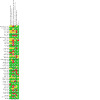
Risk of bias summary: review authors' judgements about each risk of bias item for each included study
3.
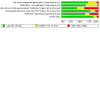
Risk of bias graph: review authors' judgements about each risk of bias item presented as percentages across all included studies
Allocation
Sequence generation
One study used an approach with a high risk of selection bias, as the technician, who had orthodontic knowledge, made the allocation without being blinded (Kaya 2019), and we judged another to be at high risk of bias as, despite adequate randomisation, there was no pre‐treatment equivalence between the two intervention groups (Shawesh 2010). It was unclear how 11 studies performed the sequence generation (Adanur‐Atmaca 2021; Arash 2020; Årtun 1987; Eroglu 2019; Ferreira 2019; Gelin 2020; Gunay 2018; Kumar 2011; Ramazanzadeh 2018; Scribante 2011; Wan 2017). All other studies had adequate sequence generation.
Allocation concealment
One study was at high risk of bias (Kaya 2019), and allocation concealment was unclear in 15 studies (Adanur‐Atmaca 2021; Arash 2020; Årtun 1987; Eroglu 2019; Ferreira 2019; Gelin 2020; Gunay 2018; Kumar 2011; Moslemzadeh 2018; Nagani 2020; Ramazanzadeh 2018; Salehi 2013; Scribante 2011; Sfrondini 2014; Soboutia 2016). Allocation concealment was adequate in the other 31 studies.
Selection bias
Combining both aspects, two studies were at high risk of selection bias (Kaya 2019; Shawesh 2010), and 16 had an unclear risk of selection bias (Adanur‐Atmaca 2021; Arash 2020; Årtun 1987; Eroglu 2019; Ferreira 2019; Gelin 2020; Gunay 2018; Kumar 2011; Moslemzadeh 2018; Nagani 2020; Ramazanzadeh 2018; Salehi 2013; Scribante 2011; Sfrondini 2014; Soboutia 2016; Wan 2017). The other 29 studies had a low risk of selection bias.
Blinding
The lack of ability to blind the participants and clinicians could potentially bias this type of research and should be noted when interpreting the findings.
Blinding of the assessors is possible, particularly when assessing stability on study models using some type of coverage to hide the retainer (Jowett 2022). Blinding of the assessors is also possible when assessing the results of participant satisfaction questionnaires. Eighteen studies had a high risk of detection bias as the outcome assessor was not blinded (Adanur‐Atmaca 2021; Arash 2020; Bolla 2012; Ferreira 2019; Forde 2018; Gelin 2020; Gera 2022; Kartal 2021; Krämer 2019; Nagani 2020; Naraghi 2021a; Rose 2002; Saleh 2017; Shim 2022; Sinha 2021; Sun 2011; Torkan 2014; Węgrodzka 2021). In nine of the studies, it was unclear if assessors were blinded (Alrawas 2020; Årtun 1987; Eroglu 2019; Gunay 2018; Kaya 2019; Kumar 2011; Scribante 2011; Sfrondini 2014; Soboutia 2016). In the other 20 studies, there was low risk of detection bias as they used blinding of outcome assessors where possible.
Incomplete outcome data
Four studies had a high risk of attrition bias as they did not fully report dropouts (Bolla 2012; Rohaya 2006; Sfrondini 2014; Torkan 2014); and risk of bias in six studies was unclear (Arash 2020; Årtun 1987; Ferreira 2019; Kumar 2011; Scribante 2011; Sinha 2021). The remaining 37 studies were at low risk of attrition bias as they reported and explained dropouts and withdrawals, which were justified and similarly distributed.
Selective reporting
Twelve studies had a high risk of reporting bias.
-
Eight did not report all outcomes prespecified in the methodology or protocols:
stability: overjet and overbite (Rowland 2007), arch length (Gunay 2018), or PAR index (Millett 2007);
adverse effects (Årtun 1987; Arash 2020);
stated more outcomes are to be reported (Rohaya 2006);
outcomes mentioned on a clinical trials register have not yet been reported (Sun 2011);
started collecting data for periodontal health, but abandoned this part way through the study due to time constraints (confirmed by contact with study author; Bolla 2012).
Two added outcomes not previously specified in the methodology or protocols: participant satisfaction (Rowland 2007; Rose 2002)
Two reported outcomes in part only: lower irregularity was reported, but not upper (Kumar 2011); did not report all mean values for patient satisfaction, which was measured by speech sounds through acoustic analysis (Wan 2017)
Six studies had unclear risk of reporting bias (Adanur‐Atmaca 2021; Eroglu 2019; Pandis 2013; Shim 2022; Sinha 2021; Węgrodzka 2021). The remaining 29 studies were at low risk of reporting bias as they showed no evidence of selective reporting.
Other potential sources of bias
We judged two studies to have a high risk of other bias. One study did not report in accordance with CONSORT guidelines, not describing important aspects of RCT design such as random sequence generation, allocation concealment, blinding, nor pre‐registering the protocol on an international registry platform (Ferreira 2019). One study compared Hawley with clear plastic retainers, but all participants were also fitted with bonded lower retainers from canine to canine, as well as their removable lower retainer (Saleh 2017).
Four studies had unclear risk of other bias: there was inadequate information in two studies (Kumar 2011; Millett 2007), and two studies were not reported according to CONSORT guidelines for RCTs (Scribante 2011; Sfrondini 2014).
The other 41 studies appeared to be free of other bias.
Effects of interventions
See: Table 1; Table 2; Table 3; Table 4; Table 5; Table 6
Comparison 1: removable retainers versus fixed retainers
Eight studies investigated removable retainers versus fixed retainers (see Included studies above).
In two studies, the comparisons were in the upper and lower arches.
Eroglu 2019 compared full‐time upper and lower Hawley retainers and full‐time upper and lower clear plastic retainers with upper and lower fixed lingual 5‐stranded wire bonded to incisors and canines.
Forde 2018 compared part‐time upper and lower clear plastic retainers with upper and lower 3‐stranded twistflex stainless steel wire bonded to incisors and canines. Review authors converted nonparametric data to parametric data as explained in the Methods section.
In one study, the comparison was in the upper arch only.
Naraghi 2021b compared part‐time upper clear plastic retainer with upper multistrand wire bonded only to the four incisors and bonded to the incisors and canines.
In five studies, the comparison was in the lower arch only.
Årtun 1987 compared a removable acrylic and wire retainer with different types of fixed retainers (amount of wear not reported).
Alrawas 2020 compared full‐time clear plastic retainers with three types of fixed bonded retainers to upper and lower incisors and canines: CAD/CAM nitinol, multistrand and single strand wires.
Krämer 2019 compared part‐time partial clear plastic retainers (not covering molars) with a 0.8 mm stainless steel hard single‐strand retainer bonded from canine to canine but only bonded on canines.
Millett 2007 compared full‐time lower clear plastic retainer with a multistrand stainless steel wire bonded to the canines and incisors.
O'Rourke 2016 compared a lower clear plastic retainer with a multistrand stainless steel wire bonded to the canines and incisors. Removable retainers were used full‐time for six months, then part‐time. Review authors converted nonparametric data to parametric data.
Stability
Six studies reported stability using Little's Irregularity Index (Analysis 1.1).
1.1. Analysis.
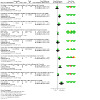
Comparison 1: Removable versus fixed retainers, Outcome 1: Stability: Irregularity Index
Little's Irregularity Index
Upper arch
Forde 2018 did not find a difference between removable clear plastic retainers used part‐time and fixed multistrand wire retainers, at 12 months (MD −0.34 mm, 95% CI −0.95 to 0.27; P = 0.27; 56 participants; Analysis 1.1.1).
Nor did Naraghi 2021b find a difference at 24 months when the fixed retainer was bonded to the four incisors (MD 0.40 mm, 95% CI −0.21 to 1.01; P = 0.20; 60 participants; Analysis 1.1.3).
When bonded to the six anterior teeth, there was less relapse with the fixed retainer compared to the part‐time clear plastic retainer (MD 0.7 mm, 95% CI 0.09 to 1.31; P = 0.02; 60 participants; Analysis 1.1.2).
Lower arch
We were able to undertake a meta‐analysis of data at six months from two studies (Alrawas 2020; O'Rourke 2016), which showed no difference between the removable clear plastic retainer worn full‐time and multistrand or coaxial fixed retainers (MD 0.05 mm, 95% CI −0.00 to 0.10; P = 0.06, I2 = 0%; 103 participants; Analysis 1.1.4).
Alrawas 2020 also compared the removable clear plastic retainers worn full time with two other types of fixed retainers at six months and showed no difference between fixed and removable retainers, versus single‐strand titanium (MD −0.10 mm, 95% CI −0.70 to 0.50; P = 0.74; 29 participants; Analysis 1.1.5); versus CAD/CAM nitinol (MD −0.06 mm, 95% CI −0.62 to 0.50; P = 0.83; 30 participants; Analysis 1.1.6).
At 12 months, two studies comparing full‐time (Millett 2007), and part‐time (Forde 2018), clear plastic retainers versus fixed multistrand retainers showed differences of 0.60 mm (95% CI 0.17 to 1.03; P = 0.007; 84 participants; Analysis 1.1.7) and 0.92 mm (95% CI 0.23 to 1.61; P < 0.009; 56 participants; Analysis 1.1.8), respectively, with slightly more relapse with the lower removable.
At 18 months, Krämer 2019 did not find a difference between a removable partial part‐time clear retainer and a fixed thick plain retainer bonded to canines (MD 0.07 mm, −0.20 to 0.34; P = 0.61; 95 participants; Analysis 1.1.9).
A second publication of the O'Rourke 2016 study, four years after debonding, reported a larger mean relapse of 1.52 mm (95% CI 0.75 to 2.29; P < 0.001; 42 participants; Analysis 1.1.10) in the removable part‐time clear plastic retainer compared to a coaxial fixed retainer.
Five of the six above‐mentioned studies also analysed intercanine and intermolar widths, and arch length changes (Analysis 1.2; Analysis 1.3; Analysis 1.4).
1.2. Analysis.
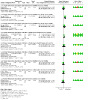
Comparison 1: Removable versus fixed retainers, Outcome 2: Stability: intercanine width
1.3. Analysis.
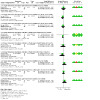
Comparison 1: Removable versus fixed retainers, Outcome 3: Stability: intermolar width
1.4. Analysis.
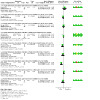
Comparison 1: Removable versus fixed retainers, Outcome 4: Stability: arch length
Intercanine width
Upper arch
In the upper arch, the intercanine width was similar between clear plastic part‐time removable and fixed multistrand retainers at 12 months (MD −0.06 mm, 95% CI −0.48 to 0.36; P = 0.78; 56 participants; Forde 2018; Analysis 1.2.1).
It was slightly higher at 24 months with the part‐time clear plastic compared to fixed multistrand retainer bonded on the six upper anterior teeth (MD 0.50 mm, 95% CI 0.23 to 0.77; P < 0.001; 60 participants; Naraghi 2021b; Analysis 1.2.2), but similar when the fixed retainer was bonded to the four incisors (MD 0.20 mm, 95% CI −0.23 to 0.63; P = 0.36; 60 participants; Naraghi 2021b; Analysis 1.2.3).
The removable group showed a small increase in intercanine width and the fixed group showed a small decrease (Analysis 1.2.2).
Lower arch
In the lower arch, we combined data from two studies (Alrawas 2020; O'Rourke 2016), and showed a small difference in the intercanine width at six months between removable clear plastic retainers worn full time and multistrand or coaxial fixed retainers (MD 0.11 mm, 95% CI 0.05 to 0.17; P < 0.001, I2 = 0%; 103 participants; Analysis 1.2.4).
Intermolar width
We found no significant differences between removable and different types of fixed retainers except for the intermolar width (Analysis 1.3).
Arch length
We found no significant changes in arch length other than for the comparison between lower removable clear plastic part‐time retainers versus fixed multistrand at 12 months (Forde 2018), with a small decrease in the part‐time removable group and a small increase in the fixed group (MD −0.80 mm, 95% CI −1.28 to −0.32; P < 0.001; 56 participants; Analysis 1.4.7).
Overjet and overbite
Three studies (Forde 2018; Krämer 2019; Naraghi 2021b), reported overjet and overbite changes at 12, 18 and 24 months, showing no significant changes between part‐time removable and fixed retainers (Analysis 1.5; Analysis 1.6).
1.5. Analysis.
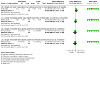
Comparison 1: Removable versus fixed retainers, Outcome 5: Stability: overjet
1.6. Analysis.
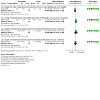
Comparison 1: Removable versus fixed retainers, Outcome 6: Stability: overbite
Maximum rotation: upper arch
Naraghi 2021b investigated maximum rotation (defined as the worst single tooth contact point per participant) in the upper arch two years after debonding. We found no significant differences when comparing part‐time clear plastic retainer and multistrand wire retainer bonded to the four incisors, but we found a significantly higher rotation in the removable group when the fixed retainer was bonded to the six upper anterior teeth (MD 3.70º, 95% CI 0.87 to 6.53; P = 0.01; 60 participants; Analysis 1.7.1).
1.7. Analysis.
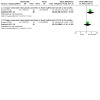
Comparison 1: Removable versus fixed retainers, Outcome 7: Stability: maximum rotation
Failure of retainers
Five studies reported failure of retainers (Årtun 1987; Forde 2018; Krämer 2019; Millett 2007; O'Rourke 2016), which they measured in different ways (Analysis 1.8; Analysis 1.9).
1.8. Analysis.

Comparison 1: Removable versus fixed retainers, Outcome 8: Failure of retainers
1.9. Analysis.
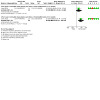
Comparison 1: Removable versus fixed retainers, Outcome 9: Mean survival time (days)
-
Rate of failure in %
Lost removable retainers and debonded fixed retainers (Årtun 1987)
Lost/fractured/not fitting/ removable retainers and detachment of fixed retainers (Krämer 2019)
Lost/ill fitting/fractured/occlusal wear removable retainers and debonded/fractured fixed retainers (Forde 2018)
Fractured/lost (but not worn) removable retainers and debonded fixed retainers (Millett 2007)
Noncompliance levels for removable and partial detachments or history of repairs for the fixed retainers (O'Rourke 2016)
Time to first episode of failure in days (mean survival time) (Forde 2018).
Upper arch
There was no difference in the failure rate between part‐time removable and fixed multistrand wire retainers at 12 months (RR 0.81, 95% CI 0.38 to 1.71; P = 0.58; 57 participants; Forde 2018; Analysis 1.8.1).
Lower arch
Two studies compared lower clear plastic retainers worn part‐time and full‐time, respectively, versus fixed multistrand wire retainers at 12 months, finding different results.
Forde 2018 found more failures in the fixed retainer group than in the part‐time removable group (RR 0.44, 95% CI 0.20 to 0.98; P = 0.04; 57 participants; Analysis 1.8.2).
In Millett 2007 there were more failures in the full‐time removable retainer group than the bonded retainer group (RR 3.42, 95% CI 1.38 to 8.47; P = 0.008; 77 participants; Analysis 1.8.3).
No differences were found between removable and thick plain wire fixed retainers at 18 months (Krämer 2019; Analysis 1.8.4),
No differences were found between the three types of fixed retainers and the removable retainer used in Årtun 1987 at three years (Analysis 1.8.5; Analysis 1.8.6; Analysis 1.8.7).
In O'Rourke 2016 there was a higher risk of noncompliance levels for the removable part‐time retainers compared to the percentage of failures of fixed retainers at 48 months (RR 3.0, 95% CI 1.33 to 6.75; P = 0.008; 42 participants; Analysis 1.8.8).
Only one study reported the time to first episode of failure (Forde 2018), and the mean difference was not significant (Analysis 1.9).
Patient satisfaction
Three studies investigated patient satisfaction when comparing clear plastic retainers worn part‐time and full‐time with bonded retainers (Forde 2018 (see Table 7); Krämer 2019; Millett 2007), through the following core categories.
1. Forde 2018: patient satisfaction by retainer group.
| Question | Bonded retainer (n = 30) | Clear plastic retainer (n = 30) | P‐value (Pearson Chi2) | |
| Do you wear your retainers as instructed? | All the time | 30 (100%) | 10 (33.3%) | P < 0.001a |
| Most of the time | 0 (0%) | 11 (36.7%) | ||
| Some of the time | 0 (0%) | 5 (16.7%) | ||
| Never | 0 (0%) | 1 (3.3%) | ||
| Missing data | 0 (0%) | 3 (10%) | ||
| Has your retainer broken or come off since it was fitted? | Yes more than once | 5 (16.7%) | 1 (3.3%) | P = 0.001a |
| Yes once | 12 (40%) | 2 (6.7%) | ||
| No | 13 (43.3%) | 24 (80%) | ||
| Missing data | 0 (0%) | 3 (10%) | ||
| Have you lost your retainer since it was fitted? | Yes more than once | 0 (0%) | 2 (6.7%) | P = 0.73 |
| Yes once | 1 (3.3%) | 3 (10%) | ||
| No | 29 (96.7%) | 22 (73.3%) | ||
| Missing data | 0 (0%) | 3 (10%) | ||
| Are you embarrassed to wear your retainer? | Yes most of the time | 0 (0%) | 0 (0%) | P = 0.065 |
| Yes on occasion | 0 (0%) | 2 (6.7%) | ||
| No | 30 (100%) | 25 (83.3%) | ||
| Missing data | 0 (0%) | 3 (10%) | ||
| Have you experienced any discomfort with your retainers? | Yes most of the time | 0 (0%) | 1 (3.3%) | P = 0.002a |
| Yes on occasion | 1 (3.3%) | 10 (33.3%) | ||
| No | 29 (96.7%) | 16 (53.3%) | ||
| Missing data | 0 (0%) | 3 (10%) | ||
| Has your retainer affected your speech? | Yes most of the time | 0 (0%) | 2 (6.7%) | P = 0.004a |
| Yes on occasion | 4 (13.3%) | 12 (40%) | ||
| No | 26 (86.7%) | 13 (43.3%) | ||
| Missing data | 0 (0%) | 3 (10%) | ||
| How have you found wearing your retainer in comparison to your fixed appliances? | Better | 17 (56.7%) | 16 (53.3%) | P = 0.096 |
| The same | 12 (40%) | 7 (23.3%) | ||
| Worse | 0 (0%) | 4 (13.3%) | ||
| Missing data | 1 (3.3%) | 3 (10%) | ||
| How have you found cleaning your retainers? | Very easy | 2 (6.7%) | 12 (40%) | P = 0.001a |
| Easy | 18 (60%) | 13 (43.3%) | ||
| Difficult | 10 (33.3%) | 2 (6.7%) | ||
| Missing data | 0 (0%) | 3 (10%) | ||
aResponses to patient satisfaction questionnaires following 12 months of retention.
Acceptance
Three studies reported that fixed retainers were more acceptable than removable retainers.
Two studies reported at 12 months of follow‐up, with continuous and dichotomous outcomes and with different wearing protocols, which prevented statistical pooling (Millett 2007: MD −12.84 (95% CI −18.10 to −7.09; P < 0.001; 81 participants; Analysis 1.10.1; Forde 2018; RD 0.15, 95% CI 0.00 to 0.29; P = 0.04; 56 participants; Analysis 1.11.2).
One study reported at 18‐month follow‐up (Krämer 2019; MD −7.50, 95% CI −11.54 to −3.46; P < 0.001; 95 participants; Analysis 1.10.2).
Forde 2018 also reported that there was no difference in the embarrassment felt by participants wearing either type of retainer (RD 0.07, 95% CI −0.04 to 0.19; P = 0.21; 57 participants; Analysis 1.11.1).
1.10. Analysis.
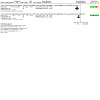
Comparison 1: Removable versus fixed retainers, Outcome 10: Patient satisfaction: acceptance
1.11. Analysis.
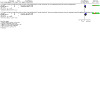
Comparison 1: Removable versus fixed retainers, Outcome 11: Patient satisfaction: acceptance (dichotomous)
Compliance
One study reported that compliance with retainer instructions was lower with the part‐time removable clear plastic retainers than the fixed retainers (RD 0.22, 95% CI 0.06 to 0.38; P = 0.007; 57 participants; Forde 2018; Analysis 1.12.1).
1.12. Analysis.

Comparison 1: Removable versus fixed retainers, Outcome 12: Patient satisfaction: compliance (dichotomous)
Efficiency
One study (Krämer 2019), assessed efficiency of the retainers as perceived by participants through two questions and found no difference between the two types of retainers.
“Are the retainers working well?”: MD 2.00 (95% CI −2.75 to 6.75; P = 0.41; 95 participants; Analysis 1.13.1)
“Noticed any change in tooth position?”: MD 2.00 (95% CI −2.66 to 6.66; P = 0.40; 95 participants; Analysis 1.13.2)
1.13. Analysis.
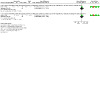
Comparison 1: Removable versus fixed retainers, Outcome 13: Patient satisfaction: efficiency
Cleaning/hygiene
Two studies reported cleaning or hygiene of fixed retainers compared to removable clear plastic retainers, with opposite findings.
In Millett 2007,participants who wore fixed retainers found them easier to clean than those who wore removable retainers part‐time (MD −10.31, 95% CI −20.05 to −0.58; P = 0.04; 81 participants; Analysis 1.14).
In Forde 2018, however, participants who wore the fixed retainers were less likely to report finding them easy to clean than those wearing the removable retainers full‐time (RR 1.39, 95% CI 1.06 to 1.83; P = 0.02; 57 participants; Analysis 1.15.1).
1.14. Analysis.
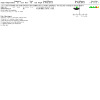
Comparison 1: Removable versus fixed retainers, Outcome 14: Patient satisfaction: cleaning/hygiene (continuous)
1.15. Analysis.
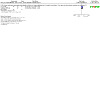
Comparison 1: Removable versus fixed retainers, Outcome 15: Patient satisfaction: cleaning/hygiene (dichotomous)
Comfort, discomfort or pain
Two studies assessed this outcome (Forde 2018; Krämer 2019).
-
Krämer 2019 differentiated between three aspects:
“pain or discomfort” without significant differences (MD 5.00, 95% CI −2.21 to 12.21; P = 0.17; 95 participants; Analysis 1.16.1);
“soreness” with differences favouring fixed retainers (MD 2.00, 95% CI 0.72 to 3.28; P = 0.002; 95 participants; Analysis 1.16.2); and
“tension in your teeth” with differences favouring fixed retainers (MD 8.50, 95% CI 2.53 to 14.47; P = 0.005; 95 participants; Analysis 1.16.3).
Forde 2018reported differences favouring fixed retainers (RR 12.22, 95% CI 1.69 to 88.52; P = 0.01; 57 participants; Analysis 1.17.1).
1.16. Analysis.
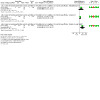
Comparison 1: Removable versus fixed retainers, Outcome 16: Patient satisfaction: discomfort/pain
1.17. Analysis.
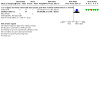
Comparison 1: Removable versus fixed retainers, Outcome 17: Patient satisfaction: discomfort/pain (dichotomous)
We could not pool these results because Krämer 2019 reported continuous data and Forde 2018 reported dichotomous data.
Speech
One study (Forde 2018), evaluated speech and found more favourable results with fixed retainers than removable clear plastic retainers (RR 3.89, 95% CI 1.46 to 10.38; P = 0.007; 57 participants; Analysis 1.18.1).
1.18. Analysis.
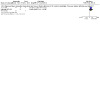
Comparison 1: Removable versus fixed retainers, Outcome 18: Patient satisfaction: speech (dichotomous)
Adverse effects on health
Five studies reported different outcomes related to oral health, when comparing removable with bonded retainers (Alrawas 2020; Eroglu 2019; Forde 2018; Millett 2007; O'Rourke 2016):
evidence of caries (Millett 2007; Analysis 1.19);
Plaque Index (Alrawas 2020; Eroglu 2019; Forde 2018; O'Rourke 2016; Analysis 1.20);
Gingival Index (Alrawas 2020; Eroglu 2019; Forde 2018; Analysis 1.21) and gingival bleeding (dichotomous) (Millett 2007; (Analysis 1.22);
Calculus Index (Forde 2018; Analysis 1.23);
probing depth (Alrawas 2020; Eroglu 2019; Analysis 1.24) and periodontal pocketing (dichotomous) (Millett 2007; Analysis 1.25);
bleeding on probing (Alrawas 2020; Eroglu 2019; Analysis 1.26).
1.19. Analysis.
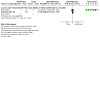
Comparison 1: Removable versus fixed retainers, Outcome 19: Oral health: evidence of caries (dichotomous)
1.20. Analysis.
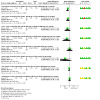
Comparison 1: Removable versus fixed retainers, Outcome 20: Oral health: Plaque Index
1.21. Analysis.
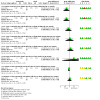
Comparison 1: Removable versus fixed retainers, Outcome 21: Oral health: Gingival Index
1.22. Analysis.

Comparison 1: Removable versus fixed retainers, Outcome 22: Oral health: Calculus Index
1.23. Analysis.
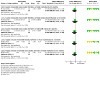
Comparison 1: Removable versus fixed retainers, Outcome 23: Oral health: probing depth
1.24. Analysis.
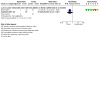
Comparison 1: Removable versus fixed retainers, Outcome 24: Oral health: periodontal pocketing (dichotomous)
1.25. Analysis.

Comparison 1: Removable versus fixed retainers, Outcome 25: Oral health: bleeding on probing
1.26. Analysis.
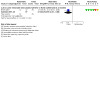
Comparison 1: Removable versus fixed retainers, Outcome 26: Oral health: gingival bleeding (dichotomous)
It was not possible to pool results from these outcomes due to comparison of markedly different types of retainers.
Evidence of caries
There was no difference in evidence of caries when comparing lower removable clear plastic full‐time versus fixed multistrand at 12 months (Millett 2007; Analysis 1.19.1).
Plaque Index: upper and lower arches
Only one study (Forde 2018), showed differences in Plaque Index, favouring part‐time clear plastic retainers versus multistrand wire bonded retainers at 12 months in the upper arch (MD −0.17, 95% CI −0.29 to −0.05; P = 0.005; 59 participants; Analysis 1.20).
However, no differences were found in the lower arch (Analysis 1.20.2).
Two studies (Alrawas 2020; O'Rourke 2016), compared lower full‐time and part‐time clear plastic retainers with different lower fixed retainers and found no differences at various time points (Analysis 1.20.3 to Analysis 1.20.6).
One study showed pooled data for the upper and lower arches, and compared full‐time Hawley (Analysis 1.20.7) and clear plastic retainers (Analysis 1.20.8) versus multistrand wire bonded retainers at three months (Eroglu 2019). No differences were found.
Gingival Index: upper and lower arches
Forde 2018 found lower Gingival Index in the part‐time clear plastic retainer group in the lower arch (MD −0.34, 95% CI −0.66 to −0.02; P = 0.04; 59 participants; Analysis 1.21.2) but not in the upper arch (Analysis 1.21.1) at 12 months.
The same studies described above for Plaque Index reported non‐significant differences in Gingival Index between full‐time and part‐time removable retainers and fixed retainers at different time‐points in the lower arch only (Analysis 1.21.3 to Analysis 1.21.6) or in both arches (Analysis 1.21.7; Analysis 1.21.8).
Calculus Index
Only Forde 2018 found higher values in the lower fixed multistrand group at 12 months (MD −0.15, 95% CI −0.29 to −0.01; P = 0.03; 59 participants; Analysis 1.22.2) compared to the part‐time clear plastic retainers.
Probing depth
In Millett 2007, periodontal pocketing (probing depth), recorded as a dichotomous variable, was higher in the bonded lower retainer group (RR 0.32, 95% CI 0.12 to 0.87; P = 0.03; 84 participants; Analysis 1.24) compared to the lower removable clear plastic full‐time group. The remaining studies did not show differences in probing depth when comparing removable and fixed retainers.
Bleeding on probing
Bleeding on probing was higher in one arm of Alrawas 2020, with slightly higher values in the lower arch for clear plastic group used full‐time compared to the fixed CAD/CAM nitinol bonded retainer at six months (MD 0.12, 95% CI 0.00 to 0.24; P = 0.05; 30 participants; Analysis 1.25.3). However, no differences were found for the other two types of fixed retainers used in this study (multistrand and single‐strand wire retainers).
One study (Eroglu 2019) reported differences (although clinically insignificant) in bleeding on probing, favouring the fixed multistrand retainer over the Hawley retainer (MD 0.03, 95% CI 0.00 to 0.06; P = 0.03; 30 participants; Analysis 1.25.4), but found no difference when compared to the clear plastic retainer (Analysis 1.25.5).
Millett 2007 recorded gingival bleeding as a dichotomous variable. It was higher in the fixed retainer group (RR 0.53, 95% CI 0.31 to 0.88; P = 0.01; 84 participants; Analysis 1.26.1).
Comparison 2: fixed retainers versus fixed retainers
Twenty‐five studies compared different types of fixed retainers.
Seven studies reported four comparisons in the upper and lower arches.
Bolla 2012, Salehi 2013 and Torkan 2014 compared upper and lower fibre‐reinforced composite fixed retainer versus multistrand wire fixed retainers.
Gera 2022 and Jowett 2022 compared upper and lower CAD/CAM nitinol versus multistrand wire fixed retainers.
Sfrondini 2021 compared upper and lower multistrand wire retainers bonded using two types of composite: highly filled orthodontic resin versus flowable nanocomposite.
Scribante 2020 compared upper and lower multistrand wire retainers bonded using two types of primers: universal adhesive in total‐etch mode versus traditional orthodontic primer.
In one study, the comparison was in the upper arch only.
Naraghi 2021b compared upper multistrand wire bonded only to the four incisors or bonded to the six anterior teeth.
In 17 studies, the comparison was in the lower arch only.
Adanur‐Atmaca 2021 compared four types of lower fixed retainers: rectangular braided multistrand (dead‐soft) wire, round multistrand stainless‐steel wire, CAD/CAM nitinol retainer and 0.012 inch connected tooth‐shaped bonding pad retainer on the lingual surface of each tooth.
Alrawas 2020 compared three types of lower fixed bonded retainers: CAD/CAM nitinol, multistrand and single‐strand wires.
Arash 2020 compared lower multistrand versus soft thick plain titanium wire fixed retainers.
Årtun 1987 compared three types of lower fixed retainers: thick (0.032 inch) plain stainless steel wire bonded only to the canines, thick (0.032 inch) spiral stainless steel wire bonded only to the canines and a thin (0.0205 inch) spiral wire bonded to the canines and incisors.
Ferreira 2019 compared a rigid round steel wire retainer bonded only to the lower canines versus rectangular chain retainer bonded to lower incisors and canines.
Gelin 2020 and Kartal 2021 compared lower CAD/CAM nitinol versus multistrand wire retainers.
Gunay 2018 compared a lower indirect multistrand wire versus a direct dead‐soft coaxial wire retainer.
Nagani 2020; Rose 2002; Scribante 2011 and Sfrondini 2014 compared lower fibre‐reinforced composite retainer versus multistrand wire fixed retainers.
Pandis 2013 compared lower multistrand wire retainers bonded using two types of chemically and light‐cured adhesives and composites.
Shim 2022 compared three types of lower fixed retainers: CAD/CAM multistrand stainless steel wire, lab‐based retainer (same type of wire as the CAD/CAM group, but manually bent), and rectangular chain stainless steel retainer.
Sinha 2021 compared ceramic interlocking retainer versus flexible round coaxial wire (0.016 inch) retainer.
Soboutia 2016 compared three types of fixed retainers: fibre‐reinforced composite versus twisted ligature wire versus spiral wire (multistrand wire).
Węgrodzka 2021 compared three‐strand round twisted versus eight‐strand rectangular braided retainers.
Stability
Little's Irregularity Index
Nine studies reported stability using Little's Irregularity Index (Analysis 2.1).
2.1. Analysis.
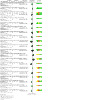
Comparison 2: Fixed versus fixed retainers, Outcome 1: Stability: Irregularity Index
Upper arch
Jowett 2022 did not find significant differences between a CAD/CAM nitinol fixed retainer and a rectangular chain fixed retainer when the irregularity index was assessed at six months (Analysis 2.1.1).
Naraghi 2021b compared a multistrand retainer bonded to the four upper incisors with the same retainer bonded to incisors and canines at 24 months, and found less relapse in the second group, but it may not be clinically significant (MD 0.3 mm, 95% CI 0.03 to 0.57; P = 0.03; 60 participants; Analysis 2.1.2).
Lower arch
Eight studies reported results at six months, and three of these studies also reported results at 12 months.
At six months, three studies comparing CAD/CAM nitinol versus multistrand wire fixed retainers (Adanur‐Atmaca 2021; Alrawas 2020; Gera 2022), did not show significant differences in the irregularity index (MD −0.03, 95% CI −0.12 to 0.06; P = 0.52; I2= 22%; 258 participants; Analysis 2.1.3).
When CAD/CAM nitinol retainers were compared to rectangular chain retainers (Jowett 2022; Analysis 2.1.4) and single‐strand titanium retainers (Alrawas 2020; Analysis 2.1.5), no significant differences were found in the amount of relapse at six months. Non‐significant differences were also found at six months in Alrawas 2020, Nagani 2020, Shim 2022 and Sinha 2021, among different types of lower fixed retainers (Analysis 2.1.6 to Analysis 2.1.11).
Gunay 2018, however, found significantly more relapse in the direct dead‐soft coaxial than in the indirect multistrand fixed retainer group at six months (MD 0.96, 95% CI 0.57 to 1.35, 120 participants; Analysis 2.1.12) and 12 months (MD 1.15 mm, 95% CI 0.74 to 1.56; P < 0.001; 120 participants; Analysis 2.1.13).
At 12 months, Nagani 2020 also found significant differences, with less relapse in the fibre‐reinforced composite group compared to multistrand retainer group (MD −0.7 mm, 95% CI −1.17 to −0.23; P = 0.003; 52 participants; Analysis 2.1.14).
Adanur‐Atmaca 2021 showed more relapse in the rectangular braided retainers (MD 0.3 mm, 95% CI 0.10 to 0.63; P = 0.007; 66 participants; Analysis 2.1.15) and in the rigid connected bonding pad retainer (MD 0.38 mm, 95% CI 0.17 to 0.58; P < 0.001; 66 participants; Analysis 2.1.17) than in the round multistrand retainers, and also less relapse in the lower CAD/CAM nitinol retainer compared to the rectangular braided (MD −0.46 mm, 95% CI −0.72 to −0.21; P < 0.001; 66 participants; Analysis 2.1.18) and rigid connected bonding pad retainer (MD −0.47 mm, 95% CI −0.66 to −0.29; P < 0.001; 66 participants; Analysis 2.1.20).
Intercanine width
Nine studies assessed intercanine width (Analysis 2.2).
2.2. Analysis.
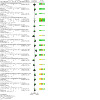
Comparison 2: Fixed versus fixed retainers, Outcome 2: Stability: intercanine width
Upper arch
Gera 2022 did not find any significant differences in intercanine width changes between multistrand wire retainers and CAD/CAM nitinol retainers at six months (Analysis 2.2.1).
Naraghi 2021b compared a multistrand retainer bonded to the four upper incisors with a retainer bonded to the six anterior teeth at 24 months and did not find any significant differences (Analysis 2.2.2).
Jowett 2022, however, found greater decrease in intercanine width in the rectangular chain group compared to the CAD/CAM nitinol retainer group at six months (MD 1.12 mm, 95% CI 0.80 to 1.45; P < 0.001; 55 participants; Analysis 2.2.3).
Lower arch
Seven studies reported results at six months, and three of these studies also reported results at 12 months.
At six months, four studies comparing CAD/CAM nitinol versus multistrand wire fixed retainers (Adanur‐Atmaca 2021; Alrawas 2020; Gelin 2020; Gera 2022), did not show significant differences in the intercanine width changes (MD 0.04 mm, 95% CI −0.15 to 0.22; P = 0.70; I2 = 0%; 309 participants; Analysis 2.2.4).
Similar non‐significant changes were reported by different studies comparing different types of fixed retainers or bonding procedures: two more arms of Alrawas 2020 (Analysis 2.2.5; Analysis 2.2.6), Gunay 2018 (Analysis 2.2.7), and one arm of Shim 2022 (Analysis 2.2.9).
In contrast, Jowett 2022 found significantly greater decrease in the intercanine width in the rectangular chain group compared to the CAD/CAM nitinol retainer group (MD 0.47 mm, 95% CI 0.12 to 0.82; P = 0.008; 55 participants; Analysis 2.2.8)
Shim 2022 found greater decrease in the rectangular chain group compared to the CAD/CAM stainless steel (MD 1.23 mm; 95% CI 0.82 to 1.64; P < 0.001; 30 participants; Analysis 2.2.10) and laboratory‐constructed multistrand retainers (MD 0.92 mm, 95% CI 0.49 to 1.35; P < 0.001; 30 participants; Analysis 2.2.11).
At 12 months, there were no significant differences between the different comparisons of fixed retainers: Gunay 2018 (Analysis 2.2.12); and different arms of Adanur‐Atmaca 2021 (Analysis 2.2.13 to Analysis 2.2.17).
We were able to combine two studies (Gelin 2020 and one arm of Adanur‐Atmaca 2021; Analysis 2.2.18), but did not find significant differences in the intercanine width changes.
Interpremolar width: upper and lower arches
One study (Gera 2022), assessed interpremolar width but did not find significant differences between CAD/CAM nitinol versus multistrand wire fixed retainers in the upper and lower arches at six months (Analysis 2.3.1; Analysis 2.3.2).
2.3. Analysis.

Comparison 2: Fixed versus fixed retainers, Outcome 3: Stability: interpremolar width
Intermolar width
Four studies assessed intermolar width (Analysis 2.4).
2.4. Analysis.
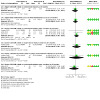
Comparison 2: Fixed versus fixed retainers, Outcome 4: Stability: intermolar width
Upper arch
One study (Gera 2022), reported nonsignificant changes at six months (Analysis 2.4.1) and another study (Naraghi 2021b), at 24 months (Analysis 2.4.2).
Lower arch
We found similar, non‐significant results when we combined three studies (Alrawas 2020; Gelin 2020; Gera 2022), that compared CAD/CAM nitinol versus multistrand stainless steel retainers at six months (MD 0.28 mm, 95% CI −0.38 to 0.93; P = 0.41; I2 = 0%; 243 participants; Analysis 2.4.3).
Other results at 6 and 12 months showed the same non‐significant differences (Analysis 2.4.4; Analysis 2.4.5; Analysis 2.4.6).
Anterior arch length: lower arch
Two studies (Alrawas 2020; Gelin 2020), assessed anterior arch length; Alrawas 2020 had three arms (Analysis 2.5). No significant differences were found when comparing different types of lower fixed retainers at six (Analysis 2.5.1; Analysis 2.5.2; Analysis 2.5.3), and 12 months (Analysis 2.5.4).
2.5. Analysis.
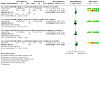
Comparison 2: Fixed versus fixed retainers, Outcome 5: Stability: anterior arch length
Total arch length
Four studies assessed total arch length (Analysis 2.6).
2.6. Analysis.
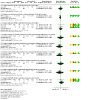
Comparison 2: Fixed versus fixed retainers, Outcome 6: Stability: total arch length
Upper arch
Two studies reported non‐significant changes at six months (Gera 2022 – Analysis 2.6.1) and 24 months (Naraghi 2021b – Analysis 2.6.2).
Lower arch
The same non‐significant results were found in the lower arch.
We were able to combine three studies (Adanur‐Atmaca 2021; Gelin 2020; Gera 2022), that compared CAD/CAM nitinol versus multistrand stainless steel retainers at six months (MD −0.02 mm, 95% CI −0.58 to 0.53; P = 0.93; I2 = 0%; 280 participants; Analysis 2.6.3).
At 12 months, results showed the same non‐significant differences (Analysis 2.6.4. to Analysis 2.6.8).
We were able to combine results at 12 months for two of the three studies mentioned above (Adanur‐Atmaca 2021; Gelin 2020), showing non‐significant differences (Analysis 2.6.9).
Overjet and overbite
Only one study (Naraghi 2021b), reported changes to overjet (Analysis 2.7) and overbite (Analysis 2.8) for the upper arch at 24 months, comparing upper fixed retainers bonded to the four anterior teeth and to the six anterior teeth. Changes in these outcomes were not significantly different between groups.
2.7. Analysis.
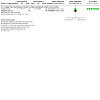
Comparison 2: Fixed versus fixed retainers, Outcome 7: Stability: overjet
2.8. Analysis.
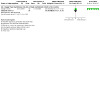
Comparison 2: Fixed versus fixed retainers, Outcome 8: Stability: overbite
Maximum rotation
The same study (Naraghi 2021b), investigated maximum rotation, measured as the worst single tooth contact point per participant. Significantly higher rotation was found when the retainer was bonded to the four upper anterior teeth compared to bonding to the six anterior teeth (MD 2.30º, 95% CI 0.80 to 3.80; P = 0.003; 60 participants; Analysis 2.9).
2.9. Analysis.
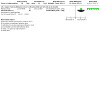
Comparison 2: Fixed versus fixed retainers, Outcome 9: Stability: maximum rotation
Failure of retainers
Twenty studies reported failure of retainers: six of them in the upper and lower arches (Bolla 2012; Gera 2022; Jowett 2022; Salehi 2013; Scribante 2020; Sfrondini 2021), and the rest of them only in the lower arch (Arash 2020; Årtun 1987; Gelin 2020; Gunay 2018; Kartal 2021; Nagani 2020; Pandis 2013; Rose 2002; Scribante 2011; Sfrondini 2014; Shim 2022; Sinha 2021; Soboutia 2016; Węgrodzka 2021). Studies reported failure/survival of retainers in different ways:
rate of failure in %, as number of debonded/fractured retainers (Analysis 2.10);
mean survival time: time to first episode of failure in months (Analysis 2.10);
failure risk (hazard ratio) (Analysis 2.12).
2.10. Analysis.
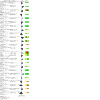
Comparison 2: Fixed versus fixed retainers, Outcome 10: Failure of retainers
2.12. Analysis.
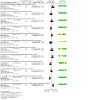
Comparison 2: Fixed versus fixed retainers, Outcome 12: Failure risk (Hazard Ratio)
Failure rate
Upper arch
At six months, Gera 2022 concluded that the failure rate was not significantly different between CAD/CAM nitinol and multistrand wire retainers (RR 0.99 mm, 95% CI 0.57 to 1.70; P = 0.96; 163 participants; Analysis 2.10.1).
Jowett 2022, however, found a significantly higher failure rate in CAD/CAM nitinol than in rectangular chain retainers (RR 2.90, 95% CI 1.20 to 7.03; P = 0.02; 55 participants; Analysis 2.10.2).
Two studies (Bolla 2012; Salehi 2013), compared failure rates of fibre‐reinforced composite retainers with multistrand retainers in the maxilla, and it was possible to undertake a meta‐analysis of these data. The pooled estimate showed an RR of 1.25 (95% CI 0.87 to 1.78; P = 0.22), indicating no difference in the failure rates. There was low heterogeneity between the studies (I2 = 22%), with very similar methodology and materials used in both studies (Analysis 2.10.3).
Two studies compared the failure rate associated with different bonding procedures of multistrand wire retainers at 24 months. Scribante 2020 found a significantly lower failure rate when a conventional orthodontic composite was used compared to a flowable composite (RR 0.50, 95% CI 0.28 to 0.89; P = 0.02; 600 participants; Analysis 2.10.4), and Sfrondini 2021 found significantly more bonding failures when a conventional orthodontic primer was used compared to a universal primer in total‐etch mode (RR 2.23, 95% CI 1.38 to 3.59; P = 0.001; 600 participants; Analysis 2.10.5).
Lower arch
Two studies (Gera 2022; Kartal 2021), that compared CAD/CAM nitinol versus multistrand wire retainers did not find significant differences at six months (RR 1.00, 95% CI 0.67 to 1.50; P = 0.99; I2 = 0%; 215 participants; Analysis 2.10.6).
Jowett 2022 and Sinha 2021 did not find significant differences when comparing failure rates of CAD/CAM nitinol versus rectangular chain retainers (Analysis 2.10.7) and ceramic interlocking bonded retainer and coaxial wire retainer (Analysis 2.10.8), respectively, at six months.
No differences were found in the three arms of Shim 2022 either (Analysis 2.10.9. to Analysis 2.10.11) between CAD/CAM stainless steel, laboratory‐fabricated stainless steel multistrand and chairside formed rectangular chain retainers.
At 12 months (or more), different comparisons of fixed retainers did not find significant differences either for directly bonded coaxial wire versus indirectly bonded multistrand retainer (Gunay 2018; Analysis 2.10.12); CAD/CAM nitinol versus multistrand wire retainers (Gelin 2020; Analysis 2.10.13); fibre‐reinforced composite retainer versus multistrand fixed retainer (RR 1.01, 95% CI 0.84 to 1.21; P = 0.95; I2 = 60%; 7 studies, 1337 participants; Analysis 2.10.14).
At 24 months, Soboutia 2016 found similar failure rates when comparing fibre‐reinforced composite versus twisted ligature wire (Analysis 2.10.15) and spiral wire versus twisted ligature wire (Analysis 2.10.16). Węgrodzka 2021 did not find significantly different failure rates between round twisted multistrand and rectangular braided multistrand retainers at 24 months either (Analysis 2.10.17).
Similar to their findings for the upper arch, at 24 months, Scribante 2020 found a significantly lower failure rate when a conventional orthodontic composite was used compared to a flowable composite (RR 0.53, 95% CI 0.32 to 0.87; P = 0.01; 600 participants; Analysis 2.10.18), and Sfrondini 2021 found significantly more bonding failures when a conventional orthodontic primer was used compared to a universal primer in total‐etch mode (RR 5.11, 95% CI 3.17 to 8.25; P < 0.001; 600 participants; Analysis 2.10.19).
However, Pandis 2013 did not find significantly different failure rates of mandibular lingual retainers between chemically and light‐cured adhesives at 24 months (Analysis 2.10.20).
One study (Arash 2020) compared thick plain wire (canine to canine) versus thin spiral wire (incisors and canines). Significantly lower failure rates were found in the thick plain wire group (RR 0.49, 95% CI 0.25 to 0.98; P = 0.04; 240 participants; Analysis 2.10.21).
There was no difference between the failure rates of the other three comparisons of fixed retainers in Årtun 1987 (Analysis 2.10.22; Analysis 2.10.23; Analysis 2.10.24).
Mean survival time: lower arch
Three studies reported mean survival time as the time to first episode of failure in months in the lower arch.
Arash 2020 did not find significant differences at 24 months between a thick plain titanium wire and a twisted wire retainer (Analysis 2.11.1).
Soboutia 2016 found significant differences at 24 months among the three types of fixed retainers analysed. The multistrand spiral wire and the fibre‐reinforced composite retainers showed shorter survival time than the twisted ligature wire retainer (MD −0.99 months, 95% CI −1.33 to −0.65; P value < 0.00001; 86 participants; Analysis 2.11.2); (MD −2.40 months, 95% CI −2.77 to −2.04; P < 0.001; 87 participants; Analysis 2.11.3), respectively.
Two studies (Rose 2002; Soboutia 2016), showed shorter survival time for fibre‐reinforced composite retainer than multistrand wire retainer (MD −1.48 months, 95% CI −1.88 to −1.08; P < 0.001; I2 = 94%; 103 participants; Analysis 2.11.4).
2.11. Analysis.
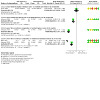
Comparison 2: Fixed versus fixed retainers, Outcome 11: Mean survival time (months)
Failure risk
We assessed failure risk by means of hazard ratios.
Upper arch
Jowett 2022 found significantly higher failure risk at six months for the CAD/CAM nitinol versus the multistrand wire fixed retainer (HR 2.82, 95% CI 1.00 to 7.97; P = 0.05; 55 participants; Analysis 2.12.1).
Gera 2022 did not find significant differences in the failure risk at six months when comparing these two types of retainers (Analysis 2.12.2).
Lower arch
The same studies (Gera 2022; Jowett 2022), also found no differences in the failure risk of CAD/CAM nitinol versus the multistrand wire fixed retainers (Analysis 2.12.3; Analysis 2.12.4).
Sfrondini 2014 found a significantly higher failure risk for the multistrand spiral wire versus fibre‐reinforced composite at 12 months, (HR 1.64, 95% CI 1.04 to 2.59; P = 0.03; 87 participants; Analysis 2.12.5).
We found non‐significant hazard ratios, indicating similar failure risks, in different studies comparing different lower fixed retainers: fibre‐reinforced composite versus multistrand fixed retainers at 12 months (Scribante 2011 – Analysis 2.12.6); spiral wire versus twisted ligature wire retainers and fibre‐reinforced composite versus twisted ligature wire retainers at 24 months (Soboutia 2016 – Analysis 2.12.7; Analysis 2.12.8); round twisted multistrand versus rectangular braided multistrand retainers (Węgrodzka 2021 – Analysis 2.12.9); and multistrand retainers bonded using chemically and light‐cured adhesives at 24 months (Pandis 2013 – Analysis 2.12.10).
Upper and lower arches
Combined results for upper and lower arches showed significantly lower failure risk when a conventional orthodontic composite was used compared to a flowable composite (Scribante 2020: HR 0.50, 95% CI 0.34 to 0.73; P < 0.001; 100 participants; Analysis 2.12.11), and a significantly higher failure risk when a conventional orthodontic primer was used compared to a universal primer in total‐etch mode (Sfrondini 2021: HR 3.77, 95% CI 2.78 to 5.11; P < 0.001; 100 participants; Analysis 2.12.12).
Patient satisfaction
Three studies (Ferreira 2019; Jowett 2022; Scribante 2011), investigated patient satisfaction when comparing different types of fixed retainers using the following core categories.
Efficiency
One study (Jowett 2022), that compared CAD/CAM nitinol fixed retainer and a rectangular chain bonded retainer of the retainers, assessed efficiency as perceived by participants. They used the question: “Did your retainer keep your teeth straight?” No significant differences were found between the groups in the upper or lower jaw (RR 1.00, 95% CI 0.91 to 1.10; P = 1.00; 62 participants; Analysis 2.13.1; Analysis 2.13.2).
2.13. Analysis.

Comparison 2: Fixed versus fixed retainers, Outcome 13: Patient satisfaction: efficiency
Cleaning and hygiene
Two studies (Ferreira 2019; Jowett 2022) assessed cleaning and hygiene.
Jowett 2022 compared CAD/CAM nitinol fixed retainer versus rectangular chain bonded retainer through the following question: “Was your retainer easy to look after?” No significant differences were found between the groups in the upper jaw (RD 0.00, 95% CI −0.06 to 0.06; P = 1.00; 62 participants; Analysis 2.14.1) and in the lower jaw (RD 0.03, 95% CI −0.05 to 0.12; P = 0.46; 62 participants; Analysis 2.14.2).
Ferreira 2019 reported significant results. Participants found it easier to clean around the rigid retainer bonded only on the canines compared to the rectangular chain bonded to all the anterior teeth in the lower jaw (RD 1.00, 95% CI 0.88 to 1.12; P < 0.001; 30 participants; Analysis 2.14.3).
2.14. Analysis.
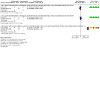
Comparison 2: Fixed versus fixed retainers, Outcome 14: Patient satisfaction: cleaning/hygiene
Comfort
Two studies (Ferreira 2019; Jowett 2022), assessed comfort.
Jowett 2022 compared CAD/CAM nitinol fixed retainer versus rectangular chain bonded retainer through the following question: “Was your retainer comfortable?” and found no significant differences between the groups in the upper jaw (RD −0.06, 95% CI −0.17 to 0.04; P = 0.22; 62 participants; Analysis 2.15.1), or the lower jaw (RD 0.00, 95% CI −0.06 to 0.06; P = 1.00; 62 participants; Analysis 2.15.2).
Ferreira 2019 reported no better comfort with the rigid retainer bonded only on the canines compared to the rectangular chain bonded retainer in the lower jaw (RD 0.20, 95% CI −0.15 to 0.55; P = 0.26; 30 participants; Analysis 2.15.3).
2.15. Analysis.
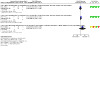
Comparison 2: Fixed versus fixed retainers, Outcome 15: Patient satisfaction: comfort
Speech
One study (Jowett 2022), that compared CAD/CAM nitinol fixed retainer and a rectangular chain bonded retainer, assessed speech through the following question: “Did your retainer affect speech?” with no significant differences found between the groups in the upper jaw (RD −0.03, 95% CI −0.12 to 0.05; P = 0.46; 62 participants; Analysis 2.16.1) and in the lower jaw (RD 0.00, 95% CI −0.06 to 0.06; P = 1.00; 62 participants; Analysis 2.16.2).
2.16. Analysis.
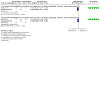
Comparison 2: Fixed versus fixed retainers, Outcome 16: Patient satisfaction: speech
Additional appointments needed
One study (Jowett 2022), that compared CAD/CAM nitinol fixed retainer and a rectangular chain bonded retainer, assessed the need for additional appointments through the following question: “Did your retainer cause a problem that meant you needed to see your orthodontist?”. No significant differences were found between the groups in the upper jaw (RR 2.67, 95% CI 0.78 to 9.12; P = 0.12; 62 participants; Analysis 2.17.1) and in the lower jaw (RR 1.00, 95% CI 0.27 to 3.65; P = 1.00; 62 participants; Analysis 2.17.2).
2.17. Analysis.
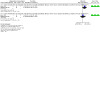
Comparison 2: Fixed versus fixed retainers, Outcome 17: Patient satisfaction: appointment needed
Aesthetics
One study (Scribante 2011), which compared fibre‐reinforced composite versus multistrand fixed retainer, assessed aesthetics (e.g. “visibility of retainer while talking and smiling”) using a visual analogue scale where 0 was a poor aesthetic result and 10 was an excellent result. It found a significant difference in favour of the fibre‐reinforced composite retainer (MD 1.49, 95% CI 0.76 to 2.22; P < 0.001; 32 participants; Analysis 2.18.1).
2.18. Analysis.

Comparison 2: Fixed versus fixed retainers, Outcome 18: Patient satisfaction: aesthetics
Preference for type of retainer
One study (Ferreira 2019), reported that all participants preferred the rigid retainer bonded only on the canines compared to the rectangular chain bonded to multiple teeth in the lower jaw (RD 1.00, 95% CI 0.88 to 1.12; P < 0.001; 30 participants; Analysis 2.19.1).
2.19. Analysis.
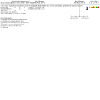
Comparison 2: Fixed versus fixed retainers, Outcome 19: Patient satisfaction: preference for type of retainer
Adverse effects on health
Eight studies reported different outcomes related to oral health, when comparing different types of fixed retainers (Adanur‐Atmaca 2021; Alrawas 2020; Ferreira 2019; Gelin 2020; Kartal 2021; Sinha 2021; Torkan 2014; Węgrodzka 2021). All studies reported data only for the lower arch except Torkan 2014, which included both upper and lower arches. Studies reported the following outcomes.
Plaque Index (Adanur‐Atmaca 2021; Alrawas 2020; Ferreira 2019; Gelin 2020; Kartal 2021; Sinha 2021; Torkan 2014; Węgrodzka 2021; Analysis 2.20);
Gingival Index (Adanur‐Atmaca 2021; Alrawas 2020; Ferreira 2019; Gelin 2020; Kartal 2021; Sinha 2021; Torkan 2014; Węgrodzka 2021; Analysis 2.21);
Calculus Index (Adanur‐Atmaca 2021; Ferreira 2019; Gelin 2020; Torkan 2014; Analysis 1.22);
Probing depth (Alrawas 2020; Kartal 2021; Węgrodzka 2021; Analysis 2.23);
Bleeding on probing (Alrawas 2020; Kartal 2021; Torkan 2014; Węgrodzka 2021; Analysis 2.24);
Marginal recession (Gelin 2020; Kartal 2021; Analysis 2.25).
2.20. Analysis.
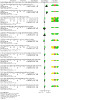
Comparison 2: Fixed versus fixed retainers, Outcome 20: Oral health: Plaque Index
2.21. Analysis.
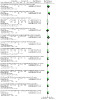
Comparison 2: Fixed versus fixed retainers, Outcome 21: Oral health: Gingival Index
2.23. Analysis.
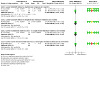
Comparison 2: Fixed versus fixed retainers, Outcome 23: Oral health: probing depth
2.24. Analysis.
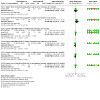
Comparison 2: Fixed versus fixed retainers, Outcome 24: Oral health: bleeding on probing
2.25. Analysis.
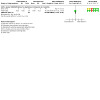
Comparison 2: Fixed versus fixed retainers, Outcome 25: Oral health: marginal recession
Plaque Index
Only one study (Torkan 2014), found higher Plaque Index scores at six months in the fibre‐reinforced composite group compared to the spiral wire retainer group both in the upper (MD 1.00, 95% CI 0.54 to 1.46; P < 0.001; 40 participants; Analysis 2.20.1) and lower arches (MD 1.09, 95% CI 0.70 to 1.48; P < 0.001; 40 participants; Analysis 2.20.2).
We pooled results from four studies (Adanur‐Atmaca 2021; Alrawas 2020; Gelin 2020; Kartal 2021), that compared CAD/CAM nitinol versus multistrand stainless steel retainers at six months. Results showed similar Plaque Index in both groups (MD −0.09, 95% CI −0.18 to 0.01; P = 0.08; I2 = 0%; 198 participants; Analysis 2.20.3).
Similar non‐significant differences were found between CAD/CAM nitinol, single‐strand titanium and multistrand stainless steel retainers at six months (Alrawas 2020 – Analysis 2.20.4; Analysis 2.20.5).
However, Sinha 2021 found lower Plaque Index score in the ceramic interlocking bonded group compared to the coaxial wire retainer (MD −0.40, 95% CI −0.56 to −0.24; P < 0.001; 40 participants; Analysis 2.20.6).
The combined results from two studies (Adanur‐Atmaca 2021; Gelin 2020), that compared CAD/CAM nitinol versus multistrand stainless steel retainers showed no differences at 12 months (MD −0.01, 95% CI −0.11 to 0.10; P = 0.91, I2= 0%; 107 participants; Analysis 2.20.7).
No differences were found for other types of lower fixed retainers neither (other arms of Adanur‐Atmaca 2021; Węgrodzka 2021 – Analysis 2.20.8 to Analysis 2.20.13).
GIngival Index
Gingival Index scores were reported by the same group of studies as the Plaque Index scores.
Torkan 2014 did not find a significant difference in the upper arch comparison (Analysis 2.21.1), but significantly higher scores were found in the fibre‐reinforced composite group in the lower arch arches (MD 0.59, 95% CI 0.13 to 1.05; P = 0.47; 40 participants; Analysis 2.21.2).
The pooled results for four studies (Adanur‐Atmaca 2021; Alrawas 2020; Gelin 2020; Kartal 2021), showed lower Gingival Index scores in the CAD/CAM nitinol group compared to the multistrand retainer at six months (MD −0.14, 95% CI −0.27 to −0.01; P = 0.04; I2 = 0%; 198 participants; Analysis 2.21.3). However, at 12 months, pooled comparison of two studies (Adanur‐Atmaca 2021; Gelin 2020), showed no significant differences (MD 0, 95% CI −0.16 to 0.16; P = 0.97; I2= 80%; 107 participants; Analysis 2.21.7).
No significant differences were found for the other comparisons at six months (Alrawas 2020 – Analysis 2.21.4; Analysis 2.21.5; Sinha 2021 – Analysis 2.21.6), at 12 months (other arms of Adanur‐Atmaca 2021 – Analysis 2.21.8 to Analysis 2.21.12) and 24 months (Węgrodzka 2021 – Analysis 2.21.13).
Calculus Index
Three studies reported the Calculus Index score in a similar way (Adanur‐Atmaca 2021; Gelin 2020; Torkan 2014). No significant differences were found for all the comparisons that reported this outcome in the upper and lower arches.
Fibre‐reinforced composite group versus spiral wire retainer (Torkan 2014 – Analysis 2.22.1; Analysis 2.22.2)
CAD/CAM nitinol versus multistrand stainless steel retainers (Adanur‐Atmaca 2021; Gelin 2020: MD −0.04, 95% CI −0.11 to 0.03; P = 0.25; I2 = 61%; 107 participants; Analysis 2.22.3)
Other arms of Adanur‐Atmaca 2021 (Analysis 2.22.4 to Analysis 2.22.8).
2.22. Analysis.
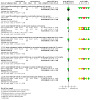
Comparison 2: Fixed versus fixed retainers, Outcome 22: Oral health: Calculus Index
Probing depth
Three studies (Alrawas 2020; Kartal 2021; Węgrodzka 2021), reported probing depth. No differences were found for the comparisons between CAD/CAM nitinol, single‐strand titanium and multistrand stainless steel retainers in the lower arch (Analysis 2.23.1 to Analysis 2.23.3) at six months, and between round twisted multistrand and rectangular braided multistrand at 24 months (Analysis 2.23.4).
Bleeding on probing
Four studies reported comparisons for this outcome (Alrawas 2020; Kartal 2021; Torkan 2014; Węgrodzka 2021). No differences were found between the different types of retainers analysed: fibre‐reinforced composite group versus spiral wire retainer (Torkan 2014 – Analysis 2.24.1; Analysis 2.24.2); CAD/CAM nitinol, single‐strand titanium and multistrand stainless steel retainers (Alrawas 2020; Kartal 2021 – Analysis 2.24.3 to Analysis 2.24.5), and round twisted multistrand and rectangular braided multistrand (Węgrodzka 2021 – Analysis 2.24.6).
Marginal recession
We were able to combine results from two studies (Gelin 2020; Kartal 2021). The comparison between lower CAD/CAM nitinol versus multistrand stainless steel retainers at six months was not significantly different (MD −0.05, 95% CI −0.11 to 0.01; P = 0.11; 103 participants; Analysis 2.25.1).
We did not enter results from Ferreira 2019 into RevMan Web 2022 because they gave results as frequency and percentage of each index score (0, 1, 2, 3; Plaque, Gingival and Calculus) for each tooth surface. The main findings indicated that the scores for Plaque and Gingival indices were significantly higher for the rectangular chain retainer compared to the rigid retainer bonded only to 33 and 43 (P < 0.05) on the lingual and proximal surfaces. The same occurred with the Calculus Index on the lingual surfaces (P < 0.05). The Calculus Index along wire was higher for the rectangular chain wire too (P < 0.05).
Comparison 3: removable retainers versus removable retainers
Sixteen studies compared different types of removable retainers. In 13 studies, the comparisons were in the upper and lower arches (Al‐Moghrabi 2020; Eroglu 2019; Gill 2007; Kaya 2019; Kumar 2011; Ramazanzadeh 2018; Rowland 2007; Saleh 2017; Shawesh 2010; Sun 2011; Thickett 2010; Wan 2017; Zhu 2017), and in three studies, the comparisons were only in the upper arch (Ashari 2021; Moslemzadeh 2018; Rohaya 2006). Studies included three types of removable retainers in these comparisons: Hawley retainer (11 studies), clear plastic retainers (15 studies) and Begg retainer (1 study).
Ten studies compared Hawley retainers with clear plastic retainers, but they were worn for different lengths of time per day (Ashari 2021; Eroglu 2019; Kaya 2019; Moslemzadeh 2018; Ramazanzadeh 2018; Rohaya 2006; Rowland 2007; Saleh 2017; Sun 2011; Wan 2017).
Upper Hawley retainers and upper modified clear plastic retainers (0.040 inch, 1 mm) with palatal coverage for maintaining transverse expansion worn full‐time for the first six months, followed by niight‐time wear for the next six months (Ashari 2021)
Upper and lower Hawley and clear plastic retainers (thickness not mentioned) worn full‐time for 13 weeks (Eroglu 2019)
Upper and lower Hawley and clear plastic retainers (0.040 inch, 1 mm), worn full‐time for the first six months, followed by niight‐time wear for the next six months (Kaya 2019)
Upper Hawley and two types of upper clear plastic retainers of different thickness (1 mm and 1.5 mm, respectively) worn full‐time for the six months (Moslemzadeh 2018)
Upper and lower Hawley and clear plastic retainers (1 mm), worn full‐time for the first four months, followed by niight‐time wear for the next four months (Ramazanzadeh 2018)
Upper Hawley retainers full‐time for three months then six months nights only versus upper clear plastic (1 mm) retainers worn full‐time for one week then part‐time (3 months evenings and nights and 6 months nights only, total 9 months; Rohaya 2006)
Upper and lower Hawley retainers worn full‐time for three months then nights only (12 hours per day) versus upper and lower clear plastic retainers (1.5 mm) worn full‐time for one week then part‐time (12 hours per day; Rowland 2007)
Upper and lower Hawley and clear plastic retainers (1 mm), worn full‐time for the first six months, followed by niight‐time wear for the next six months (Saleh 2017)
Upper and lower Hawley retainers versus upper and lower clear plastic (0.75 mm) retainers worn full‐time for 12 months (Sun 2011)
Upper and lower Hawley retainers versus upper and lower clear plastic (0.8 mm) retainers worn full‐time for three months (Wan 2017)
One study compared part‐time wear of upper and lower Hawley retainers (nights only) with full‐time wear of Hawley retainers (Shawesh 2010)
One study compared upper and lower clear plastic (thickness not mentioned) retainers with Begg retainers (Kumar 2011). The participants were instructed to wear their retainers full‐time for six months then part‐time for six months (12 hours per day).
Two studies compared part‐time wear of upper and lower clear plastic retainers with full‐time wear of clear retainers (thickness not mentioned) (Gill 2007; Thickett 2010). Gill 2007 defined part‐time as eight hours per day, and Thickett 2010 defined part‐time as 10 hours per day.
One study compared upper and lower clear plastic retainers of different thicknesses (0.75 mm versus 1.00 mm) worn full‐time for 12 months (Zhu 2017).
One study compared upper and lower clear plastic retainers (1.00 mm) worn full‐time with and without access to “My retainers” mobile application reporting different outcomes at three and 12 months (Al‐Moghrabi 2020).
Stability
Studies assessed stability in a variety of ways.
Little's Irregularity Index for each arch (Al‐Moghrabi 2020; Gill 2007; Kaya 2019; Ramazanzadeh 2018; Rowland 2007; Shawesh 2010; Thickett 2010), for both arches (Kumar 2011)
Changes in intercanine width (Ashari 2021; Gill 2007; Kaya 2019; Ramazanzadeh 2018; Rowland 2007)
Changes in interpremolar width (Ashari 2021)
Changes in intermolar width (Ashari 2021; Gill 2007; Kaya 2019; Ramazanzadeh 2018; Rowland 2007)
Changes in arch length (Kaya 2019; Ramazanzadeh 2018)
Stability of corrected rotations (Rohaya 2006)
Outcome of treatment measured by PAR index (Kumar 2011)
Outcome of treatment measured by ABO grading (Moslemzadeh 2018)
Although 13 studies that compared removable retainers with other removable retainers evaluated stability, only two studies compared similar interventions and similar outcomes (Gill 2007; Thickett 2010). However, it was not possible to pool the results in a meta‐analysis as the data in the Thickett 2010 study were presented as medians, without interquartile ranges, and the study author did not respond to our request for these data.
Little's Irregularity index
Eight studies reported this index when comparing removable retainers (Analysis 3.1).
3.1. Analysis.
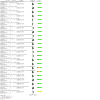
Comparison 3: Removable versus removable retainers, Outcome 1: Stability: Irregularity Index
Hawley retainers versus clear plastic retainer
-
Ramazanzadeh 2018 compared Hawley retainers worn full‐time versus clear retainers worn full‐time and part‐time (3‐arm study).
Upper arch: at four months, they found no differences between Hawley and clear retainers (Analysis 3.1.1; Analysis 3.1.3).
Lower arch: the clear plastic group showed significantly less crowding than Hawley group when the retainer was worn full‐time (MD 0.10 mm, 95% CI 0.02 to 0.18; P = 0.02; 55 participants; Analysis 3.1.2), but not when it was worn part‐time (Analysis 3.1.4). After four months, retainers were worn part‐time and stability outcomes were assessed again after eight months. The upper Irregularity Index change was significantly lower in the two clear plastic groups compared to the Hawley group: four months full‐time clear plastic (MD 0.38 mm, 95% CI 0.22 to 0.54; P value < 0.0001; 55 participants; Analysis 3.1.7), and four months part‐time clear plastic (MD 0.45 mm, 95% CI 0.29 to 0.61; P < 0.001; 55 participants; Analysis 3.1.9). Similar significant differences were found in the lower arch at eight months: after four months full‐time wear of a clear plastic retainer (MD 0.17 mm, 95% CI 0.03 to 0.31; P = 0.02; 55 participants; Analysis 3.1.8), and four months part‐time wear of a clear plastic retainer (MD 0.21 mm, 95% CI 0.07 to 0.35; P = 0.003; 55 participants; Analysis 3.1.10).
-
Rowland 2007 compared Hawley retainers worn full‐time for three months and part‐time for the next three months with clear plastic retainers worn part‐time at six months.
Upper arch: they found a difference in the Irregularity Index in the upper arch, with 0.25 mm (95% CI 0.08 to 0.42; P = 0.004) more relapse in the Hawley retainer group (Analysis 3.1.13),
Lower arch: the difference in the Irregularity Index in the lower arch was 0.42 mm (95% CI 0.23 to 0.61; P < 0.001; Analysis 3.1.14).
Kaya 2019 compared Hawley retainers versus clear plastic retainers, both of them worn full‐time for six months and part‐time for the next six months and found no significant differences in the upper (LII MD ‐0.47 mm, 95% CI −1.06 to 0.12; P=0.12; 30 participants; Analysis 3.1.17) and the lower arches (LII MD 0.01 mm, 95% CI −0.65 to 0.67; P = 0.98; 30 participants; Analysis 3.1.18) at 12 months.
Begg retainers versus clear plastic retainers
Kumar 2011 compared upper and lower Begg retainers with upper and lower clear plastic retainers (both groups had a fixed retainer in addition in the lower arch) at six months. There was a significant difference of 0.25 mm (95% CI 0.19 to 0.31; P < 0.001; Analysis 3.1.23) with more irregularity in the group wearing the Begg retainers.
Full‐time versus part‐time wear of clear plastic retainers
Three studies (Gill 2007; Ramazanzadeh 2018 (two arms); Thickett 2010) compared full‐time wear of clear plastic retainers versus part‐time wear of clear plastic retainers.
Gill 2007 showed no statistical difference in terms of irregularity Index, in both upper and lower arches at six months (Analysis 3.1.15; Analysis 3.1.16).
Ramazanzadeh 2018 showed the same non‐significant differences in the upper (Analysis 3.1.5) and lower arches (Analysis 3.1.6) at four months and at eight months after both groups wore the clear retainers part‐time for the second four‐month period (Analysis 3.1.11; Analysis 3.1.12).
Table 8 presents the results from Thickett 2010. They found no statistical difference in the irregularity index at 12 months.
2. Thickett 2010: stability results (medians only) for full‐time clear plastic vs part‐time at 1 year.
| Outcome | Full‐time at debond | Part‐time at debond | P value at debond | Full‐time after 1 year | Part‐time after 1 year | P value after 1 year |
| Lower LII | 0.04 | 0.14 | 0.46 | 0.71 | 0.89 | 0.5 |
| Upper LII | 0.21 | 0.14 | 0.14 | 1.08 | 1.09 | 0.8 |
| Lower intercanine width | 27.24 | 27.07 | 0.22 | 27.07 | 26.47 | 0.65 |
| Lower intermolar width | 34.09 | 33.32 | 0.52 | 34.35 | 33.6 | 0.61 |
| Lower arch length | 21.1 | 21.02 | 0.44 | 21.28 | 20.14 | 0.06 |
| Upper intercanine width | 35.49 | 34.79 | 0.08 | 34.93 | 34.56 | 0.52 |
| Upper intermolar width | 40.23 | 39.57 | 0.35 | 40.34 | 39.39 | 0.68 |
| Upper arch length | 24.98 | 24.19 | 0.22 | 25.07 | 25.15 | 0.97 |
| Overjet | 2.54 | 2.36 | 0.6 | 2.76 | 2.39 | 0.37 |
| Overbite | 2.86 | 3.31 | 0.14 | 3.14 | 3.74 | 0.05 (P < 0.05) |
| LII: Little's Irregularity Index in mm; P: probability; vs: versus | ||||||
While we were unable to combine the results in a meta‐analysis, the finding of the three studies was that there was no evidence of a difference in stability when clear plastic retainers were worn full‐time or part‐time.
Al‐Moghrabi 2020 did not find significant differences at 12 months in the Irregularity Index of the upper (Analysis 3.1.19) and lower arches (Analysis 3.1.20) when clear plastic retainers were worn full‐time with or without access to “My retainers” mobile application.
Full‐time versus part‐time wear of Hawley retainers
Shawesh 2010 compared full‐time wear of Hawley retainers (6 months worn full‐time and 6 months worn part‐time) with part‐time wear of Hawley retainers at 12 months. They showed no statistical difference in Irregularity Index in both arches between the two wear regimens (upper: MD 0.00 mm, 95% CI −0.41 to 0.41; P = 1.00; 1 study, 52 participants; Analysis 3.1.21) (lower: MD 0.20 mm, 95% CI −0.28 to 0.68; P = 0.41; 1 study, 52 participants; Analysis 3.1.22).
Intercanine, interpremolar and intermolar width changes
Six studies reported intercanine width changes (Analysis 3.2), one study reported interpremolar width changes (Analysis 3.3), and six reported intermolar width changes (Analysis 3.4), when comparing removable retainers.
3.2. Analysis.
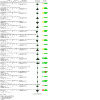
Comparison 3: Removable versus removable retainers, Outcome 2: Stability: intercanine width
3.3. Analysis.
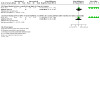
Comparison 3: Removable versus removable retainers, Outcome 3: Stability: interpremolar width
3.4. Analysis.
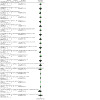
Comparison 3: Removable versus removable retainers, Outcome 4: Stability: intermolar width
Hawley retainers versus clear plastic retainers
Ramazanzadeh 2018 found no significant differences in intercanine and intermolar widths between groups when comparing Hawley retainers worn full‐time versus clear retainers worn full‐time and part‐time (3‐arm study) at four months (Analysis 3.2.1 to Analysis 3.2.4; Analysis 3.4.1 to Analysis 3.4.4); and after eight months, when retainers were used part‐time after the initial four‐month period (Analysis 3.2.7 to Analysis 3.2.10; Analysis 3.4.7 to Analysis 3.4.10).
Ashari 2021 compared upper Hawley retainers and upper modified clear plastic retainers with palatal coverage. They found no differences in intercanine (Analysis 3.2.13), interpremolar (Analysis 3.3.1) and intermolar (Analysis 3.4.13; Analysis 3.4.14) width changes when worn full‐time for the first six months, nor when this period was followed by night‐time wear for the next six months (Analysis 3.2.14; Analysis 3.3.2; Analysis 3.4.15; Analysis 3.4.16).
Rowland 2007 compared full‐time Hawley retainers with part‐time clear plastic retainers and found no difference in intercanine (Analysis 3.2.15; Analysis 3.2.16) and intermolar widths (Analysis 3.4.17; Analysis 3.4.18) in both arches at six months.
Kaya 2019 compared Hawley retainers versus clear plastic retainers, both of them worn full‐time for six months and part‐time for the next six months, and found no significant differences in the upper intercanine (Analysis 3.2.19) and intermolar width (Analysis 3.4.21) changes, and in the lower arches (Analysis 3.2.20; Analysis 3.4.22) at 12 months.
Full‐time versus part‐time wear of clear plastic retainers
Three studies (Gill 2007; Ramazanzadeh 2018 (2 arms); Thickett 2010) compared intercanine (Analysis 3.2.17; Analysis 3.2.18; Analysis 3.2.5; Analysis 3.2.6; Analysis 3.2.11; Analysis 3.2.12; Table 8) and intermolar width changes (Analysis 3.4.19; Analysis 3.4.20; Analysis 3.4.5; Analysis 3.4.6; Analysis 3.4.11; Analysis 3.4.12; Table 8) and found no differences between groups in the upper and lower arches.
Arch length changes
Three studies (Kaya 2019; Ramazanzadeh 2018; Thickett 2010), reported arch length changes (Analysis 3.5, Table 8). All three studies found no differences between groups in the upper and lower arches when comparing Hawley and clear plastic retainers (Ramazanzadeh 2018; Thickett 2010; Analysis 3.5.1 to Analysis 3.5.12; Table 8) or clear plastic retainers worn full‐time versus part‐time (Kaya 2019; Analysis 3.5.13; Analysis 3.5.14).
3.5. Analysis.
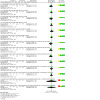
Comparison 3: Removable versus removable retainers, Outcome 5: Stability: arch length
Overjet and overbite
Three studies (Kaya 2019; Gill 2007; Thickett 2010), reported overjet and overbite changes (Analysis 3.6; Analysis 3.7, Table 8). No differences were found between groups when comparing Hawley and clear plastic retainers (Gill 2007; Thickett 2010; Analysis 3.6.1; Analysis 3.7.1; Table 8) or clear plastic retainers worn full‐time versus part‐time (Kaya 2019; Analysis 3.6.2, Analysis 3.7.2).
3.6. Analysis.
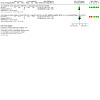
Comparison 3: Removable versus removable retainers, Outcome 6: Stability: overjet
3.7. Analysis.
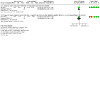
Comparison 3: Removable versus removable retainers, Outcome 7: Stability: overbite
Rotations
Rohaya 2006 investigated the ability to maintain previously rotated teeth in a stable position, comparing Hawley retainers and clear plastic retainers in the upper arch. They found that clear plastic retainers were 4.88 times more likely to hold derotated teeth stable than Hawley retainers (95% CI 1.13 to 21.07; P = 0.03; Analysis 3.8). This is likely to be clinically significant.
3.8. Analysis.
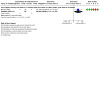
Comparison 3: Removable versus removable retainers, Outcome 8: Stability: maintaining corrected rotations in the upper
Maintaining outcome of treatment
Kumar 2011 evaluated this outcome using the PAR index. There was a reduction in the quality of the result of 1.71 points (95% CI 1.44 to 1.98; P < 0.001; Analysis 3.9) on the PAR index in the Begg retainer group, indicating more relapse in this group than in the clear plastic retainer group.
Moslemzadeh 2018 evaluated this outcome using the ABO grading (Analysis 3.10). They found no differences between the upper Hawley retainer group and the groups wearing upper clear plastic retainers of different thicknesses (Analysis 3.10.1 to Analysis 3.10.3).
3.9. Analysis.
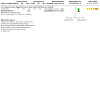
Comparison 3: Removable versus removable retainers, Outcome 9: Stability: maintaining quality of finish (PAR)
3.10. Analysis.

Comparison 3: Removable versus removable retainers, Outcome 10: Stability: maintaining quality of finish (ABO Grading)
Failure of retainers
Three studies reported failure of retainers for the upper and lower arches together (Rowland 2007; Zhu 2017), or measured per arch (Sun 2011). Studies measured failures in different ways.
-
Rate of failure in %:
total number of failures (Sun 2011; Zhu 2017; Analysis 3.11);
-
number of different type of failure: (Analysis 3.12 to Analysis 3.15);
fracture, loss, non‐fitting, and abrasion (Sun 2011; Zhu 2017);
broken, lost, non‐fitting retainers (Rowland 2007);
Mean survival time in days (Zhu 2017; Analysis 3.16);
Risk of failure (hazard ratio) (Sun 2011; Zhu 2017; Analysis 3.17).
3.11. Analysis.

Comparison 3: Removable versus removable retainers, Outcome 11: Failures of retainers: total number of failures
3.12. Analysis.

Comparison 3: Removable versus removable retainers, Outcome 12: Failure of retainers: broken retainers
3.15. Analysis.
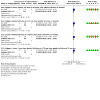
Comparison 3: Removable versus removable retainers, Outcome 15: Failure of retainers: serious abrasion
3.16. Analysis.
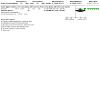
Comparison 3: Removable versus removable retainers, Outcome 16: Mean survival time (days)
3.17. Analysis.
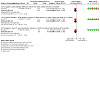
Comparison 3: Removable versus removable retainers, Outcome 17: Failure risk (Hazard Ratio)
Hawley retainers versus clear plastic retainers
Sun 2011 compared the failure rate of Hawley retainers and clear plastic (0.75 mm) retainers worn full‐time for 12 months. They assessed the failure rate separately for upper and lower retainers. For comparisons with other studies, we combined upper and lower data. Sun 2011 showed no difference in total failure rates in the upper arch (Analysis 3.11.1). However, in the lower arch there was an increased chance of clear plastic retainers failing compared with Hawley retainers (RR 0.60, 95% CI 0.43 to 0.83; P = 0.002; 111 participants; Analysis 3.11.2), which is clinically significant. When we combined upper and lower total failures, we also found a significant result (RR 0.72, 95% CI 0.57 to 0.90; P = 0.005; 222 participants; Analysis 3.11.3).
-
Reasons for failure
Broken retainers: rates were similar in the upper and lower arches together (Analysis 3.12.2), and in the upper arch only (Analysis 3.12.3). In the lower arch, fractures were‐higher in the 0.75 mm thickness clear plastic group than in the Hawley group (RR 0.51, 95% CI 0.30 to 0.85; P = 0.01; 111 participants; Analysis 3.12.4).
Lost retainers: rates were similar between groups in the upper arch (Analysis 3.13.3) and for the lower arch (Analysis 3.13.4). However, when upper and lower failures were added together, significantly larger number of clear plastic retainers were lost compared to Hawley retainers (RR 0.55, 95% CI 0.31 to 0.97; P = 0.04; 222 participants; Analysis 3.13.2).
Retainers not fitting (Analysis 3.14.2 to Analysis 3.14.4), and retainers with serious abrasions (Analysis 3.15.1 to Analysis 3.15.3): there were no significant differences between the two types of retainers.
The risk of failure according to the hazard ratio was not significantly different for the Hawley retainer group compared to the clear plastic retainer group Analysis 3.17.1), and for maxillary retainers (Hawley and clear plastic) compared to the mandibular retainers (Analysis 3.17.2).
Rowland 2007 also compared failure rates of upper and lower Hawley retainers worn full‐time for three months then nights only versus upper and lower clear plastic retainers (1.5 mm) worn part‐time at six months. They assessed failure rates by recording how many retainers broke, how many were lost, and how many did not fit. Hawley retainers were more likely to break, giving a RR of 3.21 (95% CI 1.55 to 6,64; P = 0.002; Analysis 3.12.1), which is clinically significant. There was no difference in the number of retainers that were lost (Analysis 3.13.1) or did not fit (Analysis 3.14.1).
3.13. Analysis.
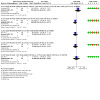
Comparison 3: Removable versus removable retainers, Outcome 13: Failure of retainers: lost retainers
3.14. Analysis.
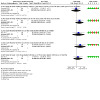
Comparison 3: Removable versus removable retainers, Outcome 14: Failure of retainers: nonfitting retainers
Different thickness of clear plastic retainers
Zhu 2017 compared the failure rate of 1 mm‐thick clear plastic and 0.75 mm‐thick clear plastic (0.75 mm) retainers worn full‐time for 12 months.
Total failure rates: Zhu 2017 showed no difference in the total failure rates between the 1 mm‐ and 0.75 mm‐thick retainers for the upper and lower arches together (Analysis 3.11.4).
-
Reasons for failure
Rate of broken retainers: this was significantly lower in the 1 mm‐thick retainer group (RR 0.23, 95% CI 0.05 to 1.01; P = 0.05; 72 participants; Analysis 3.12.5).
Number of lost retainers (Analysis 3.13.5): there were no significant differences between the two thickness of retainers.
Retainers not fitting (Analysis 3.14.5): there were no significant differences between the two thickness of retainers.
Retainers with serious abrasions (Analysis 3.15.4):there were no significant differences between the two thickness of retainers.
Mean survival time in days (Analysis 3.16.1) was not significantly different between thicknesses.
Risk of failure according to the hazard ratio (Analysis 3.17.3) was not significantly different between thicknesses.
Patient satisfaction
Three studies investigated patient satisfaction when comparing Hawley retainer versus clear plastic retainer (Rowland 2007; Saleh 2017; Wan 2017) using the following core categories.
Acceptance
Two studies reported significant results for acceptance of the retainer. Participants found it more acceptable to wear clear plastic retainers than Hawley retainers in all the analyses.
-
Saleh 2017 reported this core category through the following two issues:
“appearance” (MD −2.77, 95% CI −3.24 to −2.30; P < 0.001; 86 participants; Analysis 3.18.1) and
“self‐confidence” (MD −2.18, 95% CI −2.56 to −1.80; P < 0.001; 86 participants; Analysis 3.18.2).
-
Rowland 2007 reported this core category through the following questions:
“embarrassed to wear your retainer?” (R 2.42, 95% CI 1.30 to 4.49; P = 0.005; 348 participants; Analysis 3.19.1) and
“worse or much worse than wearing fixed appliance?” (RR 9.37, 95% CI 3.80 to 23.10; P < 0.001; 349 participants; Analysis 3.19.2).
3.18. Analysis.
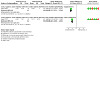
Comparison 3: Removable versus removable retainers, Outcome 18: Patient satisfaction: acceptance
3.19. Analysis.
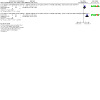
Comparison 3: Removable versus removable retainers, Outcome 19: Patient satisfaction: acceptance (dichotomous)
Although both studies reported six‐month outcomes, we could not pool these results statistically because the wearing protocol was different in both studies, and one study reported continuous data (Saleh 2017), while the other reported dichotomous data (Rowland 2007).
Compliance
One study (Rowland 2007) reported that the clear plastic retainer group were more likely to report being able to wear the retainer than the Hawley group, with an RR of 3.03 (95% CI 1.46 to 6.30; P = 0.003; 347 participants; Analysis 3.20.1).
There was no difference in the ability to wear the retainers away from home (Analysis 3.20.2).
3.20. Analysis.
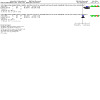
Comparison 3: Removable versus removable retainers, Outcome 20: Patient satisfaction: compliance (dichotomous)
Cleaning and hygiene
-
One study (Saleh 2017), assessed cleaning and hygiene through the following two issues:
“hygiene”, with no differences (MD −0.42, 95% CI −0.89 to 0.05; P = 0.08; 86 participants; Analysis 3.21.1) and
“gingival irritation”, with the clear plastic retainer less irritating to the gingiva than the Hawley retainer (MD −1.28, 95% CI −1.73 to −0.83; P < 0.001; 86 participants; Analysis 3.21.2).
3.21. Analysis.
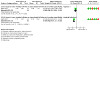
Comparison 3: Removable versus removable retainers, Outcome 21: Patient satisfaction: cleaning/hygiene
Comfort
Two studies (Rowland 2007; Saleh 2017), assessed comfort.
-
Saleh 2017 reported this core category through the following four issues:
“comfort” with differences favouring clear plastic retainer (MD −1.86, 95% CI −2.19 to −1.53; P < 0.001; 86 participants; Analysis 3.22.1);
“biting with retainers” with differences favouring Hawley retainer (MD 0.91, 95% CI 0.44 to 1.38; P < 0.001; 86 participants; Analysis 3.22.2);
“fitting” with no differences between the two types of retainers (Analysis 3.22.3) and
“swallowing” with differences favouring clear plastic retainer (n = 86; MD −1.28, 95% CI −1.68 to −0.88; P < 0.001; Analysis 3.22.4).
Rowland 2007 reported no difference between the two retainers in the amount of discomfort experienced (RR 1.43, 95% CI 0.77 to 2.65; P = 0.25; 349 participants; Analysis 3.23.1).
3.22. Analysis.

Comparison 3: Removable versus removable retainers, Outcome 22: Patient satisfaction: comfort
3.23. Analysis.

Comparison 3: Removable versus removable retainers, Outcome 23: Patient satisfaction: discomfort/pain (dichotomous)
Although both studies reported six‐month comfort‐related outcomes, we could not pool these results statistically because one study reported continuous data (Saleh 2017), and the other dichotomous data (Rowland 2007). Furthermore, the wearing protocol (full‐time or part‐time) differed between studies.
Speech
Two studies (Saleh 2017; Wan 2017), assessed speech.
Saleh 2017 reported that participants with the clear plastic retainer felt that they were less likely to cause a speech problem compared to the Hawley retainer (MD −1.25, 95% CI −1.69 to −0.81; P < 0.001; 86 participants; Analysis 3.24.1).
Wan 2017 reported no difference in the number of sound distortions (RR 3.00, 95% CI 0.12 to 72.68; P = 0.50; 180 participants; Analysis 3.25).
3.24. Analysis.
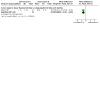
Comparison 3: Removable versus removable retainers, Outcome 24: Patient satisfaction: speech
3.25. Analysis.
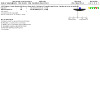
Comparison 3: Removable versus removable retainers, Outcome 25: Patient satisfaction: speech (dichotomous)
Durability
One study (Saleh 2017), assessed durability, with differences favouring the Hawley retainer (MD 1.83, 95% CI 1.07 to 2.59; P < 0.001; 86 participants; Analysis 3.26.1).
3.26. Analysis.
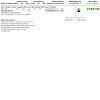
Comparison 3: Removable versus removable retainers, Outcome 26: Patient satisfaction: durability
Adverse effects on health
Three studies reported different outcomes related to oral health (Al‐Moghrabi 2020; Eroglu 2019; Moslemzadeh 2018), when comparing different types of removable retainers. Studies reported the following outcomes.
Plaque Index (Al‐Moghrabi 2020; Eroglu 2019; Analysis 3.27)
Gingival Index (Eroglu 2019; Moslemzadeh 2018; Analysis 3.28)
Probing depth (Al‐Moghrabi 2020; Eroglu 2019; Analysis 3.29)
Bleeding on probing (Al‐Moghrabi 2020, Eroglu 2019; Analysis 3.30)
3.27. Analysis.
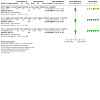
Comparison 3: Removable versus removable retainers, Outcome 27: Oral health: Plaque Index
3.28. Analysis.
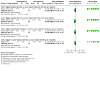
Comparison 3: Removable versus removable retainers, Outcome 28: Oral health: Gingival Index
3.29. Analysis.

Comparison 3: Removable versus removable retainers, Outcome 29: Oral health: probing depth
3.30. Analysis.
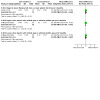
Comparison 3: Removable versus removable retainers, Outcome 30: Oral health: bleeding on probing
Hawley retainers versus clear plastic retainers
Eroglu 2019 found no differences in Plaque Index scores at three months when upper and lower full‐time Hawley retainers and full‐time clear plastic retainers were compared (Analysis 3.27.1). Gingival Index (Analysis 3.28.4), probing pocket depth (Analysis 3.29.1), and bleeding on probing (Analysis 3.30.1) were similar for the upper and lower arches when full‐time Hawley retainers and full‐time clear plastic retainers were compared at 3 months.
Moslemzadeh 2018 compared three types of removable retainers in the upper arch worn full‐time for six months: Hawley retainer, 1.5 mm clear plastic retainer and 1 mm clear plastic retainer in the upper arch. No significant different Gingival Index scores were found between groups (Analysis 3.28.1 to Analysis 3.28.3).
Clear plastic retainers with and without the use of mobile app
Al‐Moghrabi 2020 found no significant differences in Plaque Index scores (Analysis 3.27.2; Analysis 3.27.3), probing pocket depth (Analysis 3.29.2; Analysis 3.29.3), and bleeding on probing (Analysis 3.30.2; Analysis 3.30.3), for the upper and lower arches between both retainer groups at 12 months, whether using the mobile app or not.
Comparison 4: Upper clear plastic (UCP) + lower fixed canine to canine versus UCP + lower interproximal reduction (stripping) versus positioner
Upper removable and lower fixed retainer versus upper removable retainer and lower adjunctive procedure
Edman Tynelius 2010 compared an upper clear plastic retainer worn part‐time and lower rigid stainless steel retainer from lower canine to canine with an upper clear plastic retainer worn part‐time and the adjunctive procedure of interproximal reduction in the lower arch, with no lower retainer. They measured stability at one and two years of retention. Change data were reported for Little's Irregularity Index in both arches, upper and lower intercanine and intermolar width, arch length, overjet and overbite.
-
After one year:
there were differences in the lower intercanine width (MD 1.00 mm, 95% CI 0.78 to 1.22; P < 0.001), which may be clinically significant (Analysis 4.6.1); in the lower arch length (MD 0.70 mm, 95% CI 0.2 to 1.20; P = 0.006; Analysis 4.8.1) and in overbite (MD −0.60, 95% CI −1.17 to ‐0.03; P = 0.04; Analysis 4.10.1), which are unlikely to be clinically significant.
There was no difference in the Little's Irregularity Index in either arch, intercanine width in the upper arch, intermolar width in either arch, arch length in the upper arch, and overjet (Analysis 4.1.1; Analysis 4.2.1; Analysis 4.3.1; Analysis 4.4.1; Analysis 4.5.1; Analysis 4.7.1; Analysis 4.9.1).
-
After two years:
there were differences in the lower intercanine width (MD 1.20 mm, 95% CI 0.74 to 1.66; P value < 0.0001), which may be clinically significant (Analysis 4.6.2); and in overjet (MD −0.8 mm, 95% CI −1.43 to −0.17; P = 0.01; Analysis 4.9.2) and overbite (MD −0.80 mm, 95% CI −1.37 to −0.23; P = 0.006; Analysis 4.10.2), which are unlikely to be clinically significant.
There was no difference in the Little's Irregularity Index in either arch, intercanine width in the upper arch, intermolar width in either arch, arch length in either arch, overjet or overbite (Analysis 4.1.2; Analysis 4.2.2; Analysis 4.3.2; Analysis 4.4.2; Analysis 4.5.2; Analysis 4.7.2; Analysis 4.8.2).
4.6. Analysis.
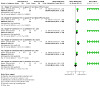
Comparison 4: Upper clear plastic (CP) + lower fixed canine‐canine (CTC) versus upper CP + lower interproximal reduction (IPR) (stripping) vs positioner, Outcome 6: Stability: lower intercanine width
4.8. Analysis.
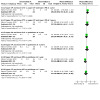
Comparison 4: Upper clear plastic (CP) + lower fixed canine‐canine (CTC) versus upper CP + lower interproximal reduction (IPR) (stripping) vs positioner, Outcome 8: Stability: lower arch length
4.10. Analysis.
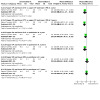
Comparison 4: Upper clear plastic (CP) + lower fixed canine‐canine (CTC) versus upper CP + lower interproximal reduction (IPR) (stripping) vs positioner, Outcome 10: Stability: overbite
4.1. Analysis.
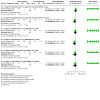
Comparison 4: Upper clear plastic (CP) + lower fixed canine‐canine (CTC) versus upper CP + lower interproximal reduction (IPR) (stripping) vs positioner, Outcome 1: Stability: upper irregularity index
4.2. Analysis.
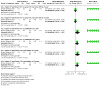
Comparison 4: Upper clear plastic (CP) + lower fixed canine‐canine (CTC) versus upper CP + lower interproximal reduction (IPR) (stripping) vs positioner, Outcome 2: Stability: upper intercanine width
4.3. Analysis.
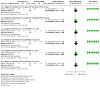
Comparison 4: Upper clear plastic (CP) + lower fixed canine‐canine (CTC) versus upper CP + lower interproximal reduction (IPR) (stripping) vs positioner, Outcome 3: Stability: upper intermolar width
4.4. Analysis.
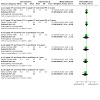
Comparison 4: Upper clear plastic (CP) + lower fixed canine‐canine (CTC) versus upper CP + lower interproximal reduction (IPR) (stripping) vs positioner, Outcome 4: Stability: upper arch length
4.5. Analysis.
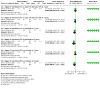
Comparison 4: Upper clear plastic (CP) + lower fixed canine‐canine (CTC) versus upper CP + lower interproximal reduction (IPR) (stripping) vs positioner, Outcome 5: Stability: lower irregularity index
4.7. Analysis.
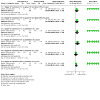
Comparison 4: Upper clear plastic (CP) + lower fixed canine‐canine (CTC) versus upper CP + lower interproximal reduction (IPR) (stripping) vs positioner, Outcome 7: Stability: lower intermolar width
4.9. Analysis.

Comparison 4: Upper clear plastic (CP) + lower fixed canine‐canine (CTC) versus upper CP + lower interproximal reduction (IPR) (stripping) vs positioner, Outcome 9: Stability: overjet
Upper removable and lower fixed retainer versus positioner
Edman Tynelius 2010 compared an upper clear plastic retainer worn part‐time and lower rigid stainless steel retainer from lower canine to canine with a prefabricated positioner covering the teeth in the maxilla and mandible worn part‐time. They measured stability at one and two years of retention. Change data were reported for Little's Irregularity Index in both arches, upper and lower intercanine and intermolar width, arch length, overjet and overbite.
-
After one year:
there were differences in the lower Little's Irregularity Index (MD −0.50 mm, 95% CI −1.01 to 0.01; P = 0.05; Analysis 4.5.3), lower intercanine width (MD 0.70 mm, 95% CI 0.26 to 1.14; P = 0.002; Analysis 4.6.3) and lower intermolar width (MD 0.80 mm, 95% CI 0.06 to 1.54; P = 0.03; Analysis 4.7.3), which are unlikely to be clinically significant.
There was no difference in the upper Little's Irregularity Index, intercanine width in the upper arch, intermolar width in the upper, arch length in either arch, overjet or overbite (Analysis 4.1.3; Analysis 4.2.3; Analysis 4.3.3; Analysis 4.4.3; Analysis 4.8.3; Analysis 4.9.3; Analysis 4.10.3).
-
After two years:
there was a difference in the upper intercanine width (MD 0.80 mm, 95% CI 0.10 to 1.50; P = 0.03; Analysis 4.2.4), but this is unlikely to be clinically significant; lower Little's Irregularity Index (MD −1.00 mm, 95% CI −1.65 to −0.35; P = 0.003; Analysis 4.5.4), which may be clinically significant; lower intercanine width (MD 1.30 mm, 95% CI 0.76 to 1.84; P < 0.001; Analysis 4.6.4), which may be clinically significant; lower intermolar width (MD 1.00 mm, 95% CI 0.07 to 1.93; P = 0.03; (Analysis 4.7.4), which may be clinically significant; and overjet (MD −0.70 mm, 95% CI −1.31 to −0.09; P = 0.02; Analysis 4.9.4), but this is unlikely to be clinically significant.
There was no difference in the Little's Irregularity Index in the upper arch, upper intermolar width, arch length in either arch, and overbite (Analysis 4.1.4; Analysis 4.3.4; Analysis 4.4.4; Analysis 4.8.4 and Analysis 4.10.4).
Upper removable retainer and lower adjunctive procedure versus positioner
Edman Tynelius 2010 compared an upper clear plastic retainer worn part‐time and lower adjunctive procedure of interproximal stripping with a positioner worn part‐time. They measured stability at one and two years of retention. Change data were reported for Little's Irregularity Index in both arches, upper and lower intercanine and intermolar width, arch length, overjet and overbite.
-
After one year:
there was a difference in upper intercanine width (MD 1.00 mm, 95% CI −0.01 to 2.01; P value = 0.05; Analysis 4.2.5), which is clinically significant, and in lower intercanine width (MD 0.70 mm, 95% CI 0.26 to 1.14; P = 0.002; Analysis 4.6.5) and lower arch length (MD −0.50 mm, 95% CI −0.95 to −0.05; P = 0.03; Analysis 4.8.5), but these are unlikely to be clinically significant.
There was no difference in the Little's Irregularity Index in both arches, intermolar widths in both arches, upper arch length, overjet and overbite (Analysis 4.1.5; Analysis 4.3.5; Analysis 4.4.5; Analysis 4.5.5; Analysis 4.7.5; Analysis 4.9.5; and Analysis 4.10.5).
-
After two years:
there was a difference in upper intercanine width (MD 0.90 mm, 95% CI 0.17 to 1.63; P = 0.02; Analysis 4.2.6); and in lower irregularity index (MD −0.70 mm, 95% CI −1.37 to −0.03; P = 0.04; Analysis 4.5.6), which are not clinically significant.
There was no difference in Little's Irregularity Index in the upper arch, intercanine width in the lower arch, intermolar width in both arches, arch length in both arches, overjet and overbite (Analysis 4.1.6; Analysis 4.3.6; Analysis 4.4.6; Analysis 4.6.6; Analysis 4.7.6; Analysis 4.8.6; Analysis 4.9.6; and Analysis 4.10.6).
Same authors reported at five years follow‐up (Edman Tynelius 2010). However, these results are not included in this review because after two years, all retainers were stopped and bonded retainers removed.
Comparison 5: Upper retainer versus no retention after treatment of maxillary impacted canines
Naraghi 2021a compared an upper retainer versus no retention after alignment of maxillary impacted canines. They measured stability in the maxilla at one year, using the following change‐from‐baseline‐outcomes: Little's irregularity index, arch length, intercanine width, intermolar width and maximum rotation.
After one year, the non‐retention group showed significantly higher irregularity index (MD −0.90 mm, 95% CI −1.33 to −0.47; P < 0.001; 63 participants; Analysis 5.1), and decreased arch length (MD 0.30 mm, 95% CI 0.03 to 0.57; P = 0.03; 63 participants; Analysis 5.4) compared to the retention group. These results were not clinically significant. The most rotated teeth were maintained better with retainers (MD −1.70º, 95% CI −3.20 to −0.20; P = 0.03; 63 participants; Analysis 5.5). There was no difference in intercanine width (Analysis 5.2) and intermolar width (Analysis 5.3) between the two groups.
5.1. Analysis.

Comparison 5: Upper retainer versus no retention after treatment of maxillary impacted canines , Outcome 1: Stability: upper irregularity index
5.4. Analysis.
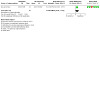
Comparison 5: Upper retainer versus no retention after treatment of maxillary impacted canines , Outcome 4: Stability: upper arch length
5.5. Analysis.
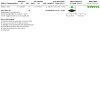
Comparison 5: Upper retainer versus no retention after treatment of maxillary impacted canines , Outcome 5: Stability: upper maximum rotation
5.2. Analysis.
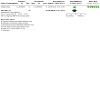
Comparison 5: Upper retainer versus no retention after treatment of maxillary impacted canines , Outcome 2: Stability: upper intercanine width
5.3. Analysis.
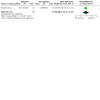
Comparison 5: Upper retainer versus no retention after treatment of maxillary impacted canines , Outcome 3: Stability: upper intermolar width
Discussion
Summary of main results
Please note that the evidence summarised here is only low to very low certainty, and therefore ongoing and future research may very well change these findings.
Comparison 1: Removable retainers versus fixed retainers
Stability
We found limited evidence to suggest that multistrand fixed retainers were slightly better at maintaining straight teeth as measured by Little’s Irregularity Index (LII) than removable clear plastic retainers in the upper arch (1 study, 60 participants, part‐time use (Naraghi 2021b)), and in the lower arch (1 study full‐time use (Millett 2007); 2 studies, part‐time use (Forde 2018; O'Rourke 2016)). These three studies of 182 participants in total showed significant differences favouring multistrand/coaxial fixed retainers when the follow‐up was 12 months or longer (regardless of the regimen of use).
Participants wearing removable retainers showed a slightly greater increase in the intercanine width compared to those with the fixed retainers, especially in the upper arch (1 study, part‐time use (Naraghi 2021b); 2 studies, full‐time use (Alrawas 2020; O'Rourke 2016)), but there was no difference in maintaining intermolar width, overjet and overbite. Arch length was not significantly different between removable and fixed retainers in one study of part‐time use (Forde 2018). Relapse of rotated teeth was higher in the removable compared to the fixed retainer group, when bonded to the incisors and canines (1 study, part‐time use (Naraghi 2021b)).
There was no difference in stability between clear retainers and CAD/CAM nickel‐titanium wires (1 study, Alrawas 2020), or clear plastic retainers and rigid retainers bonded only to the canine teeth (1 study, Krämer 2019).
Failure
There was conflicting evidence about failure rates of removable clear plastic retainers versus multistrand fixed retainers (1 study, full‐time use (Millett 2007); 1 study, part‐time use (Forde 2018)). When the removable retainers were used full‐time, more failures were reported with the removable retainers than the fixed retainers. However, the opposite result was found when the removable retainer was used part‐time. An interesting finding was that there appeared to be a significantly higher risk of patients no longer wearing the removable part‐time retainers compared to the percentage of failures of fixed retainers after four years (O'Rourke 2016).
Satisfaction
There was some evidence to show that patient satisfaction was higher with fixed retainers than clear plastic retainers. Participants reported that the fixed retainers were more acceptable and comfortable to wear, speech was easier, and they found it easier to comply with regimens of use (3 studies, Forde 2018; Krämer 2019; Millett 2007). Both retainers were perceived by study participants as equally efficient (1 study, Krämer 2019). It remains unclear which retainers are easier to keep clean, as two studies report opposite results (part‐time use, Forde 2018; full‐time use, Millett 2007). Participants who used removable retainers part‐time found them easier to clean (1 study, Forde 2018), but those who wore the removable retainer full‐time found it more difficult to clean than participants who had fixed multistrand retainers (1 study, Millett 2007).
Oral health
There was limited evidence to suggest that bonded retainers have the potential to lead to worse oral health. Evidence of caries was not significantly different when comparing fixed retainers and removable clear plastic retainers (1 study, Millett 2007). Plaque Index scores were significantly lower in the part‐time clear plastic retainer group versus multistrand fixed retainer group in the upper arch, but no different in the lower arch (1 study, Forde 2018). Higher Gingival Index and Calculus Index scores were found in the lower arch when fixed multistrand retainers were used compared to part‐time use of clear plastic retainers (Forde 2018). The rest of included studies comparing different types of removable and fixed retainers did not show differences in periodontal measurements. Only one study (Forde 2018, 60 participants), reported significant differences; three studies (130 participants with 3, 6 and 48 months of follow‐up (Alrawas 2020; Eroglu 2019; O'Rourke 2016)) found no differences, which could be explained by the fact that participants performed better oral care due to their participation in a research study (Hawthorne effect; Braunholtz 2001).
In only one study, periodontal pocketing and bleeding on probing, recorded as a dichotomous variable, was significantly higher in the lower fixed retainer group compared to those wearing lower removable clear plastic full‐time (Millett 2007, follow‐up 12 months). However, this periodontal pocketing result should be viewed with caution as the two groups were not equal at debond, with four times as many participants having pocketing in the fixed retainer group. Two RCTs (73 participants) with three and six months of follow‐up, did not find differences between clear plastic retainers and multistrand retainers (Alrawas 2020; Eroglu 2019). On the other hand, bleeding on probing was slightly higher in the lower arch for clear plastic group used full‐time compared to the fixed CAD/CAM nitinol fixed retainer (Alrawas 2020). No significant differences in oral health were found between full‐time Hawley removable retainers and multistrand fixed (bonded) retainer (1 study, Eroglu 2019), except for a clinically insignificant difference in bleeding on probing, favouring the fixed multi‐strand retainer over the Hawley retainer.
Comparison 2: Fixed retainers versus fixed retainers
Stability
Most of the studies that compared fixed retainers found similar Irregularity Index results regardless of the type of retainer used. Less relapse was found when the upper multistrand retainer was bonded to the six anterior teeth rather than only the four incisors (Naraghi 2021b). Indirectly bonded multistrand retainers showed less relapse than the directly bonded coaxial retainers (Gunay 2018). However, more relapse was found in the round multistrand retainer group compared to the fibre‐reinforced composite group when the follow‐up reached 12 months (Nagani 2020). Based on one study, lower CAD/CAM nitinol and round stainless steel multistrand retainers had less relapse than rectangular multistrand and connected bonding pad retainer on incisors and canines at 12 months (Adanur‐Atmaca 2021). Intercanine width changes were similar in most studies except for one that found significantly greater decrease in the rectangular chain group compared to the CAD/CAM nitinol retainer group (Jowett 2022). Similar results were found when comparing the rectangular chain boned retainer group with CAD/CAM multistrand stainless steel and laboratory‐made multistrand retainers (Shim 2022). Interpremolar and intermolar widths, anterior and total arch lengths, and overbite and overjet changes were similar among all comparisons. Relapse of rotation was higher in the retainer bonded to four incisors compared to the retainer bonded to the six anterior upper teeth (Naraghi 2021b).
Failure
We were able to carry out four meta‐analyses for this outcome: upper and lower fibre‐reinforced composite versus multistrand fixed retainer showed no significant differences in failure rates. Nor did the comparisons between lower CAD/CAM nitinol versus multistrand retainers. Lower thick plain wire (canine to canine, bonded only on the canines) showed significantly fewer failures than thin spiral wire bonded to all incisors and canines at 24 months (Arash 2020), but not at 36 months (Årtun 1987). CAD/CAM nitinol fixed retainers showed higher failure rates than rectangular chain fixed retainers in the upper arch but not in the lower arch (Jowett 2022). Regarding the bonding materials, a significantly lower failure rate was found when a conventional orthodontic composite was used compared to a flowable composite (Scribante 2020), and significantly more bonding failures were reported when a conventional orthodontic primer was used compared to a universal primer in total‐etch mode (Sfrondini 2021). No differences were found when using chemically or light‐cured adhesives (Pandis 2013). Many of the included studies found no difference in failure rates of different types of fixed retainers. Regarding mean survival time, two studies reported significant differences (Rose 2002; Soboutia 2016). The fibre‐reinforced composite fixed retainer showed the shortest survival time, followed by the multistrand spiral wire and the twisted ligature wire retainers. Sfrondini 2014 found opposite results, with a significantly higher failure risk for the multistrand spiral wire versus fibre‐reinforced composite. Jowett 2022 found significantly higher failure risk for the CAD/CAM nitinol versus the multistrand wire fixed retainer in the upper arch, but not in the lower arch, which is in agreement with the results reported for failure rate.
Satisfaction
There was some evidence to show similar patient satisfaction between the rigid retainer (bonded only on the canines), the CAD/CAM nitinol and the rectangular chain retainer in terms of efficacy, comfort, speech and number of appointments required to resolve any retainer issues. The rigid retainer seems to be preferred by patients compared to the rectangular chain, highlighting its ease of cleaning (Ferreira 2019). No differences were found in the cleaning capacity of rectangular chain retainers and CAD/CAM nitinol retainers (Jowett 2022). Fibre‐reinforced composite retainer was found to be aesthetically more favourable while smiling or talking compared to the multistrand retainer (Scribante 2011).
Oral health
One RCT (40 participants) suggested that oral health was worse with fibre‐reinforced composite retainers compared to spiral wire retainers. Plaque Index score was higher at six months in the ribbon retainer group, both in the upper and lower arches, and Gingival Index scores were significantly higher in the lower arch too. We were able to meta‐analyse four studies that compared CAD/CAM nitinol versus multistrand stainless steel retainers at six months, with non‐significant results (Adanur‐Atmaca 2021; Alrawas 2020; Gelin 2020; Kartal 2021). There was no heterogeneity, and they showed similar Plaque Index scores in both groups. One study reported lower Plaque Index scores in a ceramic interlocking bonded group compared to a coaxial wire retainer group (Sinha 2021). Only this study included this type of ceramic interlocking bonded retainer. At 12 months, no significant difference was found among different types of lower fixed retainers.
Meta‐analysis of four RCTs showed significantly lower Gingival Index scores in the CAD/CAM nitinol group compared to the multistrand retainer at six months (Adanur‐Atmaca 2021; Alrawas 2020; Gelin 2020; Kartal 2021). However, at 12 months, pooled comparison of two studies showed no difference between the four types of fixed retainers (Adanur‐Atmaca 2021; Gelin 2020). Further evidence is necessary to obtain conclusive results for these comparisons.
Other comparisons of different types of fixed retainers did not show differences regarding Plaque and Gingival indices. No significant differences were found for the comparisons that reported Calculus Index, probing depth and bleeding on probing changes, and marginal recessions using different types of fixed retainers. In one study, which reported data that could not be entered into RevMan, all oral indices (Plaque, Gingival and Calculus) showed significantly higher values (frequency and percentage) with rectangular chain retainers compared to rigid retainers bonded only canine to canine, suggesting better oral health with the retainers bonded only to the canine teeth (Ferreira 2019).
Comparison 3: Removable retainers versus removable retainers
Stability
We could not perform meta‐analysis for any stability outcome due to the different regimens of use of removable retainers and different follow‐ups.
Part‐time wear versus full‐time wear of removable retainers
Two studies failed to find a difference in stability between part‐time and full‐time wear of clear plastic retainers (moderate‐certainty evidence) (Gill 2007; Thickett 2010). There was limited evidence from one study that part‐time wear of Hawley retainers was as effective for preventing relapse of irregular and crowded teeth as full‐time wear (Shawesh 2010).
Hawley retainers versus clear plastic retainers
There was some evidence to suggest that clear plastic retainers offer better retention in the upper and lower arches than Hawley retainers. One study showed a small increase in Irregularity Index in both arches with Hawley retainers even though clear plastic retainers were worn part‐time from the beginning of the retention period (Rowland 2007). Unless the Irregularity Index was restricted to one tooth contact, particularly in the upper arch, this small increase in the irregularity index was unlikely to be significant. Similar results were seen in some arms of Ramazanzadeh 2018, who combined different regimens of use. No differences between the different types of removable retainers were reported in intercanine, interpremolar, and intermolar width changes, arch length, overjet, or overbite changes. Both retainer types maintained the outcome of treatment results in a similar way. One study showed that clear plastic retainers prevented relapse of previously rotated teeth in the upper arch better than Hawley retainers (Rohaya 2006).
Begg retainers versus clear plastic retainers
There was limited evidence from one study that clear plastic retainers may retain the outcome of orthodontic treatment better than Begg retainers (Kumar 2011).
Monitoring via mobile application
One study compared clear plastic retainers with and without adjunctive use of a mobile app and found no differences in Irregularity Index (Al‐Moghrabi 2020).
Failure
Hawley retainers versus clear plastic retainers
We found limited evidence from two studies that could not be combined. In one study (Rowland 2007), when Hawley retainers worn three months full‐time then nine months part‐time, were compared to clear plastic retainers worn part‐time, there were more breakages with Hawley retainers. In another study (Sun 2011), when both sets of retainers were worn full‐time, there were more failures and more losses in the clear plastic retainer group. However, hazard ratios (failure risks) were similar for both types of full‐time removable retainers, and for the comparison between upper and lower arches.
Different thickness of clear plastic retainers
Failure rates and failure risk (hazard ratio) of clear plastic retainers worn full‐time did not differ between the 0.75 mm thickness group and the 0.1 mm thickness group, but, breakages were higher in the thinner group. Mean survival time was similar for both thicknesses of retainers (Zhu 2017).
Satisfaction
Patient satisfaction and self‐confidence was higher with clear plastic retainers compared to Hawley retainers (Saleh 2017; Rowland 2007, Wan 2017). Participants reported that clear plastic retainers were more acceptable and comfortable to wear, easier to clean and to speak with than Hawley retainers, and that they were more likely to comply with regimens of use. The Hawley retainer was favoured for its durability and better settling of the teeth in occlusion when wearing the retainer (Saleh 2017). No differences were found between the two retainers in pain or discomfort (Rowland 2007).
Oral health
Plaque and Gingival indices, and probing depth and bleeding on probing were similar among the types of removable retainers compared (Hawley versus clear plastic retainers and clear retainers with and without adjunctive use of a mobile app) (Al‐Moghrabi 2020).
Comparison 4: Upper removable clear plastic and lower fixed retainer (canine to canine) versus upper removable clear plastic and lower adjunctive procedure (interproximal reduction) versus positioner
Based on the results of one study (Edman Tynelius 2010), all three approaches maintained the teeth in a reasonably stable position for the first year. However, after two years, there was greater irregularity in the lower arch with the positioner. The fact that adequate stability was maintained in the group with an adjunctive procedure, but no lower retainer is interesting, because in recent decades it has been presumed that all participants had to wear some sort of retainer to maintain stability. It is important to emphasise that the participants initially presented with normal jaw relationships in all three dimensions (anteroposterior, vertical and transverse proportions), and so were essentially Class I crowding cases. Typically, teeth do not need to be moved as far in these cases. When trying to straighten teeth and obtain a good bite when the jaws do not meet together well, teeth need to be moved further to compensate for this. As a result, it may not be possible to generalise these results to most people undergoing orthodontic treatment.
Comparison 5: Upper fixed retainer versus no retention after treatment of maxillary impacted canines
One study (Naraghi 2021a) found that while upper arch length increased in the retention group and decreased in the non‐retention group, and corrected rotations were better maintained in the retention group, there was no difference between groups in stability (Little's Irregularity Index) or intercanine and intermolar width.
Overall completeness and applicability of evidence
The included studies reported a considerable variety of different types of fixed and removable retainers, different follow‐up periods, and different regimens of use for removable retainers (full‐ and part‐time wear over different periods of time). Some studies involved people who had completed growth, while others still had some residual growth remaining. Therefore, pooled comparisons were almost never possible.
Overall, in this update we included 48 studies, (33 more than in the previous version that included 15 studies) investigating different approaches to retention and multiple outcomes. We included only RCTs in this review, which we recognise is only a fraction of the total available body of evidence.
Most of the included studies evaluated one or more of three main comparisons: removable retainers versus fixed retainers; different types of fixed retainers or bonding materials; and different types of removable retainers. One study compared a combination of upper clear plastic and lower bonded retainers versus upper clear plastic retainers with lower adjunctive procedures versus positioner (Edman Tynelius 2010). It should be noted that there were very strict inclusion criteria for this study and, while the study was well conducted with a low risk of bias, the findings may only be applicable to people with similar malocclusions (i.e. cases of tooth crowding with normal positions of the jaws in all three dimensions). One study compared the use of upper fixed retention versus no retention at all after treatment of maxillary impacted canines (Naraghi 2021a).
There are currently no agreed Core Outcome Measures in Effectiveness Trials (COMET) for relapse studies in orthodontics. The review authors, drawing on their clinical experience, chose to prioritise Little's Irregularity Index as the preferred measure of the primary outcome of this review. Only three of the 48 studies reported outcomes beyond two years; nine reported results at two years. This is important as retainers may be needed indefinitely to reduce the risk of relapse, but the findings of this review predominantly inform clinicians and patients of the short‐term effects of different approaches to retention.
When interpreting the results of this review, it is important to remember that the results of the studies may be affected by the age of the participants and whether they are still growing, type and severity of initial malocclusions, treatment procedures, such as extractions, and amount and type of tooth movement. The impact of these factors is still not fully understood. We identified 24 ongoing studies that may be included in the next update of this review (see Characteristics of studies awaiting classification and Characteristics of ongoing studies). Hopefully, the inclusion of these studies in future updates of this review will allow for the consideration of these confounding factors.
Quality of the evidence
We report the overall certainty of the evidence in the summary of findings tables (Table 1 to Table 6). It is mostly very low for the primary and secondary outcomes, downgraded mainly due to risk of bias, imprecision, and small numbers of RCTs contributing to the main findings. Whilst we identified many different treatment options, generally there was a shortage of good‐quality RCTs available for each comparison; in many instances, there is only one study per comparison. When there was high heterogeneity, we downgraded for inconsistency. Most of the studies were at high risk of detection bias because it is very difficult to blind assessors in these types of interventions.
Future research is very likely to have an important impact on our confidence in the estimate of the effect and likely to change the estimate. Although many studies have been added since the last update of this review, we still have very low confidence in the findings and so any conclusions that could be drawn are tentative. Moreover, recent developments in techniques and materials led to an increased number of RCTs, which normally tend to overestimate the effect of the new intervention (novelty bias; Seehra 2021), instead of replicating existing preliminary conclusions.
Potential biases in the review process
This review update adheres to the standards for the planning, conduct and reporting of updates of Cochrane Intervention Reviews as described in the Cochrane Handbook for Systematic Reviews of Interventions (Higgins 2022), and in the MECIR (Methodological Expectations of Cochrane Intervention Reviews) standards (Higgins 2021a).
We used a broad, sensitive search strategy of multiple databases, and also searched for unpublished studies and data, without language restrictions. Therefore, we hope that potential publication bias in the review process has been minimised. We made an effort to contact the main authors of ongoing studies (registered protocols) and were able to obtain some preliminary unpublished data. We also tried to contact authors of included studies for any missing data.
We could not add data from one of the studies to RevMan (RevMan Web 2022), as they were reported as medians without interquartile ranges (Thickett 2010). We presented these results separately in Table 8.
Agreements and disagreements with other studies or reviews
Removable versus fixed retainers
Our review found no moderate‐ or high‐certainty evidence on which to base recommendations, but, to date, part‐time removable retainers have shown slightly less stability than fixed retainers, although, when a full‐time protocol was used, the difference was minor or even clinically irrelevant. People wearing clear plastic removable retainers had slightly better periodontal health after one year compared to people wearing fixed retainers.
Al‐Moghrabi 2016 conducted a systematic review, including RCTs and prospective cohort studies, to determine the effects of fixed and removable orthodontic retainers on periodontal health, survival and failure rates of retainers, cost‐effectiveness, and the impact of orthodontic retainers on patient‐reported outcomes. Similar to our review, Al‐Moghrabi 2016 found a lack of evidence to endorse the use of one type of orthodontic retainer, due to a lack of high‐quality, relevant research, and concluded that further, well‐designed prospective studies are needed to elucidate the benefits and potential harms associated with orthodontic retainers.
Bellini‐Pereira 2022 conducted another systematic review comparing treatment stability, periodontal effects, and failure rates of fixed versus clear plastic retainers. The authors concluded that both retainers had the same efficacy in terms of maintaining stability in the long term. Fixed retainers were associated with greater plaque and calculus accumulation than clear plastic ones after 12 months. Fixed retainers presented greater failure rates in the lower arch. The Bellini‐Pereira 2022 authors mixed different types of bonded fixed retainers, and due to the substantial clinical and methodological heterogeneity between studies, quantitative analysis was not feasible.
Fixed versus fixed retainers
This review found no moderate‐ or high‐certainty evidence on which to base recommendations, but, to date, in comparison to multistrand fixed retainers, participants were more satisfied with fibre‐reinforced composite fixed retainers. The fibre‐reinforced composite fixed retainers demonstrated slightly more stability but were more likely to fail earlier and showed higher gingival inflammation than multistrand fixed retainers.
Iliadi 2015 conducted a systematic review that evaluated the risk of failure of fixed orthodontic retention protocols. RCTs, prospective and retrospective studies were included. The inclusion of retrospective studies is likely to have biased the findings. Moreover, only two studies that compared fibre‐reinforced composite versus multistrand wire retainers were considered in the meta‐analysis, while our review included seven studies (Analysis 2.10.14). Authors concluded that the quality of the available evidence was low. No conclusive evidence was found in order to guide orthodontists in the selection of the best protocol.
Buzatta 2017 conducted a systematic review that compared the gingival parameters associated with fixed retainer designs that allow unobstructed interproximal flossing, with the ones that do not (plain versus waved retainers). Four studies (one cross‐sectional and three non‐RCTs) were included, and showed equivocal results. Authors concluded that there was not enough scientific evidence either to support or to refute an association between the retainer design and gingival health, flossing frequency, or patient comfort.
Arn 2020 conducted a systematic review that evaluated the effects of fixed orthodontic retainers on periodontal health. It included RCTs, prospective cohort studies, and cross‐sectional studies. Results were heterogeneous. The authors concluded that orthodontic fixed retainers seem to be a retention strategy compatible with periodontal health, or at least, not related to severe detrimental effects on the periodontium.
Jedliński 2021 conducted a systematic review that evaluated failures rates of fixed retainers. It included RCTs, prospective cohort studies and retrospective studies. Jedliński 2021 concluded that no wire or fibre splint presented superior characteristics in terms of failure rate.
Removable versus removable retainers
According to our review, there is no moderate‐ or high‐certainty evidence from which to draw firm conclusions, but, to date, Hawley removable retainers when worn part‐time resulted in lower stability and poorer patient satisfaction than clear plastic retainers, although they did survive longer. They showed similar stability when worn full‐time. Regarding the wearing protocol of removable retainers, there was no difference in stability for part‐time or full‐time wear of either clear plastic retainers or Hawley retainers, but their effects on oral health or patient satisfaction have not yet been evaluated.
Mai 2014 conducted a systematic review that compared Hawley retainers to clear plastic retainers. They included RCTs, quasi‐randomised and controlled clinical studies. They reported that there were no differences with respect to changes in intercanine and intermolar widths between both retainers, with similar results to our conclusions.
Al Rahma 2018 conducted a systematic review to investigate the performance of the Hawley‐type retainers compared to other types of removable retainers and wearing schedules. Although 10 RCTs were included, authors concluded that, due to the multitude of parameters, which may have affected the results of the included studies, good practice would suggest further research is required to increase both the quantity and quality of information available.
Outhaisavanh 2020 conducted a systematic review that compared the use of Hawley and clear plastic retainers for maintaining tooth position following fixed orthodontic appliance. The conclusion of their qualitative synthesis was similar to our findings based on two different studies with different wear regimes: clear plastic retainers provided slightly better relapse prevention of incisor irregularity than Hawley retainers in both arches.
Li 2021 conducted a systematic review that compared periodontal health with Hawley versus clear plastic retainers. The authors used endpoint comparisons rather than change‐from‐baseline outcomes. This may affect the results as it does not consider the between‐person variability. Li 2021 concluded from the quantitative synthesis that people using the Hawley retainer had slightly better gingival health and a lower Plaque Index than those using clear plastic retainers, but the clinical relevance of these findings is questionable (the mean difference ranged from −0.01 mm to 0.15 mm).
Authors' conclusions
Implications for practice.
The evidence is only low or very low certainty for retention procedures.
Part‐time removable retainers showed slightly less stability than fixed retainers, but not of a clinically significant amount, and when a full‐time wear protocol was used for the removable retainers, the difference was clinically irrelevant. People wearing clear plastic removable retainers had slightly better periodontal health after one year compared to those wearing fixed retainers.
Regarding new design and manufacturing technologies for fixed retainers, computer‐aided design/computer‐aided manufacturing (CAD/CAM) nitinol fixed retainers showed no clinically meaningful difference in stability and periodontal health at one year, and no difference in survival compared to analogue multistrand fixed retainers.
Regarding the use of aesthetic fixed retainers (made of fibre‐reinforced composite), in comparison to multistrand fixed retainers, participants were more satisfied with fibre‐reinforced composite fixed retainers. The fibre‐reinforced composite fixed retainers demonstrated slightly more stability, though not of a clinically significant amount, and they were more likely to fail earlier and showed higher levels of gingival inflammation than multistrand fixed retainers.
Regarding different types of removable retainers, Hawley removable retainers worn part‐time resulted in poorer stability and patient satisfaction than clear plastic retainers, but they did survive longer. Both types showed similar stability when worn full‐time.
Regarding the wearing protocol of removable retainers, there was no difference in stability between part‐time and full‐time wear of clear plastic retainers or Hawley retainers.
Overall, there is no moderate‐ or high‐certainty evidence from which to draw conclusions on retention procedures for stabilising tooth position after treatment with orthodontic braces. High‐quality RCTs with well‐planned protocols are needed that follow up participants for at least two years. These studies should measure and report the outcomes tooth stability, retainer survival, adverse effects (caries and periodontal disease) and patient satisfaction, and compare different retainers and different wear protocols.
Implications for research.
Retention studies are not easy to undertake, but several randomised controlled clinical studies have now been completed showing that this research is feasible. Relapse is a long‐term problem and long‐term follow‐up of participants is practically difficult and financially demanding. However, given that the vast majority of people requiring orthodontic treatment undergo a phase of retention, this vital area of orthodontic research should continue to be given priority. To minimise the risk of bias, future studies in this field should have the following features:
adequate allocation concealment and appropriate generation of randomisation;
blinding of outcome assessors;
full and accurate reporting and analysis of withdrawals and dropouts;
reporting of all data collected;
a priori sample size calculations;
clear inclusion and exclusion criteria;
follow‐up for at least two years, given the long‐term nature of the problem of relapse.
Although some randomised controlled trials (RCTs) have addressed aspects of retention given below, further high‐quality studies in these areas are needed to increase the evidence base:
to compare different types of retainers (fixed and removable);
to investigate the effects of different adjunctive techniques, such as pericision and interproximal reduction;
to further investigate whether adjunctive techniques, for example interproximal reduction, may be sufficient without retainers to provide adequate retention;
to investigate levels of patient satisfaction with different retention regimens, including no retention.
Appropriate outcomes to investigate include:
stability;
survival of retainers;
adverse effects on oral health;
patient satisfaction.
In particular, it would be useful to assess these outcomes over the long term.
There are studies currently ongoing, some of which fulfil these criteria. If completed, these will be included in the next update of this review.
What's new
| Date | Event | Description |
|---|---|---|
| 22 May 2023 | New citation required and conclusions have changed | 30 new studies added |
| 22 May 2023 | New search has been performed | New search. Author order changed and two new authors added. |
History
Protocol first published: Issue 3, 2000 Review first published: Issue 1, 2004
| Date | Event | Description |
|---|---|---|
| 26 January 2016 | New citation required but conclusions have not changed | Search re‐run. Review now includes 13 new studies, making a total of 15 included studies. There are 4 ongoing studies and 4 studies awaiting classification. |
| 26 January 2016 | New search has been performed | Search updated. It was decided to only include randomised controlled trials. Quasi‐randomised controlled trials that had been included in previous reviews were no longer included, to reduce risk of bias and to increase confidence in the results. As a result, three studies that were previously included have now been excluded. |
| 19 August 2008 | Amended | Converted to new review format. |
| 11 November 2005 | New search has been performed | This update of the review includes one more study bringing the total number up to five. The search (May 2005) was conducted 28 months after the initial search (January 2003). The results of the review remain unchanged. |
Acknowledgements
For the 2023 update, we would like to thank Laura MacDonald (Managing Editor, Cochrane Oral Health) for assistance in the development of the review and managing the editorial process, Anne Littlewood (Information Specialist, Cochrane Oral Health) for developing the search strategy and running the searches. We thank Anne‐Marie Glenny (Co‐ordinating Editor, Cochrane Oral Health), Jayne Harrison (Editor, Cochrane Oral Health) and the rest of Cochrane Oral Health for their kind assistance in completing this update. We thank John Fricker and Ross Hobson for peer review feedback, and Denise Mitchell for copy editing.
We would also like to express our sincere thanks to Akshaya Pandian, Asma Ashari, Dalya Al Moghrabi, Despina Koletsi, Farhan Bazargani, Hari Christian Petsos, Marie A Cornelis, Mohammad Y Hajeer, Norhidayah Mohd Tahir, Paul Schneider, Piotr S Fudalej, Raghda Alaa, Rungtiwa Jirawiwatsaree, Silvio Bellini‐Pereira, Vinay Kumar Chugh, Wan Nurazreena Wan Hassan, Yanqi Yang; as the corresponding authors of ongoing and published studies who have shared, reported or clarified relevant data on their research for the completion of this review.
For previous versions, we would like to thank Sue Furness, Anne Littlewood, Philip Riley, Sylvia Bickley, Emma Tavender, Luisa Fernandez, Laura MacDonald, Anne‐Marie Glenny and the rest of the Cochrane Oral Health Group, and referees Susan Cunningham, Hend Elsayed and John Fricker.
Appendices
Appendix 1. Glossary of terms relating to retention
Removable retainers in this review
Hawley retainer
This is the oldest reported removable retainer, first described in 1919. It consists of an acrylic baseplate that covers the palate or lies behind the lower teeth, and is usually held in place by attachments known as Adam's clasps that clip onto the first molar tooth that is present in each quadrant. There is typically a labial wire that crosses the labial (external) surfaces of the anterior teeth, which holds the retainer in place, and maintains the stability of the front teeth.
Clear plastic retainer
This is a clear plastic removable retainer that typically covers all the teeth. It is formed by heating up a sheet of plastic and moulding this around a model of the patient’s teeth after their orthodontic treatment is complete. This moulding can be achieved by 'vacuum‐forming', or by pressure. It can be modified to change the amount of occlusal coverage.
Begg retainer
This removable retainer is similar to a Hawley retainer in that it has an acrylic baseplate that covers the palate, or lies behind the lower teeth. However, it does not have clasps covering the occlusal (biting) surfaces. It is retained principally by the labial bow wire, which runs on the outside of all the teeth. The aim is to allow more occlusal settling, but retention of the appliance may not be as good as Hawley retainers due to the lack of specific clasps attached to teeth.
Positioner
A positioner is an appliance that is used to improve the interdigitation of the teeth at the end of treatment. It is typically a single piece of plastic that has been created in the laboratory to guide a person's upper and lower teeth into the ideal position. Although it is really used to 'position' the teeth, it has been used to hold the teeth in position after it has completed its positioning role. The person usually wears it only at night for a defined period.
Fixed retainers in this review
Multistrand wire fixed retainer
Multistrand wire is a flexible wire made up of stainless steel wires of smaller diameter wound together like a piece of rope. It is typically bonded to every tooth in their lingual (internal) aspect, It is usually bonded with composite resin adhesive.
Thick canine to canine retainer
This fixed retainer is made of stainless steel, but is of a thicker diameter than the multistrand and, therefore, more rigid. It is typically bonded only to the canines (hence the name). It allows easier cleaning of the incisors. The other potential advantage that is claimed is that if either attachment fails, the wearer will know (which may not be the case if one of the attachments on the multistrand fails). However, it does not bond to the incisors, so some operators feel there may be the potential for relapse of these teeth.
Fibre‐reinforced composite retainer
This is a plasma‐treated polyethylene woven ribbon that can be adapted to the lingual (internal) surfaces of the teeth, and then bonded to teeth using composite resin. Once composite resin adhesive is added, the retainer becomes more rigid and helps to splint the teeth together. It has the potential advantages of being easily adapted to the lingual surfaces of the teeth, and aesthetically pleasing. Some operators worry that the increased rigidity of this type of retainer may make it more prone to failure as teeth move differentially in normal function.
CAD/CAM nitinol retainer
This CAD/CAM (computer‐aided designed/computer‐aided manufacturing) fabricated lingual retainer wire is made from a custom‐cut nickel‐titanium sheet or block. This method of manufacture is used to minimise the number of bends in the material to make it less susceptible to fracture of the wire. The wire is brightened, cleaned, smoothed, polished, and made corrosion resistant. Manufacturers claim that the wires become less susceptible to microbial colonisation after polishing and they can be digitally positioned to reduce the risk of undesirable occlusal contacts.
Adjunctive procedures to reduce relapse
Interproximal reduction
Also known as interproximal stripping, this is a process of reshaping the teeth where they contact adjacent teeth to make them broader and flatter. It is hoped that this will make the teeth more stable and less likely to relapse. The reshaping can be undertaken with small abrasive strips that are placed between the teeth, either by hand or on a dental handpiece. It is usually not painful for the patient and no anaesthetic is required before, during or after. A minimal amount of enamel is removed.
Pericision
Also known as circumferential supracrestal fibreotomy, this is a surgical procedure where the fibres around the neck of the teeth are released to reduce the chances of relapse. The fibres are cut with a sharp blade under local anaesthetic.
Measures of treatment success
Little's Irregularity Index (LII)
This is an index described by a UK orthodontist called Bob Little (Little 1981). It is used to describe the irregularity of the anterior six teeth. The index measures the distance, in millimetres, between the contact points of crooked teeth, and then adds them together. Therefore, the Irregularity Index is the sum of all the displaced contacts between the anterior teeth (canine to canine).
Peer Assessment Rating (PAR)
This is an index used to provide an objective measurement of orthodontic treatment outcome. Described by Richmond 1992, it provides a score measuring any abnormalities in the occlusion ‐ the smaller the score, the better the quality of the treatment result.
Appendix 2. Cochrane Oral Health Trials Register search strategy
Cochrane Oral Health’s Trials Register is available via the Cochrane Register of Studies. For information on how the register is compiled, see https://oralhealth.cochrane.org/trials.
From January 2013, searches of the Cochrane Oral Health Trials Register were conducted via the Cochrane Register of Studies using the search strategy below:
#1 (orthodontic*) AND (INREGISTER) #2 ((retention or retain* or relaps* or fraenectom* or frenectom* or fiberotom* or fibreotom* or "interproximal stripping" or pericision or reproximation)) AND (INREGISTER) #3 (#1 AND #2) AND (INREGISTER)
We undertook a previous search of the Oral Health Group Trials Register in February 2012 using the Procite software and the search strategy below:
(orthodontic* and (retention or retainer* or relapse* or "duration of retention" OR (retention and ((gingiv* or periodont*) and surg*)) or fraenectom* or frenectom* or fiberotom* or fibreotom* or "interproximal stripping" or pericision or reproximation)
Appendix 3. The Cochrane Central Register of Controlled Clinical Trials (CENTRAL) search strategy
#1 ORTHODONTICS explode all trees #2 orthodontic* #3 (#1 or #2) #4 (retention or retain*) #5 (stabilis* or stabiliz*) #6 (fraenectom* or frenectom*) #7 (fiberotom* or fibreotom*) #8 (interproximal next strip*) #9 pericision #10 reproximat* #11((gingiv* near surg*) or (periodont* near surg*)) #12 (retain* or retention) #13 (#11 and #12) #14 (#4 or #5 or #6 or #7 or #8 or #9 or #10) #15 (#13 or #14) #16 (#3 and #15)
Appendix 4. MEDLINE (Ovid) search strategy
1. exp ORTHODONTICS/ 2. orthodontic$.mp. 3. or/1‐2 4. (retention or retain$).mp. 5. (stabilise$ or stabilize$).mp. 6. (fraenectom$ or frenectom$).mp. 7. (fiberotom$ or fibreotom$).mp. 8. "interproximal stripping".mp. 9. pericision.mp. 10. reproximat$.mp. 11. ((gingiv$ or periodont$) adj4 surg$).mp. 12. (retain or retention).mp. 13. 11 and 12 14. or/4‐10 15. 13 or 14 16. 3 and 15
The above subject search was linked with the highly sensitive search strategy designed by Cochrane for identifying randomised controlled trials and controlled clinical trials in MEDLINE (as described in Lefebvre 2022, box 3c).
1. randomized controlled trial.pt. 2. controlled clinical trial.pt. 3. randomized.ab. 4. placebo.ab. 5. drug therapy.fs. 6. randomly.ab. 7. trial.ab. 8. groups.ab. 9. or/1‐8 10. exp animals/ not humans.sh. 11. 9 not 10
Appendix 5. Embase (Ovid) search strategy
1. exp ORTHODONTICS/ 2. orthodontic$.mp. 3. or/1‐2 4. (retention or retain$).mp. 5. (stabilise$ or stabilize$).mp. 6. (fraenectom$ or frenectom$).mp. 7. (fiberotom$ or fibreotom$).mp. 8. "interproximal stripping".mp. 9. pericision.mp. 10. reproximat$.mp. 11. ((gingiv$ or periodont$) adj4 surg$).mp. 12. (retain or retention).mp. 13. 11 and 12 14. or/4‐10 15. 13 or 14 16. 3 and 15
The above subject search was linked with the highly sensitive search strategy designed by Cochrane for identifying randomised controlled trials and controlled clinical trials in Embase (as described in Lefebvre 2022, box 3e).
Randomized controlled trial/
Controlled clinical study/
random$.ti,ab.
randomization/
intermethod comparison/
placebo.ti,ab.
(compare or compared or comparison).ti.
((evaluated or evaluate or evaluating or assessed or assess) and (compare or compared or comparing or comparison)).ab.
(open adj label).ti,ab.
((double or single or doubly or singly) adj (blind or blinded or blindly)).ti,ab.
double blind procedure/
parallel group$1.ti,ab.
(crossover or cross over).ti,ab.
((assign$ or match or matched or allocation) adj5 (alternate or group$1 or intervention$1 or patient$1 or subject$1 or participant$1)).ti,ab.
(assigned or allocated).ti,ab.
(controlled adj7 (study or design or trial)).ti,ab.
(volunteer or volunteers).ti,ab.
human experiment/
trial.ti.
or/1‐19
random$ adj sampl$ adj7 ("cross section$" or questionnaire$1 or survey$ or database$1)).ti,ab. not (comparative study/ or controlled study/ or randomi?ed controlled.ti,ab. or randomly assigned.ti,ab.)
Cross‐sectional study/ not (randomized controlled trial/ or controlled clinical study/ or controlled study/ or randomi?ed controlled.ti,ab. or control group$1.ti,ab.)
(((case adj control$) and random$) not randomi?ed controlled).ti,ab.
(Systematic review not (trial or study)).ti.
(nonrandom$ not random$).ti,ab.
"Random field$".ti,ab.
(random cluster adj3 sampl$).ti,ab.
(review.ab. and review.pt.) not trial.ti.
"we searched".ab. and (review.ti. or review.pt.)
"update review".ab.
(databases adj4 searched).ab.
(rat or rats or mouse or mice or swine or porcine or murine or sheep or lambs or pigs or piglets or rabbit or rabbits or cat or cats or dog or dogs or cattle or bovine or monkey or monkeys or trout or marmoset$1).ti. and animal experiment/
Animal experiment/ not (human experiment/ or human/)
or/21‐33
20 not 34
Appendix 6. Grey Literature Database: OpenGrey (www.opengrey.eu)
orthodontic and retain orthodontic and retention
Appendix 7. The US National Institutes of Health Trials Register (ClinicalTrials.gov) search strategy
orthodontic and retain orthodontic and retention
Appendix 8. World Health Organization International Clinical Trials Registry Platform search strategy
orthodontic and retain orthodontic and retention
Data and analyses
Comparison 1. Removable versus fixed retainers.
| Outcome or subgroup title | No. of studies | No. of participants | Statistical method | Effect size |
|---|---|---|---|---|
| 1.1 Stability: Irregularity Index | 6 | Mean Difference (IV, Fixed, 95% CI) | Subtotals only | |
| 1.1.1 Upper removable clear plastic part‐time vs fixed multistrand at 12 months | 1 | 56 | Mean Difference (IV, Fixed, 95% CI) | ‐0.34 [‐0.95, 0.27] |
| 1.1.2 Upper removable clear plastic part‐time vs fixed multistrand (13‐23) at 24 months | 1 | 60 | Mean Difference (IV, Fixed, 95% CI) | 0.70 [0.09, 1.31] |
| 1.1.3 Upper removable clear plastic part‐time vs fixed multistrand (12‐22) at 24 months | 1 | 60 | Mean Difference (IV, Fixed, 95% CI) | 0.40 [‐0.21, 1.01] |
| 1.1.4 Lower removable clear plastic full‐time vs fixed multistrand/coaxial at 6 months | 2 | 103 | Mean Difference (IV, Fixed, 95% CI) | 0.05 [‐0.00, 0.10] |
| 1.1.5 Lower removable clear plastic full‐time vs fixed single strand titanium at 6 months | 1 | 29 | Mean Difference (IV, Fixed, 95% CI) | ‐0.10 [‐0.70, 0.50] |
| 1.1.6 Lower removable clear plastic full‐time vs CAD‐CAM nitinol at 6 months | 1 | 30 | Mean Difference (IV, Fixed, 95% CI) | ‐0.06 [‐0.62, 0.50] |
| 1.1.7 Lower removable clear plastic full‐time vs fixed multistrand at 12 months | 1 | 84 | Mean Difference (IV, Fixed, 95% CI) | 0.60 [0.17, 1.03] |
| 1.1.8 Lower removable clear plastic part‐time vs fixed multistrand at 12 months | 1 | 56 | Mean Difference (IV, Fixed, 95% CI) | 0.92 [0.23, 1.61] |
| 1.1.9 Lower removable partial clear plastic part‐time vs thick plain canine to canine at 18 months | 1 | 95 | Mean Difference (IV, Fixed, 95% CI) | 0.07 [‐0.20, 0.34] |
| 1.1.10 Lower removable clear plastic part‐time vs fixed coaxial at 48 months | 1 | 42 | Mean Difference (IV, Fixed, 95% CI) | 1.52 [0.75, 2.29] |
| 1.2 Stability: intercanine width | 5 | Mean Difference (IV, Fixed, 95% CI) | Subtotals only | |
| 1.2.1 Upper removable clear plastic part‐time vs fixed multistrand at 12 months | 1 | 56 | Mean Difference (IV, Fixed, 95% CI) | ‐0.06 [‐0.48, 0.36] |
| 1.2.2 Upper removable clear plastic part‐time vs fixed multistrand (13‐23) at 24 months | 1 | 60 | Mean Difference (IV, Fixed, 95% CI) | 0.50 [0.23, 0.77] |
| 1.2.3 Upper removable clear plastic part‐time vs fixed multistrand (12‐22) at 24 months | 1 | 60 | Mean Difference (IV, Fixed, 95% CI) | 0.20 [‐0.23, 0.63] |
| 1.2.4 Lower removable clear plastic full‐time vs fixed multistrand/coaxial at 6 months | 2 | 103 | Mean Difference (IV, Fixed, 95% CI) | 0.11 [0.05, 0.17] |
| 1.2.5 Lower removable clear plastic full‐time vs fixed single strand titanium at 6 months | 1 | 29 | Mean Difference (IV, Fixed, 95% CI) | 0.06 [‐0.48, 0.60] |
| 1.2.6 Lower removable clear plastic full‐time vs fixed CAD‐CAM nitinol at 6 months | 1 | 30 | Mean Difference (IV, Fixed, 95% CI) | 0.10 [‐0.12, 0.32] |
| 1.2.7 Lower removable clear plastic part‐time vs fixed multistrand at 12 months | 1 | 56 | Mean Difference (IV, Fixed, 95% CI) | ‐0.19 [‐0.53, 0.15] |
| 1.2.8 Lower removable partial clear plastic part‐time vs thick plain (33 and 43) at 18 months | 1 | 95 | Mean Difference (IV, Fixed, 95% CI) | ‐0.08 [‐0.29, 0.13] |
| 1.2.9 Lower removable clear plastic part‐time vs fixed coaxial at 48 months | 1 | 42 | Mean Difference (IV, Fixed, 95% CI) | ‐0.24 [‐0.87, 0.39] |
| 1.3 Stability: intermolar width | 5 | Mean Difference (IV, Fixed, 95% CI) | Subtotals only | |
| 1.3.1 Upper removable clear plastic part‐time vs fixed multistrand at 12 months | 1 | 56 | Mean Difference (IV, Fixed, 95% CI) | 0.18 [‐0.56, 0.92] |
| 1.3.2 Upper removable clear plastic part‐time vs fixed multistrand (13‐23) at 24 months | 1 | 60 | Mean Difference (IV, Fixed, 95% CI) | ‐0.10 [‐0.53, 0.33] |
| 1.3.3 Upper removable clear plastic part‐time vs fixed multistrand (12‐22) at 24 months | 1 | 60 | Mean Difference (IV, Fixed, 95% CI) | 0.00 [‐0.43, 0.43] |
| 1.3.4 Lower removable clear plastic full‐time vs fixed multistrand/coaxial at 6 months | 2 | 103 | Mean Difference (IV, Fixed, 95% CI) | ‐0.10 [‐0.23, 0.03] |
| 1.3.5 Lower removable clear plastic full‐time vs fixed single strand titanium at 6 months | 1 | 29 | Mean Difference (IV, Fixed, 95% CI) | 0.03 [‐0.84, 0.90] |
| 1.3.6 Lower removable clear plastic full‐time vs fixed CAD‐CAM nitinol at 6 months | 1 | 30 | Mean Difference (IV, Fixed, 95% CI) | ‐0.25 [‐1.19, 0.69] |
| 1.3.7 Lower removable clear plastic part‐time vs fixed multistrand at 12 months | 1 | 56 | Mean Difference (IV, Fixed, 95% CI) | 0.43 [‐0.30, 1.16] |
| 1.3.8 Lower removable partial clear plastic part‐time vs thick plain (33 and 43) at 18 months | 1 | 95 | Mean Difference (IV, Fixed, 95% CI) | 0.24 [‐0.15, 0.63] |
| 1.3.9 Lower removable clear plastic part‐time vs fixed coaxial at 48 months | 1 | 42 | Mean Difference (IV, Fixed, 95% CI) | 0.57 [‐0.36, 1.50] |
| 1.4 Stability: arch length | 5 | Mean Difference (IV, Fixed, 95% CI) | Subtotals only | |
| 1.4.1 Upper removable clear plastic part‐time vs fixed multistrand at 12 months | 1 | 56 | Mean Difference (IV, Fixed, 95% CI) | 0.46 [‐0.16, 1.08] |
| 1.4.2 Upper removable clear plastic part‐time vs fixed multistrand (13‐23) at 24 months | 1 | 60 | Mean Difference (IV, Fixed, 95% CI) | ‐0.10 [‐0.37, 0.17] |
| 1.4.3 Upper removable clear plastic part‐time vs fixed multistrand (12‐22) at 24 months | 1 | 60 | Mean Difference (IV, Fixed, 95% CI) | 0.10 [‐0.17, 0.37] |
| 1.4.4 Lower removable clear plastic full‐time vs fixed multistrand/coaxial at 6 months | 2 | 103 | Mean Difference (IV, Fixed, 95% CI) | 0.02 [‐0.11, 0.14] |
| 1.4.5 Lower removable clear plastic full‐time vs fixed single strand titanium at 6 months | 1 | 29 | Mean Difference (IV, Fixed, 95% CI) | ‐0.31 [‐0.84, 0.22] |
| 1.4.6 Lower removable clear plastic full‐time vs fixed CAD‐CAM nitinol at 6 months | 1 | 30 | Mean Difference (IV, Fixed, 95% CI) | ‐0.15 [‐0.73, 0.43] |
| 1.4.7 Lower removable clear plastic part‐time vs fixed multistrand at 12 months | 1 | 56 | Mean Difference (IV, Fixed, 95% CI) | ‐0.80 [‐1.28, ‐0.32] |
| 1.4.8 Lower removable partial clear plastic part‐time vs thick plain (33 and 43) at 18 months | 1 | 95 | Mean Difference (IV, Fixed, 95% CI) | 0.19 [‐0.12, 0.50] |
| 1.4.9 Lower removable clear plastic part‐time vs fixed multistrand at 48 months | 1 | 42 | Mean Difference (IV, Fixed, 95% CI) | ‐0.15 [‐0.84, 0.54] |
| 1.5 Stability: overjet | 3 | Mean Difference (IV, Fixed, 95% CI) | Subtotals only | |
| 1.5.1 Upper and lower removable clear plastic part‐time vs fixed multistrand at 12 months | 1 | 56 | Mean Difference (IV, Fixed, 95% CI) | 0.21 [‐0.07, 0.49] |
| 1.5.2 Lower removable partial clear plastic part‐time vs thick plain (33 and 43) at 18 months | 1 | 95 | Mean Difference (IV, Fixed, 95% CI) | 0.08 [‐0.19, 0.35] |
| 1.5.3 Upper removable clear plastic part‐time vs fixed multistrand (13‐23) at 24 months | 1 | 60 | Mean Difference (IV, Fixed, 95% CI) | ‐0.10 [‐0.53, 0.33] |
| 1.5.4 Upper removable clear plastic part‐time vs fixed multistrand (12‐22) at 24 months | 1 | 60 | Mean Difference (IV, Fixed, 95% CI) | ‐0.10 [‐0.64, 0.44] |
| 1.6 Stability: overbite | 3 | Mean Difference (IV, Fixed, 95% CI) | Subtotals only | |
| 1.6.1 Upper and lower removable clear plastic part‐time vs fixed multistrand at 12 months | 1 | 56 | Mean Difference (IV, Fixed, 95% CI) | ‐0.15 [‐0.45, 0.15] |
| 1.6.2 Lower removable partial clear plastic part‐time vs thick plain (33 and 43) at 18 months | 1 | 95 | Mean Difference (IV, Fixed, 95% CI) | 0.15 [‐0.09, 0.39] |
| 1.6.3 Upper removable clear plastic part‐time vs fixed multistrand (13‐23) at 24 months | 1 | 60 | Mean Difference (IV, Fixed, 95% CI) | 0.10 [‐0.33, 0.53] |
| 1.6.4 Upper removable clear plastic part‐time vs fixed multistrand (12‐22) at 24 months | 1 | 60 | Mean Difference (IV, Fixed, 95% CI) | 0.00 [‐0.43, 0.43] |
| 1.7 Stability: maximum rotation | 1 | Mean Difference (IV, Fixed, 95% CI) | Subtotals only | |
| 1.7.1 Upper removable clear plastic part‐time vs fixed multistrand (13‐23) at 24 months | 1 | 60 | Mean Difference (IV, Fixed, 95% CI) | 3.70 [0.87, 6.53] |
| 1.7.2 Upper removable clear plastic part‐time vs fixed multistrand (12‐22) at 24 months | 1 | 60 | Mean Difference (IV, Fixed, 95% CI) | 1.40 [‐1.36, 4.16] |
| 1.8 Failure of retainers | 5 | Risk Ratio (M‐H, Fixed, 95% CI) | Subtotals only | |
| 1.8.1 Upper removable clear plastic part‐time vs fixed multistrand at 12 months | 1 | 57 | Risk Ratio (M‐H, Fixed, 95% CI) | 0.81 [0.38, 1.71] |
| 1.8.2 Lower removable clear plastic part‐time vs fixed multistrand at 12 months | 1 | 57 | Risk Ratio (M‐H, Fixed, 95% CI) | 0.44 [0.20, 0.98] |
| 1.8.3 Lower removable clear plastic full‐time vs fixed multistrand at 12 months | 1 | 77 | Risk Ratio (M‐H, Fixed, 95% CI) | 3.42 [1.38, 8.47] |
| 1.8.4 Lower removable partial clear plastic part‐time vs thick plain canine to canine at 18 months | 1 | 104 | Risk Ratio (M‐H, Fixed, 95% CI) | 1.00 [0.21, 4.73] |
| 1.8.5 Lower removable (acrylic & wire) vs thick plain canine to canine at 36 months | 1 | 25 | Risk Ratio (M‐H, Fixed, 95% CI) | 1.57 [0.16, 15.16] |
| 1.8.6 Lower removable (acrylic & wire) vs thick spiral canine to canine at 36 months | 1 | 27 | Risk Ratio (M‐H, Fixed, 95% CI) | 0.46 [0.10, 2.12] |
| 1.8.7 Lower removable (acrylic & wire) vs thin spiral wire (incisors and canines) at 36 months | 1 | 25 | Risk Ratio (M‐H, Fixed, 95% CI) | 0.52 [0.11, 2.61] |
| 1.8.8 Lower removable part‐time clear plastic vs fixed coaxial at 48 months | 1 | 42 | Risk Ratio (M‐H, Fixed, 95% CI) | 3.00 [1.33, 6.75] |
| 1.9 Mean survival time (days) | 1 | Mean Difference (IV, Fixed, 95% CI) | Subtotals only | |
| 1.9.1 Upper removable clear plastic part‐time vs fixed multistrand at 12 months | 1 | 60 | Mean Difference (IV, Fixed, 95% CI) | 38.80 [‐15.80, 93.40] |
| 1.9.2 Lower removable clear plastic part‐time vs fixed multistrand at 12 months | 1 | 60 | Mean Difference (IV, Fixed, 95% CI) | 85.60 [31.44, 139.76] |
| 1.10 Patient satisfaction: acceptance | 2 | Mean Difference (IV, Fixed, 95% CI) | Subtotals only | |
| 1.10.1 Lower removable clear plastic full‐time vs fixed multistrand at 12 months (specifically, "How acceptable was the retainer to wear?") | 1 | 81 | Mean Difference (IV, Fixed, 95% CI) | ‐12.84 [‐18.60, ‐7.09] |
| 1.10.2 Lower removable partial clear plastic part‐time vs thick plain canine to canine at 18 months (specifically, "Have you gotten used to retainers?") | 1 | 95 | Mean Difference (IV, Fixed, 95% CI) | ‐7.50 [‐11.54, ‐3.46] |
| 1.11 Patient satisfaction: acceptance (dichotomous) | 1 | Risk Difference (M‐H, Fixed, 95% CI) | Subtotals only | |
| 1.11.1 Upper and lower removable clear plastic part‐time vs fixed multistrand at 12 months (specifically, "Are you embarrassed to wear your retainer?" (dichotomised)) | 1 | 57 | Risk Difference (M‐H, Fixed, 95% CI) | 0.07 [‐0.04, 0.19] |
| 1.11.2 Upper and lower removable clear plastic part‐time vs fixed multistrand at 12 months (specifically, "How have you found wearing your retainer in comparison to your fixed appliances?" (dichotomised)) | 1 | 56 | Risk Difference (M‐H, Fixed, 95% CI) | 0.15 [0.00, 0.29] |
| 1.12 Patient satisfaction: compliance (dichotomous) | 1 | Risk Difference (M‐H, Fixed, 95% CI) | Subtotals only | |
| 1.12.1 Upper and lower removable clear plastic part‐time vs fixed multistrand at 12 months (specifically, "Do you wear your retainers as instructed?" (dichotomised)) | 1 | 57 | Risk Difference (M‐H, Fixed, 95% CI) | 0.22 [0.06, 0.38] |
| 1.13 Patient satisfaction: efficiency | 1 | Mean Difference (IV, Fixed, 95% CI) | Subtotals only | |
| 1.13.1 Lower removable partial clear plastic part‐time vs thick plain canine to canine at 18 months (specifically, "Are the retainers working well?") | 1 | 95 | Mean Difference (IV, Fixed, 95% CI) | 2.00 [‐2.75, 6.75] |
| 1.13.2 Lower removable partial clear plastic part‐time vs thick plain canine to canine at 18 months (specifically, "Noticed any change in tooth position?") | 1 | 95 | Mean Difference (IV, Fixed, 95% CI) | 2.00 [‐2.66, 6.66] |
| 1.14 Patient satisfaction: cleaning/hygiene (continuous) | 1 | Mean Difference (IV, Fixed, 95% CI) | Subtotals only | |
| 1.14.1 Lower removable clear plastic full‐time vs fixed multistrand at 12 months (specifically, "How easy was it to keep the retainer clean?") | 1 | 81 | Mean Difference (IV, Fixed, 95% CI) | ‐10.31 [‐20.05, ‐0.58] |
| 1.15 Patient satisfaction: cleaning/hygiene (dichotomous) | 1 | Risk Ratio (M‐H, Fixed, 95% CI) | Subtotals only | |
| 1.15.1 Upper and lower removable clear plastic part‐time vs fixed multistrand at 12 months (specifically, "How have you found easy cleaning your retainers?") | 1 | 57 | Risk Ratio (M‐H, Fixed, 95% CI) | 1.39 [1.06, 1.83] |
| 1.16 Patient satisfaction: discomfort/pain | 1 | Mean Difference (IV, Fixed, 95% CI) | Subtotals only | |
| 1.16.1 Lower removable partial clear plastic part‐time vs thick plain canine to canine at 18 months (specifically, "discomfort/pain") | 1 | 95 | Mean Difference (IV, Fixed, 95% CI) | 5.00 [‐2.21, 12.21] |
| 1.16.2 Lower removable partial clear plastic part‐time vs thick plain canine to canine at 18 months (specifically, "soreness") | 1 | 95 | Mean Difference (IV, Fixed, 95% CI) | 2.00 [0.72, 3.28] |
| 1.16.3 Lower removable partial clear plastic part‐time vs thick plain canine to canine at 18 months (specifically, "tension in your teeth") | 1 | 95 | Mean Difference (IV, Fixed, 95% CI) | 8.50 [2.53, 14.47] |
| 1.17 Patient satisfaction: discomfort/pain (dichotomous) | 1 | Risk Ratio (M‐H, Fixed, 95% CI) | Subtotals only | |
| 1.17.1 Upper and lower removable clear plastic part‐time vs fixed multistrand at 12 months | 1 | 57 | Risk Ratio (M‐H, Fixed, 95% CI) | 12.22 [1.69, 88.52] |
| 1.18 Patient satisfaction: speech (dichotomous) | 1 | Risk Ratio (M‐H, Fixed, 95% CI) | Subtotals only | |
| 1.18.1 Upper and lower removable clear plastic part‐time vs fixed multistrand at 12 months (specifically, "Has your retainer affected your speech?") | 1 | 57 | Risk Ratio (M‐H, Fixed, 95% CI) | 3.89 [1.46, 10.38] |
| 1.19 Oral health: evidence of caries (dichotomous) | 1 | Risk Difference (M‐H, Fixed, 95% CI) | Subtotals only | |
| 1.19.1 Lower removable full‐time clear plastic vs fixed multistrand at 12 months | 1 | 84 | Risk Difference (M‐H, Fixed, 95% CI) | 0.00 [‐0.05, 0.05] |
| 1.20 Oral health: Plaque Index | 4 | Mean Difference (IV, Fixed, 95% CI) | Subtotals only | |
| 1.20.1 Upper removable clear plastic part‐time vs fixed multistrand at 12 months | 1 | 59 | Mean Difference (IV, Fixed, 95% CI) | ‐0.17 [‐0.29, ‐0.05] |
| 1.20.2 Lower removable clear plastic part‐time vs fixed multistrand at 12 months | 1 | 59 | Mean Difference (IV, Fixed, 95% CI) | ‐0.15 [‐0.32, 0.02] |
| 1.20.3 Lower removable clear plastic full‐time vs fixed multistrand at 6 months | 1 | 29 | Mean Difference (IV, Fixed, 95% CI) | ‐0.21 [‐0.51, 0.10] |
| 1.20.4 Lower removable clear plastic full‐time vs fixed single strand titanium at 6 months | 1 | 29 | Mean Difference (IV, Fixed, 95% CI) | ‐0.28 [‐0.74, 0.18] |
| 1.20.5 Lower removable clear plastic full‐time vs CAD/CAM nitinol at 6 months | 1 | 30 | Mean Difference (IV, Fixed, 95% CI) | 0.04 [‐0.27, 0.35] |
| 1.20.6 Lower removable clear plastic part‐time vs fixed coaxial at 48 months | 1 | 42 | Mean Difference (IV, Fixed, 95% CI) | ‐0.50 [‐1.21, 0.21] |
| 1.20.7 Upper & lower removable Hawley full‐time vs fixed multistrand at 3 months | 1 | 30 | Mean Difference (IV, Fixed, 95% CI) | ‐0.02 [‐0.06, 0.02] |
| 1.20.8 Upper & lower removable clear plastic full‐time vs fixed multistrand at 3 months | 1 | 30 | Mean Difference (IV, Fixed, 95% CI) | 0.05 [‐0.04, 0.14] |
| 1.21 Oral health: Gingival Index | 4 | Mean Difference (IV, Fixed, 95% CI) | Subtotals only | |
| 1.21.1 Upper removable clear plastic part‐time vs fixed multistrand at 12 months | 1 | 59 | Mean Difference (IV, Fixed, 95% CI) | ‐0.33 [‐0.67, 0.01] |
| 1.21.2 Lower removable clear plastic part‐time vs fixed multistrand at 12 months | 1 | 59 | Mean Difference (IV, Fixed, 95% CI) | ‐0.34 [‐0.66, ‐0.02] |
| 1.21.3 Lower removable clear plastic full‐time vs fixed multistrand at 6 months | 1 | 29 | Mean Difference (IV, Fixed, 95% CI) | ‐0.12 [‐0.50, 0.26] |
| 1.21.4 Lower removable clear plastic full‐time vs fixed single strand titanium at 6 months | 1 | 29 | Mean Difference (IV, Fixed, 95% CI) | 0.06 [‐0.39, 0.50] |
| 1.21.5 Lower removable clear plastic full‐time vs fixed CAD/CAM nitinol at 6 months | 1 | 30 | Mean Difference (IV, Fixed, 95% CI) | 0.12 [‐0.25, 0.49] |
| 1.21.6 Lower removable clear plastic part‐time vs fixed coaxial at 48 months | 1 | 42 | Mean Difference (IV, Fixed, 95% CI) | 0.50 [‐0.84, 1.84] |
| 1.21.7 Upper & lower removable Hawley full‐time vs fixed multistrand at 3 months | 1 | 30 | Mean Difference (IV, Fixed, 95% CI) | ‐0.05 [‐0.15, 0.05] |
| 1.21.8 Upper & lower removable clear plastic full‐time vs fixed multistrand at 3 months | 1 | 30 | Mean Difference (IV, Fixed, 95% CI) | 0.04 [‐0.16, 0.24] |
| 1.22 Oral health: Calculus Index | 2 | Mean Difference (IV, Fixed, 95% CI) | Subtotals only | |
| 1.22.1 Upper removable clear plastic part‐time vs fixed multistrand at 12 months | 1 | 0 | Mean Difference (IV, Fixed, 95% CI) | Not estimable |
| 1.22.2 Lower removable clear plastic part‐time vs fixed multistrand at 12 months | 1 | 59 | Mean Difference (IV, Fixed, 95% CI) | ‐0.15 [‐0.29, ‐0.01] |
| 1.22.3 Lower removable clear plastic part‐time vs fixed coaxial at 48 months | 1 | 42 | Mean Difference (IV, Fixed, 95% CI) | 0.00 [‐0.45, 0.45] |
| 1.23 Oral health: probing depth | 2 | Mean Difference (IV, Fixed, 95% CI) | Subtotals only | |
| 1.23.1 Lower removable clear plastic full‐time vs fixed multistrand at 6 months | 1 | 29 | Mean Difference (IV, Fixed, 95% CI) | ‐0.09 [‐0.32, 0.14] |
| 1.23.2 Lower removable clear plastic full‐time vs fixed single strand titanium at 6 months | 1 | 29 | Mean Difference (IV, Fixed, 95% CI) | ‐0.06 [‐0.28, 0.16] |
| 1.23.3 Lower removable clear plastic full‐time vs CAD/CAM nitinol at 6 months | 1 | 30 | Mean Difference (IV, Fixed, 95% CI) | ‐0.10 [‐0.32, 0.12] |
| 1.23.4 Upper & lower removable Hawley full‐time vs fixed multistrand at 3 months | 1 | 30 | Mean Difference (IV, Fixed, 95% CI) | ‐0.13 [‐0.37, 0.11] |
| 1.23.5 Upper & lower removable clear plastic full‐time vs fixed multistrand at 3 months | 1 | 30 | Mean Difference (IV, Fixed, 95% CI) | ‐0.07 [‐0.27, 0.13] |
| 1.24 Oral health: periodontal pocketing (dichotomous) | 1 | Risk Ratio (M‐H, Fixed, 95% CI) | Subtotals only | |
| 1.24.1 Lower removable clear full‐time plastic vs fixed multistrand at 12 months | 1 | 84 | Risk Ratio (M‐H, Fixed, 95% CI) | 0.32 [0.12, 0.87] |
| 1.25 Oral health: bleeding on probing | 2 | Mean Difference (IV, Fixed, 95% CI) | Subtotals only | |
| 1.25.1 Lower removable clear plastic full‐time vs fixed multistrand at 6 months | 1 | 29 | Mean Difference (IV, Fixed, 95% CI) | 0.01 [‐0.13, 0.15] |
| 1.25.2 Lower removable clear plastic full‐time vs fixed single strand titanium at 6 months | 1 | 29 | Mean Difference (IV, Fixed, 95% CI) | ‐0.03 [‐0.18, 0.12] |
| 1.25.3 Lower removable clear plastic full‐time vs CAD/CAM nitinol at 6 months | 1 | 30 | Mean Difference (IV, Fixed, 95% CI) | 0.12 [0.00, 0.24] |
| 1.25.4 Upper & lower removable Hawley full‐time vs fixed multistrand at 3 months | 1 | 30 | Mean Difference (IV, Fixed, 95% CI) | 0.03 [0.00, 0.06] |
| 1.25.5 Upper & lower removable clear plastic full‐time vs fixed multistrand at 3 months | 1 | 30 | Mean Difference (IV, Fixed, 95% CI) | 0.01 [‐0.02, 0.04] |
| 1.26 Oral health: gingival bleeding (dichotomous) | 1 | Risk Ratio (M‐H, Fixed, 95% CI) | Subtotals only | |
| 1.26.1 Lower removable clear plastic full‐time vs fixed multistrand at 12 months | 1 | 84 | Risk Ratio (M‐H, Fixed, 95% CI) | 0.53 [0.31, 0.88] |
Comparison 2. Fixed versus fixed retainers.
| Outcome or subgroup title | No. of studies | No. of participants | Statistical method | Effect size |
|---|---|---|---|---|
| 2.1 Stability: Irregularity Index | 9 | Mean Difference (IV, Fixed, 95% CI) | Subtotals only | |
| 2.1.1 Upper CAD/CAM nitinol vs rectangular chain bonded retainers at 6 months | 1 | 55 | Mean Difference (IV, Fixed, 95% CI) | 0.10 [‐0.23, 0.43] |
| 2.1.2 Upper fixed multistrand (12‐22) vs fixed multistrand (13‐23) at 24 months | 1 | 60 | Mean Difference (IV, Fixed, 95% CI) | 0.30 [0.03, 0.57] |
| 2.1.3 Lower CAD/CAM nitinol vs multistrand stainless steel retainers at 6 months | 3 | 258 | Mean Difference (IV, Fixed, 95% CI) | ‐0.03 [‐0.12, 0.06] |
| 2.1.4 Lower CAD/CAM nitinol vs rectangular chain bonded retainers at 6 months | 1 | 55 | Mean Difference (IV, Fixed, 95% CI) | ‐0.12 [‐0.30, 0.06] |
| 2.1.5 Lower CAD/CAM nitinol vs single‐strand titanium retainers at 6 months | 1 | 29 | Mean Difference (IV, Fixed, 95% CI) | ‐0.04 [‐0.74, 0.66] |
| 2.1.6 Lower multistrand stainless steel vs single‐strand titanium retainers at 6 months | 1 | 28 | Mean Difference (IV, Fixed, 95% CI) | ‐0.08 [‐0.67, 0.51] |
| 2.1.7 Lower ceramic interlocking bonded vs coaxial wire retainer at 6 months | 1 | 40 | Mean Difference (IV, Fixed, 95% CI) | 0.17 [‐0.05, 0.39] |
| 2.1.8 Lower fibre‐reinforced composite vs multistrand retainer at 6 months | 1 | 52 | Mean Difference (IV, Fixed, 95% CI) | ‐0.15 [‐0.47, 0.17] |
| 2.1.9 Lower CAD‐CAM stainless steel multistrand vs lab stainless steel multistrand at 6 months | 1 | 32 | Mean Difference (IV, Fixed, 95% CI) | ‐0.58 [‐1.40, 0.24] |
| 2.1.10 Lower CAD‐CAM stainless steel multistrand vs chairside rectangular chain at 6 months | 1 | 30 | Mean Difference (IV, Fixed, 95% CI) | 0.03 [‐0.37, 0.43] |
| 2.1.11 Lower lab stainless steel multistrand vs chairside rectangular chain at 6 months | 1 | 30 | Mean Difference (IV, Fixed, 95% CI) | 0.61 [‐0.12, 1.34] |
| 2.1.12 Lower fixed coaxial direct vs multistrand indirect lingual retainer at 6 months | 1 | 120 | Mean Difference (IV, Fixed, 95% CI) | 0.96 [0.57, 1.35] |
| 2.1.13 Lower fixed coaxial direct vs multistrand indirect lingual retainer at 12 months | 1 | 120 | Mean Difference (IV, Fixed, 95% CI) | 1.15 [0.74, 1.56] |
| 2.1.14 Lower fibre‐reinforced composite vs multistrand retainer at 12 months | 1 | 52 | Mean Difference (IV, Fixed, 95% CI) | ‐0.70 [‐1.17, ‐0.23] |
| 2.1.15 Lower rectangular braided multistrand vs round stainless‐steel multistrand at 12 months | 1 | 66 | Mean Difference (IV, Fixed, 95% CI) | 0.36 [0.10, 0.63] |
| 2.1.16 Lower rectangular braided multistrand vs connected bonding pad retainer at 12 months | 1 | 66 | Mean Difference (IV, Fixed, 95% CI) | ‐0.01 [‐0.32, 0.30] |
| 2.1.17 Lower connected bonding pad retainer vs round stainless‐steel multistrand at 12 months | 1 | 66 | Mean Difference (IV, Fixed, 95% CI) | 0.38 [0.17, 0.58] |
| 2.1.18 Lower CAD‐CAM nitinol vs rectangular braided multistrand at 12 months | 1 | 66 | Mean Difference (IV, Fixed, 95% CI) | ‐0.46 [‐0.72, ‐0.21] |
| 2.1.19 Lower CAD‐CAM nitinol vs round stainless‐steel multistrand at 12 months | 1 | 66 | Mean Difference (IV, Fixed, 95% CI) | ‐0.10 [‐0.21, 0.01] |
| 2.1.20 Lower CAD‐CAM nitinol vs connected bonding pad retainer at 12 months | 1 | 66 | Mean Difference (IV, Fixed, 95% CI) | ‐0.48 [‐0.66, ‐0.29] |
| 2.2 Stability: intercanine width | 8 | Mean Difference (IV, Fixed, 95% CI) | Subtotals only | |
| 2.2.1 Upper CAD/CAM nitinol vs multistrand retainers at 6 months | 1 | 163 | Mean Difference (IV, Fixed, 95% CI) | 0.00 [‐0.60, 0.60] |
| 2.2.2 Upper fixed multistrand (12‐22) vs fixed multistrand (13‐23) at 24 months | 1 | 60 | Mean Difference (IV, Fixed, 95% CI) | 0.30 [‐0.13, 0.73] |
| 2.2.3 Upper CAD/CAM nitinol vs rectangular chain retainers at 6 months | 1 | 55 | Mean Difference (IV, Fixed, 95% CI) | 1.12 [0.80, 1.45] |
| 2.2.4 Lower CAD/CAM nitinol vs multistrand stainless steel retainers at 6 months | 4 | 309 | Mean Difference (IV, Fixed, 95% CI) | 0.04 [‐0.15, 0.22] |
| 2.2.5 Lower CAD/CAM nitinol vs single‐strand titanium retainers at 6 months | 1 | 29 | Mean Difference (IV, Fixed, 95% CI) | ‐0.04 [‐0.62, 0.54] |
| 2.2.6 Lower multistrand stainless steel vs single‐strand titanium retainers at 6 months | 1 | 28 | Mean Difference (IV, Fixed, 95% CI) | ‐0.03 [‐0.58, 0.52] |
| 2.2.7 Lower fixed coaxial direct vs multistrand indirect lingual retainer at 6 months | 1 | 120 | Mean Difference (IV, Fixed, 95% CI) | ‐0.34 [‐1.02, 0.34] |
| 2.2.8 Lower CAD/CAM nitinol vs rectangular chain retainers at 6 months | 1 | 55 | Mean Difference (IV, Fixed, 95% CI) | 0.47 [0.12, 0.82] |
| 2.2.9 Lower CAD‐CAM stainless steel multistrand vs lab stainless steel multistrand at 6 months | 1 | 32 | Mean Difference (IV, Fixed, 95% CI) | 0.31 [‐0.18, 0.80] |
| 2.2.10 Lower CAD‐CAM stainless steel multistrand vs chairside rectangular chain at 6 months | 1 | 30 | Mean Difference (IV, Fixed, 95% CI) | 1.23 [0.82, 1.64] |
| 2.2.11 Lower lab stainless steel multistrand vs chairside rectangular chain at 6 months | 1 | 30 | Mean Difference (IV, Fixed, 95% CI) | 0.92 [0.49, 1.35] |
| 2.2.12 Lower fixed coaxial direct vs multistrand indirect lingual retainer at 12 months | 1 | 120 | Mean Difference (IV, Fixed, 95% CI) | ‐0.53 [‐1.24, 0.18] |
| 2.2.13 Lower rectangular braided multistrand vs round stainless‐steel multistrand at 12 months | 1 | 66 | Mean Difference (IV, Fixed, 95% CI) | ‐0.32 [‐0.90, 0.26] |
| 2.2.14 Lower rectangular braided multistrand vs connected bonding pad retainer at 12 months | 1 | 66 | Mean Difference (IV, Fixed, 95% CI) | 0.10 [‐0.49, 0.68] |
| 2.2.15 Lower round stainless‐steel multistrand vs connected bonding pad retainer at 12 months | 1 | 66 | Mean Difference (IV, Fixed, 95% CI) | 0.41 [‐0.19, 1.02] |
| 2.2.16 Lower CAD/CAM nitinol vs rectangular braided multistrand at 12 months | 1 | 66 | Mean Difference (IV, Fixed, 95% CI) | 0.29 [‐0.23, 0.82] |
| 2.2.17 Lower CAD/CAM nitinol vs connected bonding pad retainer at 12 months | 1 | 66 | Mean Difference (IV, Fixed, 95% CI) | 0.39 [‐0.16, 0.94] |
| 2.2.18 Lower CAD/CAM nitinol vs multistrand retainers at 12 months | 2 | 107 | Mean Difference (IV, Fixed, 95% CI) | 0.18 [‐0.28, 0.64] |
| 2.3 Stability: interpremolar width | 1 | Mean Difference (IV, Fixed, 95% CI) | Subtotals only | |
| 2.3.1 Upper CAD/CAM nitinol vs multistrand retainers at 6 months | 1 | 163 | Mean Difference (IV, Fixed, 95% CI) | 0.30 [‐0.37, 0.97] |
| 2.3.2 Lower CAD/CAM nitinol vs multistrand retainers at 6 months | 1 | 163 | Mean Difference (IV, Fixed, 95% CI) | 0.00 [‐0.50, 0.50] |
| 2.4 Stability: intermolar width | 4 | Mean Difference (IV, Fixed, 95% CI) | Subtotals only | |
| 2.4.1 Upper CAD/CAM nitinol vs multistrand retainers at 6 months | 1 | 163 | Mean Difference (IV, Fixed, 95% CI) | ‐0.20 [‐1.07, 0.67] |
| 2.4.2 Upper fixed multistrand (12‐22) vs fixed multistrand (13‐23) at 24 months | 1 | 60 | Mean Difference (IV, Fixed, 95% CI) | ‐0.10 [‐0.64, 0.44] |
| 2.4.3 Lower CAD/CAM nitinol vs multistrand stainless steel retainers at 6 months | 3 | 243 | Mean Difference (IV, Fixed, 95% CI) | 0.28 [‐0.38, 0.93] |
| 2.4.4 Lower CAD/CAM nitinol vs single strand titanium retainers at 6 months | 1 | 29 | Mean Difference (IV, Fixed, 95% CI) | 0.28 [‐0.96, 1.52] |
| 2.4.5 Lower multistrand stainless steel vs single strand titanium retainers at 6 months | 1 | 28 | Mean Difference (IV, Fixed, 95% CI) | 0.18 [‐2.17, 2.53] |
| 2.4.6 Lower CAD/CAM nitinol vs multistrand stainless steel retainers at 12 months | 1 | 41 | Mean Difference (IV, Fixed, 95% CI) | ‐0.50 [‐1.88, 0.88] |
| 2.5 Stability: anterior arch length | 2 | Mean Difference (IV, Fixed, 95% CI) | Subtotals only | |
| 2.5.1 Lower CAD/CAM nitinol vs multistrand stainless steel retainers at 6 months | 2 | 80 | Mean Difference (IV, Fixed, 95% CI) | 0.00 [‐0.23, 0.24] |
| 2.5.2 Lower CAD/CAM nitinol vs single strand titanium retainers at 6 months | 1 | 29 | Mean Difference (IV, Fixed, 95% CI) | ‐0.16 [‐0.59, 0.27] |
| 2.5.3 Lower multistrand stainless steel vs single strand titanium retainers at 6 months | 1 | 28 | Mean Difference (IV, Fixed, 95% CI) | 0.00 [‐0.34, 0.34] |
| 2.5.4 Lower CAD/CAM nitinol vs multistrand stainless steel retainers at 12 months | 1 | 41 | Mean Difference (IV, Fixed, 95% CI) | 0.26 [‐0.04, 0.56] |
| 2.6 Stability: total arch length | 4 | Mean Difference (IV, Fixed, 95% CI) | Subtotals only | |
| 2.6.1 Upper CAD/CAM nitinol vs multistrand retainers at 6 months | 1 | 163 | Mean Difference (IV, Fixed, 95% CI) | 0.00 [‐0.74, 0.74] |
| 2.6.2 Upper fixed multistrand (12‐22) vs fixed multistrand (13‐23) at 24 months | 1 | 60 | Mean Difference (IV, Fixed, 95% CI) | ‐0.20 [‐0.47, 0.07] |
| 2.6.3 Lower CAD/CAM nitinol vs multistrand retainers at 6 months | 3 | 280 | Mean Difference (IV, Fixed, 95% CI) | ‐0.02 [‐0.58, 0.53] |
| 2.6.4 Lower rectangular braided multistrand vs round stainless‐steel multistrand at 12 months | 1 | 66 | Mean Difference (IV, Fixed, 95% CI) | ‐0.02 [‐1.16, 1.12] |
| 2.6.5 Lower rectangular braided multistrand vs connected bonding pad retainer at 12 months | 1 | 66 | Mean Difference (IV, Fixed, 95% CI) | ‐0.48 [‐1.53, 0.58] |
| 2.6.6 Lower round stainless‐steel multistrand vs connected bonding pad retainer at 12 months | 1 | 66 | Mean Difference (IV, Fixed, 95% CI) | ‐0.46 [‐1.71, 0.78] |
| 2.6.7 Lower CAD/CAM nitinol vs rectangular braided multistrand at 12 months | 1 | 66 | Mean Difference (IV, Fixed, 95% CI) | 0.06 [‐1.18, 1.30] |
| 2.6.8 Lower CAD/CAM nitinol vs connected bonding pad retainer at 12 months | 1 | 66 | Mean Difference (IV, Fixed, 95% CI) | ‐0.42 [‐1.75, 0.92] |
| 2.6.9 Lower CAD/CAM nitinol vs multistrand retainers at 12 months | 2 | 107 | Mean Difference (IV, Fixed, 95% CI) | 0.26 [‐0.61, 1.13] |
| 2.7 Stability: overjet | 1 | Mean Difference (IV, Fixed, 95% CI) | Subtotals only | |
| 2.7.1 Upper fixed multistrand (12‐22) vs fixed multistrand (13‐23) at 24 months | 1 | 60 | Mean Difference (IV, Fixed, 95% CI) | 0.00 [‐0.43, 0.43] |
| 2.8 Stability: overbite | 1 | Mean Difference (IV, Fixed, 95% CI) | Subtotals only | |
| 2.8.1 Upper fixed multistrand (12‐22) vs fixed multistrand (13‐23) at 24 months | 1 | 60 | Mean Difference (IV, Fixed, 95% CI) | 0.10 [‐0.17, 0.37] |
| 2.9 Stability: maximum rotation | 1 | Mean Difference (IV, Fixed, 95% CI) | Subtotals only | |
| 2.9.1 Upper fixed multistrand (12‐22) vs fixed multistrand (13‐23) at 24 months | 1 | 60 | Mean Difference (IV, Fixed, 95% CI) | 2.30 [0.80, 3.80] |
| 2.10 Failure of retainers | 20 | Risk Ratio (M‐H, Fixed, 95% CI) | Subtotals only | |
| 2.10.1 Upper CAD/CAM nitinol vs multistrand retainers at 6 months | 1 | 163 | Risk Ratio (M‐H, Fixed, 95% CI) | 0.99 [0.57, 1.70] |
| 2.10.2 Upper CAD/CAM nitinol vs rectangular chain retainers at 6 months | 1 | 55 | Risk Ratio (M‐H, Fixed, 95% CI) | 2.90 [1.20, 7.03] |
| 2.10.3 Upper fibre‐reinforced composite vs multistrand bonded retainer at 18+ months | 2 | 174 | Risk Ratio (M‐H, Fixed, 95% CI) | 1.25 [0.87, 1.78] |
| 2.10.4 Upper conventional vs flowable composite fixed retainer at 24 months | 1 | 600 | Risk Ratio (M‐H, Fixed, 95% CI) | 0.50 [0.28, 0.89] |
| 2.10.5 Upper conventional orthodontic primer vs universal primer fixed retainer at 24 months | 1 | 600 | Risk Ratio (M‐H, Fixed, 95% CI) | 2.23 [1.38, 3.59] |
| 2.10.6 Lower CAD/CAM nitinol vs multistrand retainers at 6 months | 2 | 215 | Risk Ratio (M‐H, Fixed, 95% CI) | 1.00 [0.67, 1.50] |
| 2.10.7 Lower CAD/CAM nitinol vs rectangular chain retainers at 6 months | 1 | 55 | Risk Ratio (M‐H, Fixed, 95% CI) | 1.25 [0.57, 2.77] |
| 2.10.8 Lower ceramic interlocking bonded vs coaxial wire retainer at 6 months | 1 | 40 | Risk Ratio (M‐H, Fixed, 95% CI) | 2.00 [0.41, 9.71] |
| 2.10.9 Lower CAD‐CAM stainless steel multistrand vs lab stainless steel multistrand at 6 months | 1 | 32 | Risk Ratio (M‐H, Fixed, 95% CI) | 0.57 [0.21, 1.58] |
| 2.10.10 Lower CAD‐CAM stainless steel multistrand vs chairside rectangular chain at 6 months | 1 | 30 | Risk Ratio (M‐H, Fixed, 95% CI) | 1.75 [0.38, 8.15] |
| 2.10.11 Lower lab stainless steel multistrand vs chairside rectangular chain 6 months | 1 | 30 | Risk Ratio (M‐H, Fixed, 95% CI) | 3.06 [0.76, 12.40] |
| 2.10.12 Lower fixed direct coaxial vs indirect multistrand retainer at 12 months | 1 | 106 | Risk Ratio (M‐H, Fixed, 95% CI) | 1.43 [0.59, 3.47] |
| 2.10.13 Lower CAD/CAM nitinol vs multistrand retainers at 12 months | 1 | 41 | Risk Ratio (M‐H, Fixed, 95% CI) | 1.29 [0.67, 2.49] |
| 2.10.14 Lower fibre‐reinforced composite vs multistrand bonded retainer at 12+ months | 7 | 1337 | Risk Ratio (M‐H, Fixed, 95% CI) | 1.01 [0.84, 1.21] |
| 2.10.15 Lower fibre‐reinforced composite vs twisted ligature wire at 24 months | 1 | 87 | Risk Ratio (M‐H, Fixed, 95% CI) | 2.01 [0.95, 4.24] |
| 2.10.16 Lower spiral wire vs twisted ligature wire at 24 months | 1 | 86 | Risk Ratio (M‐H, Fixed, 95% CI) | 1.51 [0.67, 3.38] |
| 2.10.17 Lower round twisted multistrand versus rectangular braided multistrand at 24 months | 1 | 132 | Risk Ratio (M‐H, Fixed, 95% CI) | 1.16 [0.83, 1.60] |
| 2.10.18 Lower conventional vs flowable composite fixed retainer at 24 months | 1 | 600 | Risk Ratio (M‐H, Fixed, 95% CI) | 0.52 [0.32, 0.87] |
| 2.10.19 Lower conventional orthodontic primer vs universal primer fixed retainer at 24 months | 1 | 600 | Risk Ratio (M‐H, Fixed, 95% CI) | 5.11 [3.17, 8.25] |
| 2.10.20 Lower chemically‐cured vs light‐cured adhesive at 24 months | 1 | 220 | Risk Ratio (M‐H, Fixed, 95% CI) | 0.85 [0.64, 1.14] |
| 2.10.21 Lower thick plain wire (canine to canine) vs thin spiral wire (incisors and canines) at 24 months | 1 | 250 | Risk Ratio (M‐H, Fixed, 95% CI) | 0.49 [0.25, 0.98] |
| 2.10.22 Lower thick plain wire (canine to canine) vs thick spiral wire (canine to canine) at 36 months | 1 | 24 | Risk Ratio (M‐H, Fixed, 95% CI) | 0.30 [0.04, 2.27] |
| 2.10.23 Lower thick plain wire (incisors and canines) vs thin spiral wire (incisors and canines) at 36 months | 1 | 24 | Risk Ratio (M‐H, Fixed, 95% CI) | 1.13 [0.32, 3.99] |
| 2.10.24 Lower thick plain wire (canine to canine) vs thin spiral wire (incisors and canines) at 36 months | 1 | 22 | Risk Ratio (M‐H, Fixed, 95% CI) | 0.33 [0.04, 2.73] |
| 2.11 Mean survival time (months) | 3 | Mean Difference (IV, Fixed, 95% CI) | Subtotals only | |
| 2.11.1 Lower fixed thick plain titanium wire vs twisted wire retainer at 24 months | 1 | 250 | Mean Difference (IV, Fixed, 95% CI) | 0.05 [‐0.50, 0.60] |
| 2.11.2 Lower multistrand spiral wire vs twisted ligature wire at 24 months | 1 | 86 | Mean Difference (IV, Fixed, 95% CI) | ‐0.99 [‐1.33, ‐0.65] |
| 2.11.3 Lower fibre‐reinforced composite vs twisted ligature wire at 24 months | 1 | 87 | Mean Difference (IV, Fixed, 95% CI) | ‐2.40 [‐2.77, ‐2.04] |
| 2.11.4 Lower fibre‐reinforced composite vs multistrand bonded retainer at 24 months | 2 | 103 | Mean Difference (IV, Fixed, 95% CI) | ‐1.48 [‐1.88, ‐1.08] |
| 2.12 Failure risk (Hazard Ratio) | 9 | Hazard Ratio (IV, Fixed, 95% CI) | Subtotals only | |
| 2.12.1 Upper CAD/CAM nitinol vs rectangular chain retainers at 6 months | 1 | 55 | Hazard Ratio (IV, Fixed, 95% CI) | 2.82 [1.00, 7.97] |
| 2.12.2 Upper multistrand vs CAD/CAM nitinol retainers at 6 months | 1 | 163 | Hazard Ratio (IV, Fixed, 95% CI) | 0.99 [0.52, 1.89] |
| 2.12.3 Lower CAD/CAM nitinol vs rectangular chain retainers at 6 months | 1 | 55 | Hazard Ratio (IV, Fixed, 95% CI) | 1.51 [0.57, 4.00] |
| 2.12.4 Lower multistrand vs CAD/CAM nitinol retainers at 6 months | 1 | 163 | Hazard Ratio (IV, Fixed, 95% CI) | 0.93 [0.53, 1.63] |
| 2.12.5 Lower multistrand spiral wire vs fibre‐reinforced composite at 12 months | 1 | 87 | Hazard Ratio (IV, Fixed, 95% CI) | 1.64 [1.04, 2.59] |
| 2.12.6 Lower fibre‐reinforced composite vs multistrand bonded retainer at 12 months | 1 | 32 | Hazard Ratio (IV, Fixed, 95% CI) | 0.77 [0.31, 1.92] |
| 2.12.7 Lower multistrand spiral wire vs twisted ligature wire at 24 months | 1 | 86 | Hazard Ratio (IV, Fixed, 95% CI) | 1.59 [0.64, 3.96] |
| 2.12.8 Lower fibre‐reinforced composite vs twisted ligature wire at 24 months | 1 | 87 | Hazard Ratio (IV, Fixed, 95% CI) | 2.30 [0.98, 5.44] |
| 2.12.9 Lower round twisted multistrand vs rectangular braided multistrand at 24 months | 1 | 132 | Hazard Ratio (IV, Fixed, 95% CI) | 0.69 [0.42, 1.13] |
| 2.12.10 Lower light‐cured adhesive vs chemically‐cured at 24 months | 1 | 220 | Hazard Ratio (IV, Fixed, 95% CI) | 1.16 [0.78, 1.72] |
| 2.12.11 Upper & lower conventional vs flowable composite fixed retainer at 24 months | 1 | 100 | Hazard Ratio (IV, Fixed, 95% CI) | 0.50 [0.34, 0.73] |
| 2.12.12 Upper & lower conventional orthodontic primer vs universal primer fixed retainer at 24 months | 1 | 100 | Hazard Ratio (IV, Fixed, 95% CI) | 3.77 [2.78, 5.11] |
| 2.13 Patient satisfaction: efficiency | 1 | Risk Ratio (M‐H, Fixed, 95% CI) | Subtotals only | |
| 2.13.1 Upper CAD/CAM nitinol vs rectangular chain retainers at 6 months (specifically,"Did your retainer keep your teeth straight?") | 1 | 62 | Risk Ratio (M‐H, Fixed, 95% CI) | 1.00 [0.91, 1.10] |
| 2.13.2 Lower CAD/CAM nitinol vs rectangular chain retainers at 6 months (specificially, "Did your retainer keep your teeth straight?") | 1 | 62 | Risk Ratio (M‐H, Fixed, 95% CI) | 1.00 [0.91, 1.10] |
| 2.14 Patient satisfaction: cleaning/hygiene | 2 | Risk Difference (M‐H, Fixed, 95% CI) | Subtotals only | |
| 2.14.1 Upper CAD/CAM nitinol vs rectangular chain retainers at 6 months (specifically, "Was your retainer easy to look after?") | 1 | 62 | Risk Difference (M‐H, Fixed, 95% CI) | 0.00 [‐0.06, 0.06] |
| 2.14.2 Lower CAD/CAM nitinol vs rectangular chain retainers at 6 months (specifically, "Was your retainer easy to look after?") | 1 | 62 | Risk Difference (M‐H, Fixed, 95% CI) | 0.03 [‐0.05, 0.12] |
| 2.14.3 Lower rigid retainer bonded only 33‐43 vs rectangular chain retainer at 6 months (specifically, "Which retainer allowed better cleaning?") | 1 | 30 | Risk Difference (M‐H, Fixed, 95% CI) | 1.00 [0.88, 1.12] |
| 2.15 Patient satisfaction: comfort | 2 | Risk Difference (M‐H, Fixed, 95% CI) | Subtotals only | |
| 2.15.1 Upper CAD/CAM nitinol vs rectangular chain retainers at 6 months (specifically, "Was your retainer easy comfortable?") | 1 | 62 | Risk Difference (M‐H, Fixed, 95% CI) | ‐0.06 [‐0.17, 0.04] |
| 2.15.2 Lower CAD/CAM nitinol vs rectangular chain retainers at 6 months (specifically, "Was your retainer easy comfortable?") | 1 | 62 | Risk Difference (M‐H, Fixed, 95% CI) | 0.00 [‐0.06, 0.06] |
| 2.15.3 Lower rigid retainer bonded only 33‐43 vs rectangular chain retainer at 6 months (specifically, "Which retainer was more comfortable in use?") | 1 | 30 | Risk Difference (M‐H, Fixed, 95% CI) | 0.20 [‐0.15, 0.55] |
| 2.16 Patient satisfaction: speech | 1 | Risk Difference (M‐H, Fixed, 95% CI) | Subtotals only | |
| 2.16.1 Upper CAD/CAM nitinol vs rectangular chain retainers at 6 months (specifically, "Did your retainer affect speech?") | 1 | 62 | Risk Difference (M‐H, Fixed, 95% CI) | ‐0.03 [‐0.12, 0.05] |
| 2.16.2 Lower CAD/CAM nitinol vs rectangular chain retainers at 6 months (specifically, "Did your retainer affect speech?") | 1 | 62 | Risk Difference (M‐H, Fixed, 95% CI) | 0.00 [‐0.06, 0.06] |
| 2.17 Patient satisfaction: appointment needed | 1 | Risk Ratio (M‐H, Fixed, 95% CI) | Subtotals only | |
| 2.17.1 Upper CAD/CAM nitinol vs rectangular chain retainers at 6 months (specifically, "Did your retainer cause a problem that meant you needed to see your orthodontics?") | 1 | 62 | Risk Ratio (M‐H, Fixed, 95% CI) | 2.67 [0.78, 9.12] |
| 2.17.2 Lower CAD/CAM nitinol vs rectangular chain retainers at 6 months (specifically, "Did your retainer cause a problem that meant you needed to see your orthodontics?") | 1 | 62 | Risk Ratio (M‐H, Fixed, 95% CI) | 1.00 [0.27, 3.65] |
| 2.18 Patient satisfaction: aesthetics | 1 | Mean Difference (IV, Fixed, 95% CI) | Subtotals only | |
| 2.18.1 Lower fibre‐reinforced composite vs multistrand bonded retainer at 12 months (specifically, "esthetic result while talking and smiling") | 1 | 32 | Mean Difference (IV, Fixed, 95% CI) | 1.49 [0.76, 2.22] |
| 2.19 Patient satisfaction: preference for type of retainer | 1 | Risk Difference (M‐H, Fixed, 95% CI) | Subtotals only | |
| 2.19.1 Lower rigid retainer bonded only 33‐43 vs rectangular chain retainer at 6 months (specifically, "preference for type of retainer") | 1 | 30 | Risk Difference (M‐H, Fixed, 95% CI) | 1.00 [0.88, 1.12] |
| 2.20 Oral health: Plaque Index | 7 | Mean Difference (IV, Fixed, 95% CI) | Subtotals only | |
| 2.20.1 Upper fibre‐reinforced composite vs spiral wire retainers at 6 months | 1 | 40 | Mean Difference (IV, Fixed, 95% CI) | 1.00 [0.54, 1.46] |
| 2.20.2 Lower fibre‐reinforced composite vs spiral wire retainers at 6 months | 1 | 40 | Mean Difference (IV, Fixed, 95% CI) | 1.09 [0.70, 1.48] |
| 2.20.3 Lower CAD/CAM nitinol vs multistrand retainers at 6 months | 4 | 198 | Mean Difference (IV, Fixed, 95% CI) | ‐0.09 [‐0.18, 0.01] |
| 2.20.4 Lower CAD/CAM nitinol vs single‐strand titanium retainers at 6 months | 1 | 29 | Mean Difference (IV, Fixed, 95% CI) | ‐0.32 [‐0.82, 0.18] |
| 2.20.5 Lower multistrand stainless steel vs single‐strand titanium retainers at 6 months | 1 | 28 | Mean Difference (IV, Fixed, 95% CI) | ‐0.08 [‐0.57, 0.42] |
| 2.20.6 Lower ceramic interlocking bonded vs coaxial wire retainer at 6 months | 1 | 40 | Mean Difference (IV, Fixed, 95% CI) | ‐0.40 [‐0.56, ‐0.24] |
| 2.20.7 Lower CAD/CAM nitinol vs multistrand retainers at 12 months | 2 | 107 | Mean Difference (IV, Fixed, 95% CI) | ‐0.01 [‐0.11, 0.10] |
| 2.20.8 Lower rectangular braided multistrand vs round stainless‐steel multistrand at 12 months | 1 | 66 | Mean Difference (IV, Fixed, 95% CI) | 0.00 [‐0.08, 0.08] |
| 2.20.9 Lower rectangular braided multistrand vs connected bonding pad retainer at 12 months | 1 | 66 | Mean Difference (IV, Fixed, 95% CI) | ‐0.09 [‐0.20, 0.01] |
| 2.20.10 Lower round stainless‐steel multistrand vs connected bonding pad retainer at 12 months | 1 | 66 | Mean Difference (IV, Fixed, 95% CI) | ‐0.10 [‐0.21, 0.02] |
| 2.20.11 Lower CAD/CAM nitinol vs rectangular braided multistrand at 12 months | 1 | 66 | Mean Difference (IV, Fixed, 95% CI) | ‐0.02 [‐0.12, 0.08] |
| 2.20.12 Lower CAD/CAM nitinol vs connected bonding pad retainer at 12 months | 1 | 66 | Mean Difference (IV, Fixed, 95% CI) | ‐0.11 [‐0.24, 0.02] |
| 2.20.13 Lower round twisted multistrand vs rectangular braided multistrand at 24 months | 1 | 132 | Mean Difference (IV, Fixed, 95% CI) | ‐0.03 [‐0.07, 0.01] |
| 2.21 Oral health: Gingival Index | 7 | Mean Difference (IV, Fixed, 95% CI) | Subtotals only | |
| 2.21.1 Upper fibre‐reinforced composite vs spiral wire retainers at 6 months | 1 | 40 | Mean Difference (IV, Fixed, 95% CI) | 0.17 [‐0.29, 0.63] |
| 2.21.2 Lower fibre‐reinforced composite vs spiral wire retainers at 6 months | 1 | 40 | Mean Difference (IV, Fixed, 95% CI) | 0.59 [0.13, 1.05] |
| 2.21.3 Lower CAD/CAM nitinol vs multistrand retainers at 6 months | 4 | 198 | Mean Difference (IV, Fixed, 95% CI) | ‐0.14 [‐0.27, ‐0.01] |
| 2.21.4 Lower CAD/CAM nitinol vs single‐strand titanium retainers at 6 months | 1 | 29 | Mean Difference (IV, Fixed, 95% CI) | ‐0.06 [‐0.50, 0.38] |
| 2.21.5 Lower multistrand stainless steel vs single‐strand titanium retainers at 6 months | 1 | 28 | Mean Difference (IV, Fixed, 95% CI) | 0.18 [‐0.27, 0.62] |
| 2.21.6 Lower ceramic interlocking bonded vs coaxial wire retainer at 6 months | 1 | 40 | Mean Difference (IV, Fixed, 95% CI) | 0.05 [‐0.10, 0.20] |
| 2.21.7 Lower CAD/CAM nitinol vs multistrand retainers at 12 months | 2 | 107 | Mean Difference (IV, Fixed, 95% CI) | 0.00 [‐0.16, 0.16] |
| 2.21.8 Lower rectangular braided multistrand vs round stainless‐steel multistrand at 12 months | 1 | 66 | Mean Difference (IV, Fixed, 95% CI) | ‐0.04 [‐0.18, 0.11] |
| 2.21.9 Lower rectangular braided multistrand vs connected bonding pad retainer at 12 months | 1 | 66 | Mean Difference (IV, Fixed, 95% CI) | ‐0.04 [‐0.20, 0.12] |
| 2.21.10 Lower round stainless‐steel multistrand vs connected bonding pad retainer at 12 months | 1 | 66 | Mean Difference (IV, Fixed, 95% CI) | ‐0.00 [‐0.18, 0.18] |
| 2.21.11 Lower CAD‐CAM nitinol vs rectangular braided multistrand at 12 months | 1 | 66 | Mean Difference (IV, Fixed, 95% CI) | ‐0.04 [‐0.19, 0.11] |
| 2.21.12 Lower CAD/CAM nitinol vs connected bonding pad retainer at 12 months | 1 | 66 | Mean Difference (IV, Fixed, 95% CI) | ‐0.08 [‐0.27, 0.11] |
| 2.21.13 Lower round twisted multistrand vs rectangular braided multistrand at 24 months | 1 | 132 | Mean Difference (IV, Fixed, 95% CI) | 0.00 [‐0.14, 0.14] |
| 2.22 Oral health: Calculus Index | 3 | Mean Difference (IV, Fixed, 95% CI) | Subtotals only | |
| 2.22.1 Upper fibre‐reinforced composite vs spiral wire retainers at 6 months | 1 | 40 | Mean Difference (IV, Fixed, 95% CI) | 0.00 [‐0.39, 0.39] |
| 2.22.2 Lower fibre‐reinforced composite vs spiral wire retainers at 6 months | 1 | 40 | Mean Difference (IV, Fixed, 95% CI) | 0.00 [‐0.31, 0.31] |
| 2.22.3 Lower CAD/CAM nitinol vs multistrand retainers at 12 months | 2 | 107 | Mean Difference (IV, Fixed, 95% CI) | ‐0.04 [‐0.11, 0.03] |
| 2.22.4 Lower rectangular braided multistrand vs round stainless‐steel multistrand at 12 months | 1 | 66 | Mean Difference (IV, Fixed, 95% CI) | ‐0.02 [‐0.09, 0.05] |
| 2.22.5 Lower rectangular braided multistrand vs connected bonding pad retainer at 12 months | 1 | 66 | Mean Difference (IV, Fixed, 95% CI) | 0.01 [‐0.06, 0.07] |
| 2.22.6 Lower round stainless‐steel multistrand vs connected bonding pad retainer at 12 months | 1 | 66 | Mean Difference (IV, Fixed, 95% CI) | 0.02 [‐0.06, 0.10] |
| 2.22.7 Lower CAD/CAM nitinol vs rectangular braided multistrand at 12 months | 1 | 66 | Mean Difference (IV, Fixed, 95% CI) | ‐0.04 [‐0.10, 0.02] |
| 2.22.8 Lower CAD/CAM nitinol vs connected bonding pad retainer at 12 months | 1 | 66 | Mean Difference (IV, Fixed, 95% CI) | ‐0.03 [‐0.10, 0.03] |
| 2.23 Oral health: probing depth | 3 | Mean Difference (IV, Fixed, 95% CI) | Subtotals only | |
| 2.23.1 Lower CAD/CAM nitinol vs multistrand retainers at 6 months | 2 | 81 | Mean Difference (IV, Fixed, 95% CI) | ‐0.06 [‐0.14, 0.02] |
| 2.23.2 Lower CAD/CAM nitinol vs single‐strand titanium retainers at 6 months | 1 | 29 | Mean Difference (IV, Fixed, 95% CI) | 0.04 [‐0.18, 0.25] |
| 2.23.3 Lower multistrand stainless steel vs single‐strand titanium retainers at 6 months | 1 | 29 | Mean Difference (IV, Fixed, 95% CI) | 0.03 [‐0.19, 0.24] |
| 2.23.4 Lower round twisted multistrand versus rectangular braided multistrand at 24 months | 1 | 132 | Mean Difference (IV, Fixed, 95% CI) | 0.00 [‐0.09, 0.09] |
| 2.24 Oral health: bleeding on probing | 4 | Mean Difference (IV, Fixed, 95% CI) | Subtotals only | |
| 2.24.1 Upper fibre‐reinforced composite vs spiral wire retainers at 6 months | 1 | 40 | Mean Difference (IV, Fixed, 95% CI) | 0.00 [‐0.46, 0.46] |
| 2.24.2 Lower fibre‐reinforced composite vs spiral wire retainers at 6 months | 1 | 40 | Mean Difference (IV, Fixed, 95% CI) | 0.33 [‐0.13, 0.79] |
| 2.24.3 Lower CAD/CAM nitinol vs multistrand retainers at 6 months | 2 | 81 | Mean Difference (IV, Fixed, 95% CI) | 0.02 [‐0.02, 0.05] |
| 2.24.4 Lower CAD/CAM nitinol vs single‐strand titanium retainers at 6 months | 1 | 29 | Mean Difference (IV, Fixed, 95% CI) | ‐0.15 [‐0.29, ‐0.01] |
| 2.24.5 Lower multistrand stainless steel vs single‐strand titanium retainers at 6 months | 1 | 28 | Mean Difference (IV, Fixed, 95% CI) | ‐0.04 [‐0.20, 0.12] |
| 2.24.6 Lower round twisted multistrand vs rectangular braided multistrand at 24 months | 1 | 132 | Mean Difference (IV, Fixed, 95% CI) | 0.00 [‐0.06, 0.06] |
| 2.25 Oral health: marginal recession | 2 | Mean Difference (IV, Fixed, 95% CI) | Subtotals only | |
| 2.25.1 Lower CAD/CAM nitinol vs multistrand retainers at 6 months | 2 | 103 | Mean Difference (IV, Fixed, 95% CI) | ‐0.05 [‐0.11, 0.01] |
Comparison 3. Removable versus removable retainers.
| Outcome or subgroup title | No. of studies | No. of participants | Statistical method | Effect size |
|---|---|---|---|---|
| 3.1 Stability: Irregularity Index | 7 | Mean Difference (IV, Fixed, 95% CI) | Subtotals only | |
| 3.1.1 Upper Hawley full‐time vs clear plastic full‐time at 4 months | 1 | 55 | Mean Difference (IV, Fixed, 95% CI) | 0.07 [‐0.58, 0.72] |
| 3.1.2 Lower Hawley full‐time vs clear plastic full‐time 4 months | 1 | 55 | Mean Difference (IV, Fixed, 95% CI) | 0.10 [0.02, 0.18] |
| 3.1.3 Upper Hawley full‐time vs clear plastic part‐time at 4 months | 1 | 55 | Mean Difference (IV, Fixed, 95% CI) | 0.05 [‐0.60, 0.70] |
| 3.1.4 Lower Hawley full‐time vs clear plastic part‐time at 4 months | 1 | 55 | Mean Difference (IV, Fixed, 95% CI) | 0.05 [‐0.03, 0.13] |
| 3.1.5 Upper clear plastic full‐time vs clear plastic part‐time at 4 months | 1 | 54 | Mean Difference (IV, Fixed, 95% CI) | ‐0.02 [‐0.10, 0.06] |
| 3.1.6 Lower clear plastic full‐time vs clear plastic part‐time at 4 months | 1 | 54 | Mean Difference (IV, Fixed, 95% CI) | ‐0.05 [‐0.14, 0.04] |
| 3.1.7 Upper Hawley part‐time (after 4 months full‐time) vs clear plastic part‐time (after 4 months full‐time) at 8 months | 1 | 55 | Mean Difference (IV, Fixed, 95% CI) | 0.38 [0.22, 0.54] |
| 3.1.8 Lower Hawley part‐time (after 4 months full‐time) vs clear plastic part‐time (after 4 months full‐time) at 8 months | 1 | 55 | Mean Difference (IV, Fixed, 95% CI) | 0.17 [0.03, 0.31] |
| 3.1.9 Upper Hawley part‐time (after 4 months full‐time) vs clear plastic part‐time (after 4 months part‐time) at 8 months | 1 | 55 | Mean Difference (IV, Fixed, 95% CI) | 0.45 [0.29, 0.61] |
| 3.1.10 Lower Hawley part‐time (after 4 monthd full‐time) vs clear plastic part‐time (after 4 months part‐time) at 8 months | 1 | 55 | Mean Difference (IV, Fixed, 95% CI) | 0.21 [0.07, 0.35] |
| 3.1.11 Upper clear plastic part‐time (after 4 months full‐time) vs clear plastic part‐time (after 4 months part‐time) at 8 months | 1 | 54 | Mean Difference (IV, Fixed, 95% CI) | 0.07 [‐0.06, 0.20] |
| 3.1.12 Lower clear plastic part‐time (after 4 months full‐time) vs clear plastic part‐time (after 4 months part‐time) at 8 months | 1 | 54 | Mean Difference (IV, Fixed, 95% CI) | 0.04 [‐0.10, 0.18] |
| 3.1.13 Upper Hawley full‐time 3 months + part‐time 3 months vs clear plastic part‐time at 6 months | 1 | 310 | Mean Difference (IV, Fixed, 95% CI) | 0.25 [0.08, 0.42] |
| 3.1.14 Lower Hawley full‐time 3 months + part‐time 3 months vs clear plastic part‐time at 6 months | 1 | 310 | Mean Difference (IV, Fixed, 95% CI) | 0.42 [0.23, 0.61] |
| 3.1.15 Upper clear plastic full‐time vs clear plastic part‐time at 6 months | 1 | 57 | Mean Difference (IV, Fixed, 95% CI) | ‐0.03 [‐0.45, 0.39] |
| 3.1.16 Lower clear plastic full‐time vs clear plastic part‐time at 6 months | 1 | 57 | Mean Difference (IV, Fixed, 95% CI) | ‐0.02 [‐0.38, 0.34] |
| 3.1.17 Upper Hawley 6 months full‐time + 6 months part‐time vs clear plastic 6 months full‐time + 6 months part‐time at 12 months | 1 | 30 | Mean Difference (IV, Fixed, 95% CI) | ‐0.47 [‐1.06, 0.12] |
| 3.1.18 Lower Hawley 6 months full‐time + 6 months part‐time vs clear plastic 6 months full‐time + 6 months part‐time at 12 months | 1 | 30 | Mean Difference (IV, Fixed, 95% CI) | 0.01 [‐0.65, 0.67] |
| 3.1.19 Upper clear plastic with mobile app vs clear plastic without mobile app at 12 months | 1 | 54 | Mean Difference (IV, Fixed, 95% CI) | 0.03 [‐0.14, 0.20] |
| 3.1.20 Lower clear plastic with mobile app vs clear plastic without mobile app at 12 months | 1 | 54 | Mean Difference (IV, Fixed, 95% CI) | 0.09 [‐0.01, 0.19] |
| 3.1.21 Upper Hawley part‐time 12 months vs Hawley full‐time 6 months + part‐time 6 months at 12 monthsm | 1 | 52 | Mean Difference (IV, Fixed, 95% CI) | 0.00 [‐0.41, 0.41] |
| 3.1.22 Lower Hawley part‐time 12 months vs Hawley full‐time 6 months + part‐time 6 months at 12 months | 1 | 52 | Mean Difference (IV, Fixed, 95% CI) | 0.20 [‐0.28, 0.68] |
| 3.1.23 Upper & lower Begg full‐time vs clear plastic full‐time at 6 months | 1 | 224 | Mean Difference (IV, Fixed, 95% CI) | 0.25 [0.19, 0.31] |
| 3.2 Stability: intercanine width | 5 | Mean Difference (IV, Fixed, 95% CI) | Subtotals only | |
| 3.2.1 Upper Hawley full‐time vs clear plastic full‐time at 4 months | 1 | 55 | Mean Difference (IV, Fixed, 95% CI) | ‐0.30 [‐1.35, 0.75] |
| 3.2.2 Lower Hawley full‐time vs clear plastic full‐time at 4 months | 1 | 55 | Mean Difference (IV, Fixed, 95% CI) | 0.10 [‐0.88, 1.08] |
| 3.2.3 Upper Hawley full‐time vs clear plastic part‐time at 4 months | 1 | 55 | Mean Difference (IV, Fixed, 95% CI) | ‐0.30 [‐1.41, 0.81] |
| 3.2.4 Lower Hawley full‐time vs clear plastic part‐time at 4 months | 1 | 55 | Mean Difference (IV, Fixed, 95% CI) | 0.00 [‐0.88, 0.88] |
| 3.2.5 Upper clear plastic full‐time vs clear plastic part‐time at 4 months | 1 | 54 | Mean Difference (IV, Fixed, 95% CI) | 0.00 [‐1.12, 1.12] |
| 3.2.6 Lower clear plastic full‐time vs clear plastic part‐time 4 months | 1 | 54 | Mean Difference (IV, Fixed, 95% CI) | ‐0.10 [‐0.99, 0.79] |
| 3.2.7 Upper Hawley part‐time (after 4 months full‐time) vs clear plastic part‐time (after 4 months full‐time) at 8 months | 1 | 55 | Mean Difference (IV, Fixed, 95% CI) | ‐0.70 [‐1.76, 0.36] |
| 3.2.8 Lower Hawley part‐time (after 4 months full‐time) vs clear plastic part‐time (after 4 months full‐time) at 8 months | 1 | 55 | Mean Difference (IV, Fixed, 95% CI) | 0.10 [‐0.90, 1.10] |
| 3.2.9 Upper Hawley part‐time (after 4 months full‐time) vs clear plastic part‐time (after 4 months part‐time) at 8 months | 1 | 55 | Mean Difference (IV, Fixed, 95% CI) | ‐0.40 [‐1.51, 0.71] |
| 3.2.10 Lower Hawley part‐time (after 4 months full‐time) vs clear plastic part‐time (after 4 months part‐time) at 8 months | 1 | 55 | Mean Difference (IV, Fixed, 95% CI) | 0.00 [‐0.90, 0.90] |
| 3.2.11 Upper clear plastic part‐time (after 4 months full‐time) vs clear plastic part‐time (after 4 months part‐time) at 8 months | 1 | 54 | Mean Difference (IV, Fixed, 95% CI) | 0.30 [‐0.83, 1.43] |
| 3.2.12 Lower clear plastic part‐time (after 4 months full‐time) vs clear plastic part‐time (after 4 months part‐time) at 8 months | 1 | 54 | Mean Difference (IV, Fixed, 95% CI) | ‐0.10 [‐1.01, 0.81] |
| 3.2.13 Upper Hawley full‐time vs modified clear plastic full‐time at 6 months | 1 | 31 | Mean Difference (IV, Fixed, 95% CI) | 0.46 [‐1.13, 2.05] |
| 3.2.14 Upper Hawley part‐time (after 6 months full‐time) vs modified clear plastic part‐time (after 6 months full‐time) at 12 months | 1 | 24 | Mean Difference (IV, Fixed, 95% CI) | 0.31 [‐1.56, 2.18] |
| 3.2.15 Upper Hawley full‐time 3 months + part‐time 3 months vs clear plastic part‐time at 6 months | 1 | 310 | Mean Difference (IV, Fixed, 95% CI) | 0.06 [‐0.05, 0.17] |
| 3.2.16 Lower Hawley full‐time 3 months + part‐time 3 months vs clear plastic part‐time 6 months | 1 | 310 | Mean Difference (IV, Fixed, 95% CI) | 0.04 [‐0.03, 0.11] |
| 3.2.17 Upper clear plastic full‐time vs clear plastic part‐time at 6 months | 1 | 57 | Mean Difference (IV, Fixed, 95% CI) | 0.00 [‐0.30, 0.31] |
| 3.2.18 Lower clear plastic full‐time vs clear plastic part‐time at 6 months | 1 | 57 | Mean Difference (IV, Fixed, 95% CI) | ‐0.05 [‐0.32, 0.22] |
| 3.2.19 Upper Hawley 6 months full‐time + 6 months part‐time vs clear plastic 6 months full‐time + 6 months part‐time at 12 months | 1 | 30 | Mean Difference (IV, Fixed, 95% CI) | ‐0.22 [‐1.69, 1.25] |
| 3.2.20 Lower Hawley 6 months full‐time + 6 months part‐time vs clear plastic 6 months full‐time + 6 months part‐time at 12 months | 1 | 30 | Mean Difference (IV, Fixed, 95% CI) | ‐0.06 [‐1.36, 1.24] |
| 3.3 Stability: interpremolar width | 1 | Mean Difference (IV, Fixed, 95% CI) | Subtotals only | |
| 3.3.1 Upper Hawley full‐time vs modified clear plastic full‐time at 6 months | 1 | 31 | Mean Difference (IV, Fixed, 95% CI) | 0.20 [‐1.17, 1.57] |
| 3.3.2 Upper Hawley part‐time (after 6 months full‐time) vs modified clear plastic part‐time (after 6 months full‐time) at 12 months | 1 | 24 | Mean Difference (IV, Fixed, 95% CI) | 0.11 [‐1.46, 1.68] |
| 3.4 Stability: intermolar width | 5 | Mean Difference (IV, Fixed, 95% CI) | Subtotals only | |
| 3.4.1 Upper Hawley full‐time vs clear plastic full‐time at 4 months | 1 | 55 | Mean Difference (IV, Fixed, 95% CI) | ‐0.10 [‐0.95, 0.75] |
| 3.4.2 Lower Hawley full‐time vs clear plastic full‐time at 4 months | 1 | 55 | Mean Difference (IV, Fixed, 95% CI) | 0.30 [‐0.72, 1.32] |
| 3.4.3 Upper Hawley full‐time vs clear plastic part‐time at 4 months | 1 | 55 | Mean Difference (IV, Fixed, 95% CI) | ‐0.20 [‐1.06, 0.66] |
| 3.4.4 Lower Hawley full‐time vs clear plastic part‐time at 4 months | 1 | 55 | Mean Difference (IV, Fixed, 95% CI) | 0.10 [‐0.98, 1.18] |
| 3.4.5 Upper clear plastic full‐time vs clear plastic part‐time at 4 months | 1 | 54 | Mean Difference (IV, Fixed, 95% CI) | ‐0.10 [‐0.94, 0.74] |
| 3.4.6 Lower clear plastic full‐time vs clear plastic part‐time at 4 months | 1 | 54 | Mean Difference (IV, Fixed, 95% CI) | ‐0.20 [‐1.19, 0.79] |
| 3.4.7 Upper Hawley part‐time (after 4 months full‐time) vs clear plastic part‐time (after 4 months full‐time) at 8 months | 1 | 55 | Mean Difference (IV, Fixed, 95% CI) | 0.20 [‐0.67, 1.07] |
| 3.4.8 Lower Hawley part‐time (after 4 months full‐time) vs clear plastic part‐time (after 4 months full‐time) at 8 months | 1 | 55 | Mean Difference (IV, Fixed, 95% CI) | 0.20 [‐0.85, 1.25] |
| 3.4.9 Upper Hawley part‐time (after 4 months full‐time) vs clear plastic part‐time (after 4 months part‐time) at 8 months | 1 | 55 | Mean Difference (IV, Fixed, 95% CI) | 0.10 [‐0.77, 0.97] |
| 3.4.10 Lower Hawley part‐time (after 4 months full‐time) vs clear plastic part‐time (after 4 months part‐time) at 8 months | 1 | 55 | Mean Difference (IV, Fixed, 95% CI) | ‐0.10 [‐1.16, 0.96] |
| 3.4.11 Upper clear plastic part‐time (after 4 months full‐time) vs clear plastic part‐time (after 4 months part‐time) at 8 months | 1 | 54 | Mean Difference (IV, Fixed, 95% CI) | ‐0.10 [‐0.95, 0.75] |
| 3.4.12 Lower clear plastic part‐time (after 4 months full‐time) vs clear plastic part‐time (after 4 months part‐time) at 8 months | 1 | 54 | Mean Difference (IV, Fixed, 95% CI) | ‐0.30 [‐1.32, 0.72] |
| 3.4.13 Upper Hawley full‐time vs modified clear plastic full‐time 6 months (mesiobuccal cusps) | 1 | 31 | Mean Difference (IV, Fixed, 95% CI) | 0.34 [‐1.12, 1.80] |
| 3.4.14 Upper Hawley full‐time vs modified clear plastic full‐time at 6 months (distobuccal cusps) | 1 | 31 | Mean Difference (IV, Fixed, 95% CI) | 0.08 [‐1.61, 1.77] |
| 3.4.15 Upper Hawley part‐time (after 6 months full‐time) vs modified clear plastic part‐time (after 6 months full‐time) at 12 months (mesiobuccal cusps) | 1 | 24 | Mean Difference (IV, Fixed, 95% CI) | 0.14 [‐1.53, 1.81] |
| 3.4.16 Upper Hawley part‐time (after 6 months full‐time) vs modified clear plastic part‐time (after 6 months full‐time) at 12 months (distobuccal cusps) | 1 | 24 | Mean Difference (IV, Fixed, 95% CI) | ‐0.03 [‐2.00, 1.94] |
| 3.4.17 Upper Hawley full‐time 3 months + part‐time 3 months vs clear plastic part‐time at 6 months | 1 | 310 | Mean Difference (IV, Fixed, 95% CI) | ‐0.04 [‐0.14, 0.06] |
| 3.4.18 Lower Hawley full‐time 3 months + part‐time 3 months vs clear plastic part‐time at 6 months | 1 | 310 | Mean Difference (IV, Fixed, 95% CI) | 0.06 [‐0.03, 0.15] |
| 3.4.19 Upper clear plastic full‐time vs clear plastic part‐time at 6 months | 1 | 57 | Mean Difference (IV, Fixed, 95% CI) | ‐0.12 [‐0.31, 0.06] |
| 3.4.20 Lower clear plastic full‐time vs clear plastic part‐time at 6 months | 1 | 56 | Mean Difference (IV, Fixed, 95% CI) | 0.11 [‐0.38, 0.59] |
| 3.4.21 Upper Hawley 6 months full‐time + 6 months part‐time vs clear plastic 6 months full‐time + 6 months part‐time at 12 months | 1 | 30 | Mean Difference (IV, Fixed, 95% CI) | ‐0.74 [‐3.06, 1.58] |
| 3.4.22 Lower Hawley 6 months full‐time + 6 months part‐time vs clear plastic 6 months full‐time + 6 months part‐time at 12 months | 1 | 30 | Mean Difference (IV, Fixed, 95% CI) | ‐0.05 [‐2.27, 2.17] |
| 3.5 Stability: arch length | 2 | Mean Difference (IV, Fixed, 95% CI) | Subtotals only | |
| 3.5.1 Upper Hawley full‐time vs clear plastic full‐time at 4 months | 1 | 55 | Mean Difference (IV, Fixed, 95% CI) | ‐0.40 [‐1.73, 0.93] |
| 3.5.2 Lower Hawley full‐time vs clear plastic full‐time at 4 months | 1 | 55 | Mean Difference (IV, Fixed, 95% CI) | ‐0.10 [‐1.28, 1.08] |
| 3.5.3 Upper Hawley full‐time vs clear plastic part‐time 4 months | 1 | 55 | Mean Difference (IV, Fixed, 95% CI) | ‐0.30 [‐1.58, 0.98] |
| 3.5.4 Lower Hawley full‐time vs clear plastic part‐time 4 months | 1 | 55 | Mean Difference (IV, Fixed, 95% CI) | 0.00 [‐1.24, 1.24] |
| 3.5.5 Upper clear plastic full‐time vs clear plastic part‐time at 4 months | 1 | 54 | Mean Difference (IV, Fixed, 95% CI) | 0.10 [‐1.20, 1.40] |
| 3.5.6 Lower clear plastic full‐time vs clear plastic part‐time 4 months | 1 | 54 | Mean Difference (IV, Fixed, 95% CI) | 0.10 [‐1.07, 1.27] |
| 3.5.7 Upper Hawley part‐time (after 4 months full‐time) vs clear plastic part‐time (after 4 months full‐time) at 8 months | 1 | 55 | Mean Difference (IV, Fixed, 95% CI) | ‐0.70 [‐2.01, 0.61] |
| 3.5.8 Lower Hawley part‐time (after 4 months full‐time) vs clear plastic part‐time (after 4 months full‐time) at 8 months | 1 | 55 | Mean Difference (IV, Fixed, 95% CI) | ‐0.50 [‐1.64, 0.64] |
| 3.5.9 Upper Hawley part‐time (after 4 months full‐time) vs clear plastic part‐time (after 4 months part‐time) at 8 months | 1 | 55 | Mean Difference (IV, Fixed, 95% CI) | ‐0.60 [‐1.89, 0.69] |
| 3.5.10 Lower Hawley part‐time (after 4 months full‐time) vs clear plastic part‐time (after 4 months part‐time) at 8 months | 1 | 55 | Mean Difference (IV, Fixed, 95% CI) | ‐0.50 [‐1.69, 0.69] |
| 3.5.11 Upper clear plastic part‐time (after 4 months full‐time) vs clear plastic part‐time (after 4 months part‐time) at 8 months | 1 | 55 | Mean Difference (IV, Fixed, 95% CI) | 0.10 [‐1.16, 1.36] |
| 3.5.12 Lower clear plastic part‐time (after 4 months full‐time) vs clear plastic part‐time (after 4 months part‐time) at 8 months | 1 | 54 | Mean Difference (IV, Fixed, 95% CI) | 0.00 [‐1.17, 1.17] |
| 3.5.13 Upper Hawley 6 months full‐time + 6 months part‐time vs clear plastic 6 months full‐time + 6 months part‐time at 12 months | 1 | 30 | Mean Difference (IV, Fixed, 95% CI) | ‐0.14 [‐4.77, 4.49] |
| 3.5.14 Lower Hawley 6 months full‐time + 6 months part‐time vs clear plastic 6 months full‐time + 6 months part‐time at 12 months | 1 | 30 | Mean Difference (IV, Fixed, 95% CI) | ‐0.18 [‐3.96, 3.60] |
| 3.6 Stability: overjet | 2 | Mean Difference (IV, Fixed, 95% CI) | Subtotals only | |
| 3.6.1 Upper & lower clear plastic full‐time vs clear plastic part‐time at 6 months | 1 | 57 | Mean Difference (IV, Fixed, 95% CI) | ‐0.06 [‐0.48, 0.35] |
| 3.6.2 Upper & lower Hawley 6 months full‐time + 6 months part‐time vs clear plastic 6 months full‐time + 6 months part‐time at 12 months | 1 | 30 | Mean Difference (IV, Fixed, 95% CI) | 0.19 [‐0.32, 0.70] |
| 3.7 Stability: overbite | 2 | Mean Difference (IV, Fixed, 95% CI) | Subtotals only | |
| 3.7.1 Upper & lower clear plastic full‐time vs clear plastic part‐time at 6 months | 1 | 57 | Mean Difference (IV, Fixed, 95% CI) | ‐0.34 [‐0.69, 0.01] |
| 3.7.2 Upper & lower Hawley 6 months full‐time + 6 months part‐time vs clear plastic 6 months full‐time + 6 months part‐time at 12 months | 1 | 30 | Mean Difference (IV, Fixed, 95% CI) | ‐0.24 [‐0.96, 0.48] |
| 3.8 Stability: maintaining corrected rotations in the upper | 1 | Risk Ratio (M‐H, Fixed, 95% CI) | Subtotals only | |
| 3.8.1 Upper Hawley full‐time for 3 months then part‐time vs clear plastic part‐time at 9 months | 1 | 75 | Risk Ratio (M‐H, Fixed, 95% CI) | 4.88 [1.13, 21.07] |
| 3.9 Stability: maintaining quality of finish (PAR) | 1 | Mean Difference (IV, Fixed, 95% CI) | Subtotals only | |
| 3.9.1 Upper & lower Begg full‐time vs clear plastic full‐time at 6 months | 1 | 224 | Mean Difference (IV, Fixed, 95% CI) | 1.71 [1.44, 1.98] |
| 3.10 Stability: maintaining quality of finish (ABO Grading) | 1 | Mean Difference (IV, Fixed, 95% CI) | Subtotals only | |
| 3.10.1 Upper Hawley vs clear plastic 1.5 mm at 6 months | 1 | 44 | Mean Difference (IV, Fixed, 95% CI) | ‐2.13 [‐5.70, 1.44] |
| 3.10.2 Upper Hawley vs clear plastic 1 mm at 6 months | 1 | 44 | Mean Difference (IV, Fixed, 95% CI) | 0.51 [‐3.40, 4.42] |
| 3.10.3 Upper clear plastic 1.5 mm vs clear plastic 1 mm at 6 months | 1 | 44 | Mean Difference (IV, Fixed, 95% CI) | 2.64 [‐1.39, 6.67] |
| 3.11 Failures of retainers: total number of failures | 2 | Risk Ratio (M‐H, Fixed, 95% CI) | Subtotals only | |
| 3.11.1 Upper Hawley full‐time vs 0.75 mm clear plastic full‐time at 12 months | 1 | 111 | Risk Ratio (M‐H, Fixed, 95% CI) | 0.87 [0.63, 1.19] |
| 3.11.2 Lower Hawley full‐time vs 0.75 mm clear plastic full‐time at 12 months | 1 | 111 | Risk Ratio (M‐H, Fixed, 95% CI) | 0.60 [0.43, 0.83] |
| 3.11.3 Upper & lower Hawley full‐time vs 0.75 mm clear plastic full‐time at 12 months | 1 | 222 | Risk Ratio (M‐H, Fixed, 95% CI) | 0.72 [0.57, 0.90] |
| 3.11.4 Upper & lower 1 mm clear plastic full‐time vs 0.75 mm clear plastic full‐time 12 months | 1 | 72 | Risk Ratio (M‐H, Fixed, 95% CI) | 0.59 [0.30, 1.17] |
| 3.12 Failure of retainers: broken retainers | 3 | Risk Ratio (M‐H, Fixed, 95% CI) | Subtotals only | |
| 3.12.1 Upper & lower Hawley full‐time 3 months + part‐time 3 months vs 1.5 mm clear plastic part‐time at 6 months | 1 | 346 | Risk Ratio (M‐H, Fixed, 95% CI) | 3.21 [1.55, 6.64] |
| 3.12.2 Upper & lower Hawley full‐time vs 0.75mm clear plastic full‐time at 12 months | 1 | 222 | Risk Ratio (M‐H, Fixed, 95% CI) | 0.76 [0.53, 1.09] |
| 3.12.3 Upper Hawley full‐time vs 0.75 mm clear plastic full‐time at 12 months | 1 | 111 | Risk Ratio (M‐H, Fixed, 95% CI) | 1.16 [0.68, 1.96] |
| 3.12.4 Lower Hawley full‐time vs 0.75mm clear plastic full‐time at 12 months | 1 | 111 | Risk Ratio (M‐H, Fixed, 95% CI) | 0.51 [0.30, 0.86] |
| 3.12.5 Upper & lower 1 mm clear plastic full‐time vs 0.75 mm clear plastic full‐time at 12 months | 1 | 72 | Risk Ratio (M‐H, Fixed, 95% CI) | 0.23 [0.05, 1.01] |
| 3.13 Failure of retainers: lost retainers | 3 | Risk Ratio (M‐H, Fixed, 95% CI) | Subtotals only | |
| 3.13.1 Upper & lower Hawley full‐time 3 months + part‐time 3 months vs 1.5 mm clear plastic part‐time at 6 months | 1 | 346 | Risk Ratio (M‐H, Fixed, 95% CI) | 1.66 [0.70, 3.97] |
| 3.13.2 Upper & lower Hawley full‐time vs 0.75 mm clear plastic full‐time 12 months | 1 | 222 | Risk Ratio (M‐H, Fixed, 95% CI) | 0.55 [0.31, 0.97] |
| 3.13.3 Upper Hawley full‐time vs 0.75 mm clear plastic full‐time at 12 months | 1 | 111 | Risk Ratio (M‐H, Fixed, 95% CI) | 0.52 [0.24, 1.13] |
| 3.13.4 Lower Hawley full‐time vs 0.75 mm clear plastic full‐time at 12 months | 1 | 111 | Risk Ratio (M‐H, Fixed, 95% CI) | 0.57 [0.24, 1.35] |
| 3.13.5 Upper & lower 1 mm clear plastic full‐time vs 0.75 mm clear plastic full‐time at 12 months | 1 | 72 | Risk Ratio (M‐H, Fixed, 95% CI) | 0.85 [0.25, 2.90] |
| 3.14 Failure of retainers: nonfitting retainers | 3 | Risk Ratio (M‐H, Fixed, 95% CI) | Subtotals only | |
| 3.14.1 Upper & lower Hawley full‐time 3 months + part‐time 3 months vs 1.5 mm clear plastic part‐time at 6 months | 1 | 346 | Risk Ratio (M‐H, Fixed, 95% CI) | 0.74 [0.13, 4.37] |
| 3.14.2 Upper & lower Hawley full‐time vs 0.75 mm clear plastic full‐time at 12 months | 1 | 222 | Risk Ratio (M‐H, Fixed, 95% CI) | 2.95 [0.61, 14.28] |
| 3.14.3 Upper Hawley full‐time vs 0.75 mm clear plastic full‐time at 12 months | 1 | 111 | Risk Ratio (M‐H, Fixed, 95% CI) | 1.96 [0.18, 21.04] |
| 3.14.4 Lower Hawley full‐time vs 0.75 mm clear plastic full‐time at 12 months | 1 | 111 | Risk Ratio (M‐H, Fixed, 95% CI) | 3.93 [0.45, 34.05] |
| 3.14.5 Upper & lower 1 mm clear plastic full‐time vs 0.75 mm clear plastic full‐time at 12 months | 1 | 72 | Risk Ratio (M‐H, Fixed, 95% CI) | 1.59 [0.28, 8.93] |
| 3.15 Failure of retainers: serious abrasion | 2 | Risk Difference (M‐H, Fixed, 95% CI) | Subtotals only | |
| 3.15.1 Upper & lower Hawley full‐time vs 0.75mm clear plastic full‐time 12 months | 1 | 222 | Risk Difference (M‐H, Fixed, 95% CI) | ‐0.02 [‐0.05, 0.01] |
| 3.15.2 Upper Hawley full‐time vs 0.75 mm clear plastic full‐time 12 months | 1 | 111 | Risk Difference (M‐H, Fixed, 95% CI) | ‐0.02 [‐0.07, 0.03] |
| 3.15.3 Lower Hawley full‐time vs 0.75mm clear plastic full‐time 12 months | 1 | 111 | Risk Difference (M‐H, Fixed, 95% CI) | ‐0.02 [‐0.07, 0.03] |
| 3.15.4 Upper & lower 1 mm clear plastic full‐time vs 0.75 mm clear plastic full‐time at 12 months | 1 | 72 | Risk Difference (M‐H, Fixed, 95% CI) | 0.00 [‐0.05, 0.05] |
| 3.16 Mean survival time (days) | 1 | Mean Difference (IV, Fixed, 95% CI) | Subtotals only | |
| 3.16.1 Upper & lower 1 mm clear plastic full‐time vs 0.75 mm clear plastic full‐time at 12 months | 1 | 72 | Mean Difference (IV, Fixed, 95% CI) | 46.50 [‐9.00, 102.00] |
| 3.17 Failure risk (Hazard Ratio) | 2 | Hazard Ratio (IV, Fixed, 95% CI) | Subtotals only | |
| 3.17.1 Upper & lower Hawley full‐time vs 0.75 mm clear plastic full‐time 12 months | 1 | 222 | Hazard Ratio (IV, Fixed, 95% CI) | 0.69 [0.45, 1.05] |
| 3.17.2 Upper (Hawley + clear plastic) full‐time vs lower (Hawley + clear plastic) full‐time at 12 months | 1 | 222 | Hazard Ratio (IV, Fixed, 95% CI) | 0.71 [0.47, 1.08] |
| 3.17.3 Upper & lower 1 mm clear plastic full‐time vs 0.75 mm clear plastic full‐time at 12 months | 1 | 72 | Hazard Ratio (IV, Fixed, 95% CI) | 0.77 [0.48, 1.24] |
| 3.18 Patient satisfaction: acceptance | 1 | Mean Difference (IV, Fixed, 95% CI) | Subtotals only | |
| 3.18.1 Upper & lower Hawley full‐time vs clear plastic full‐time at 6 months (specifically, "appearance") | 1 | 86 | Mean Difference (IV, Fixed, 95% CI) | ‐2.77 [‐3.24, ‐2.30] |
| 3.18.2 Upper & lower Hawley full‐time vs clear plastic full‐time at 6 months (specifically, "self‐confidence") | 1 | 86 | Mean Difference (IV, Fixed, 95% CI) | ‐2.18 [‐2.56, ‐1.80] |
| 3.19 Patient satisfaction: acceptance (dichotomous) | 1 | Risk Ratio (M‐H, Fixed, 95% CI) | Subtotals only | |
| 3.19.1 Upper & lower Hawley full‐time 3 months + part‐time 3 months vs clear plastic part‐time at 6 months (specifically, "embarrassed to wear retainer?") | 1 | 348 | Risk Ratio (M‐H, Fixed, 95% CI) | 2.42 [1.30, 4.49] |
| 3.19.2 Upper & lower Hawley full‐time 3 months + part‐time 3 months vs clear plastic part‐time at 6 months (specifically, "worse or much worse than wearing fixed appliances?") | 1 | 349 | Risk Ratio (M‐H, Fixed, 95% CI) | 9.37 [3.80, 23.10] |
| 3.20 Patient satisfaction: compliance (dichotomous) | 1 | Risk Ratio (M‐H, Fixed, 95% CI) | Subtotals only | |
| 3.20.1 Upper & lower Hawley full‐time 3 months + part‐time 3 months vs clear plastic part‐time at 6 months (specifically: "able to wear retainer as instructed?") | 1 | 347 | Risk Ratio (M‐H, Fixed, 95% CI) | 3.03 [1.46, 6.30] |
| 3.20.2 Upper & lower Hawley full‐time 3 months + part‐time 3 months vs clear plastic part‐time at 6 months (specifically, "able to wear retainers away from home?") | 1 | 344 | Risk Ratio (M‐H, Fixed, 95% CI) | 1.22 [0.87, 1.70] |
| 3.21 Patient satisfaction: cleaning/hygiene | 1 | Mean Difference (IV, Fixed, 95% CI) | Subtotals only | |
| 3.21.1 Upper & lower Hawley full‐time vs clear plastic full‐time at 6 months (specifically, "hygiene") | 1 | 86 | Mean Difference (IV, Fixed, 95% CI) | ‐0.42 [‐0.89, 0.05] |
| 3.21.2 Upper & lower Hawley full‐time vs clear plastic full‐time at 6 months (specifically, "gingival irritation") | 1 | 86 | Mean Difference (IV, Fixed, 95% CI) | ‐1.28 [‐1.73, ‐0.83] |
| 3.22 Patient satisfaction: comfort | 1 | Mean Difference (IV, Fixed, 95% CI) | Subtotals only | |
| 3.22.1 Upper & lower Hawley full‐time vs clear plastic full‐time at 6 months (specifically, "comfort") | 1 | 86 | Mean Difference (IV, Fixed, 95% CI) | ‐1.86 [‐2.19, ‐1.53] |
| 3.22.2 Upper & lower Hawley full‐time vs clear plastic full‐time at 6 months (specifically, "teeth biting: closing teeth with retainers, not chewing food") | 1 | 86 | Mean Difference (IV, Fixed, 95% CI) | 0.91 [0.44, 1.38] |
| 3.22.3 Upper & lower Hawley full‐time vs clear plastic full‐time at 6 months(specifically, "fitting") | 1 | 86 | Mean Difference (IV, Fixed, 95% CI) | 0.02 [‐0.44, 0.48] |
| 3.22.4 Upper & lower Hawley full‐time vs clear plastic full‐time at 6 months (specifically, "swallowing") | 1 | 86 | Mean Difference (IV, Fixed, 95% CI) | ‐1.28 [‐1.68, ‐0.88] |
| 3.23 Patient satisfaction: discomfort/pain (dichotomous) | 1 | Risk Ratio (M‐H, Fixed, 95% CI) | Subtotals only | |
| 3.23.1 Upper & lower Hawley full‐time for 3 months + part‐time for 3 months vs clear plastic part‐time at 6 months (specifically, "never or only on occasion") | 1 | 349 | Risk Ratio (M‐H, Fixed, 95% CI) | 1.43 [0.77, 2.65] |
| 3.24 Patient satisfaction: speech | 1 | Mean Difference (IV, Fixed, 95% CI) | Subtotals only | |
| 3.24.1 Upper & lower Hawley full‐time vs clear plastic full‐time at 6 months | 1 | 86 | Mean Difference (IV, Fixed, 95% CI) | ‐1.25 [‐1.69, ‐0.81] |
| 3.25 Patient satisfaction: speech (dichotomous) | 1 | Risk Ratio (M‐H, Fixed, 95% CI) | Subtotals only | |
| 3.25.1 Upper & lower Hawley full‐time vs clear plastic full‐time at 3 months(specifically, "number of sound distortions") | 1 | 180 | Risk Ratio (M‐H, Fixed, 95% CI) | 3.00 [0.12, 72.68] |
| 3.26 Patient satisfaction: durability | 1 | Mean Difference (IV, Fixed, 95% CI) | Subtotals only | |
| 3.26.1 Upper & lower Hawley full‐time vs clear plastic full‐time at 6 months | 1 | 86 | Mean Difference (IV, Fixed, 95% CI) | 1.83 [1.07, 2.59] |
| 3.27 Oral health: Plaque Index | 2 | Mean Difference (IV, Fixed, 95% CI) | Subtotals only | |
| 3.27.1 Upper & lower Hawley full‐time vs clear plastic full‐time at 3 months | 1 | 30 | Mean Difference (IV, Fixed, 95% CI) | ‐0.07 [‐0.16, 0.02] |
| 3.27.2 Upper clear plastic with mobile app vs clear plastic without mobile app at 12 months | 1 | 54 | Mean Difference (IV, Fixed, 95% CI) | ‐0.03 [‐0.11, 0.05] |
| 3.27.3 Lower clear plastic with mobile app vs clear plastic without mobile app at 12 months | 1 | 54 | Mean Difference (IV, Fixed, 95% CI) | 0.01 [‐0.08, 0.10] |
| 3.28 Oral health: Gingival Index | 2 | Mean Difference (IV, Fixed, 95% CI) | Subtotals only | |
| 3.28.1 Upper Hawley full‐time vs clear plastic full‐time 1.5 mm at 6 months | 1 | 44 | Mean Difference (IV, Fixed, 95% CI) | ‐0.05 [‐0.28, 0.18] |
| 3.28.2 Upper Hawley full‐time vs clear plastic full‐time 1 mm at 6 months | 1 | 44 | Mean Difference (IV, Fixed, 95% CI) | ‐0.21 [‐0.49, 0.07] |
| 3.28.3 Upper clear plastic full‐time 1.5 mm vs clear plastic full‐time 1 mm at 6 months | 1 | 44 | Mean Difference (IV, Fixed, 95% CI) | ‐0.16 [‐0.43, 0.11] |
| 3.28.4 Upper & lower Hawley full‐time vs clear plastic full‐time at 3 months | 1 | 30 | Mean Difference (IV, Fixed, 95% CI) | ‐0.09 [‐0.30, 0.12] |
| 3.29 Oral health: probing depth | 2 | Mean Difference (IV, Fixed, 95% CI) | Subtotals only | |
| 3.29.1 Upper & lower Hawley full‐time vs clear plastic full‐time at 3 months | 1 | 30 | Mean Difference (IV, Fixed, 95% CI) | ‐0.06 [‐0.31, 0.19] |
| 3.29.2 Upper clear plastic with mobile app vs without mobile app at 12 months | 1 | 54 | Mean Difference (IV, Fixed, 95% CI) | ‐0.04 [‐0.13, 0.05] |
| 3.29.3 Lower clear plastic with mobile app vs without mobile app at 12 months | 1 | 54 | Mean Difference (IV, Fixed, 95% CI) | 0.03 [‐0.04, 0.10] |
| 3.30 Oral health: bleeding on probing | 2 | Mean Difference (IV, Fixed, 95% CI) | Subtotals only | |
| 3.30.1 Upper & lower Hawley full‐time vs clear plastic full‐time at 3 months | 1 | 30 | Mean Difference (IV, Fixed, 95% CI) | 0.02 [‐0.02, 0.06] |
| 3.30.2 Upper clear plastic with mobile app vs without mobile app at 12 months | 1 | 54 | Mean Difference (IV, Fixed, 95% CI) | ‐0.02 [‐0.06, 0.02] |
| 3.30.3 Lower clear plastic with mobile app vs without mobile app at 12 months | 1 | 54 | Mean Difference (IV, Fixed, 95% CI) | 0.01 [‐0.03, 0.05] |
Comparison 4. Upper clear plastic (CP) + lower fixed canine‐canine (CTC) versus upper CP + lower interproximal reduction (IPR) (stripping) vs positioner.
| Outcome or subgroup title | No. of studies | No. of participants | Statistical method | Effect size |
|---|---|---|---|---|
| 4.1 Stability: upper irregularity index | 1 | Mean Difference (IV, Fixed, 95% CI) | Subtotals only | |
| 4.1.1 Upper CP and lower CTC vs upper CP and lower IPR at 1 year | 1 | 50 | Mean Difference (IV, Fixed, 95% CI) | 0.10 [‐0.45, 0.65] |
| 4.1.2 Upper CP and lower CTC vs upper CP and lower IPR at 2 years | 1 | 47 | Mean Difference (IV, Fixed, 95% CI) | ‐0.40 [‐0.95, 0.15] |
| 4.1.3 Upper CP and lower CTC vs positioner at 1 year | 1 | 48 | Mean Difference (IV, Fixed, 95% CI) | ‐0.20 [‐0.83, 0.43] |
| 4.1.4 Upper CP and lower CTC vs positioner at 2 years | 1 | 46 | Mean Difference (IV, Fixed, 95% CI) | ‐0.60 [‐1.27, 0.07] |
| 4.1.5 Upper CP and lower IPR vs positioner at 1 year | 1 | 48 | Mean Difference (IV, Fixed, 95% CI) | ‐0.30 [‐0.93, 0.33] |
| 4.1.6 Upper CP and lower IPR vs positioner at 2 years | 1 | 45 | Mean Difference (IV, Fixed, 95% CI) | ‐0.20 [‐0.94, 0.54] |
| 4.2 Stability: upper intercanine width | 1 | Mean Difference (IV, Fixed, 95% CI) | Subtotals only | |
| 4.2.1 Upper CP and lower CTC vs upper CP and lower IPR at 1 year | 1 | 50 | Mean Difference (IV, Fixed, 95% CI) | ‐0.10 [‐0.46, 0.26] |
| 4.2.2 Upper CP and lower CTC vs upper CP and lower IPR at 2 years | 1 | 47 | Mean Difference (IV, Fixed, 95% CI) | ‐0.10 [‐0.59, 0.39] |
| 4.2.3 Upper CP and lower CTC vs positioner at 1 year | 1 | 48 | Mean Difference (IV, Fixed, 95% CI) | 0.90 [‐0.12, 1.92] |
| 4.2.4 Upper CP and lower CTC vs positioner at 2 years | 1 | 46 | Mean Difference (IV, Fixed, 95% CI) | 0.80 [0.10, 1.50] |
| 4.2.5 Upper CP and lower IPR vs positioner at 1 year | 1 | 48 | Mean Difference (IV, Fixed, 95% CI) | 1.00 [‐0.01, 2.01] |
| 4.2.6 Upper CP and lower IPR vs positioner at 2 years | 1 | 45 | Mean Difference (IV, Fixed, 95% CI) | 0.90 [0.17, 1.63] |
| 4.3 Stability: upper intermolar width | 1 | Mean Difference (IV, Fixed, 95% CI) | Subtotals only | |
| 4.3.1 Upper CP and lower CTC vs upper CP and lower IPR at 1 year | 1 | 50 | Mean Difference (IV, Fixed, 95% CI) | 0.00 [‐0.77, 0.77] |
| 4.3.2 Upper CP and lower CTC vs upper CP and lower IPR at 2 years | 1 | 47 | Mean Difference (IV, Fixed, 95% CI) | 0.10 [‐0.70, 0.90] |
| 4.3.3 Upper CP and lower CTC vs positioner at 1 year | 1 | 48 | Mean Difference (IV, Fixed, 95% CI) | 0.20 [‐0.60, 1.00] |
| 4.3.4 Upper CP and lower CTC vs positioner at 2 years | 1 | 46 | Mean Difference (IV, Fixed, 95% CI) | 0.30 [‐0.48, 1.08] |
| 4.3.5 Upper CP and lower IPR vs positioner at 1 year | 1 | 48 | Mean Difference (IV, Fixed, 95% CI) | 0.20 [‐0.40, 0.80] |
| 4.3.6 Upper CP and lower IPR vs positioner at 2 years | 1 | 45 | Mean Difference (IV, Fixed, 95% CI) | 0.20 [‐0.53, 0.93] |
| 4.4 Stability: upper arch length | 1 | Mean Difference (IV, Fixed, 95% CI) | Subtotals only | |
| 4.4.1 Upper CP and lower CTC vs upper CP and lower IPR at 1 year | 1 | 50 | Mean Difference (IV, Fixed, 95% CI) | 0.20 [‐0.26, 0.66] |
| 4.4.2 Upper CP and lower CTC vs upper CP and lower IPR at 2 years | 1 | 47 | Mean Difference (IV, Fixed, 95% CI) | 0.20 [‐0.29, 0.69] |
| 4.4.3 Upper CP and lower CTC vs positioner at 1 year | 1 | 48 | Mean Difference (IV, Fixed, 95% CI) | 0.00 [‐1.11, 1.11] |
| 4.4.4 Upper CP and lower CTC vs positioner at 2 years | 1 | 46 | Mean Difference (IV, Fixed, 95% CI) | ‐0.10 [‐1.30, 1.10] |
| 4.4.5 Upper CP and lower IPR vs positioner at 1 year | 1 | 48 | Mean Difference (IV, Fixed, 95% CI) | ‐0.20 [‐1.23, 0.83] |
| 4.4.6 Upper CP and lower IPR vs positioner at 2 years | 1 | 45 | Mean Difference (IV, Fixed, 95% CI) | ‐0.30 [‐1.46, 0.86] |
| 4.5 Stability: lower irregularity index | 1 | Mean Difference (IV, Fixed, 95% CI) | Subtotals only | |
| 4.5.1 Upper CP and lower CTC vs upper CP and lower IPR at 1 year | 1 | 50 | Mean Difference (IV, Fixed, 95% CI) | ‐0.20 [‐0.62, 0.22] |
| 4.5.2 Upper CP and lower CTC vs upper CP and lower IPR at 2 years | 1 | 47 | Mean Difference (IV, Fixed, 95% CI) | ‐0.30 [‐0.73, 0.13] |
| 4.5.3 Upper CP and lower CTC vs positioner at 1 year | 1 | 48 | Mean Difference (IV, Fixed, 95% CI) | ‐0.50 [‐1.01, 0.01] |
| 4.5.4 Upper CP and lower CTC vs positioner at 2 years | 1 | 46 | Mean Difference (IV, Fixed, 95% CI) | ‐1.00 [‐1.65, ‐0.35] |
| 4.5.5 Upper CP and lower IPR vs positioner at 1 year | 1 | 48 | Mean Difference (IV, Fixed, 95% CI) | ‐0.30 [‐0.84, 0.24] |
| 4.5.6 Upper CP and lower IPR vs positioner at 2 years | 1 | 45 | Mean Difference (IV, Fixed, 95% CI) | ‐0.70 [‐1.37, ‐0.03] |
| 4.6 Stability: lower intercanine width | 1 | Mean Difference (IV, Fixed, 95% CI) | Subtotals only | |
| 4.6.1 Upper CP and lower CTC vs upper CP and lower IPR at 1 year | 1 | 50 | Mean Difference (IV, Fixed, 95% CI) | 1.00 [0.78, 1.22] |
| 4.6.2 Upper CP and lower CTC vs upper CP and lower IPR at 2 years | 1 | 47 | Mean Difference (IV, Fixed, 95% CI) | 1.20 [0.74, 1.66] |
| 4.6.3 Upper CP and lower CTC vs positioner at 1 year | 1 | 48 | Mean Difference (IV, Fixed, 95% CI) | 0.70 [0.26, 1.14] |
| 4.6.4 Upper CP and lower CTC vs positioner at 2 years | 1 | 46 | Mean Difference (IV, Fixed, 95% CI) | 1.30 [0.76, 1.84] |
| 4.6.5 Upper CP and lower IPR vs positioner at 1 year | 1 | 48 | Mean Difference (IV, Fixed, 95% CI) | 0.70 [0.26, 1.14] |
| 4.6.6 Upper CP and lower IPR vs positioner at 2 years | 1 | 45 | Mean Difference (IV, Fixed, 95% CI) | 0.10 [‐0.55, 0.75] |
| 4.7 Stability: lower intermolar width | 1 | Mean Difference (IV, Fixed, 95% CI) | Subtotals only | |
| 4.7.1 Upper CP and lower CTC vs upper CP and lower IPR at 1 year | 1 | 50 | Mean Difference (IV, Fixed, 95% CI) | 0.60 [‐0.23, 1.43] |
| 4.7.2 Upper CP and lower CTC vs upper CP and lower IPR at 2 years | 1 | 47 | Mean Difference (IV, Fixed, 95% CI) | 0.70 [‐0.28, 1.68] |
| 4.7.3 Upper CP and lower CTC vs positioner at 1 year | 1 | 48 | Mean Difference (IV, Fixed, 95% CI) | 0.80 [0.06, 1.54] |
| 4.7.4 Upper CP and lower CTC vs positioner at 2 years | 1 | 46 | Mean Difference (IV, Fixed, 95% CI) | 1.00 [0.07, 1.93] |
| 4.7.5 Upper CP and lower IPR vs positioner at 1 year | 1 | 48 | Mean Difference (IV, Fixed, 95% CI) | 0.20 [‐0.82, 1.22] |
| 4.7.6 Upper CP and lower IPR vs positioner at 2 years | 1 | 45 | Mean Difference (IV, Fixed, 95% CI) | 0.30 [‐0.20, 0.80] |
| 4.8 Stability: lower arch length | 1 | Mean Difference (IV, Fixed, 95% CI) | Subtotals only | |
| 4.8.1 Upper CP and lower CTC vs upper CP and lower IPR at 1 year | 1 | 50 | Mean Difference (IV, Fixed, 95% CI) | 0.70 [0.20, 1.20] |
| 4.8.2 Upper CP and lower CTC vs upper CP and lower IPR at 2 years | 1 | 47 | Mean Difference (IV, Fixed, 95% CI) | 0.50 [‐0.07, 1.07] |
| 4.8.3 Upper CP and lower CTC vs positioner at 1 year | 1 | 48 | Mean Difference (IV, Fixed, 95% CI) | 0.20 [‐0.31, 0.71] |
| 4.8.4 Upper CP and lower CTC vs positioner at 2 years | 1 | 46 | Mean Difference (IV, Fixed, 95% CI) | 0.40 [‐0.15, 0.95] |
| 4.8.5 Upper CP and lower IPR vs positioner at 1 year | 1 | 48 | Mean Difference (IV, Fixed, 95% CI) | ‐0.50 [‐0.95, ‐0.05] |
| 4.8.6 Upper CP and lower IPR vs positioner at 2 years | 1 | 45 | Mean Difference (IV, Fixed, 95% CI) | ‐0.10 [‐0.60, 0.40] |
| 4.9 Stability: overjet | 1 | Mean Difference (IV, Fixed, 95% CI) | Subtotals only | |
| 4.9.1 Upper CP and lower CTC vs upper CP and lower IPR at 1 year | 1 | 50 | Mean Difference (IV, Fixed, 95% CI) | ‐0.30 [‐0.83, 0.23] |
| 4.9.2 Upper CP and lower CTC vs upper CP and lower IPR at 2 years | 1 | 47 | Mean Difference (IV, Fixed, 95% CI) | ‐0.80 [‐1.43, ‐0.17] |
| 4.9.3 Upper CP and lower CTC vs positioner at 1 year | 1 | 48 | Mean Difference (IV, Fixed, 95% CI) | ‐0.30 [‐0.81, 0.21] |
| 4.9.4 Upper CP and lower CTC vs positioner at 2 years | 1 | 46 | Mean Difference (IV, Fixed, 95% CI) | ‐0.70 [‐1.31, ‐0.09] |
| 4.9.5 Upper CP and lower IPR vs positioner at 1 year | 1 | 48 | Mean Difference (IV, Fixed, 95% CI) | 0.00 [‐0.54, 0.54] |
| 4.9.6 Upper CP and lower IPR vs positioner at 2 years | 1 | 45 | Mean Difference (IV, Fixed, 95% CI) | 0.10 [‐0.51, 0.71] |
| 4.10 Stability: overbite | 1 | Mean Difference (IV, Fixed, 95% CI) | Subtotals only | |
| 4.10.1 Upper CP and lower CTC vs upper CP and lower IPR at 1 year | 1 | 47 | Mean Difference (IV, Fixed, 95% CI) | ‐0.60 [‐1.17, ‐0.03] |
| 4.10.2 Upper CP and lower CTC vs upper CP and lower IPR at 2 years | 1 | 47 | Mean Difference (IV, Fixed, 95% CI) | ‐0.80 [‐1.37, ‐0.23] |
| 4.10.3 Upper CP and lower CTC vs positioner at 1 year | 1 | 48 | Mean Difference (IV, Fixed, 95% CI) | ‐0.20 [‐0.72, 0.32] |
| 4.10.4 Upper CP and lower CTC vs positioner at 2 years | 1 | 46 | Mean Difference (IV, Fixed, 95% CI) | ‐0.60 [‐1.30, 0.10] |
| 4.10.5 Upper CP and lower IPR vs positioner at 1 year | 1 | 48 | Mean Difference (IV, Fixed, 95% CI) | 0.40 [‐0.09, 0.89] |
| 4.10.6 Upper CP and lower IPR vs positioner at 2 years | 1 | 45 | Mean Difference (IV, Fixed, 95% CI) | 0.20 [‐0.46, 0.86] |
Comparison 5. Upper retainer versus no retention after treatment of maxillary impacted canines .
| Outcome or subgroup title | No. of studies | No. of participants | Statistical method | Effect size |
|---|---|---|---|---|
| 5.1 Stability: upper irregularity index | 1 | 63 | Mean Difference (IV, Fixed, 95% CI) | ‐0.90 [‐1.33, ‐0.47] |
| 5.2 Stability: upper intercanine width | 1 | 63 | Mean Difference (IV, Fixed, 95% CI) | ‐0.30 [‐0.73, 0.13] |
| 5.3 Stability: upper intermolar width | 1 | 63 | Mean Difference (IV, Fixed, 95% CI) | ‐0.10 [‐0.53, 0.33] |
| 5.4 Stability: upper arch length | 1 | 63 | Mean Difference (IV, Fixed, 95% CI) | 0.30 [0.03, 0.57] |
| 5.5 Stability: upper maximum rotation | 1 | 63 | Mean Difference (IV, Fixed, 95% CI) | ‐1.70 [‐3.20, ‐0.20] |
Characteristics of studies
Characteristics of included studies [ordered by study ID]
Adanur‐Atmaca 2021.
| Study characteristics | ||
| Methods | 4‐arm parallel RCT | |
| Participants |
Number recruited: 132.33 per group Age (years): 16 (SD 3.8) Sex (M:F): 40:92 Inclusion criteria: nonextraction treatment in the mandible; moderate irregularity before treatment according to LII; good oral hygiene (absence of visible plaque and redness in the gingiva); no caries Exclusion criteria: not mentioned Setting: orthodontic department of Pamukkale University, Turkey |
|
| Interventions |
4 types of lower lingual fixed retainers
|
|
| Outcomes | Stability: LII, intercanine width, arch length Adverse effects on periodontal health: Plaque, Gingival and Calculus Indices Time points: 3, 6, 9 and 12 months |
|
| Notes | ||
| Risk of bias | ||
| Bias | Authors' judgement | Support for judgement |
| Random sequence generation (selection bias) | Unclear risk | No information on random sequence generation method |
| Allocation concealment (selection bias) | Unclear risk | Not reported in the published paper; insufficient information to permit judgement |
| Blinding of outcome assessment (detection bias) All outcomes | High risk | Blinding of clinicians was not possible in this study because the outcome assessor and clinician were the same person. Likely to be influenced by lack of blinding |
| Incomplete outcome data (attrition bias) All outcomes | Low risk | All randomised participants were analysed by ITT analysis. No missing outcome data |
| Selective reporting (reporting bias) | Unclear risk | The study protocol is not available; insufficient information to permit judgement |
| Other bias | Low risk | The study appears to be free of other sources of bias. |
Al‐Moghrabi 2020.
| Study characteristics | ||
| Methods | 2‐arm parallel RCT | |
| Participants |
Number recruited: 84 Age (years): control group 17.20 (SD 1.89), intervention group 17.24 (SD 2.00) Sex (M:F): 1:1 in both groups Inclusion criteria: age 12‐21 years; planned for removable retention with clear plastic retainers; no medication that would affect gingival health; permanent dentition Exclusion criteria: inability to access or use smartphone; cleft lip/palate or other craniofacial anomaly; history of periodontal disease Setting: hospital (Institute of Dentistry, Barts and The London School of Medicine and Dentistry), UK Treatment provided for free on NHS |
|
| Interventions |
Use of mobile application to increase duration of
use of clear plastic retainers:
"Maxillary and mandibular clear plastic retainers (Essix ACE® Plastic 1 mm in thickness (DENTSPLY)) were fitted 7–10 days following debond. All participants were instructed to wear TPRs on a full‐time basis (22 hours) for 6 months, followed by part‐time wear (8 hours) for a further 6 months. A TheraMon® micro‐electronic sensor (MC Technology GmbH, Hargelsberg, Austria) was embedded in the maxillary CP retainer in all participants following a standardized laboratory technique." |
|
| Outcomes | Stability: LII, and transverse dimension changes
(intercanine, interpremolar, and intermolar widths;
only in the second publication that reports changes
at 12 months) Patient satisfaction: questionnaire on participant experience and knowledge related to retention (only in the first publication, at 3 months) Adverse effects on periodontal health: plaque scores, bleeding on probing and probing depths for each arch Time points: 3, 6, 9 and 12 months |
|
| Notes | Contacted author for relevant information | |
| Risk of bias | ||
| Bias | Authors' judgement | Support for judgement |
| Random sequence generation (selection bias) | Low risk | “Randomization was based on computer‐generated random numbers”, stratified by sex |
| Allocation concealment (selection bias) | Low risk | Concealed in opaque, sealed envelopes |
| Blinding of outcome assessment (detection bias) All outcomes | Low risk | “The use of coded study models and data ensured that the researcher was kept blind to the treatment group when undertaking measurements and during data analysis. The statistician was also kept blind to group allocation." |
| Incomplete outcome data (attrition bias) All outcomes | Low risk | “Imputation of missing data was undertaken to account for losses and to compensate for uncertainty surrounding missing values” |
| Selective reporting (reporting bias) | Low risk | No suggestion that there were other outcomes that were not reported |
| Other bias | Low risk | No other area of bias detected |
Alrawas 2020.
| Study characteristics | ||
| Methods | 4‐arm parallel RCT | |
| Participants |
Number recruited: 60, 15 per group Age (years): 19.5 (SD 7) Sex (M:F): 17:43 Inclusion criteria: irregularity of lower anteriors; completed fixed appliances; no retreatment; no circumferential supracrestal fibreotomy; perfect alignment of lower anterior teeth at end of treatment Exclusion criteria: poor oral hygiene; history of periodontal disease; antibiotics before gingival/periodontal exam; medication affecting periodontal health; pregnancy; diabetes; smoking; orthognathic surgery Setting: university hospital orthodontic clinic, Turkey |
|
| Interventions |
4 types of lower retainers
|
|
| Outcomes | Stability
Adverse effects on periodontal health (only net changes between groups reported)
Time points: 3 and 6 months |
|
| Notes | ||
| Risk of bias | ||
| Bias | Authors' judgement | Support for judgement |
| Random sequence generation (selection bias) | Low risk | "Electronic randomisation online software was used to generate random numbers for all participants based on inclusion and exclusion criteria and type of interventions (www.random.org)" |
| Allocation concealment (selection bias) | Low risk | "Sealed in an opaque envelope that was prepared in advance by a complete different practitioner to ensure that both the participants and the authors were masked in order to avoid selection bias in our study" |
| Blinding of outcome assessment (detection bias) All outcomes | Unclear risk | “Lingual surfaces were blinded from the observer during the assessment of teeth stability in order to minimize measurement bias. However, blinding was not an option during the clinical periodontal examination." |
| Incomplete outcome data (attrition bias) All outcomes | Low risk | Few dropouts (only 1 in each of 2 of the groups) ‐ unwilling to attend appointment |
| Selective reporting (reporting bias) | Low risk | No suggestion that other outcomes were measured but not reported |
| Other bias | Low risk | No other area of bias detected |
Arash 2020.
| Study characteristics | ||
| Methods | 2‐arm parallel RCT | |
| Participants |
Numbers recruited: 260 randomised, 250
included in statistical analysis (10 dropouts due to
non‐attendance at follow‐up appointments). Group 1
(twisted): 138 participants, Group 2 (ribbon): 112
participants Age (years): 20 (SD 4.35) Sex (M:F): 44:68 Inclusion criteria: class I occlusion with good oral hygiene Exclusion criteria: deep overbite or any sign of periodontal problems like bleeding on probing or pocket depth > 3 mm Setting: private practice at an orthodontic office, Iran |
|
| Interventions |
Two types of lower fixed lingual retainers
|
|
| Outcomes | Survival: failure rate in terms of detachments,
survival/failure time (months) Time points: every 3 months during 24‐month follow‐up |
|
| Notes | ||
| Risk of bias | ||
| Bias | Authors' judgement | Support for judgement |
| Random sequence generation (selection bias) | Unclear risk | Insufficient information about the sequence generation process to permit judgement: "The patients were randomly divided into two groups" |
| Allocation concealment (selection bias) | Unclear risk | Method of concealment not described |
| Blinding of outcome assessment (detection bias) All outcomes | High risk | No blinding of outcome assessment is mentioned. It is likely that the outcome measurement would be influenced by lack of blinding |
| Incomplete outcome data (attrition bias) All outcomes | Unclear risk | No reasons for missing data provided |
| Selective reporting (reporting bias) | High risk | Not all of the study’s prespecified primary outcomes have been reported, e.g. side effects |
| Other bias | Low risk | No other area of bias detected |
Ashari 2021.
| Study characteristics | ||
| Methods | 2‐arm parallel RCT | |
| Participants |
Number recruited: 35
Age (years): 21.97 (SD 5.03) Sex (M:F): 12:23 Inclusion criteria: aged ≥ 13 years at the time of debond, had existing pretreatment dental cast and undergone > 3 mm of maxillary dentoalveolar expansion Exclusion criteria: not reported Setting: Orthodontic University Clinic Kebangsaan, Malaysia |
|
| Interventions |
Two types of removable upper retainers
Participants were instructed to wear the retainers full‐time for the first 6 months, followed by night‐time wear for the next 6 months. Text reminders were given once a month. |
|
| Outcomes | Stability: effectiveness in maintaining transverse
expansion measured (in mm) as:
Time points: debond, 3, 6 and 12 months |
|
| Notes | ||
| Risk of bias | ||
| Bias | Authors' judgement | Support for judgement |
| Random sequence generation (selection bias) | Low risk | Computer‐generated randomisation sequence |
| Allocation concealment (selection bias) | Low risk | Contacted the centre by phone after patients agreed to participate as to prevent selection bias and protect the assignment sequence until allocation |
| Blinding of outcome assessment (detection bias) All outcomes | Low risk | "Each dental cast with an identity document was measured by a calibrated researcher who was blinded to the retention regime provided to each participant." |
| Incomplete outcome data (attrition bias) All outcomes | Low risk | Dropout numbers similar in both groups and similar reasons given |
| Selective reporting (reporting bias) | Low risk | All outcomes reported |
| Other bias | Low risk | No other area of bias detected |
Bolla 2012.
| Study characteristics | ||
| Methods | 2‐arm parallel RCT | |
| Participants |
Number recruited: 85 Age (years): 21.9 (SD not provided) Sex (M:F): 29:56 Inclusion criteria: people who had been treated with fixed appliances, with: good oral hygiene; mild crowding in upper labial segments; treated non‐extraction; post‐treatment Class I relationship with an overjet and overbite of 1‐3 mm; correct anterior Bolton's index Exclusion criteria: dental agenesis or anomalies; enamel decalcification or white spots on lingual surface of anterior teeth; periodontal disease; considerable dental abrasion; parafunctional habits such as nocturnal bruxism Setting: university clinic in Italy and participants had to pay for treatment (information provided by study authors) |
|
| Interventions |
Two types of fixed retainers (upper and lower
arches)
Both types were bonded lateral incisor to lateral incisor in upper, and canine to canine in the lower arch. All were placed under rubber dam using a standardised bonding process. |
|
| Outcomes | Survival: number of detachments or bond failures Time point: 6 years |
|
| Notes | No measures of patient satisfaction, effect on health or stability were recorded. | |
| Risk of bias | ||
| Bias | Authors' judgement | Support for judgement |
| Random sequence generation (selection bias) | Low risk | Contacted study authors who confirmed, "the operator tossed a coin for every patient" after agreeing to be in the study |
| Allocation concealment (selection bias) | Low risk | Contacted study authors who confirmed "the operator tossed a coin for every patient", which is considered a valid random component according to RoB 2 tool guidelines. |
| Blinding of outcome assessment (detection bias) All outcomes | High risk | Not feasible as the outcome assessor could not be blinded to the presence or absence of the wire |
| Incomplete outcome data (attrition bias) All outcomes | High risk | Paper recorded no dropouts, but on contacting the study authors, they reported that, "we described only the patients that completed the trial, we estimate, now, we had a drop out of 15‐20 per group" |
| Selective reporting (reporting bias) | High risk | Contacted authors who reported, "we started to check
the periodontium, but it was making the visit too
long for the administration therefore we had to
terminate that evaluation" They also started "evaluating the bacterial flora taking a sample every 3 months, unfortunately we ran out of funds" |
| Other bias | Low risk | No other areas of risk of bias identified |
Edman Tynelius 2010.
| Study characteristics | ||
| Methods | 3‐arm parallel RCT | |
| Participants |
Numbers recruited: 75 participants, 25 per
group Sex (M:F): 30:45 Age (years): group 1 mean 14.1 (SD 1.3), group 2 mean 14.7 (SD 1.8), group 3 mean 14.3 (SD 1.5) Inclusion criteria: people who had completed upper and lower fixed appliances, with: no other previous experience of orthodontic treatment; permanent dentition; crowding in both arches; normal skeletal and dentoalveolar sagittal, vertical and transverse relationships; Class I molar relationship or up to 3 mm anterior or posterior deviation; treatment plan involving extraction of 4 premolars Exclusion criteria: no additional criteria specified Setting: Swedish National Health Service clinic |
|
| Interventions |
Two types of removable retainer and a
positioner
In the second year of retention, participants wore their removable retainers every other night. After 2 years, all retainers were stopped and bonded retainers removed. |
|
| Outcomes | Stability: based on LII in the upper and lower labial
segments, intercanine width, intermolar width, arch
length, overjet and overbite. Stability data
collected after 1 year Time points: 1, 2 and 5 years post debond. Change data available for years 1 and 2. Final LII data only in both arches were available for 5 years post‐debond |
|
| Notes | No measurement of survival of retainers, adverse
effects on health or patient satisfaction It was reported that 2 participants did not comply with the positioner. On contact with the study author, the failure rates for the bonded retainers after 1 year were: 18 participants had no failures, 5 had 1 failure, 1 had 2 failures and 1 had 4 failures. Cost‐effectiveness also reported, but not an outcome in this review. |
|
| Risk of bias | ||
| Bias | Authors' judgement | Support for judgement |
| Random sequence generation (selection bias) | Low risk | "The generation of randomisation sequence was performed in blocks of five to ensure that equal numbers of patients were allocated to each of the three retention groups". The study author confirmed appropriate random number generation. |
| Allocation concealment (selection bias) | Low risk | Direct communication with the study author confirmed that they used adequate concealment, and neither the participant nor clinician could have known of the intervention to be used in advance. This was done by placing ballots in a hat by an independent observer, so that the clinician could not know what intervention was going to be drawn out. |
| Blinding of outcome assessment (detection bias) All outcomes | Low risk | The paper reported that the outcome assessor was blinded to the retention protocol. |
| Incomplete outcome data (attrition bias) All outcomes | Low risk | Dropouts were clearly reported and not included in the final analysis. |
| Selective reporting (reporting bias) | Low risk | All the data were reported over the 5‐year study period. |
| Other bias | Low risk | No other areas of bias identified |
Eroglu 2019.
| Study characteristics | ||
| Methods | 3‐arm parallel RCT | |
| Participants |
Numbers recruited: 45 participants (15 per
group) Age (years): 15.2 (SD 2.1) (range, 11.0‐20.9) Sex(M:F): 11:34 Inclusion criteria: no caries, no antibiotic use in past 3 months, no smoking, no periodontal or systemic disorder, no prosthesis in mouth, about to complete orthodontic treatment Exclusion criteria: not mentioned Setting: hospital (Department of Orthodontics, Faculty of Dentistry, Selcuk University, Konya, Turkey) |
|
| Interventions |
3 types of upper and lower retainers:
The participants were instructed to wear their removable retainers all day, except during meals, and to brush them after toothbrushing. |
|
| Outcomes | Oral health, reported using periodontal indices:
Time points: debond, 1, 5 and 13 weeks (to report changes at 13 weeks only for this review) |
|
| Notes | ||
| Risk of bias | ||
| Bias | Authors' judgement | Support for judgement |
| Random sequence generation (selection bias) | Unclear risk | “One of the retainers routinely used in the retention phase was applied randomly” States participants randomly divided into the 3 groups but no further details given |
| Allocation concealment (selection bias) | Unclear risk | Not indicated |
| Blinding of outcome assessment (detection bias) All outcomes | Unclear risk | Not indicated whether trained clinician was blinded |
| Incomplete outcome data (attrition bias) All outcomes | Low risk | Data complete |
| Selective reporting (reporting bias) | Unclear risk | It is unclear if other outcomes were recorded but not reported in this paper. |
| Other bias | Low risk | No other biases identified |
Ferreira 2019.
| Study characteristics | ||
| Methods | 2‐arm cross‐over RCT | |
| Participants |
Numbers recruited: 15 Age (years): 18‐25 (SD not provided) Sex (M:F): not reported Inclusion criteria: good alignment of mandibular anterior teeth, previous orthodontic treatment Exclusion criteria: under orthodontic treatment, having severe crowding of mandibular anterior teeth Setting: hospital (Universidade Estadual de Maringá, Departamento de Odontologia (Maringá, Brazil) |
|
| Interventions |
2 types of lower fixed retainers; participants
wore 1 retainer for 6 months, then a 15‐day wash‐out
period, then 6 months with the other retainer
|
|
| Outcomes | Oral health (periodontal indices): Plaque Index;
Gingival Index; Calculus Index described as
frequency and percentage for each tooth surface
(mesial, distal, lingual and vestibular – by
vestibular they mean buccal) Patient satisfaction: questionnaire on satisfaction (4 questions: comfort in use, better cleaning, need to use floss, preference for type of retainer – expressed as percentage) Time points: periodontal indices measured at T0 (baseline), T1 (after 6 months of retainer wear), T2 (wash‐out – removal of the first retainer, removal of residual resin, dental polishing, and waiting period of 15 days), T3 (after second retainer used for 6 months). Questionnaire evaluated at T1 and T3 (following 6 months’ wear of each retainer) |
|
| Notes | ||
| Risk of bias | ||
| Bias | Authors' judgement | Support for judgement |
| Random sequence generation (selection bias) | Unclear risk | No information provided |
| Allocation concealment (selection bias) | Unclear risk | No information provided |
| Blinding of outcome assessment (detection bias) All outcomes | High risk | No mention of blinding for outcomes |
| Incomplete outcome data (attrition bias) All outcomes | Unclear risk | Not reported |
| Selective reporting (reporting bias) | Low risk | All outcomes reported |
| Other bias | High risk | The only suggestion of randomisation is in the abstract saying this is “randomised longitudinal trial”. Reporting does not follow CONSORT guidelines. No mention of other important issues pertinent to RCTs |
Forde 2018.
| Study characteristics | ||
| Methods | Multicentre, 2‐arm parallel RCT | |
| Participants |
Numbers recruited: 60 (30 in each group) Sex (M:F): 27:33 Age (years) (median (IQR)): bonded retainer group: 16 (2); clear plastic retainer group: 17 (4) Inclusion criteria: completion of fixed appliance therapy (involving both dental arches) with a satisfactory correction of the presenting malocclusion and dental alignment; good general health; demonstration of a good standard of oral hygiene (determined through questioning and clinical examination); full and normal complement of teeth in the upper and lower labial segments; teeth within the labial segments to be a regular size and shape; willing to consent to the study and comply with the study regime; may have presented with any malocclusion prior to orthodontic treatment; may have been managed on an extraction (premolar or molar) or a non‐extraction basis; may have been treated with removable or functional appliances in conjunction with their orthodontic treatment; may have had adjunctive surgery Exclusion criteria: any general medical health problems that may influence gingival health, such as those necessitating antibiotic cover as bacteraemia prophylaxis, diabetes mellitus, epilepsy, or physical or mental disability; poor periodontal health, including the presence of supragingival calculus or periodontal pocketing > 3 mm; periodontal problems with either a pending referral to the periodontal department or a history of periodontal management during the orthodontic treatment; gross or uncontrolled caries; absent or diminutive lateral incisors; a starting malocclusion requiring extreme transverse Setting: 3 hospital orthodontic departments in the UK |
|
| Interventions |
A removable retainer versus a fixed retainer
|
|
| Outcomes | Stability (upper and lower arches)
Survival: time to first episode of failure; failure of retainers as % of lost/ill fitting/fractured/occlusal wear removable retainers and debonded/fractured fixed retainers Patient satisfaction questionnaire Adverse effects on periodontal health assessed using Calculus Index, Gingival Index and Plaque Index Time points: 3, 6 and 12 months post de‐bond |
|
| Notes | ||
| Risk of bias | ||
| Bias | Authors' judgement | Support for judgement |
| Random sequence generation (selection bias) | Low risk | "Participants were allocated randomly to receive either upper and lower BRs [bonded retainers] or upper and lower VFRs" |
| Allocation concealment (selection bias) | Low risk | "Using sequentially numbered, opaque, sealed envelopes, prepared in advance of the trial by a colleague independent of the study, using a computerized randomisation programme." |
| Blinding of outcome assessment (detection bias) All outcomes | High risk | High for stability measurements and periodontal
outcomes Low for questionnaire Blinding of the outcome assessor looking at stability on the digital models was not possible, but blinding of the patient satisfaction assessor was undertaken by removing patient identifying information from the completed questionnaires |
| Incomplete outcome data (attrition bias) All outcomes | Low risk | Low dropout |
| Selective reporting (reporting bias) | Low risk | ITT analysis included |
| Other bias | Low risk | No other areas of bias identified |
Gelin 2020.
| Study characteristics | ||
| Methods | 2‐arm parallel RCT | |
| Participants |
Number recruited: 62 randomised, 61 (T0) to 41
(T3) included in the statistical analysis (reason
for dropouts: participants discontinued their
participation) Age (years): 17 (SD 4.4) (control group: 16 (SD 3.18); test group: 18 (SD 5.14)) Sex (M:F): 18:43 Inclusion criteria: undergoing fixed orthodontic appliance at the mandible; end of treatment defined as Class I, i.e. complete correction of upper and lower maxillary and mandibular crowding, optimal overjet and overbite (from 1‐2 mm), coincident upper and lower midlines, occlusion according to the 6 keys of Andrews; adequate oral hygiene; no missing teeth Exclusion criteria: craniofacial or severe asymmetry syndromes; history of periodontal disease; dental restorations or missing teeth on the anterior mandibular area; previous anterior fixed retainer placement; nickel allergy Setting: Department of Orthodontics, University Hospital of Liège, Belgium |
|
| Interventions |
2 types of fixed retainers
|
|
| Outcomes | Stability: LII (primary outcome), intercanine width,
interpremolar width, anterior arch length, total
arch length Survival: retainer and bonding integrity Patient satisfaction: overall satisfaction (VAS), discomfort of the tongue (VAS; SD not provided, only means) Adverse effects on periodontal health: Gingival Index, Plaque Index, recession level, Calculus Index Time points: T0: bonding of the lingual fixed retainer, T1: 1 month after T0, T2: 6 months after T0, T3: 12 months after T0 |
|
| Notes | ||
| Risk of bias | ||
| Bias | Authors' judgement | Support for judgement |
| Random sequence generation (selection bias) | Unclear risk | Insufficient information about the sequence generation process to permit judgement: “Patients were randomized sequentially by blocks of 10 (5 in each group) until completion of the required sample size” |
| Allocation concealment (selection bias) | Unclear risk | Method of concealment is not described |
| Blinding of outcome assessment (detection bias) All outcomes | High risk | No blinding of outcome assessment is mentioned. However, with the retainers in place, it is possible that the outcome measurement is likely to be influenced by lack of blinding. |
| Incomplete outcome data (attrition bias) All outcomes | Low risk | Similar number of dropouts per group. Reasons do not seem to be related to the outcome |
| Selective reporting (reporting bias) | Low risk | All outcomes reported; no changes to the protocol after study commencement |
| Other bias | Low risk | No other bias identified |
Gera 2022.
| Study characteristics | ||
| Methods | Multicentre, 2‐arm parallel RCT | |
| Participants |
Number recruited: 181 randomised participants,
163 participants included in the statistical
analysis at 6 months of follow‐up (reasons for
dropouts: 13 participants did not attend follow‐up,
4 digital models were lost and 1 participant needed
re‐treatment) Age (years): control group: 16.2 (SD 3); test group: 16.2 (SD 2.8) Sex (M:F): 85:96 Inclusion criteria: good general health, age range 12‐25 years, presence of all maxillary and mandibular anterior teeth with normal shape and size, completion of a treatment with full fixed appliance Exclusion criteria: cleft lip and/or palate or any other craniofacial syndrome, compromised oral hygiene or periodontal disease, having had orthognathic surgery, lingual appliance treatments, enamel hypoplasia, fluorosis, active caries, restorations or fractures in the anterior teeth, having had separate arch debondings with a difference of > 2 months in between jaws, re‐treatments, having been assigned to another retention protocol due to initial malocclusion Setting: university setting at 2 postgraduate orthodontic clinics (Aarhus University, Denmark and University of Oslo, Norway) |
|
| Interventions |
2 types of fixed retainers
|
|
| Outcomes | Stability
Survival: retainer and bonding integrity Patient satisfaction: overall satisfaction (VAS) Time point: 6 months |
|
| Notes | ||
| Risk of bias | ||
| Bias | Authors' judgement | Support for judgement |
| Random sequence generation (selection bias) | Low risk | Computer random number generator ‐ quote: “Randomized in 1:1 ratio into blocks of four following an online computer‐generated sequence (randomization.com)” |
| Allocation concealment (selection bias) | Low risk | Sequentially numbered, opaque, sealed envelopes ‐ quote: “Allocation concealment was ensured by using sequentially numbered, opaque, sealed envelopes prepared in advance of the trial by a colleague not involved in the study.” |
| Blinding of outcome assessment (detection bias) All outcomes | High risk | Incomplete blinding of outcome assessment ‐ quote: “Blinding of the outcome assessor regarding stability (based on digital models) and failures (based on clinical assessment) was not possible due to the evident differences between the retainers, but blinding the assessor for patient satisfaction was ensured by removing patient identifying information from the completed forms.” |
| Incomplete outcome data (attrition bias) All outcomes | Low risk | Missing outcome data are balanced in numbers across intervention groups, with similar reasons for missing data across groups. |
| Selective reporting (reporting bias) | Low risk | The study protocol is available and all of the study’s prespecified (primary and secondary) outcomes that are of interest in the review have been reported in the prespecified way. |
| Other bias | Low risk | No other bias detected |
Gill 2007.
| Study characteristics | ||
| Methods | 2‐arm parallel RCT | |
| Participants |
Number recruited: 60 participants Sex (M:F): 25:32 Age (years): group 1: 13.72 (SD 2.5), group 2: 13.37 (SD 1.42) Inclusion criteria: patients treated with upper and lower pre‐adjusted edgewise appliances (both extraction and non‐extraction cases) Exclusion criteria: hypodontia where a Hawley‐type retainer was required for space maintenance; cases where rapid maxillary expansion was used or surgically assisted expansion; non‐orthognathic cases where significant movement of the lower incisors required a bonded retainer; people with reduced periodontal support Setting: hospital department in the UK; participants treated free of charge |
|
| Interventions |
Two types of wearing protocols for clear plastic
retainers
The clear plastic retainers were full‐arch coverage and made from 1 mm thick polycarbonate sheets. |
|
| Outcomes | Stability assessed using LII, intercanine width and
intermolar width in both arches, and overjet and
overbite. PAR index reported in a graph, but data
not sufficiently clear for further analysis Time point: after 6 months |
|
| Notes | Study authors reported the type of initial malocclusion, whether the participants were treated by extraction or non‐extraction and the time in treatment. Despite randomisation, there were more Class II participants in the part‐time group. | |
| Risk of bias | ||
| Bias | Authors' judgement | Support for judgement |
| Random sequence generation (selection bias) | Low risk | The study authors confirmed that randomisation was generated by rolling a die and allocating the group according to odd or even numbers. |
| Allocation concealment (selection bias) | Low risk | "Identical opaque sealed envelopes containing a slip for group allocations were used for the purpose of random allocation" |
| Blinding of outcome assessment (detection bias) All outcomes | Low risk | Outcome assessor was blind to the treatment group |
| Incomplete outcome data (attrition bias) All outcomes | Low risk | Loss of follow‐up data was reported in CONSORT diagram. The effect of this was not analysed, but as dropout was low, it is unlikely to have had a significant effect. |
| Selective reporting (reporting bias) | Low risk | Study authors confirmed that they did not collect any other outcome data and there was no selective reporting. |
| Other bias | Low risk | No other potential sources of bias identified |
Gunay 2018.
| Study characteristics | ||
| Methods | 2‐arm parallel RCT | |
| Participants |
Number recruited: 120 in total, 60 per
group Sex (M:F): 37:83 Age (years): group 1: 15.7, group 2: 16.2 (SD not provided) Inclusion criteria: patients had undergone fixed appliance therapy, 60 with premolar extractions 60 without extractions; no missing mandibular incisors; no restorations on the mandibular incisors that might affect retainer bonding on lingual enamel surfaces; no morphologic crown anomalies Exclusion criteria: patients with rotations Setting: university hospital, Samsun, Turkey |
|
| Interventions |
Two different techniques for bonding two types of
lingual wire retainers
|
|
| Outcomes | Stability assessed using LII, intercanine width and
arch length (mm) (data not available) Survival: failure rate as a percentage Time points: 3, 6, 9 and 12 months |
|
| Notes | ||
| Risk of bias | ||
| Bias | Authors' judgement | Support for judgement |
| Random sequence generation (selection bias) | Unclear risk | The study authors state “the patients were divided into 2 groups randomly with equal numbers of extraction and nonextraction patients”. |
| Allocation concealment (selection bias) | Unclear risk | No comment was made in the paper. |
| Blinding of outcome assessment (detection bias) All outcomes | Unclear risk | No comment was made in the paper. |
| Incomplete outcome data (attrition bias) All outcomes | Low risk | No comment was made in the paper, but it appears from the failure data that there were no dropouts. |
| Selective reporting (reporting bias) | High risk | They measured arch length but did not report the data. |
| Other bias | Low risk | No areas of risk of bias were identified. |
Jowett 2022.
| Study characteristics | ||
| Methods | Multicentre 2‐arm parallel RCT | |
| Participants |
Number recruited: 62 in total, 31 per
group Mean age (SD): not provided Sex (M:F): not provided Inclusion criteria: undergone upper and lower fixed appliance orthodontic treatment of any malocclusion (with or without extractions) with satisfactory correction; normal size, shape and number of teeth; proper oral hygiene; good health; able to comply with the trial regime; had given written informed consent Exclusion criteria: cleft palate and/or other severe facial deformities; nickel allergy; poor periodontal health; gross or uncontrolled caries; prosthodontic requirements; extreme transverse correction required Setting: 3 study centres: university teaching hospital, district general hospital and specialist orthodontic practice, National Institute of Health (NIH) UK |
|
| Interventions |
Two types of fixed lower retainers
Common standard operating procedure for placement of Memotain and Ortho‐FlexTech bonded retainers |
|
| Outcomes | Stability was measured by changes in LII and
intercanine width. Results provided as medians and
IQR. Survival was recorded as the time to the first episode of failure. Reported as hazard ratios Patient satisfaction was determined by a questionnaire. Time points: debond and 6 months |
|
| Notes | Contacted author for relevant information | |
| Risk of bias | ||
| Bias | Authors' judgement | Support for judgement |
| Random sequence generation (selection bias) | Low risk | www.sealedenvelope.com was used to allocate participants. |
| Allocation concealment (selection bias) | Low risk | "simple randomisation by list was used with randomly allocated block sizes of 2, 4 and 6 to allocate participants to treatment groups. Once set‐up, the list was immediately permanently deleted." |
| Blinding of outcome assessment (detection bias) All outcomes | Low risk | "It was not possible to blind the operator and patient to the type of retainer used, but in order to blind the assessor a new technique was used to mask the retainer type using a Blu‐Mousse coverage." |
| Incomplete outcome data (attrition bias) All outcomes | Low risk | Dropout numbers similar in both groups and similar reasons given; however, study was discontinued before reaching the full sample size due to the high number of failures in the upper Memotain retainer group. |
| Selective reporting (reporting bias) | Low risk | All outcomes were reported. |
| Other bias | Low risk | No other areas of bias were identified. |
Kartal 2021.
| Study characteristics | ||
| Methods | 2‐arm parallel RCT | |
| Participants |
Number recruited: 52 randomised, 52 analysed
(26 per group, no dropouts were observed) Age (years (SD)): group 1 (Memotain): 15.65 (2.17), group 2 (5‐stranded): 18.42 (5.17) Sex (M:F): 20:32 Inclusion criteria: presence of 6 mandibular anterior teeth involving 4 incisors and 2 canines; no caries, restorations, fractures, periodontal disease of mandibular anterior teeth; adequate oral hygiene and treatment compliance Exclusion criteria: not mentioned Setting: university setting at the orthodontic clinic of Baskent University, Ankara, Turkey |
|
| Interventions |
Two types of fixed lower retainers
|
|
| Outcomes | Survival: failure rate Adverse effects on periodontal health:
Time points: 1 week post‐debonding, 1, 3 and 6 months |
|
| Notes | ||
| Risk of bias | ||
| Bias | Authors' judgement | Support for judgement |
| Random sequence generation (selection bias) | Low risk | “Picking one of the opaque, sealed envelopes, which were prepared before the trial and each contained a card indicating the allocated group number” |
| Allocation concealment (selection bias) | Low risk | Participants and investigators enrolling participants could not foresee assignment: "sealed envelopes” |
| Blinding of outcome assessment (detection bias) All outcomes | High risk | No blinding of outcome assessment is mentioned; however, with the retainers in place, it is possible that the outcome measurement is likely to be influenced by lack of blinding. |
| Incomplete outcome data (attrition bias) All outcomes | Low risk | No missing data, no dropouts: “No dropouts were observed during the 6‐month follow‐up period in this study” |
| Selective reporting (reporting bias) | Low risk | All outcomes reported |
| Other bias | Low risk | No other bias detected |
Kaya 2019.
| Study characteristics | ||
| Methods | 2‐arm parallel RCT | |
| Participants |
Number recruited: 30 Age (years): 17.03 (SD 3.16), range 11.16‐23.5 Sex (M:F): not reported Inclusion criteria: fixed orthodontic treatment with the straight‐wire technique using 0.018‐inch slot Roth brackets; Class I skeletal pattern; no previous orthodontic treatment; achievement of optimum occlusion; treatment compatible with the use of a retainer and long‐term follow‐up; good oral hygiene Exclusion criteria: necessity of using a bonded retainer; placement of a tooth in the retainer due to congenital tooth deficiency; cleft lip and palate; orthognathic surgery Setting: university hospital orthodontic department, Turkey |
|
| Interventions |
Two types of removable retainers
Full‐time for 6 months then night only for 6 months |
|
| Outcomes | Stability
Time point: 1 year |
|
| Notes | ||
| Risk of bias | ||
| Bias | Authors' judgement | Support for judgement |
| Random sequence generation (selection bias) | High risk | “The retainer type for each patient was randomly
allocated by the technician.“ There is significant risk of bias in this, as the technician, who has orthodontic knowledge, is making this decision. |
| Allocation concealment (selection bias) | High risk | Participant and operator were not aware, but technician made the decision with the models available. |
| Blinding of outcome assessment (detection bias) All outcomes | Unclear risk | This could have been done, but it was not stated that it was done. |
| Incomplete outcome data (attrition bias) All outcomes | Low risk | No flow chart diagram but no reports of dropouts |
| Selective reporting (reporting bias) | Low risk | No suggestion that other outcomes were not reported |
| Other bias | Low risk | No other bias detected |
Krämer 2019.
| Study characteristics | ||
| Methods | 2‐arm parallel RCT | |
| Participants |
Number recruited: 104 (52 per group) Age (years): 17.1 (SD not provided) Sex (M:F): 1:1 Inclusion criteria: fixed appliances in both jaws (standard straightwire, 0.022 slot size, MBT braces prescription) Exclusion criteria: rapid maxillary expansion; orthognathic surgery; segmented appliance; agenesis or extraction of mandibular incisors; orofacial cleft; other craniofacial syndromes Setting: public hospital, Sweden |
|
| Interventions |
A removable mandibular retainer compared to a
fixed mandibular retainer
All participants received a clear plastic retainer (1.0 mm Essix C+ Plastic; Dentsply, Sarasota, USA) in the maxilla covering all erupted teeth. |
|
| Outcomes | Stability: LII, arch length (right and left and
total), intercanine width, intermolar width, overjet
and overbite (all in mm) Survival: expressed as % failure (lost/not fitting/detachment) Patient satisfaction: 100 mm VAS for each of 21 questions; scales (ordinal responses) used for 3 questions Time points: 6 and 18 months |
|
| Notes | ||
| Risk of bias | ||
| Bias | Authors' judgement | Support for judgement |
| Random sequence generation (selection bias) | Low risk | "The allocation sequence for both groups was computer generated by a statistician" |
| Allocation concealment (selection bias) | Low risk | “...concealed in sequentially numbered, opaque, and sealed envelopes until randomization. The envelopes were prepared by a colleague who was independent of the trial" |
| Blinding of outcome assessment (detection bias) All outcomes | High risk | Not possible. “Blinding of the examiner for the assessment of the anonymized digital models was only feasible for measurements at T0 and T1, as the bonded retainers were visible on the dental casts at T2 and T3” |
| Incomplete outcome data (attrition bias) All outcomes | Low risk | No dropouts, shown in CONSORT diagram. ITT analysis was performed for missing outcome data. “If there were missing values for LII at T2 and T3, we assumed a worst‐case scenario by imputation of the 75th percentile value for respective group at current time point” |
| Selective reporting (reporting bias) | Low risk | Other outcomes in separate paper (second reference of the study) |
| Other bias | Low risk | No other biases identified |
Kumar 2011.
| Study characteristics | ||
| Methods | 2‐arm parallel RCT | |
| Participants |
Number recruited: 224 participants Sex (M:F): not reported Age (years): not reported Inclusion criteria: people who had pre‐adjusted edgewise appliance in each arch and willing to wear upper and lower retainers Exclusion criteria: none reported Setting: university clinic in Department of Orthodontics & Dentofacial Orthopedics, College of Dental Science, Davangere, Karnataka, India |
|
| Interventions |
Two types of removable retainers
All participants had bonded wire placed in the lower as well. Participants were instructed to wear retainers 24 h/day for 6 months (and then 12 h/day for the following 6 months ‐ although the 1‐year data were not reported). They were instructed to eat with the retainers in place and remove them after eating for cleaning. |
|
| Outcomes | Stability assessed using PAR and LII. The results for
the lower irregularity were reported, but not the
upper. Participant satisfaction data included the mean, but no SDs, so the data could not be analysed using Review Manager software (RevMan Web 2022). We contacted the authors to see if they could provide the raw data to allow analysis, but received no reply. Time points: relapse was assessed at 2 time points after debond: 3 and 6 months |
|
| Notes | ||
| Risk of bias | ||
| Bias | Authors' judgement | Support for judgement |
| Random sequence generation (selection bias) | Unclear risk | Not reported ‐ study authors contacted about this but no reply received |
| Allocation concealment (selection bias) | Unclear risk | Not reported ‐ study authors contacted about this but no reply received |
| Blinding of outcome assessment (detection bias) All outcomes | Unclear risk | Not reported ‐ study authors contacted about this but no reply received |
| Incomplete outcome data (attrition bias) All outcomes | Unclear risk | Not reported ‐ study authors contacted about this but no reply received |
| Selective reporting (reporting bias) | High risk | Results of irregularity reported in the lower but not the upper arch |
| Other bias | Unclear risk | Insufficient data in the paper to determine this. Study authors contacted but no reply received |
Millett 2007.
| Study characteristics | ||
| Methods | 2‐arm parallel RCT | |
| Participants |
Number recruited: 85 participants Sex (M:F): 39:46 Age (years): not reported Inclusion criteria: all participants had undergone fixed appliance treatment in at least the lower arch with satisfactory alignment and: were in good health; brushed teeth at least twice a day; had full complement of teeth in lower labial segment with these teeth being of normal size and shape; were willing to comply with study protocol; included extraction and non‐extraction cases Exclusion criteria: general medical health problems such as diabetes mellitus, epilepsy, physical or mental disability; poor periodontal health; uncontrolled caries; absent or unusually shaped lower incisors; cleft palate or other severe facial deformities Setting: hospital department in Cork, Republic of Ireland |
|
| Interventions |
A removable retainer compared to a fixed
retainer
In the upper arch, the clinician chose the upper retainer (Hawley or clear plastic). |
|
| Outcomes | Stability assessed by LII. The initial protocol
discussed the use of PAR index, but these data were
not collected. Survival of retainers ‐ clear plastic retainers were assessed as failed if they fractured or were lost (but not worn); bonded retainers were assessed as failed if debonded (clarified this with the study authors). Adverse effects on health ‐ caries (evidence of decalcification) and periodontal health (gingival bleeding and periodontal probing > 3 mm) was assessed for lower anterior teeth. Participant satisfaction ‐ participant questionnaire assessing retainer wear and acceptability recorded. Data for both retainers available for the following questions:
Time point: 1 year after debond |
|
| Notes | Additional outcome was operator perception of each retainer type; this will not be reported here as it is not an outcome in this review. | |
| Risk of bias | ||
| Bias | Authors' judgement | Support for judgement |
| Random sequence generation (selection bias) | Low risk | Study authors confirmed computer‐generated random sequence |
| Allocation concealment (selection bias) | Low risk | Sealed consecutive opaque envelopes in a separate co‐ordinating centre |
| Blinding of outcome assessment (detection bias) All outcomes | Low risk | Contact with the study author confirmed that assessor was blinded to intervention type. |
| Incomplete outcome data (attrition bias) All outcomes | Low risk | Dropouts were reported. Study authors confirmed the data were analysed on an ITT basis. |
| Selective reporting (reporting bias) | High risk | Not all outcomes were reported in the abstracts that had been described in the protocol (PAR index for occlusal change was not collected). Further data will be reported after 2 years of wear. |
| Other bias | Unclear risk | As this study was only available as research abstracts, it is unclear as to whether other bias exists. |
Moslemzadeh 2018.
| Study characteristics | ||
| Methods | 3‐arm parallel RCT | |
| Participants |
Number recruited: 66 (22 per group) Age (years): range 11‐35, mean (SD) per group: Hawley 17.97 (3.87), 1.5 mm clear plastic 19.61 (5.22), 1 mm clear plastic 20.23 (5.55) Sex (M:F): not presented in the paper, just that groups were matched in terms of numbers of male and female participants Inclusion criteria: completion of orthodontic treatment with an optimal occlusion and an indication for using a removable retainer in the maxilla Exclusion criteria: loss of several teeth and the need for their prosthetic replacement, bruxism, syndromic conditions (cleft lip and palate, hemifacial microsomia), allergic to acrylic resin, temporomandibular junction disorders, oral habits leading to malocclusion, undergoing maxillary expansion treatment, early debonding, generalised spacing, any specific systemic condition, periodontal diseases, use of tobacco and use of any specific medication Setting: private orthodontic clinic, Tabriz, Iran |
|
| Interventions |
3 types of removable retainers
|
|
| Outcomes | ABO‐OGS index was used to evaluate the stability of
the results of orthodontic treatment. (A special ABO
measuring gauge was used to evaluate the 7
parameters of occlusion, including alignment,
buccolingual inclination, occlusal contacts,
overjet, interproximal contacts, marginal ridges,
and occlusal relationship.) Gingival Index (GI) was used to evaluate gingival health (score 0: normal gingiva with no inflammation; score 1: mild inflammation; slight changes in colour and slight oedema, with no bleeding on probing; score 2: moderate inflammation; oedema, with bleeding on probing; Score 3: severe inflammation; mild oedema, ulceration and tendency for spontaneous bleeding). Time points: baseline and 6 months after delivery of retainers |
|
| Notes | ||
| Risk of bias | ||
| Bias | Authors' judgement | Support for judgement |
| Random sequence generation (selection bias) | Low risk | “The Randlist software program was used to randomly assign the subjects to three groups.” |
| Allocation concealment (selection bias) | Unclear risk | Not mentioned in the paper |
| Blinding of outcome assessment (detection bias) All outcomes | Low risk | Low for ABO grading, Unclear for Gingival Index “The ABO‐OGS measurements were made by one operator blinded to the type of the retainers used by the patients” No mention in the text as to whether the operator scoring the gingival health was aware of the type of retainer used. |
| Incomplete outcome data (attrition bias) All outcomes | Low risk | All participants completed the study and none was excluded from the study. |
| Selective reporting (reporting bias) | Low risk | All data appears to have been reported and there were no dropouts. |
| Other bias | Low risk | No areas of risk of bias were identified. |
Nagani 2020.
| Study characteristics | ||
| Methods | Multicentre, 2‐arm parallel RCT | |
| Participants |
Number recruited: 54 randomised, 52 included
in statistical analysis (2 dropouts due to loss to
follow‐up) Age (years): mean 21.5 (SD 3.6) Sex (M:F): 8:44 Inclusion criteria: non extraction cases < 45 years, with moderate crowding and normal facial pattern who agreed to visit after every 3 months for a follow‐up of 1 year and were treated with MBT fixed appliance Exclusion criteria: congenitally missing anterior teeth and poor oral hygiene Setting: university setting at the Department of Orthodontics, Dr Ishrat Ul Ebad Khan Institute Of Oral Health Sciences (DIKIOHS) and Dow University of Health Sciences (DUHS), Pakistan |
|
| Interventions |
2 types of fixed lingual lower retainers
|
|
| Outcomes | Stability: LII (contact point displacement) Survival of retainers
Time points: assessed at 3, 6, 9 and 12 months after insertion. Data reported as medians and IQR |
|
| Notes | ||
| Risk of bias | ||
| Bias | Authors' judgement | Support for judgement |
| Random sequence generation (selection bias) | Low risk | “randomly divided through computer generated software (Microsoft Excel) into two groups” |
| Allocation concealment (selection bias) | Unclear risk | Method of concealment is not described |
| Blinding of outcome assessment (detection bias) All outcomes | High risk | Authors stated: "although blinding was not possible for the interventions given as they were visible on the surfaces of the teeth, blinding was done for the outcome assessment which minimizes the observation and detection biases. However, with the retainer in place, it is impossible to blind the outcome assessor." |
| Incomplete outcome data (attrition bias) All outcomes | Low risk | Missing outcome data balanced in numbers across intervention groups, with similar reasons for missing data across groups |
| Selective reporting (reporting bias) | Low risk | The study protocol is available and all of the study’s prespecified (primary and secondary) outcome were reported. |
| Other bias | Low risk | No other bias identified |
Naraghi 2021a.
| Study characteristics | ||
| Methods | 2‐arm parallel RCT | |
| Participants |
Number recruited: 63 randomised participants,
63 analysed participants (Group 1 = 32 vs Group 2 =
31) ‐ 2 participants in the non‐retention group (G2)
were considered treatment failures in the final
analysis as the participant received a retention
device to prevent further relapses. Age (years): mean 12.9 (SD 1.5) Sex (M:F): 24:39 Inclusion criteria: having at least 1 impacted or unerupted maxillary canine; moderate irregularity of the maxillary 6 anterior teeth of 4–6 mm according to Little’s index (LI) Exclusion criteria: agenesis or extracted maxillary anterior teeth; rotations exceeding 45° of one of the maxillary incisors; in need of orthognathic surgery; with syndromes Setting: university setting at the Orthodontic Clinic in Växjö, Public Dental Service, Kronoberg County, Sweden |
|
| Interventions |
Retention vs non‐retention
|
|
| Outcomes | Stability: LII, arch length, intercanine width,
intermolar width, maximum rotation Time points: assessed at the end of active treatment and after 1‐year follow‐up |
|
| Notes | ||
| Risk of bias | ||
| Bias | Authors' judgement | Support for judgement |
| Random sequence generation (selection bias) | Low risk | Block randomisation was performed taking random note from sealed opaque envelopes, quote: “took a note from the first envelope” |
| Allocation concealment (selection bias) | Low risk | “Opaque envelopes contained 20 sealed notes each…” |
| Blinding of outcome assessment (detection bias) All outcomes | High risk | Because of the type of treatment, neither participant nor operator was blinded to participant group. |
| Incomplete outcome data (attrition bias) All outcomes | Low risk | ITT analysis. Low dropout number and reasons given |
| Selective reporting (reporting bias) | Low risk | All outcomes reported |
| Other bias | Low risk | No other bias detected |
Naraghi 2021b.
| Study characteristics | ||
| Methods | 3‐arm parallel RCT | |
| Participants |
Number recruited: 90 randomised participants,
90 analysed participants (Group 1 = 30 vs Group 2 =
30 vs Group 3 = 30) Age (years): 13.9 (SD 1.7) Sex (M:F): 36:54 Inclusion criteria: adolescents treated with fixed appliance in the maxilla or the maxilla and mandible Exclusion criteria: having clefts or syndromes, agenesis or extracted maxillary anterior teeth, or having undergone orthognathic surgery Setting: university setting located at the Orthodontic Clinic Växjö, Public Dental Service, Region Kronoberg, Sweden |
|
| Interventions |
Two types of fixed retainers and a removable
retainer
|
|
| Outcomes | Stability: LII, arch length, intercanine width,
intermolar width, overjet, overbite, maximum
rotation Time points: before treatment (T0), after removal of the fixed orthodontic appliances/start of retention (T1), after 2 years of retention (T2) |
|
| Notes | Second reference reports additional outcome (primary) mentioned: cost analysis was made regarding chair time costs based on the costs per hour for the specialist in orthodontics, and material costs plus any eventual costs for repairs of the appliance; this is not reported here as it was not one of our outcomes. | |
| Risk of bias | ||
| Bias | Authors' judgement | Support for judgement |
| Random sequence generation (selection bias) | Low risk | “The randomization notes were delivered in a sealed opaque envelope each. Every new participant picked an envelope and revealed the group assignment by opening the envelope” |
| Allocation concealment (selection bias) | Low risk | “The randomization notes were delivered in a sealed opaque envelope each. Every new participant picked an envelope and revealed the group assignment by opening the envelope” |
| Blinding of outcome assessment (detection bias) All outcomes | Low risk | Study casts were anonymised before the assessment, and the assessor was blinded at T2 for the allocation groups. Before taking impression and evaluations all retainers were removed, there were no traces of any retainer at the time of analysis. |
| Incomplete outcome data (attrition bias) All outcomes | Low risk | ITT analysis. Low dropout number and reasons given |
| Selective reporting (reporting bias) | Low risk | All outcomes reported |
| Other bias | Low risk | No other bias detected |
O'Rourke 2016.
| Study characteristics | ||
| Methods | 2‐arm parallel RCT | |
| Participants |
Number recruited: 82 (59 female and 23 male);
at 4‐year follow‐up: 42 (10 men, 32 women) Sex (M:F): 23:59; at 4‐year follow‐up: 10:32 Mean age (years): 17.73 (SD 3.52); at 4‐year follow‐up: 21.15 (SD 2.41) Inclusion criteria: people who had completed treatment with 0.022 x 0.028 inch pre‐adjusted Edgewise fixed appliances with: pre‐treatment records and study models available to confirm the presence of pre‐treatment labial segment crowding or spacing; clinically acceptable alignment at the end of treatment Exclusion criteria: completed treatment early or had repeated breakages during treatment; poor oral hygiene during treatment; prosthodontic needed in the lower arch at end of treatment; history of periodontal disease; learning difficulties Setting: NHS hospital orthodontic department in London, UK |
|
| Interventions |
A removable retainer compared to a fixed
retainer
|
|
| Outcomes | Stability (reported in both publications): assessed
at 6, 12, 18 months (O'Rourke 2016)
and at 48 months (Al‐Moghrabi 2018: secondary ref
under O'Rourke
2016) by measuring: LII, intercanine width,
intermolar width, arch length, extraction site space
opening Failure of retainers (Al‐Moghrabi 2018) at 48 months Oral health: assessed as gingival inflammation – modified Gingival Index; calculus – part of Oral Hygiene index; plaque levels – modified Quigley–Hein Plaque Index; clinical attachment level – mm; bleeding on probing – present/absent |
|
| Notes | ||
| Risk of bias | ||
| Bias | Authors' judgement | Support for judgement |
| Random sequence generation (selection bias) | Low risk | "Used electronic randomisation programme generating a random allocation sequence" |
| Allocation concealment (selection bias) | Low risk | "Allocation was concealed in blackout envelopes that were identical, tamper evident and prepared in advance" |
| Blinding of outcome assessment (detection bias) All outcomes | Low risk | Models measured in random order and blinded for data analysis |
| Incomplete outcome data (attrition bias) All outcomes | Low risk |
O'Rourke
2016: operators used an ITT
analysis. The study authors reported that any
participants who failed to attend their appointments
were analysed in their original group. Imputation
values were used in case of missing data, calculated
as the mean of the outcome being measured. The
authors acknowledged that due to a higher number of
dropouts at 18 months, the use of imputation may
give increased uncertainty to the results. Al‐Moghrabi 2018 (seeO'Rourke 2016): dropouts were significant over the 4‐year period, although the final sample of 42 was just 6 fewer than that obtained 2.5 years previously. Dropout rates were balanced between the groups, and the main reason for failure to attend was logistical, ensuring that missing data occurred at random, and therefore the risk of attrition bias was minimised. |
| Selective reporting (reporting bias) | Low risk | No registration on clinical trials registers, but study authors confirmed there were no other data to report (apart from cost‐effectiveness data, which is not relevant to this review) |
| Other bias | Low risk | No other potential areas of bias identified |
Pandis 2013.
| Study characteristics | ||
| Methods | 2‐arm parallel RCT | |
| Participants |
Number recruited: 220 participants (110 in
each group) Median age (IQR)(years): 16.0 (2) Sex (M:F): 60:160 Inclusion criteria: no active caries, restorations, fractures on the mandibular anterior teeth or periodontal disease; adequate oral hygiene Exclusion criteria: unwilling to be assigned to any of the approaches or had any abnormal oral or medical condition contraindicating fixed retention Setting: private practice at Bern, Switzerland |
|
| Interventions |
2 types of adhesives and composites
All participants received a soft‐bonded lingual retainer of 0.022 inch (Tru‐Chrome multi‐stranded wire; Rocky Mountain Orthodontics, Denver, Colo) that was fabricated intraorally. |
|
| Outcomes | Survival: failure of the lingual retainer, failure
risk (hazard ratio), adhesive remnant index (ARI)
scores Time points: 3, 6, 12, 18, 24 months |
|
| Notes | ||
| Risk of bias | ||
| Bias | Authors' judgement | Support for judgement |
| Random sequence generation (selection bias) | Low risk | Well‐reported randomisation process, using a computer random number generator (Stata software, Corp, College Station, Tex) in random permuted blocks of 20 participants, ensuring equal distribution in the 2 groups |
| Allocation concealment (selection bias) | Low risk | Central allocation by the practice manager responsible for opening the next envelope in sequence |
| Blinding of outcome assessment (detection bias) All outcomes | Low risk | The outcome assessment was blinded. "Blinding was applicable for outcome assessment only." |
| Incomplete outcome data (attrition bias) All outcomes | Low risk | Trial authors imputed missing data using appropiate methods. Trial authors carried out imputations under the missing at random assumption. |
| Selective reporting (reporting bias) | Unclear risk | The study protocol is not available. Insufficient information to permit judgement of ‘low risk’ or ‘high risk’ |
| Other bias | Low risk | The study appears to be free of other sources of bias. |
Ramazanzadeh 2018.
| Study characteristics | ||
| Methods | 3‐arm parallel RCT | |
| Participants |
Number recruited: 90 participants (28, 27, 27
in each group) Age: mean (SD) per group: Group 1: Hawley 16.2 (2.4) Group 2: Essix 4 months 16.5 (2.4) Group 3: Essix 1 week 16.4 (2.8) Sex (M:F): 30:52 Inclusion criteria: age range between 14‐30 years; treated with fixed orthodontic appliances in both jaws; removed 4 premolar teeth for orthodontic reasons; presented 4‐7 mm of crowding at the start of orthodontic treatment; intended to wear maxillary and mandibular retainers Exclusion criteria: single‐arch or sectional fixed orthodontic treatment; hypodontia requiring tooth replacement in the retainer; need for placing bonded retainer; poor periodontal condition; presence of cleft lip or palate; orthodontic treatment combined with orthognathic surgery; need for additional procedures such as interdental stripping or aesthetic restorative treatment Setting: Dental Research Center, Mashhad, Iran |
|
| Interventions |
Two types of removeable retainers, one with two
different protocols:
|
|
| Outcomes | Stability: intercanine width, intermolar width, arch
length and the LII, presumably all measured in mm.
This is not explicit in the text but the study
authors do state they used digital dial callipers
with accuracy of 0.1 mm. Time points: debond, 4 and 8 months later |
|
| Notes | ||
| Risk of bias | ||
| Bias | Authors' judgement | Support for judgement |
| Random sequence generation (selection bias) | Unclear risk | Not discussed in paper |
| Allocation concealment (selection bias) | Unclear risk | Not discussed in paper |
| Blinding of outcome assessment (detection bias) All outcomes | Low risk | Outcomes measured on randomised study models by single operator who was blinded to the groups to which the participants had been allocated |
| Incomplete outcome data (attrition bias) All outcomes | Low risk | Low dropout evenly spread amongst the groups |
| Selective reporting (reporting bias) | Low risk | All outcomes reported |
| Other bias | Low risk | No other biases identified |
Rohaya 2006.
| Study characteristics | ||
| Methods | 2‐arm parallel RCT | |
| Participants |
Number recruited: 218 participants (this
figure differed from the published paper and was
provided by the study author) Age: not reported Sex (M:F): not reported Inclusion criteria: participants received upper fixed appliance treatment (and sometimes lower fixed in addition). They may have also had an initial stage of functional appliance and possibly extractions. In addition, participants were prepared to wear either a Hawley or a clear plastic (vacuum‐formed) retainer Exclusion criteria: previous orthognathic surgery; hypodontia treated by re‐opening for prosthetic teeth; marked reduction in periodontal bone support; upper arches that had been substantially expanded with either a rapid maxillary expansion device or a quadhelix; cleft lip and palate or other craniofacial syndrome Setting: district general hospital in Malaysia, treatment free of charge |
|
| Interventions |
Two types of removable retainers
|
|
| Outcomes | Stability: assessed only in relation to previously
rotated upper teeth (upper incisors, canines and
premolars). Only participants with ≥ 1 rotated tooth
included in analysis Time point: 9 months |
|
| Notes | ||
| Risk of bias | ||
| Bias | Authors' judgement | Support for judgement |
| Random sequence generation (selection bias) | Low risk | We contacted study authors, who confirmed that this was undertaken appropriately. Computer program used to produce randomisation and then placed in numbered sealed envelopes prepared in advance by someone else |
| Allocation concealment (selection bias) | Low risk | We contacted study authors, who confirmed that this was undertaken appropriately. Computer program used to produce randomisation and then placed in numbered sealed envelopes prepared in advance by someone else |
| Blinding of outcome assessment (detection bias) All outcomes | Low risk | We contacted study authors, who reported about outcome assessor blinding: "A separate person assessed the models without knowing which retainer had been worn. The models were randomised and only identifiable by a number, the code was broken only after all models had been measured and the results were then linked to the retainer groups for statistical analysis" |
| Incomplete outcome data (attrition bias) All outcomes | High risk | The number of dropouts was very high (32% in Hawley group and 39% in clear plastic retainer group) and these were not analysed or taken into account. |
| Selective reporting (reporting bias) | High risk | Other outcomes collected but not reported. We contacted study authors to request this information ‐ they reported that they are planning to publish this in the future. |
| Other bias | Low risk | No other biases identified |
Rose 2002.
| Study characteristics | ||
| Methods | 2‐arm parallel RCT | |
| Participants |
Number recruited: 20 Sex (M:F): 12:8 Mean age (years): 22.4 (SD 9.7) Inclusion criteria: previously identified as needing a lower bonded retainer by the orthodontist in charge of the clinic, healthy periodontal condition, good oral hygiene, no previous bonded retainer, demonstrated consistent compliance during fixed appliances Exclusion criteria: none reported Setting: university clinic, Department of Orthodontics, Freiburg University, Germany |
|
| Interventions |
2 types of lower fixed retainers:
Both types were bonded to all teeth, canine to canine in the lower arch. The multistrand retainers were bonded under rubber dam. |
|
| Outcomes | Survival: failure rates Time points: recorded at 2 years |
|
| Notes | Paper describes patient satisfaction with the retainer types but no data presented on this | |
| Risk of bias | ||
| Bias | Authors' judgement | Support for judgement |
| Random sequence generation (selection bias) | Low risk | Appropriate randomisation (confirmed with study author ‐ used random number generation. NB this information is from a previous version of the review and we have no details about the email received). |
| Allocation concealment (selection bias) | Low risk | Confirmed as appropriate after contact with study author (randomisation was prepared independent to clinician so could not be aware of allocation) |
| Blinding of outcome assessment (detection bias) All outcomes | High risk | Impossible to blind the assessor to outcomes in this study |
| Incomplete outcome data (attrition bias) All outcomes | Low risk | There were no dropouts (confirmed with study author; NB this information is from a previous version of the review and we have no details about the email received). |
| Selective reporting (reporting bias) | High risk | Single outcome reported. Description of patient satisfaction with retainer type, but no data reported |
| Other bias | Low risk | No other areas of bias identified |
Rowland 2007.
| Study characteristics | ||
| Methods | 2‐arm parallel RCT | |
| Participants |
Number recruited: 397 Sex (M:F): 156:241 Mean age: group 1: 14.8 years (SD 1 year 8 months), group 2: 15 years (SD 1 year 5 months) Inclusion criteria: all participants had preadjusted edgewise fixed appliances, with pretreatment records, treatment plan and study models available, and were willing to wear maxillary and mandibular retainers Exclusion criteria: single arch or sectional fixed appliance treatment; hypodontia requiring tooth replacement on the retainer; poor periodontal status; early debonding; transfer patients; learning difficulties; cleft lip or palate Setting: NHS specialist practice in Bristol, UK, treatment free of charge by 1 operator |
|
| Interventions |
Two types of removable retainers
Data collected after 6 months of retention |
|
| Outcomes | Stability: measured using: LII, intercanine width,
intermolar width. Authors reported that tooth
rotations, overjet and overbite analysis were
measured, but no data were provided in the
paper. Patient satisfaction assessed by questionnaire. Results of the most relevant questions provided in the paper Survival of retainers ‐ number of broken retainers recorded for each type of retainer Cost‐effectiveness was also reported, but was not one of the outcomes for our review. Time points: measured at 6‐month period of retention |
|
| Notes | Assessment of stability data provided as medians and
IQRs. This could not be analysed using Review
Manager 5 statistical software (Review Manager
2020), so we requested the raw data, which
the study authors provided. Helen Worthington
(author of this review) then converted these into
data that could be put into Review Manager 5. Patient satisfaction data were dichotomised for full analysis as follows:
|
|
| Risk of bias | ||
| Bias | Authors' judgement | Support for judgement |
| Random sequence generation (selection bias) | Low risk | Used block randomisation (taken from "www.randomisation.com") |
| Allocation concealment (selection bias) | Low risk | Concealment done by ensuring randomisation was performed after consent was obtained, using the computer program www.randomisation.com, so the clinician and participant could not know what intervention would be generated |
| Blinding of outcome assessment (detection bias) All outcomes | Low risk | Outcome assessor blinded to the type of retainer used |
| Incomplete outcome data (attrition bias) All outcomes | Low risk | Number of dropouts clearly reported and described |
| Selective reporting (reporting bias) | High risk | Tooth rotations, overjet and overbite data measured but not reported. The authors also only reported the "most relevant" questions on the patient satisfaction questionnaire. |
| Other bias | Low risk | Pretreatment equivalence shown for both groups and no other apparent bias present |
Saleh 2017.
| Study characteristics | ||
| Methods | 2‐arm parallel RCT | |
| Participants |
Number recruited: 94; 86 completed the
study Sex (M:F): 37:49 Mean age (years): 26.3 (SD 6) Inclusion criteria: treatment only with fixed appliances, no lateral expansion treatment, no hypodontia, no cleft lip and palate, no surgical corrections, no extraction‐based plans, ≥ 18 years, willingness to wear maxillary and mandibular removable retainers Exclusion criteria: cleft lip and palate, hypodontia, treated with orthognathic surgery, only one arch treatment Setting: Saudi Swiss Consultant Dental Centre, Saudi Arabia |
|
| Interventions |
Two types of removable retainers
Participants were instructed to wear both retainers 24 h/day for the first 6 months and 12 h/day (night‐time wear) for the next 6 months. Fixed lower lingual retainers extending from canine to canine, made from multistranded stainless steel twisted wire were bonded in all participants. |
|
| Outcomes | Patient satisfaction: questionnaire using 10 cm VAS
(10 = most favourable) with 10 questions on teeth:
1) biting (closing teeth with retainers in, not
chewing food); 2) how well the appliance
fitted; 3) speech; 4) appearance; 5) oral
hygiene; 6) durability; 7) gingival irritation; 8)
swallowing; 9) self‐confidence; 10) comfort Time points: data collected after 1 week, 3 months, 6 months of retention |
|
| Notes | As all participants were also fitted with lower fixed lingual retainers, extending from canine to canine, this does not give a fair representation of the efficacy of the lower Hawley or lower VFR alone. | |
| Risk of bias | ||
| Bias | Authors' judgement | Support for judgement |
| Random sequence generation (selection bias) | Low risk | Manual allocation by staff not involved in the research, “participants picked a concealed opaque envelope from a black plastic box. This box contained 94 envelopes with 47 containing the letter H (i.e. HR) and the other 47 containing the letter V (i.e. VFR)”. |
| Allocation concealment (selection bias) | Low risk | Allocation was concealed using opaque envelopes |
| Blinding of outcome assessment (detection bias) All outcomes | High risk | High for recording of responses on the questionnaires: “Questionnaires were filled in front of the treating doctor at their normal follow‐up visits” |
| Incomplete outcome data (attrition bias) All outcomes | Low risk | Number of dropouts clearly reported and described |
| Selective reporting (reporting bias) | Low risk | All planned outcomes were assessed. |
| Other bias | High risk | The paper claims to be comparing Hawley retainers with clear plastic retainers, but all participants were fitted with lower bonded retainers canine to canine too. |
Salehi 2013.
| Study characteristics | ||
| Methods | 2‐arm parallel RCT | |
| Participants |
Number recruited: 142 Sex (M:F): 59:83 Mean age (years): group 1: 18.1 (SD 5.23), group 2: 18.2 (SD 4.81) Inclusion criteria: people treated with standard edgewise fixed appliances, good oral hygiene, healthy periodontium, no previous bonded retainer Exclusion criteria: deep overbite, traumatic parafunctional habits such as bruxism and clenching Setting: clinic of 1 operator in Iran; participants paid for treatment |
|
| Interventions |
Two types of upper and lower fixed retainers
Both types were bonded to all teeth, canine to canine Both retainers bonded under rubber dam with Heliosite composite resin using Fluoro Bond adhesive bis‐GMA sealant |
|
| Outcomes | Survival: retainer assessed as failed if it debonded
from tooth or fractured Time points: at 18 months |
|
| Notes | No assessment of stability, adverse effects on health or patient satisfaction | |
| Risk of bias | ||
| Bias | Authors' judgement | Support for judgement |
| Random sequence generation (selection bias) | Low risk | Random table number table used |
| Allocation concealment (selection bias) | Unclear risk | No concealment described. Study authors contacted to clarify this but no reply received |
| Blinding of outcome assessment (detection bias) All outcomes | Low risk | Study authors noted that the statistician analysing the data was blinded |
| Incomplete outcome data (attrition bias) All outcomes | Low risk | Number of dropouts clearly reported and described |
| Selective reporting (reporting bias) | Low risk | No evidence or suggestion of selective reporting |
| Other bias | Low risk | No other suggestions of bias noted |
Scribante 2011.
| Study characteristics | ||
| Methods | 2‐arm parallel RCT | |
| Participants |
Number recruited: 34 Sex (M:F): 9:25 Mean age (years): 14.3 (SD not provided) Inclusion criteria: correct dental alignment, need for permanent orthodontic retention in the lower anterior segments, free of occlusal interferences in order to eliminate the influence of trauma Exclusion criteria: not mentioned Setting: Unit of Orthodontics and Paediatric Dentistry, University of Pavia, Italy |
|
| Interventions |
Two types of lower lingual fixed retainers:
|
|
| Outcomes | Survival: numbers (percentage) of total detachment at
the end of follow‐up, Kaplan‐Meier survival plots
and hazard ratio Patient satisfaction: opinion about the aesthetic result while talking and smiling by means of VAS Time points: every month for 12 months |
|
| Notes | ||
| Risk of bias | ||
| Bias | Authors' judgement | Support for judgement |
| Random sequence generation (selection bias) | Unclear risk | Just mentioned "randomly assigned" |
| Allocation concealment (selection bias) | Unclear risk | Not mentioned |
| Blinding of outcome assessment (detection bias) All outcomes | Unclear risk | Not mentioned |
| Incomplete outcome data (attrition bias) All outcomes | Unclear risk | The number of participants is not clear: "34 patients were enroled: 17 with a multistrand wire retainer, while 15 with a polyethylene fiber‐reinforced resin composite" |
| Selective reporting (reporting bias) | Low risk | No dropouts in the 12‐month follow‐up |
| Other bias | Unclear risk | Not reported using CONSORT standards |
Scribante 2020.
| Study characteristics | ||
| Methods | 2‐arm parallel RCT | |
| Participants |
Number recruited: 100 Sex (M:F): 54:46 Mean age (years): 25 (SD not provided) Inclusion criteria: being at the end of an orthodontic treatment requiring the subsequent application of a lingual and palatal fixed retainer Exclusion criteria: reported facial trauma, onychophagia and habit of biting pencils or pens Setting: Unit of Orthodontics and Paediatric Dentistry, University of Pavia, Italy |
|
| Interventions |
Two types of composite used for adhesion of fixed
upper and lower retainers (multistranded wire;
Ortosmail Krugg):
|
|
| Outcomes | Survival of retainers: numbers and failure rates of
fixed retainers for the overall, upper and lower
teeth in the two groups tested (all teeth;
distinguishing canines and incisors) Time points: 24 months of follow‐up, monthly visits |
|
| Notes | Two parts reported: in vitro and in vivo (RCT) | |
| Risk of bias | ||
| Bias | Authors' judgement | Support for judgement |
| Random sequence generation (selection bias) | Low risk | “...block randomization table, the data analyst provided a randomization sequence...” |
| Allocation concealment (selection bias) | Low risk | “...sequentially numbered and sealed envelopes with the allocation cards previously prepared...” |
| Blinding of outcome assessment (detection bias) All outcomes | Low risk | Participants, data assessor and data analyst were always blinded during the study; none of them knew the treatment administered to each participant |
| Incomplete outcome data (attrition bias) All outcomes | Low risk | No dropouts, no missing outcome data, no variations to the outcome occurred after the study commencement |
| Selective reporting (reporting bias) | Low risk | All planned outcomes reported |
| Other bias | Low risk | No other biases identified |
Sfrondini 2014.
| Study characteristics | ||
| Methods | 2‐arm parallel RCT | |
| Participants |
Number recruited: 100; 87 analysed and 13
dropped out due to non‐attendance at follow‐up
appointments Sex (M:F): 35:52 Mean age (years): 24 (SD not provided) Inclusion criteria: previously undergoing fixed orthodontic treatment (average duration of 22 months) Exclusion criteria: extraction cases, short duration of treatment, and orthognathic surgery patients Setting: university setting at the Department of Orthodontics, University of Pavia, Italy |
|
| Interventions |
Two types of lower fixed lingual retainers from
right to left canine:
|
|
| Outcomes | Primary: failure rate in terms of detachment Secondary: failure risk (in months) Time point: 12 months |
|
| Notes | ||
| Risk of bias | ||
| Bias | Authors' judgement | Support for judgement |
| Random sequence generation (selection bias) | Low risk | Retainer type assigned to participants using randomisation tables |
| Allocation concealment (selection bias) | Unclear risk | No information provided |
| Blinding of outcome assessment (detection bias) All outcomes | Unclear risk | No information provided |
| Incomplete outcome data (attrition bias) All outcomes | High risk | 13 participants dropped out of the study for missing at least one follow‐up visit; 10 of them were in the same group (multistranded stainless steel wire retainer) |
| Selective reporting (reporting bias) | Low risk | No suggestion that there were other outcomes that were not reported |
| Other bias | Unclear risk | Not reported according to CONSORT guidelines |
Sfrondini 2021.
| Study characteristics | ||
| Methods | 2‐arm parallel RCT | |
| Participants |
Number recruited: 100 Sex (M:F): 48:52 Mean age: (overall age and SD not provided) Control group: male: 27 years, 2 months; female: 26 years, 11 months Intervention group: male: 24 years, 2 months; female: 23 years, 10 months Inclusion criteria: being at the end of an orthodontic treatment requiring the subsequent application of a lingual and palatal fixed retainer Exclusion criteria: reported facial trauma, onychophagia and habit of biting pencils or pens Setting: Unit of Orthodontics and Paediatric Dentistry, University of Pavia, Italy |
|
| Interventions |
Two primers used with the same composite to bond
fixed upper and lower retainers:
|
|
| Outcomes | Survival of retainers Numbers and failure rates of fixed retainers for the overall, upper, and lower teeth in the two groups tested (all teeth; distinguishing canines and incisors) Time points: 24 months of follow‐up, monthly visits |
|
| Notes | Two parts reported: In vitro and in vivo (RCT) | |
| Risk of bias | ||
| Bias | Authors' judgement | Support for judgement |
| Random sequence generation (selection bias) | Low risk | “Block randomization table, the data analyst provided a randomization sequence” |
| Allocation concealment (selection bias) | Low risk | “Sequentially numbered and sealed envelopes with the allocation cards previously prepared” |
| Blinding of outcome assessment (detection bias) All outcomes | Low risk | Participants, data assessor and data analyst were blinded during the study |
| Incomplete outcome data (attrition bias) All outcomes | Low risk | No dropouts, no missing outcome data, no variations to the outcome occurred after the study commencement |
| Selective reporting (reporting bias) | Low risk | All outcomes reported |
| Other bias | Low risk | No other biases identified |
Shawesh 2010.
| Study characteristics | ||
| Methods | 2‐arm parallel RCT | |
| Participants |
Number recruited: 67 Sex (M:F): 22:45 Mean age (years): group 1: 15.6 (SD 1.6), group 2: 15.8 (SD 1.2) Inclusion criteria: aged 10‐16 years; labial segment crowding or tooth contact displacement at start of treatment; clinically acceptable labial segment alignment at end of treatment; good oral hygiene Exclusion criteria: lack of consent; severe rotations or mid‐line diastema suggesting need for bonded retainer; restorative need in the labial segment, e.g. implant, bridges or missing teeth Setting: NHS specialist practice in Manchester, UK; treatment was free of charge |
|
| Interventions |
Two types of removable retainers:
|
|
| Outcomes | Stability assessed using LII and crowding
assessment Time point: at 1 year |
|
| Notes | No patient satisfaction assessment, survival of retainers or assessment of effect on dental health | |
| Risk of bias | ||
| Bias | Authors' judgement | Support for judgement |
| Random sequence generation (selection bias) | High risk | Very clear description of appropriate randomisation
process: "The subjects were randomly allocated to
one of the two retention regimen groups using a
restricted randomisation technique, in blocks of 12,
to ensure equal numbers were allocated to each
group. The allocation was decided by throwing an
unweighted di where throws of 1, 2 or 3 = group 1
and 4, 5, or 6 = group 2. From this random list, the
retention regime was recorded along side a patient
identification number" Study authors pointed out that despite the appropriate use of randomisation, there was not complete equivalence between groups at the start of treatment. The group with full‐time wear for the first 6 months had 1 mm more crowding and nearly 2 mm more irregularity at the start of treatment. The authors warned that the results should therefore be viewed with caution. |
| Allocation concealment (selection bias) | Low risk | After randomisation the allocation was "sealed in numbered opaque envelopes and held in a central place. Thus, neither the clinician nor the patient knew their group allocation prior to consenting to the study" |
| Blinding of outcome assessment (detection bias) All outcomes | Low risk | Outcome assessor was blinded to the retention regimen used |
| Incomplete outcome data (attrition bias) All outcomes | Low risk | Number of dropouts clearly reported and described |
| Selective reporting (reporting bias) | Low risk | No evidence or suggestion of selective reporting |
| Other bias | Low risk | No other bias detected |
Shim 2022.
| Study characteristics | ||
| Methods | 3‐arm parallel RCT | |
| Participants |
Number recruited: 75 (group 1 30; group 2 20;
group 3 25); 46 attended 3‐month visit (group 1 16;
group 2 16; group 3 14) and those participants were
analysed Sex (M:F): 18:29 (group 1: 9M, 7F; group 2: 4M, 12F; group 3: 5M, 9F) Median age (IQR): group 1: 16.5 (15.3); group 2: 15.8 (13.6); group 3: 15.2 (13.6) Inclusion criteria: completion of comprehensive orthodontic treatment; Class I molar and canine relationship based on Andrew’s criteria for finishing; need for a fixed retainer on the mandibular anterior teeth assessed before debonding Exclusion criteria: refusal to participate in the study and conditions contraindicating fixed retainers, including poor oral hygiene and pathology Setting: orthodontic clinic of Saint Louis University, Saint Louis, Missouri, USA |
|
| Interventions |
3 types of lower fixed retainers:
|
|
| Outcomes | Stability: LII and intercanine width changes Failure rate: complete or partial detachment were considered failures Time points: 3 and 6 months |
|
| Notes | ||
| Risk of bias | ||
| Bias | Authors' judgement | Support for judgement |
| Random sequence generation (selection bias) | Low risk | Well‐informed randomisation process generation. A simple software‐generated randomisation was performed by a statistician not involved in the study. |
| Allocation concealment (selection bias) | Low risk | The sequence generator was contacted by phone for group assignment after determining patient eligibility for enrolment. |
| Blinding of outcome assessment (detection bias) All outcomes | High risk | "The principal investigator and the clinicians bonding the fixed retainers could not be blinded regarding the assignment of patients to groups in the clinical setting. Upon data analysis, patients’ records were encrypted to minimize observer and measurement bias." It is likely to be influenced by lack of blinding. |
| Incomplete outcome data (attrition bias) All outcomes | Low risk | Missing outcome data balanced in numbers across intervention groups, with similar reasons for missing data across groups |
| Selective reporting (reporting bias) | Unclear risk | The present study was not registered. Insufficient information to permit judgement. The published report includes the main primary outcomes. |
| Other bias | Low risk | The study appears to be free of other sources of bias. |
Sinha 2021.
| Study characteristics | ||
| Methods | 2‐arm parallel RCT | |
| Participants |
Number recruited: 61 fulfilled inclusion
criteria, 40 participated in the study Sex (M:F): 20:20 Mean age (years): 15.61 (SD 1.13) years for flexible spiral wire group and 15.83 (SD 1.07) years for ceramic interlocking bonded group Inclusion criteria: healthy gingival status with probing depth < 3 mm with no radiographic evidence of bone loss, LII ≤ 2 mm and patients treated with optimum occlusion with the all‐conventional orthodontic treatment objectives satisfied. The patients had undergone orthodontic treatment without extractions. Exclusion criteria: impacted teeth, anomalies in the lower anterior teeth Setting: Department of Orthodontics and Dentofacial Orthopedics, Institute of Dental Studies and Technologies (IDST), Ghaziabad, Uttar Pradesh, India |
|
| Interventions |
Two types of fixed lower lingual retainers:
|
|
| Outcomes | Stability: LII and 3‐D model deviations (in the X, Y
and Z axis i.e. the displacement in the mesiodistal,
labiolingual and vertical direction,
respectively) Failure rate: bond failures Oral health: Plaque Index and Gingival Index Time points: 3 and 6 months |
|
| Notes | ||
| Risk of bias | ||
| Bias | Authors' judgement | Support for judgement |
| Random sequence generation (selection bias) | Low risk | A computer‐generated random allocation sequence was reported. |
| Allocation concealment (selection bias) | Low risk | The authors reported the sequences were concealed. |
| Blinding of outcome assessment (detection bias) All outcomes | High risk | Primary investigator and data analyser were impossible to blind due to the nature of the study. |
| Incomplete outcome data (attrition bias) All outcomes | Unclear risk | Insufficient reporting of attrition/exclusions to permit judgement |
| Selective reporting (reporting bias) | Unclear risk | Insufficient information to permit judgement |
| Other bias | Low risk | The study appears to be free of other sources of bias. |
Soboutia 2016.
| Study characteristics | ||
| Methods | 3‐arm parallel RCT | |
| Participants |
Number recruited: 150 randomised, 128 analysed
in statistical analysis (22 participants dropped out
due to failure to regularly attend the follow‐up
sessions) Sex (M:F): 60:68 Mean age (years): 18.0 (SD 3.6) (range 13‐25 years) Inclusion criteria: healthy people who had no history of previous dental extraction or orthognathic surgery, with an original indication for non‐extraction treatment (Class I crowding, incisor mandibular plane angle [IMPA] < 92º, vertically normal or horizontal and no pattern of vertical excess, and with a crowding extent and soft tissue characteristics appropriate for non‐extraction treatment), with ideally aligned dentition, a Class I relationship with an overbite/overjet between 1 and 3 mm, no issues contraindicating or interfering with retention, bruxism or clenching, advanced dental abrasion/attrition/erosion, and a need for mandibular canine‐to‐canine fixed retention. In addition, patients who had good oral hygiene, healthy periodontal condition and no previous history of using bonded retainers Exclusion criteria: patients with widespread probing depths > 3 mm and radiographic evidence of periodontal bone loss Setting: private office in Iran |
|
| Interventions |
Three types of lower fixed lingual retainers from
right to left canine:
|
|
| Outcomes | Failure rate in terms of first detachment of any
composite pad or retainer breakage/distortion Survival of retainers (in months). Kaplan‐Meier survival plots and hazard ratio Time point: 24 months |
|
| Notes | ||
| Risk of bias | ||
| Bias | Authors' judgement | Support for judgement |
| Random sequence generation (selection bias) | Low risk | "Using a random number table" |
| Allocation concealment (selection bias) | Unclear risk | Not reported |
| Blinding of outcome assessment (detection bias) All outcomes | Unclear risk | Not reported |
| Incomplete outcome data (attrition bias) All outcomes | Low risk | Number of dropouts clearly reported and described |
| Selective reporting (reporting bias) | Low risk | All outcomes were reported according to its material and method section |
| Other bias | Low risk | No other area of bias detected |
Sun 2011.
| Study characteristics | ||
| Methods | 2‐arm parallel RCT | |
| Participants |
Numbers recruited: 120 participants Sex (M:F): 60:60 Mean age (years): 14.7 (range 12‐17) Inclusion criteria: aged < 18 years; all second molars erupted and in occlusal contact; agreed to take part and signed consent with parent or legal guardian present Exclusion criteria: allergy to acrylic resin; did not accept either of the 2 types of retainers; unable to comply with follow‐up appointments during the 12 months with "the possibility of serious relapse" Setting: university clinic at West China Stomatology Hospital of Sichuan, China |
|
| Interventions |
Two types of removable retainers
Participants were asked to wear both types of retainer full‐time except during meals. Reviewed at 3, 6 and 12 months, and participants contacted if the retainer failed |
|
| Outcomes |
Outcome relevant to review: survival of
retainers Failures of retainers assessed by how often they failed. Retainers could fail by fracture, "no longer fitting", local serious abrasion causing penetration and loss of retainers (reported by participant or observed at appointment) Time point: final outcome at 1 year |
|
| Notes | Additional outcomes of effect on oral hygiene mentioned on the clinical trials record but not reported here | |
| Risk of bias | ||
| Bias | Authors' judgement | Support for judgement |
| Random sequence generation (selection bias) | Low risk | Computer‐generated random sequence. Researcher managing this did not participate in the enrolment procedure |
| Allocation concealment (selection bias) | Low risk | Both participant and researcher blinded to randomisation until after the participant had agreed to take part in the study. The method of concealment not described, although study authors reported that they concealed allocation to avoid selection bias and it was done by someone not involved in the enrolment procedure |
| Blinding of outcome assessment (detection bias) All outcomes | High risk | Impossible to blind the assessor to the type of retainer in this type of study, as the assessor had to record the type of failure/breakage of the retainer, and would therefore see the different types of removable retainers |
| Incomplete outcome data (attrition bias) All outcomes | Low risk | Loss to follow‐up was small and they were reported and evenly distributed between each group (5 in the Hawley group and 4 in the clear overlay group) |
| Selective reporting (reporting bias) | High risk | The clinical trials record reported that oral hygiene was the primary outcome, but it is not reported in the paper. We contacted the study authors about this, but did not receive a reply |
| Other bias | Low risk | No other biases identified |
Thickett 2010.
| Study characteristics | ||
| Methods | 2‐arm parallel RCT | |
| Participants |
Number recruited: 62 Sex (M:F): 26:36 Age (years): group 1 mean 13.6 (SD 1.5), group 2 mean 13.8 (SD 1.5) Inclusion criteria: malocclusion requiring premolars extracted, no previous orthodontic treatment Exclusion criteria: required fixed retention; had had functional appliance treatment, extra oral orthopaedic force, craniofacial anomalies or orthognathic surgery Setting: NHS hospital department in Bournemouth, UK; treatment was free of charge |
|
| Interventions |
Two types of removable retainers wearing
protocols
Both groups had clear plastic retainers made from Essix B material (GAC International, Bohemia, New York, USA). |
|
| Outcomes |
Outcome relevant to review: stability Stability assessed using LII, intercanine width, intermolar width, arch length, overjet, overbite, PAR Data collected at 1 year |
|
| Notes | The study authors mistakenly interchange the terms
irregularity and crowding, when they mean
irregularity. Data were non‐parametric so could not be entered into Review Manager 5 to be included in meta‐analysis. Results presented in Table 8. PAR results were not presented in a format that allowed analysis. We requested these from the study authors, but they were not provided. |
|
| Risk of bias | ||
| Bias | Authors' judgement | Support for judgement |
| Random sequence generation (selection bias) | Low risk | The paper stated that the participants were allocated by "random number generation" ‐ we contacted the study authors and they clarified that this was done appropriately using random number generation (NB reference to author clarification is from the previous version of the review and we do not have any details about the emails sent or received in relation to this). |
| Allocation concealment (selection bias) | Low risk | Authors explained that an independent researcher randomised the participant to the intervention after consent was obtained. |
| Blinding of outcome assessment (detection bias) All outcomes | Low risk | Authors confirmed that the outcome assessor was blinded to the retainer type. |
| Incomplete outcome data (attrition bias) All outcomes | Low risk | Number of dropouts reported but no explanation given. Study authors contacted and they replied that dropouts were not included in the analysis. Study authors confirmed that the dropouts were due to participants not attending review appointment. |
| Selective reporting (reporting bias) | Low risk | No evidence of selective reporting |
| Other bias | Low risk | "There was non‐compliance with the retention regimen, but as this was a effectiveness rather than an efficacy study, this is acceptable." |
Torkan 2014.
| Study characteristics | ||
| Methods | 2‐arm parallel RCT | |
| Participants |
Numbers recruited: 30 participants (15 in each
group) Sex (M:F): SW group: 27% male, 73% female; FRC: 40% male, 60% female) Mean age (years): spiral wire group: 15.7 (SD 2.1); polyethylene ribbon‐reinforced resin group: 16.2 (SD 1.9) Inclusion criteria: healthy with no systemic disease; age 13‐19 years; willing to take part in study; treated with upper and lower fixed appliances Exclusion criteria: presence of any syndrome; missing or extraction of any anterior teeth Setting: hospital (Orthodontics Department, Shiraz University of Medical Sciences, Shiraz, Iran) |
|
| Interventions |
Two types of fixed upper and lower retainers
|
|
| Outcomes | Oral health:
Time points: at debond and after 6 months |
|
| Notes | ||
| Risk of bias | ||
| Bias | Authors' judgement | Support for judgement |
| Random sequence generation (selection bias) | Low risk | Randomisation was ensured by permutation of blocks with 10 blocks including 4 participants in each block. |
| Allocation concealment (selection bias) | Low risk | Allocation was concealed from the orthodontist until after the placement of the retainer. |
| Blinding of outcome assessment (detection bias) All outcomes | High risk | No blinding for periodontal indices The radiologists were blinded to the study and therefore not aware whether the radiographs were taken at the beginning of the study or after 6 months, but it would not be possible to blind them to the type of retainer (which would appear different on radiographs). |
| Incomplete outcome data (attrition bias) All outcomes | High risk | 10 dropped out of the study |
| Selective reporting (reporting bias) | Low risk | No evidence of selective reporting |
| Other bias | Low risk | No other risk identified |
Wan 2017.
| Study characteristics | ||
| Methods | 2‐arm parallel RCT | |
| Participants |
Number recruited: 20 Sex (M:F): 7:13 (HR group: 5 men, 5 women; VFR group: 2 men, 8 women) Mean age (years): HR group: 24.6 (SD 2.6); VFR group: 24.1 (SD 3.1) Inclusion criteria: had completed active orthodontic treatment Exclusion criteria: cleft lip or cleft palate, surgical correction of the jaws, dialects, hearing and speech disorders, temporomandibular joint dysfunction syndrome, < 18 years, suffering from serious periodontitis Setting: West China Hospital of Stomatology, Sichuan University, Chengdu, China |
|
| Interventions |
2 types of removable retainer
Participants were instructed to wear the maxillary and mandibular retainers full‐time throughout the 3‐month period of the study, except while eating or brushing their teeth |
|
| Outcomes | Patient satisfaction: assessment of speech sounds
performed objectively using acoustic analysis:
Vowels were analysed in terms of 3 formant frequencies (F1, F2, and F3) Hz Voiceless fricatives were analysed in terms of upper boundary frequency (UBF) Hz Time points: before wearing, immediately after wearing, and at 24 hours, 1 week, 1 month and 3 months Changes in articulation not reported at T5, only number of sound distortions. |
|
| Notes | ||
| Risk of bias | ||
| Bias | Authors' judgement | Support for judgement |
| Random sequence generation (selection bias) | Unclear risk | The study authors state they used “sortation randomization method”. Not sure what this means |
| Allocation concealment (selection bias) | Low risk | Allocation concealment was achieved with opaque sealed envelopes |
| Blinding of outcome assessment (detection bias) All outcomes | Low risk | Operators for clinical procedures and valuators for data collection or analysis were blinded |
| Incomplete outcome data (attrition bias) All outcomes | Low risk | No participants were lost to follow‐up |
| Selective reporting (reporting bias) | High risk | Examples of some mean values for the acoustic analysis data were reported, but not all |
| Other bias | Low risk | No other biases identified |
Węgrodzka 2021.
| Study characteristics | ||
| Methods | 2‐arm parallel RCT | |
| Participants |
Number recruited: 133 (65 in round twisted
(RT) group and 66 in rectangular braided (RB)
group) Sex (M:F): 42:91 Median age (years): 24.6 (IQR 17.2‐32.4) Inclusion criteria: age 15‐50 years at debonding; all mandibular permanent incisors and canines present; no active caries, no restorations, no fractures on the mandibular incisors and canines, no periodontal disease; and retention plan including only retainers bonded from 3‐3 Exclusion criteria: inadequate hygiene, need for restorative or surgical treatment, active periodontal disease, or removable retainer as an adjunct to a bonded retainer Setting: orthodontic private practice, Krakow, Poland |
|
| Interventions |
2 types of fixed retainers
|
|
| Outcomes | Survival time of retainers. failure rates (first‐time
failure of retainer) and failure risk (hazard
ratio) Oral health: periodontal indices (periodontal index, bleeding on probing, plaque and gingival indices, pocket depth) Time points: baseline, at debonding and retainer placement, 3, 6, 12, 18 and 24 months |
|
| Notes | ||
| Risk of bias | ||
| Bias | Authors' judgement | Support for judgement |
| Random sequence generation (selection bias) | Low risk | Randomisation is very well reported: software‐generated, block‐randomised and equal‐distributed |
| Allocation concealment (selection bias) | Low risk | Allocation concealment was achieved with sequentially numbered, opaque, sealed envelopes prepared before the study. The study co‐ordinator (practice manager) was responsible for opening envelopes in sequence and implementing the randomisation process. |
| Blinding of outcome assessment (detection bias) All outcomes | High risk | Blinding was not possible because the retainers could not be masked during clinical assessments. It is likely to be influenced by lack of blinding. |
| Incomplete outcome data (attrition bias) All outcomes | Low risk | Few missing outcome data and balanced in numbers between intervention groups, with similar reasons for missing data between groups |
| Selective reporting (reporting bias) | Unclear risk | This study did not have a published protocol prior to the initiation of the study. Insufficient information to allow judgements, although the publication reports all the outcomes indicated in the material and methods section. |
| Other bias | Low risk | The study appears to be free of other sources of bias. |
Zhu 2017.
| Study characteristics | ||
| Methods | 2‐arm parallel RCT | |
| Participants |
Number recruited: 80 (42 in 0.75‐mm group, 38
in 1‐mm group); 72 completed study (37 in 0.75‐mm
group, 35 in 1‐mm group) Sex (M:F): 20:60 Age (years): mean 19.3 (range 12‐33) Inclusion criteria: healthy without systemic or oral diseases; central incisors, canines, and first molars of both arches were present; the study and signed informed consent forms were fully understood, either by participants or their parents Exclusion criteria: oral habits such as bruxism and clenching; did not accept vacuum‐formed retainers; unable to comply with follow‐up during the 12‐month period Setting: West China Hospital of Stomatology, Sichuan University, Chengdu, China |
|
| Interventions |
2 types of clear plastic removable retainer
Participants were instructed to wear the retainers 24 h/day during the 12‐month observation period, except during meals and cleaning. They were told to avoid pigmented and fizzy drinks. |
|
| Outcomes | Survival time of retainers (time from fitting to
failure) ‐ days Patient satisfaction measured using a questionnaire, the SF‐36 scale, at T1; patient comfort assessed with a VAS at T0 and T1 Time points: T0 when the fixed orthodontic appliances were removed and the retention appliance inserted, then at 1, 3, 6 and 12 months after wearing the retainers |
|
| Notes | ||
| Risk of bias | ||
| Bias | Authors' judgement | Support for judgement |
| Random sequence generation (selection bias) | Low risk | Randomisation was accomplished by tossing a coin. |
| Allocation concealment (selection bias) | Low risk | Allocations concealed in sequentially numbered, opaque, sealed envelopes. |
| Blinding of outcome assessment (detection bias) All outcomes | Low risk | "The participants and the researcher were both blinded after assignment to the interventions” |
| Incomplete outcome data (attrition bias) All outcomes | Low risk | Overall rate of loss to follow‐up 10%. 8 dropouts. Baseline characteristics similar between groups |
| Selective reporting (reporting bias) | Low risk | Tables and raw data provided in supplementary material |
| Other bias | Low risk | No other biases detected |
Årtun 1987.
| Study characteristics | ||
| Methods | 4‐arm parallel RCT | |
| Participants |
Number recruited: 49 Sex (M:F): not reported Age (years): mean not reported, range 12‐55 Inclusion criteria: treated with edgewise light‐wire fixed appliances by 2 orthodontists in 1 practice, variety of malocclusions Exclusion criteria: none reported Setting: specialist practice in Seattle, USA Stratified according to age (adult/adolescent), sex and gingival condition |
|
| Interventions |
3 types of fixed retainer and 1 removable
retainer
At time of placement of retainer, all participants were taught correct oral hygiene procedures with toothbrush and floss. All retainers were in the lower arch only. |
|
| Outcomes | Stability was reported using LII, but there were
insufficient data to analyse for this review. Survival of retainers was assessed by describing the number of bonded retainers that debonded and how many removable retainers were lost. Adverse effects on health were reported in terms of effects on periodontal health and caries, but full data were not available so statistical analysis was not possible on this particular outcome. Time point: after 3 years |
|
| Notes | Contact from study authors confirmed that no data were available in addition to those in the published paper. There were insufficient data in the paper to allow analysis of stability or adverse effects. | |
| Risk of bias | ||
| Bias | Authors' judgement | Support for judgement |
| Random sequence generation (selection bias) | Unclear risk | No description given of randomisation |
| Allocation concealment (selection bias) | Unclear risk | No description given of concealment method |
| Blinding of outcome assessment (detection bias) All outcomes | Unclear risk | No description given of blinding method |
| Incomplete outcome data (attrition bias) All outcomes | Unclear risk | Not clear from the paper |
| Selective reporting (reporting bias) | High risk | Data missing from a number of outcomes |
| Other bias | Low risk | No other biases identified |
ABO‐OGS: American Board of Orthodontics objective grading system; ARI: adhesive remnant index: CAD/CAM: computer‐aided design/computer‐aided manufacturing; F: female GMA: glycidyl methacrylate; h/day: hours per day; ITT: intention‐to‐treat; IQR: interquartile range; LII: Little’s Irregularity Index; LR: lingual wire; M: male; MBT: brand of braces; MSLR: multi‐stranded stainless steel lingual wire; NHS: National Health Service (UK); PAR: peer assessment rating index; RCT: randomised controlled trial; SD: standard deviation; SF‐36: short form health survey; SSLR: single‐strand lingual wire; TPR: thermoplastic retainer; VAS: visual analogue scale
Characteristics of excluded studies [ordered by study ID]
| Study | Reason for exclusion |
|---|---|
| ACTRN12612000670875 | Contacted author and insufficient participants were recruited, so study was abandoned |
| Ahrens 1981 | Follow‐up too short. Study only followed up changes for 30 days |
| Al‐Nimri 2009 | Allocation was not randomised (treatments were allocated alternately) |
| Alaa ElDeen 2021 | Studies comparing different methods of bonded retainer placement were not included in this review. |
| Alkan 2020 | Ineligible focus/outcome: settling of retainers (quality of occlusion and occlusal forces after 3 months, 6 months and 1 year ("...occlusal force distribution (OFD), individual tooth force (ITF), and occlusal surface area...") ‐ this is not stability |
| Arora 2014 | Lead author confirmed by email that the groups were allocated alternately (not by randomisation) (NB this is from previous version of review and we do not have details about the email from the author). |
| Aslan 2013 | Assesses settlement not stability: "The purpose of this prospective study was to determine the number of contacts in centric occlusion during retention with modified and full‐coverage thermoplastic Essix retainers." |
| Atack 2007 | Retrospective review paper |
| Axelsson 1993 | Contact with authors confirmed study was retrospective. NB this was from previous version of the review and we do not have details about the email from the author. |
| Barlin 2011 | Contact with authors confirmed study was retrospective. NB this was from previous version of the review and we do not have details about the email from the author. |
| Basciftici 2007 | Allocation was not randomised |
| Bauer 2010 | Not a true randomised controlled trial. Based on a sample from a previous study based on 50 participants. In this study, they claimed to allocate randomly, but there were 28 participants in 1 group and 22 in the other group. This was done deliberately as the authors reported they wanted to "oversample" as they expected problems in the Perfector group. |
| Bazargani 2012 | Described different methods of placing fixed retainers, not different types of retainers |
| Bock 2008 | Retrospective study |
| Bovali 2014 | Studies comparing different methods of bonded retainer placement were not included in this review. |
| Brignardello‐Petersen 2018 | This is a brief comment on the published article by Forde 2018. This type of article does not provide primary data and is outside the scope of this review. |
| Carvalho 2006 | Participant had individual teeth treated for 8 weeks and then the retention was only for 8 weeks. |
| ChiCTR‐TRC‐07000055 | The authors were contacted several times to inquire about the status of the study, but we did not receive a response. |
| ChiCTR‐TRC‐07000454 | This protocol was registered in 2007. The authors were contacted several times to inquire about the status of the study, but we did not receive a response. |
| Choi 2010 | 1 month follow‐up |
| Conway 2011 | Study compared different methods of attaching the same retainer ‐ so did not fit the review criteria |
| Cunning 2022 | Ineligible study design: controlled clinical trial. The authors were contacted. The comparison of retainer type (aligners: Vivera vs Duran) did not follow a random sequence generation. Quote: "The patient is given the choice of which retainer they would prefer" |
| Edwards 1988 | Not a randomised controlled trial. Interventions were allocated alternately, so the sequence generation was not random, and there was no allocation concealment. Although the study had been an included study in a previous version of this review, we decided to remove quasi‐randomised trials from the inclusion criteria, to reduce the risk of bias. In addition, the study had substantial dropout, and the effects of the dropouts were not discussed or analysed. We decided that the lack of adequate sequence generation and allocation concealment produced a large risk of bias, so we excluded this study from the review. |
| Haydar 1992 | Insufficient data available in paper to allow statistical analysis |
| Horton 2009 | Retention phase only followed up for 2 months (less than the required 3 months for this review) |
| ISRCTN22535947 | Correspondence with study author confirmed insufficient participants attended for recall to allow analysis of data. NB this was from previous version of the review and we do not have details about the email from the author. |
| ISRCTN26364810 | Personal correspondence with lead author confirmed the retention part of the study was never completed. NB this was from previous version of the review and we do not have details about the email from the author. |
| ISRCTN56295329 | Study was a method of supervision of retainers, not comparison of different retention regimens. |
| Jahanbin 2014 | 1 month follow‐up |
| Jain 2021 | Plagiarised study, confirmed and reported by original review authors |
| Jäderberg 2012 | We contacted the authors who explained that treatment groups were allocated "alternately" and not by randomisation. NB this was from previous version of the review and we do not have details about the email from the author. |
| Kara 2020 | Study design unclear ‐ study author did not mention randomisation. We have tried to contact the authors. This study also included outcome domains (e.g. settling) and outcome measures (e.g. mean occlusal contact area in mm2) outside the scope of this review. |
| Knaup 2019 | Study design: retrospective and in vitro study. Quote: "The first part was a retrospective controlled clinical study which was intended to function as a pilot study; the second part an in vitro investigation of the possible retainer material‐dependent biofilm formation" |
| Larsson 1983 | Insufficient data to allow analysis |
| Lindauer 1998 | Prospective, but non‐randomised study |
| Liu 2010 | Correspondence not available to request the full text published in Chinese |
| NCT03765151 | Study was performed on periodontal‐compromised patients |
| Pandian 2019 | Study follow‐up 1 month |
| Pandis 2007 | Retrospective study |
| Sangalli 2022 | Active treatment with aligners is outside the scope of this review. |
| Sauget 1997 | Not a randomised controlled trial. Interventions were allocated alternately, so the sequence generation was not random, and there was no allocation concealment. Although the study was included study in a previous version of this review, we decided to remove quasi‐randomised trials from the inclusion criteria, to reduce the risk of bias. We decided that the lack of adequate sequence generation and allocation concealment produced a large risk of bias, so we excluded this study from the review |
| Sohrabi 2014 | This study included outcome measures (e.g. re‐opening of interdental spaces ) outside the scope of this review. |
| Stormann 2002 | Insufficient data in the original publication. Contacted study authors who were unwilling to release any further data. NB this was from previous version of the review and we do not have details about the email from the author |
| Tacken 2010 | Allocation not randomised |
| Tahir 2019 | In this crossover RCT, the removable retainers were not placed at the same time. Test retainers were placed one week after debonding while control retainers were placed on the same day. Quote: "This first non‐interventional VFR (VFR‐CV) was issued on the same day of debond. Because of the limitation of our facility to construct the VFR‐3D within a day, the interventional VFRs were standardized to be issued a week after debond." |
| Taner 2000 | Not a randomised controlled trial. After personal communication with the authors, they confirmed that the participants were allocated alternately, not randomly. NB this was from previous version of the review and we do not have details about the email from the author. As the interventions were allocated alternately, the sequence generation was not random, and there was no allocation concealment. Although the study had been an included study in a previous version of this review, we decided to remove quasi‐randomised trials from the inclusion criteria, to reduce the risk of bias. We decided that the lack of adequate sequence generation and allocation concealment produced a large risk of bias, so we excluded this study from the review. |
| Vagdouti 2019 | Ineligible focus/outcome: patient compliance through the use of a thermosensitive microsensor. |
| Vecere 1983 | Reviewed study author's thesis, which confirmed that the study was retrospective |
| Xu 2011 | Full text requested from the study authors for the first time on 27 January 2016 and for the second time on 24 November 2021. No response has been received to date. |
VFR: vacuum‐formed retainer
Characteristics of ongoing studies [ordered by study ID]
CTRI/2018/10/016151.
| Study name | Evaluation of success of two orthodontic retainer wires on maxillary and mandibular arch retention over a 12‐month period: a randomized controlled trial |
| Methods | Study design: single‐blinded (participants), 2‐armed,
parallel, randomised, active control trial Country: India Duration of follow‐up: time frame: debond and start of the retention phase, 3, 6 and 12 months Inclusion criteria
Exclusion criteria
|
| Participants | The study aims to enrol and randomise 60 participants. |
| Interventions |
|
| Outcomes | Primary outcome
Secondary outcomes
|
| Starting date | 25 October 2018 |
| Contact information | Principal Investigator: Dr Vinay Kumar Chugh Institution: Department of Dentistry, Basni‐2 AIIMS Jodhpur Rajasthan, India Email: drvinaychd@yahoo.com |
| Notes | Contacted author ‐ study ongoing |
CTRI/2019/05/019136.
| Study name | To evaluate the clinical efficacy of four different lingually bonded retainers |
| Methods | Study design: single‐centre, double‐blinded,
double‐dummy, 4‐armed, parallel RCT Setting: conducted in a university settling Country: India Duration of follow‐up: debond (baseline) and at 3, 6 and 9 months Inclusion criteria
Exclusion criteria
|
| Participants | The study aims to enrol and randomise 60 participants. |
| Interventions |
|
| Outcomes | Primary outcomes (periodontal parameters)
Secondary outcome
|
| Starting date | 3 June 2019 |
| Contact information | Principal Investigator: Dr Maharabam Gyanada Institution: Orthodontics and Dentofacial Orthopaedics department, Subharti Dental College, Meerut, India Email: genumaharabam@gmail.com |
| Notes | Contacted study author ‐ awaiting a response |
CTRI/2020/04/024461.
| Study name | Comparison of occlusal settling, patient compliance and retention ability between Hawley’s and Van Der Linden retainers: a randomized controlled trial |
| Methods | Study design: single‐centre, double‐blinded
(participant and outcomes assessor), 2‐armed,
parallel, randomised, active control trial Setting: conducted in a university settling Country: India Duration of the follow‐up: at time of retainer delivery (T0), 3 months of retention (T1) and 6 months of retention (T2) Inclusion criteria
Exclusion criteria
|
| Participants | The study aims to enrol and randomise 80 participants. |
| Interventions |
|
| Outcomes | Primary outcome
Secondary outcomes
|
| Starting date | 20 April 2020 |
| Contact information | Principal Investigator: Dr Nikunj Patel Institution: Department Of Orthodontics & Dentofacial Orthopaedics, Manubhai Patel Dental College, India Email: nikunj_84@yahoo.co.in |
| Notes | Contacted study author, awaiting a response |
CTRI/2020/04/024486.
| Study name | Evaluation of speech adaptation to Hawleys retainer and Essix retainer & comparison between two by analyzing the frequency of vowels and consonants: an in vivo study |
| Methods | Study design: single‐blinded (participant), 2‐armed,
parallel RCT Setting: conducted in a university and hospital setting Country: India Duration of follow‐up: before wearing retainers, immediately after delivery of retainer, 24 hours, 1 week, 3 weeks, 3 months and 6 months Inclusion criteria
Exclusion criteria
|
| Participants | The study aims to enrol and randomise 66 participants. |
| Interventions |
|
| Outcomes | Primary outcome
|
| Starting date | 15 April 2020 |
| Contact information | Principal Investigator: Dr Kalpesh Patel Institution: Department of orthodontics Manubhai Patel Dental College, India Email: dr_kalpeshp@yahoo.co.in |
| Notes | Contacted study author, awaiting a response |
CTRI/2021/02/031387.
| Study name | Comparison of two different designs of fixed retainers for periodontal health of anterior teeth and their clinical efficacy |
| Methods | Study design: double‐blinded (participant and outcome
assessor), 2‐armed, parallel, randomised,
active‐control trial Setting: conducted in a university and hospital settling Country: India Duration of follow‐up: 1, 2, 3 and 4 months Inclusion criteria
Exclusion criteria
|
| Participants | The study aims to enrol and randomise 30 participants. |
| Interventions |
|
| Outcomes | Primary outcomes
Secondary outcomes (periodontal parameters)
|
| Starting date | 18 February 2021 |
| Contact information | Principal Investigator: Dr Udita Thakkar Institution: Department of Orthodontics, Manubhai Patel Dental College, India Email: druditamehta@gmail.com |
| Notes | Contacted study author, awaiting a response |
CTRI/2021/02/031498.
| Study name | Evaluation of periodontal health and stability following fixed orthodontic treatment by the use of two types of retainer |
| Methods | Study design: single‐centre, 2‐armed, parallel,
RCT Setting: conducted in a university setting. Country: India Duration of follow‐up: debonding, after 1 month, 8 months and 12 months Inclusion criteria
Exclusion criteria
|
| Participants | The study aims to enrol and randomise 30 participants. |
| Interventions |
|
| Outcomes | Primary outcomes
|
| Starting date | 22 February 2021 |
| Contact information | Principal Investigator: Dr Mona Prabhakar Institution: Faculty of dental sciences, SGT University Gurgaon, India Email: prabhakarmona@gmail.com |
| Notes | Contacted study author, awaiting a response |
CTRI/2021/03/032110.
| Study name | Comparison of effects of Essix and modified Essix retainer on final teeth positioning |
| Methods | Study design: double‐blinded (participant, outcome
assessor), 2‐armed, parallel, randomised,
active‐control trial Setting: conducted in a university and hospital setting Country: India Duration of follow‐up: debond, 3 months and 6 months Inclusion criteria
Exclusion criteria
|
| Participants | The study aims to enrol and randomise 80 participants. |
| Interventions |
Participants will be instructed to wear the retainers 24 h/day for 6 months, excluding while eating and brushing their teeth. |
| Outcomes | Primary outcomes
|
| Starting date | 23 March 2021 |
| Contact information | Principal Investigator: Dr Kalpesh Patel Institution: Department of orthodontics Manubhai Patel Dental College, India Email: dr_kalpeshp@yahoo.co.in |
| Notes | Contacted author, awaiting a response |
CTRI/2021/11/037851.
| Study name | Comparative evaluation of short term relapse following orthodontic space closure with & without fibreotomy intervention: a randomized controlled trial |
| Methods | Study design: single‐blinded (outcome assessor),
2‐armed, parallel, RCT Country: India Duration of follow‐up: debond and start of the retention phase (T0), 3‐month follow‐up (T1), 6‐month follow‐up (T2) Inclusion criteria
Exclusion criteria
|
| Participants | The study aims to enrol and randomise 24 participants. |
| Interventions |
|
| Outcomes | Primary outcome
|
| Starting date | 20 November 2021 |
| Contact information | Principal investigator: Dr Pavithranand Institution: Department of Orthodontics, Indira Gandhi Institute of Dental Sciences, Pondicherry Email: pavithranandammayappan@igids.ac.in |
| Notes |
CTRI/2021/11/038102.
| Study name | A comparison of clinical efficiency of nanocomposite and conventional composite used for bonding lower fixed retainers |
| Methods | Study design: double‐blinded (participants and
outcome assessor), 2‐armed, parallel RCT Country: India Duration of follow‐up: debond and start of the retention phase, 3 months, 6 months, 9 months and 12 months Inclusion criteria
Exclusion criteria
|
| Participants | The study aims to enrol and randomise 40 participants. |
| Interventions | Intervention: nanoparticle containing composite: 1%
TiO2 Comparator: Transbond XT conventional composite |
| Outcomes | Primary outcome
Secondary outcome
|
| Starting date | 26 November 2021 |
| Contact information | Principal investigator: Dr Shravanthi Institution: Department of Orthodontics and Dentofacial Orthopedics, Dayananda Sagar College of Dental Sciences, India Email: gauthamkalladka@gmail.com |
| Notes |
DRKS00016710.
| Study name | Influence of fixed and removable orthodontic retainers on the gingival health of mandibular anterior teeth ‐ a randomized, clinical controlled trial |
| Methods | Study design: single‐centre, 2‐armed, parallel,
randomised, active‐control trial Setting: conducted at a university Country: Germany Duration of follow‐up: debonding, after 6 months (± 1) and 12 months (± 1) Inclusion criteria
Exclusion criteria
|
| Participants | The study aims to enrol and randomise 36 participants. |
| Interventions |
|
| Outcomes | Primary outcome
Secondary outcomes
|
| Starting date | 17 July 2019 |
| Contact information | Principal Investigator: Dr Hari Petsos Institution: Johann Wolfgang Goethe‐University Frankfurt/Main, Germany Email: petsos@med.uni‐frankfurt.de |
| Notes | Contacted study author, study ongoing |
IRCT2016022926836N1.
| Study name | Comparison of survival time and satisfaction of Hawley and vacuum‐formed retainers in orthodontic patients – a randomized clinical trial |
| Methods | Study design: multi‐centre, single‐blinded, 3‐armed,
parallel, randomised, active‐control trial Setting: conducted in 3 private clinics Country: Iran Duration of follow‐up: 1, 3, 6 months after debonding Inclusion criteria
Exclusion criteria
|
| Participants | The study aims to enrol and randomise 105 participants. |
| Interventions |
|
| Outcomes | Primary outcome
Secondary outcomes
|
| Starting date | 24 April 2016 |
| Contact information | Principal Investigator: Dr Seyed Hossein
Moslemzadeh Institution: Tabriz University of Medical Sciences, Iran Email: hmoslemzade@yahoo.com |
| Notes | Contacted study author, awaiting a response |
IRCT2017021722951N3.
| Study name | Comparison of orthodontic treatment results stability and gingival health between Hawley and vacum‐formed retainers: randomized clinical trial |
| Methods | Study design: single‐centre, single‐blinded, 2‐armed,
parallel, randomised, active‐control trial Country: Iran Duration of the follow‐up: time frame: before retainer delivery and 6 months after delivery Inclusion criteria
Exclusion criteria
|
| Participants | The study aims to enrol and randomise 66 participants. |
| Interventions |
|
| Outcomes | Primary outcomes
|
| Starting date | 28 April 2017 |
| Contact information | Principal Investigator: Dr Seyed Hossein
Moslemzadeh Institution: Tabriz University of Medical Sciences, Iran Email: hmoslemzade@yahoo.com |
| Notes | Contacted study author, awaiting a response |
IRCT20210221050435N2.
| Study name | Level of metalloproteinase matrix 8 in gingival crevicular fluid of mandibular anterior teeth with two types of fixed and removable orthodontic retainers |
| Methods | Study design: double‐blinded (participants and
research recruiters), 2‐armed, parallel RCT Country: Iran Duration of follow‐up: debond and start of the retention phase, 30 days, 90 days Inclusion criteria
Exclusion criteria
|
| Participants | The study aims to enrol and randomise 30 participants. |
| Interventions | Clear plastic retainer will be placed in the upper
jaw for both groups.
|
| Outcomes | Primary outcome
Secondary outcomes
|
| Starting date | 1 July 2021 |
| Contact information | Principal investigator: Dr Hossein Institution: Dental school, Yazd University of Medical Sciences, Iran Email: hosseinaghily@gmail.com |
| Notes |
NCT02742493.
| Study name | Effectiveness of 3 orthodontic retention schemes on post‐treatment stability and gingival recession |
| Methods | Study design: single‐centre, open‐label, 3‐armed,
parallel, randomised, active‐control trial Country: Greece Duration of follow‐up: 1 year in retention, 2 years and 5 years Inclusion criteria
Exclusion criteria
|
| Participants | The study aims to enrol and randomise 60 participants. |
| Interventions |
|
| Outcomes | Primary outcomes
Secondary outcomes
|
| Starting date | 19 April 2016 |
| Contact information | Principal Investigator: Dr Despina Koletsi Institution: Department of Orthodontics, School of Dentistry, University of Athens, Greece Email: d.koletsi@gmail.com |
| Notes | Contacted study author, study ongoing |
NCT03844425.
| Study name | Microbial colonisation on vacuum‐formed retainers constructed on conventional models and three dimensional (3D) reconstructed models |
| Methods | Study design: single‐centre, single‐blinded (outcomes
assessor), 3‐armed, parallel RCT Setting: postgraduate Orthodontic Clinic, Faculty Of Dentistry, University Of Malaya Country: Malaysia Duration of follow‐up: debond and 6 months Inclusion criteria
Exclusion criteria
|
| Participants | The study aims to enrol and randomise 36 participants. |
| Interventions |
|
| Outcomes | Primary outcome
Secondary outcomes
|
| Starting date | 2 December 2019 |
| Contact information | Principal Investigator: Dr Wan Nurazreena Wan
Hassan Institution: Department Of Paediatric Dentistry & Orthodontics, Faculty Of Dentistry, University of Malaya Email: wannurazreena@um.edu.my |
| Notes | Contacted study author, study ongoing |
NCT03954145.
| Study name | Comparison of bonding failure rates of fixed mandibular lingual retainers in a French sample aged 11 or older comparing prior enamel sandblasting with conventional pumice polishing |
| Methods | Study design: single‐centre, double‐blinded
(investigator, outcomes assessor), 2‐armed,
parallel, randomised, active‐control trial Setting: conducted in a hospital Country: France Duration of follow‐up: debond, 3, 6, 9, 12, 15 and 18 months Inclusion criteria
Exclusion criteria:
|
| Participants | The study aims to enrol and randomise 88 participants. |
| Interventions |
|
| Outcomes | Primary outcome: debonding failure rate |
| Starting date | 8 October 2019 |
| Contact information | Principal Investigator: not found Institution: University Hospital, Strasbourg, France Email: not found |
| Notes | Study reported in ClinicalTrials.gov as completed; however, study authors could not be located |
NCT04578704.
| Study name | Stability of bimaxillary proclination cases following fixed appliances treatment: a randomized control trial |
| Methods | Study design: single‐centre, double‐blinded
(participant, outcomes assessor), 3‐armed, parallel
RCT Setting: conducted in a university settling Country: Malaysia Duration of follow‐up: debond, and 1 year post‐debond of orthodontic fixed appliances Inclusion criteria
Exclusion criteria
|
| Participants | The study aims to enrol and randomise 27 participants, 9 per group. |
| Interventions |
|
| Outcomes | Primary outcome
Secondary outcomes:
|
| Starting date | 10 September 2019 |
| Contact information | Principal Investigator: Dr Norhidayah Mohd Tahir Institution: Faculty of Dentistry University of Malaya, Malaysia Email: norhidayahmt@um.edu.my |
| Notes | Contacted author, study ongoing |
NCT04828096.
| Study name | Retention with three different bonded retainers a multicenter, randomized controlled trial with 5‐year follow‐up |
| Methods | Study design: multi‐centre (Örebro, Malmö,
Barcelona), single‐blinded (outcomes assessor),
3‐armed, parallel, randomised, active‐control
trial Country: Spain and Sweden Setting: conducted in a university Duration of follow‐up: 2 and 5 years Inclusion criteria
Exclusion criteria
|
| Participants | The study aims to enrol and randomise 324 participants. |
| Interventions |
|
| Outcomes | Primary outcome
Secondary outcomes
|
| Starting date | 25 March 2021 |
| Contact information | Principal Investigator: Dr Farhan Bazargani Institution: Postgraduate Dental Education Center, Örebro, Sweden Email: farhan.bazargani@regionorebrolan.se |
| Notes | Contacted study author, study ongoing. Preliminary results due in 2024 |
NCT04847323.
| Study name | Clinical effectiveness of bonded versus vacuum‐formed retainers after 12 months: a randomized controlled trial |
| Methods | Study design: single‐centre, single‐blinded (outcomes
assessor), 2‐armed, parallel, randomised,
active‐control trial Setting: conducted at a university setting Country: Brazil Duration of follow‐up: debonding, after 3, 6 and 12 months Inclusion criteria
Exclusion criteria
|
| Participants | The study aims to enrol and randomise 50 participants. |
| Interventions |
|
| Outcomes | Primary outcome
Secondary outcomes
|
| Starting date | 1 February 2021 |
| Contact information | Principal Investigator: Dr. Silvio Augusto
Bellini‐Pereira Institution: Department of Orthodontics, Bauru Dental School, University of São Paulo, Brazil. Email: sbellinipereira@gmail.com |
| Notes | Contacted study author, study ongoing |
NCT05006339.
| Study name | The use of remote monitoring for orthodontic retention review |
| Methods | Study design: single‐blinded (outcome assessors),
2‐armed, parallel, RCT Country: Australia Duration of follow‐up: 4 years Inclusion criteria
Exclusion criteria
|
| Participants | The study aims to enrol and randomise 82 participants. |
| Interventions |
|
| Outcomes | Primary outcome: stability
Secondary outcomes
|
| Starting date | 1 December 2021 |
| Contact information | Principal Investigator: Oyku Dalci Institution: Sydney Local Health District, The University of Sydney, Australia Email: oyku.dalci@sydney.edu.au |
| Notes | This study is estimated to be completed in September 2023. |
NCT05014308.
| Study name | Changes in dentition and hygiene in the retention phase of orthodontic treatment |
| Methods | Study design: single‐centre, single‐blinded
(outcomes assessor), 3‐armed, parallel
RCT Country: Saudi Arabia Duration of follow‐up: after 6 and 12 months of retention Inclusion criteria
Exclusion criteria
|
| Participants | 39 randomised participants |
| Interventions |
|
| Outcomes | Lower stability: LII |
| Starting date | 15 March 2016 |
| Contact information | Complete study according to clinicaltrials.gov. The study authors were contacted without success |
| Notes |
NCT05121220.
| Study name | Changes in dentition and hygiene in the retention phase of orthodontic treatment |
| Methods | Study design: single‐blinded (investigator), 3‐armed,
parallel RCT Country: Croatia Duration of follow‐up: 1, 2 and 3 years Inclusion criteria
Exclusion criteria
|
| Participants | The study aims to enrol and randomise 152 participants. |
| Interventions |
|
| Outcomes | Primary outcome
Secondary outcomes:
|
| Starting date | 15 November 2020 |
| Contact information | Principal Investigator: Silvija Kanižaj Ugrin Institutions:
Email: kanizaj.ugrin@gmail.com |
| Notes | This study is estimated to be complete in November 2023. |
NCT05250765.
| Study name | Comparison of efficiency and effectiveness of two types of bonded orthodontic retainers: an RCT |
| Methods | Study design: 4‐armed, parallel, RCT Country: Belgium Duration of follow‐up: measured before removing braces, after 6 months, 1 year and 2 years Inclusion criteria
Exclusion criteria
|
| Participants | The study aims to enrol and randomise 100 participants. |
| Interventions | Experimental groups
Active comparator groups
|
| Outcomes | Primary outcome
Secondary outcomes
|
| Starting date | 1 September 2020 |
| Contact information | Principal Investigator: Prof Guy De Pauw Institution: University Hospital, Ghent, Belgium |
| Notes | This study is estimated to be complete in September 2023. |
TCTR20190416001.
| Study name | An evaluation of surface electromyography and masticatory performance in patients wearing thermoplastic oral appliance: a randomized clinical trial |
| Methods | Study design: single‐centre, 2‐armed, parallel,
randomised, active‐control trial Setting: conducted at a university Country: Thailand Duration of follow‐up: pre‐treatment, after 3 months, after 6 months Inclusion criteria
Exclusion criteria
|
| Participants | The study aims to enrol and randomise 60 participants. |
| Interventions |
|
| Outcomes | Primary outcomes
Secondary outcomes
|
| Starting date | 1 January 2019 |
| Contact information | Principal Investigator: Dr Rungtiwa
Jirawiwatsaree Institution: Orthodontic department, Faculty of Dentistry, Chulalongkorn University, Bangkok, Thailand Email: mue.jirawiwat@gmail.com |
| Notes | Contacted study author; study currently under review in a scientific journal and about to be published. The study authors were unable to share any information about their study in the meantime. |
LII: Little's Irregularity Index; RCT: randomised controlled trial; VAS: visual analogue scale
Differences between protocol and review
2023 update
Bonding systems for retainers are considered part of the retention, so this intervention, which was not considered before, has been added in this update. Adjunctive use of a mobile application to increase the use of removable retainers was also an intervention considered in this update.
Settling of the occlusion was excluded as an outcome in this update since it is not directly related to stability. Therefore, one study included in the previous version of this review has now been excluded (Aslan 2013).
We changed the term 'polyethylene ribbon retainer' used in the previous version to 'fibre‐reinforced composite retainer'.
We changed the term 'thermoplastic removable retainer' used in the previous version to 'clear plastic removable retainer'.
In the next update, we plan to expand the review to include aligners.
2016 update
After careful consideration, we decided to exclude quasi‐randomised studies to reduce the risk of bias. This resulted in the exclusion of three previously included studies (Edwards 1988; Sauget 1997; Taner 2000).
We changed the term 'quality of life' from the original protocol to 'patient satisfaction'. This is because it better reflects the outcome being described.
In addition, we decided to exclude studies included in the previous review that essentially compared different methods of placing fixed retainers (Alaa ElDeen 2021; Bovali 2014).
Contributions of authors
2023 update: two new authors joined the team: Conchita Martin (CM) and Alvaro Limones (AL). CM co‐ordinated the update. CM and AL independently screened new titles and abstracts and assessed eligibility, with SL resolving disagreements. CM, AL, SL, BD, DB and DM extracted the data. AL wrote the letters to the study authors. CM and AL wrote the first draft of this update and uploaded the new data into Review Manager. All review authors supervised the update of the review.
Previous versions: Simon Littlewood (SL), Declan Millett (DM), Bridget Doubleday (BD) and David Bearn (DB) wrote the protocol. All review authors contributed to writing the review. SL co‐ordinated the review and wrote the letters to the authors and wrote the first draft of the review. SL worked with Cochrane Oral Health to devise the search strategy. SL, DM, BD, DB and Helen V Worthington (HW) independently assessed the eligibility of the studies, extracted data and assessed the risk of bias in the studies. HW assessed the suitability of the data from the study reports for inclusion, and advised on and helped undertake statistical analysis.
Sources of support
Internal sources
-
St Luke's Hospital, Bradford, UK
Support to author Simon Littlewood
-
Glasgow Dental Hospital, Glasgow, UK
Support to authors of this review
-
University of Cork, Cork, Ireland
Support to author Declan Millett
-
School of Dentistry, The University of Manchester, UK
Support to Cochrane Oral Health and author Helen Worthington
External sources
-
National Institute for Health Research (NIHR), UK
This project was supported by the NIHR, via Cochrane Infrastructure funding to Cochrane Oral Health. The views and opinions expressed herein are those of the authors and do not necessarily reflect those of the Evidence Synthesis Programme, the NIHR, the NHS or the Department of Health and Social Care.
-
Cochrane Oral Health Global Alliance, Other
The production of Cochrane Oral Health reviews has been supported financially by our Global Alliance since 2011 (ohg.cochrane.org/partnerships-alliances). Contributors in recent years have been: British Association for the Study of Community Dentistry, UK; British Society of Paediatric Dentistry, UK; the Canadian Dental Hygienists Association, Canada; Centre for Dental Education and Research at All India Institute of Medical Sciences, India; National Center for Dental Hygiene Research & Practice, USA; New York University College of Dentistry, USA; NHS Education for Scotland, UK; Swiss Society for Endodontology, Switzerland.
Declarations of interest
Conchita Martin: none known Alvaro Limones: none known Simon J Littlewood: I have previously given educational orthodontic lectures for 3M Unitek. This in no way compromises the integrity of my involvement in this review, but is disclosed for complete transparency. I was a co‐author on the study Jowett 2022, which received funding for retainer materials from Forestadent and CA Digital. Declan T Millett: none known Bridget Doubleday: none known David R Bearn: I received fees from Ormco Europe for lectures not directly related to this review topic. Helen V Worthington: none known. I am an Editor with Cochrane Oral Health and was previously one of the Co‐ordinating Editors. I was not involved in the editorial processing of this review. Four of the review authors (SL, DM, BD and DB) have an interest or have been involved in studies investigating retention procedures, but this has in no way influenced the quality or objectivity of this review. Three of the review authors (SL, DM and BD) are co‐authors of included studies (Jowett 2022; Millett 2007; Rohaya 2006), so these review authors did not undertake the analysis of these studies during the review process.
New search for studies and content updated (conclusions changed)
References
References to studies included in this review
Adanur‐Atmaca 2021 {published data only}
- Adanur-Atmaca R, Çokakoğlu S, Öztürk F. Effects of different lingual retainers on periodontal health and stability. Angle Orthodontist 2021;91(4):468-76. [DOI: 10.2319/110220-904.1.] [DOI] [PMC free article] [PubMed] [Google Scholar]
Al‐Moghrabi 2020 {published data only}
- Al-Moghrabi D, Pandis N, McLaughlin K, Johal A, Donos N, Fleming PS. Evaluation of the effectiveness of a tailored mobile application in increasing the duration of wear of thermoplastic retainers: a randomized controlled trial. European Journal of Orthodontics 2020;42(5):571-9. [DOI: 10.1093/ejo/cjz088] [DOI] [PubMed] [Google Scholar]
- Zhang X, Al-Moghrabi D, Pandis N, Shah S, Fleming PS. The effectiveness of a bespoke mobile application in improving adherence with removable orthodontic retention over 12 months: a randomized controlled trial. American Journal of Orthodontics and Dentofacial Orthopedics 2022;161(3):327-37. [DOI: 10.1016/j.ajodo.2021.09.010] [DOI] [PubMed] [Google Scholar]
Alrawas 2020 {published and unpublished data}
- Alrawas MB, Kashoura Y, Tosun Ö, Öz U. Comparing the effects of CAD/CAM nickel‐titanium lingual retainers on teeth stability and periodontal health with conventional fixed and removable retainers: a randomized clinical trial. Orthodontics & Craniofacial Research 2020;24(2):241-50. [DOI: 10.1111/ocr.12425] [DOI] [PubMed] [Google Scholar]
Arash 2020 {published data only}
- Arash V, Teimoorian M, Farajzadeh Jalali Y, Sheikhzadeh S. Clinical comparison between multi-stranded wires and single strand ribbon wires used for lingual fixed retainers. Progress in Orthodontics 2020;21(1):22. [DOI: 10.1186/s40510-020-00315-7] [DOI] [PMC free article] [PubMed] [Google Scholar]
Årtun 1987 {published and unpublished data}
- Artun 1987 [pers comm]. Cochrane systematic review on orthodontic retention [personal communication]. Letter to Dr Artun (lead author of paper) 24 March 2002.
- Årtun J, Spadafora AT, Shapiro PA, McNeill RW, Chapko MK. Hygiene status associated with different types of bonded, orthodontic canine-to-canine retainers. A clinical trial. Journal of Clinical Periodontology 1987;14(2):89-94. [DOI] [PubMed] [Google Scholar]
- Årtun J, Spadafora AT, Shapiro PA. A 3-year follow-up study of various types of orthodontic canine-to-canine retainers. European Journal of Orthodontics 1997;19(5):501-9. [DOI] [PubMed] [Google Scholar]
Ashari 2021 {unpublished data only}
- Ashari 2021 [pers comm]. Cochrane Review update: Retention procedures for stabilising tooth position after treatment with orthodontic braces [personal communication]. Email to: Asma Ashari 8 July 2021, 26 August 2022.
- Ashari A, Xian L, Syed Mohamed AMF, Wahab RMA, Kit YC, Tata MD, et al. One-year comparative assessment of retention of arch width increases between modified vacuum-formed and Hawley retainers: a multicenter randomized clinical trial. Angle Orthodontics 2022;92(2):197-203. [DOI: 10.2319/050921-363.1] [DOI] [PMC free article] [PubMed] [Google Scholar]
Bolla 2012 {published and unpublished data}
- Bolla 2012 [pers comm]. Thanks for the article…and 4 very quick questions about the excellent research! [personal communication]. Email to: Mauro Cozzani 6 March 2013.
- Bolla E, Cozzani M, Doldo T, Fontana M. Failure evaluation after a 6-year retention period: a comparison between glass fiber-reinforced (GFR) and multistranded bonded retainers. International Orthodontics 2012;10:16-28. [DOI] [PubMed] [Google Scholar]
Edman Tynelius 2010 {published data only (unpublished sought but not used)}
- Edman Tynelius 2010 [pers comm]. Cochrane systematic review on orthodontic retention [personal communication]. Email. Details unavailable.
- Edman Tynelius G, Bondemark L, Lilja-Karlander E. Evaluation of orthodontic retention capacity after one year of retention - a randomized controlled trial. European Journal of Orthodontics 2010;32(5):542-7. [DOI] [PubMed] [Google Scholar]
- Edman Tynelius G, Bondemark L. A randomized controlled trial of three orthodontic retention methods in Class I four premolar extraction cases - stability after 2 years in retention. Orthodontics and Craniofacial Research 2013;16:105-15. [DOI] [PubMed] [Google Scholar]
- Edman Tynelius G, Petrén S, Bondemark L, Lilja-Karlander E. Five-year postretention outcomes of three retention methods - a randomized controlled trial. European Journal of Orthodontics 2015;37(4):345-53. [DOI: 10.1093/ejo/cju063] [DOI] [PubMed] [Google Scholar]
Eroglu 2019 {published data only}
- Eroglu AK, Baka ZM, Arslan U. Comparative evaluation of salivary microbial levels and periodontal status of patients wearing fixed and removable orthodontic retainers. American Journal of Orthodontics and Dentofacial Orthopedics 2019;156(2):186-92. [DOI: 10.1016/j.ajodo.2018.08.022] [DOI] [PubMed] [Google Scholar]
Ferreira 2019 {published data only}
- Ferreira LA, Sapata DM, Provenzano MGA, Hayacibara RM, Ramos AL. Periodontal parameters of two types of 3 x 3 orthodontic retainer: a longitudinal study. Dental Press Journal of Orthodontics 2019;24(3):64-70. [DOI: 10.1590/2177-6709.24.3.064-070.oar] [DOI] [PMC free article] [PubMed] [Google Scholar]
Forde 2018 {published and unpublished data}
- Forde K, Storey M, Littlewood SJ, Scott P, Luther F, Kang J. Bonded versus vacuum-formed retainers: a randomized controlled trial. Part 1: stability, retainer survival, and patient satisfaction outcomes after 12 months. European Journal of Orthodontics 2018;40(4):387-98. [DOI] [PubMed] [Google Scholar]
- Storey M, Forde K, Littlewood SJ, Scott P, Luther F, Kang J. Bonded versus vacuum-formed retainers: a randomized controlled trial. Part 2: periodontal health outcomes after 12 months. European Journal of Orthodontics 2018;40(4):399-408. [DOI] [PubMed] [Google Scholar]
Gelin 2020 {published and unpublished data}
- Gelin E, Seidel L, Bruwier A, Albert A, Charavet C. Innovative customized CAD/CAM nickel-titanium lingual retainer versus standard stainless-steel lingual retainer: a randomized controlled trial. Korean Journal of Orthodontics 2020;50(6):373-82. [DOI: 10.4041/kjod.2020.50.6.373] [DOI] [PMC free article] [PubMed] [Google Scholar]
Gera 2022 {unpublished data only}
- Gera 2022 [pers comm]. Monitoring an ongoing study's progress [personal communication]. Email to: Marie Cornelis 14 June 2022.
- Gera A, Pullisaar H, Cattaneo PM, Gera S, Vandevska V, Cornelis MA. CAD/CAM fixed retainers vs. conventional multistranded fixed retainers in orthodontic patients. Comparison of posttreatment stability, retainer failures, and patient satisfaction. A 6-month follow-up of a two-center randomized controlled clinical trial. European Journal of Orthodontics 2023;45(1):58-67. [DOI] [PMC free article] [PubMed] [Google Scholar]
Gill 2007 {published and unpublished data}
- Gill 2007 [pers comm]. Retention WFO paper for Cochrane review - a few quick questions! [personal communication]. Email to: Daljit S Gill 10 January 2010.
- Gill DS, Naini FB, Jones A, Tredwin CJ. Part-time versus full-time retainer wear following fixed appliance therapy: a randomized prospective controlled trial. World Journal of Orthodontics 2007;8:300-6. [PubMed] [Google Scholar]
Gunay 2018 {published and unpublished data}
- Gunay F, Oz AA. Clinical effectiveness of 2 orthodontic retainer wires on mandibular arch retention. American Journal of Orthodontics and Dentofacial Orthopedics 2018;153(2):232-8. [DOI] [PubMed] [Google Scholar]
Jowett 2022 {published and unpublished data}
- Jowett A [pers comm]. Data from Jowett 2021 [personal communication]. Email to: C Martin 12 October 2021.
- Jowett A, Littlewood S, Hodge T, Dhaliwal H, Wu J. CAD/CAM nitinol bonded retainer versus a chairside rectangular chain bonded retainer: a multicentre randomised controlled trial. Journal of Orthodontics 2022;0(0):14653125221118935. [DOI: 10.1177/14653125221118935] [DOI] [PMC free article] [PubMed] [Google Scholar]
Kartal 2021 {published data only}
- Kartal Y, Kaya B, Polat-Özsoy Ö. Comparative evaluation of periodontal effects and survival rates of Memotain and five-stranded bonded retainers. Journal of Orofacial Orthopedics 2021;82(1):32-41. [DOI: 10.1007/s00056-020-00243-5] [DOI] [PubMed] [Google Scholar]
Kaya 2019 {published data only}
- Kaya Y, Tunca M, Keskin S. Comparison of two retention appliances with respect to clinical effectiveness. Turkish Journal of Orthodontics 2019;32(2):72-8. [DOI: 10.5152/TurkJOrthod.2019.18045] [DOI] [PMC free article] [PubMed] [Google Scholar]
Krämer 2019 {published data only}
- Krämer 2019 [pers comm]. Urgent data request [personal communication]. Email to: Anke Krämer 12 Jan 2022.
- Krämer A, Sjöström M, Hallman M, Feldmann I. Vacuum-formed retainer versus bonded retainer for dental stabilization in the mandible—a randomized controlled trial. Part I: retentive capacity 6 and 18 months after orthodontic treatment. European Journal of Orthodontics 2019;42(5):551-8. [DOI: 10.1093/ejo/cjz072] [DOI] [PubMed] [Google Scholar]
- Krämer A, Sjöström M, Hallman M, Feldmann I. Vacuum-formed retainers and bonded retainers for dental stabilization—a randomized controlled trial. Part II: patients’ perceptions 6 and 18 months after orthodontic treatment. European Journal of Orthodontics 2021;43(2):136-43. [DOI: 10.1093/ejo/cjaa039] [DOI] [PubMed] [Google Scholar]
Kumar 2011 {published and unpublished data}
- Kumar AG, Bansal A. Effectiveness and acceptability of Essix and Begg retainers: a prospective study. Australian Orthodontic Journal 2011;27:52-6. [PubMed] [Google Scholar]
Millett 2007 {published and unpublished data}
- McDermott P, Field D, Erfida I, Millett DT. Operator and patient experiences with fixed or vacuum formed retainers. In: Irish Division IADR Conference Abstract 0017. Cork, 2007.
- McDermott P, Millett DT, Field D, Van den Heuvel A, Erfid I. Lower incisor retention with fixed or vacuum formed retainers. In: IADR Conference Abstract 0642. Toronto, 2008.
- Millett 2007 [pers comm]. Queries about Cork retention studies [personal communication]. Email to: D Millett 10 January 2010.
- Millett DT, McDermott P, Field D, Erfida I, Doubleday B, Vandenheuvel A, et al. Dental and periodontal health with bonded or vacuum-formed retainer. In: IADR Conference Abstract 3168. Toronto, 2008.
Moslemzadeh 2018 {published and unpublished data}
- Moslemzadeh SH, Sohrabi A, Rafighi A, Farshidnia S. Comparison of stability of the results of orthodontic treatment and gingival health between Hawley and vacuum-formed retainers. Journal of Contemporary Dental Practice 2018;19(4):443-9. [PubMed] [Google Scholar]
Nagani 2020 {published data only}
- Nagani NI, Ahmed I, Tanveer F, Khursheed HM, Farooqui WA. Clinical comparison of bond failure rate between two types of mandibular canine-canine bonded orthodontic retainers- a randomized clinical trial. BMC Oral Health 2020;20(1):180. [DOI: 10.1186/s12903-020-01167-7.] [DOI] [PMC free article] [PubMed] [Google Scholar]
- Nagani NI, Ahmed I. Effectiveness of two types of fixed lingual retainers in preventing mandibular incisor relapse. Journal of College of Physicians and Surgeons Pakistan 2020;30(3):282-6. [DOI: 10.29271/jcpsp.2020.03.282] [DOI] [PubMed] [Google Scholar]
Naraghi 2021a {published data only}
- Naraghi S, Ganzer N, Bondemark L, Sonesson M. Comparison of post-treatment changes with and without retention in adolescents treated for maxillary impacted canines—a randomized controlled trial. European Journal of Orthodontics 2021;43(2):121-7. [DOI: 10.1093/ejo/cjaa010] [DOI] [PMC free article] [PubMed] [Google Scholar]
Naraghi 2021b {published data only}
- Naraghi S, Ganzer N, Bondemark L, Sonesson M. Stability of maxillary anterior teeth after 2 years of retention in adolescents: a randomized controlled trial comparing two bonded and a vacuum-formed retainer. European Journal of Orthodontics 2021;43(2):152-8. [DOI: 10.1093/ejo/cjaa077] [DOI] [PubMed] [Google Scholar]
- Sonesson M, Naraghi S, Bondemark L. Cost analysis of two types of fixed maxillary retainers and a removable vacuum-formed maxillary retainer: a randomized controlled trial. European Journal of Orthodontics 2022;44(2):197-202. [DOI: 10.1093/ejo/cjab080] [DOI] [PMC free article] [PubMed] [Google Scholar]
O'Rourke 2016 {published and unpublished data}
- Al-Moghrabi D, Johal A, O'Rourke N, Donos N, Pandis N, Gonzales-Marin C, et al. Effects of fixed vs removable orthodontic retainers on stability and periodontal health: 4-year follow-up of a randomized controlled trial. American Journal of Orthodontics and Dentofacial Orthopedics 2018;154(2):167-74.e161. [DOI] [PubMed] [Google Scholar]
- O'Rourke 2016 [pers comm]. Possible duplicated publication [personal communication]. Email to: Dalya Al-Moghrabi 2 May 2022.
- O'Rourke N, Albeedh H, Sharma P, Johal A. Effectiveness of bonded and vacuum-formed retainers: a prospective randomized controlled clinical trial. American Journal of Orthodontics and Dentofacial Orthopedics 2016;150:406-15. [DOI] [PubMed] [Google Scholar]
Pandis 2013 {published and unpublished data}
- Pandis 2013 [pers comm]. Data request for a systematic review [personal communication]. Email to: Piotr S. Fudalej and Nikolaos Pandis 30 April 2022.
- Pandis N, Fleming PS, Kloukos D, Polychronopoulou A, Katsaros C, Eliades T. Survival of bonded lingual retainers with chemical or photo polymerization over a 2-year period: a single-center, randomized controlled clinical trial. American Journal of Orthodontics and Dentofacial Orthopedics 2013;144:169-75. [DOI] [PubMed] [Google Scholar]
Ramazanzadeh 2018 {published and unpublished data}
- Ramazanzadeh B, Ahrari F, Hosseini ZS. The retention characteristics of Hawley and vacuum-formed retainers with different retention protocols. Journal of Clinical & Experimental Dentistry 2018;10(3):e224-31. [DOI] [PMC free article] [PubMed] [Google Scholar]
Rohaya 2006 {published and unpublished data}
- Rohaya 2012 [pers comm]. Quick clarification point from your retention study with Rohaya [personal communication]. Email to: jangus.scott@btinternet.com 13 June 2012.
- Rohaya MA, Shahrul Hisham ZA, Doubleday B. Randomised clinical trial: comparing the efficacy of vacuum-formed and Hawley retainers in retaining corrected tooth rotations. Malaysian Dental Journal 2006;27(1):38-44. [Google Scholar]
Rose 2002 {published and unpublished data}
- Rose 2002 [pers comm]. Cochrane systematic review on orthodontic retention [personal communication]. Email details unavailable.
- Rose E, Frucht S, Jonas IE. Clinical comparison of a multistranded wire and a direct-bonded polyethylene ribbon-reinforced resin composite used for lingual retention. Quintessence International 2002;33(8):579-83. [PubMed] [Google Scholar]
Rowland 2007 {published and unpublished data}
- Hichens L, Rowland H, Williams A, Hollinghurst S, Ewings P, Clark S, et al. Cost-effectiveness and patient satisfaction: Hawley and vacuum-formed retainers. European Journal of Orthodontics 2007;29:372-8. [DOI] [PubMed] [Google Scholar]
- Rowland H, Hichens L, Williams A, Hills D, Killingback N, Ewings P, et al. The effectiveness of Hawley and vacuum-formed retainers: a single-center randomized controlled trial. American Journal of Orthodontics and Dentofacial Orthopedics 2007;132:730-7. [DOI] [PubMed] [Google Scholar]
Saleh 2017 {published and unpublished data}
- Saleh 2017 [pers comm]. Data request [personal communication]. Email to: Mohammad Y Hajeer 12 January 2022.
- Saleh M, Hajeer MY, Muessig D. Acceptability comparison between Hawley retainers and vacuum-formed retainers in orthodontic adult patients: a single-centre, randomized controlled trial. European Journal of Orthodontics 2017;3(4):453-61. [DOI: 10.1093/ejo/cjx024] [DOI] [PubMed] [Google Scholar]
Salehi 2013 {published data only}
- Salehi P, Najafi HZ, Roeinpeikar SM. Comparison of survival time between two types of orthodontic fixed retainer: a prospective randomized clinical trial. Progress in Orthodontics 2013;14:25. [DOI] [PMC free article] [PubMed] [Google Scholar]
Scribante 2011 {published data only}
- Scribante A, Sfondrini MF, Broggini S, D'Allocco M, Gandini P. Efficacy of esthetic retainers: clinical comparison between multistranded wires and direct-bond glass fiber-reinforced composite splints. International Journal of Dentistry 2011;2011:548356. [DOI: 10.1155/2011/548356] [DOI] [PMC free article] [PubMed] [Google Scholar]
Scribante 2020 {published data only}
- Scribante A, Gallo S, Turcato B, Trovati F, Gandini P, Sfondrini MF. Fear of the relapse: effect of composite type on adhesion efficacy of upper and lower orthodontic fixed retainers: in vitro investigation and randomized clinical trial. Polymers (Basel) 2020;12(4):963. [DOI: 10.3390/polym12040963] [DOI] [PMC free article] [PubMed] [Google Scholar]
Sfrondini 2014 {published data only}
- Sfondrini MF, Fraticelli D, Castellazzi L, Scribante A, Gandini P. Clinical evaluation of bond failures and survival between mandibular canine- to-canine retainers made of flexible spiral wire and fiber-reinforced composite. Journal of Clinical and Experimental Dentistry 2014;6(2):e145-9. [DOI] [PMC free article] [PubMed] [Google Scholar]
Sfrondini 2021 {published data only}
- Sfondrini MF, Gallo S, Turcato B, Montasser MA, Albelasy NF, Vallittu PK, et al. Universal adhesive for fixed retainer bonding: in vitro evaluation and randomized clinical trial. Materials (Basel) 2021;14(6):1341. [DOI: 10.3390/ma14061341] [DOI] [PMC free article] [PubMed] [Google Scholar]
Shawesh 2010 {published and unpublished data}
- Shawesh M, Bhatti B, Usmani T, Mandall N. Hawley retainers full or part time? A randomized clinical trial. European Journal of Orthodontics 2010;32:165-70. [DOI] [PubMed] [Google Scholar]
Shim 2022 {published data only}
- Shim H, Foley P, Bankhead B, Kim KB. Comparative assessment of relapse and failure between CAD/CAM stainless steel and standard stainless steel fixed retainers in orthodontic retention patients: a randomized controlled trial. Angle Orthodontist 2022;92(1):87-94. [DOI: 10.2319/121720-1015.1.] [DOI] [PMC free article] [PubMed] [Google Scholar]
Sinha 2021 {published data only}
- Sinha A, Sonar S, Batra P, Raghavan S. A prospective randomized controlled trial on the comparative clinical efficiency and hygiene of a ceramic inter locking retainer and a flexible spiral wire bonded retainer. Indian Journal of Dental Research 2021;32(2):174-80. [DOI: 10.4103/ijdr.IJDR_1050_20] [DOI] [PubMed] [Google Scholar]
Soboutia 2016 {published data only}
- Soboutia F, Rakhshan V, Saravid MG, Zamaniand A, Shariatie M. Two-year survival analysis of twisted wire fixed retainer versus spiral wire and fiber-reinforced composite retainers: a preliminary explorative single-blind randomized clinical trial. Korean Journal of Othodontics 2016;46(2):104-10. [DOI] [PMC free article] [PubMed] [Google Scholar]
Sun 2011 {published and unpublished data}
- Sun J, Yu MY, Liu L, Chen L, Li HW, Zhang L, et al. Survival time comparison between Hawley and clear overlay retainers: a randomized trial. Journal of Dental Research 2011;90:1197-201. [DOI] [PubMed] [Google Scholar]
Thickett 2010 {published and unpublished data}
- Thickett 2010 [pers comm]. Cochrane systematic review on orthodontic retention [personal communication]. Email details unavailable.
- Thickett E, Power S. A randomized clinical trial of thermoplastic retainer wear. European Journal of Orthodontics 2010;32:1-5. [DOI: 10.1093/ejo/cjp061] [DOI] [PubMed] [Google Scholar]
Torkan 2014 {published and unpublished data}
- Torkan S, Oshagh M, Khojastepour L, Shahidi S, Heidari S. Clinical and radiographic comparison of the effects of two types of fixed retainers on periodontium - a randomized clinical trial. Progress in Orthodontics 2014;15(1):47. [DOI: 10.1186/s40510-014-0047-8] [DOI] [PMC free article] [PubMed] [Google Scholar]
Wan 2017 {published and unpublished data}
- Wan J, Wang T, Pei X, Wan Q, Feng W, Chen J. Speech effects of Hawley and vacuum-formed retainers by acoustic analysis: a single-center randomized controlled trial. Angle Orthodontics 2017;87(2):286-92. [DOI: 10.2319/012716-76.1.] [DOI] [PMC free article] [PubMed] [Google Scholar]
Węgrodzka 2021 {published data only}
- Węgrodzka E, Kornatowska K, Pandis N, Fudalej PS. A comparative assessment of failures and periodontal health between 2 mandibular lingual retainers in orthodontic patients. A 2-year follow-up, single practice-based randomized trial. American Journal of Orthodontics and Dentofacial Orthopedics 2021;160(4):494-502.e1. [DOI: 10.1016/j.ajodo.2021.02.015] [DOI] [PubMed] [Google Scholar]
Zhu 2017 {published data only}
- Zhu Y, Lin J, Long H, Ye N, Huang R, Yang X, et al. Comparison of survival time and comfort between 2 clear overlay retainers with different thicknesses: a pilot randomized controlled trial. American Journal of Orthodontics and Dentofacial Orthopedics 2017;151(3):433-9. [DOI: 10.1016/j.ajodo.2016.10.019] [DOI] [PubMed] [Google Scholar]
References to studies excluded from this review
ACTRN12612000670875 {published data only}
- ACTRN12612000670875. A prospective study of orthodontic retention outcomes with different retention strategies. www.anzctr.org.au/Trial/Registration/TrialReview.aspx?id=362581 (first received 22 June 2012).
Ahrens 1981 {published and unpublished data}
- Ahrens DG, Shapira Y, Kuftinec MM. An approach to rotational relapse. American Journal of Orthodontics 1981;80(1):83-91. [DOI] [PubMed] [Google Scholar]
Alaa ElDeen 2021 {published and unpublished data}
- Alaa ElDeen 2021 [pers comm]. Cochrane Review update: Retention procedures for stabilising tooth position after treatment with orthodontic braces [personal communication]. Email to: Raghda Alaa 8 Jul 2021, 30 Nov 2021.
- Alaa ElDeen R, El Dakroury A, El Sharaby F, Abou el Fotouh M, El Beialy A. Bond failure of 3D printed positioning tray for fixed retainers. Acta Scientific Dental Sciences 2021;5.7:03-09. [Google Scholar]
Alkan 2020 {published data only}
- Alkan Ö, Kaya Y, Keskin S. Computerized occlusal analysis of Essix and Hawley retainers used during the retention phase: a controlled clinical trial. Journal of Orofacial Orthopedics / Fortschritte der Kieferorthopädie 2020;81(5):371-81. [DOI] [PubMed] [Google Scholar]
- Alkan Ö, Kaya Y. Changes in occlusal surface area and occlusal force distribution following the wear of vacuum‐formed, Hawley and bonded retainers: a controlled clinical trial. Journal of Oral Rehabilitation 2020;47(6):766-74. [DOI: 10.1111/joor.12970] [DOI] [PubMed] [Google Scholar]
Al‐Nimri 2009 {published data only}
- Al-Nimri K, Al Habashneh R, Obeidat M. Gingival health and relapse tendency: a prospective study of two types of lower fixed retainers. Australian Orthodontic Journal 2009;25(2):142-6. [PubMed] [Google Scholar]
Arora 2014 {published and unpublished data}
- Arora S, Naik RD. Comparing relapse after occlusion using Begg and biocryl retainers. Orthodontic Update 2014;7:59-66. [Google Scholar]
Aslan 2013 {published and unpublished data}
- Aslan BI, Dincer M, Salmanli I, Qasem MA. Comparison of the effects of modified and full-coverage thermoplastic retainers on occlusal contacts. Orthodontics: the Art and Practice of Dentofacial Enhancement 2013;14:e198-208. [DOI] [PubMed] [Google Scholar]
Atack 2007 {published data only}
- Atack N, Harradine N, Sandy JR, Ireland AJ. Which way forward? Fixed or removable lower retainers. Angle Orthodontist 2007;77(6):954-9. [DOI] [PubMed] [Google Scholar]
Axelsson 1993 {published and unpublished data}
- Axelsson S, Zachrisson BU. Clinical experience with direct-bonded labial retainers. European Journal of Orthodontics 1993;4(15):333. [PubMed] [Google Scholar]
Barlin 2011 {published and unpublished data}
- Barlin S, Smith R, Reed R, Sandy J, Ireland AJ. A retrospective randomized double-blind comparison of the effectiveness of Hawley vs vacuum-formed retainers. Angle Orthodontist 2011;81(3):404-9. [DOI] [PMC free article] [PubMed] [Google Scholar]
Basciftici 2007 {published data only}
- Basciftci FA, Uysal T, Sari Z, Inan O. Occlusal contacts with different retention procedures in 1-year follow-up period. American Journal of Orthodontics and Dentofacial Orthopedics 2007;131(3):357-62. [DOI] [PubMed] [Google Scholar]
Bauer 2010 {published and unpublished data}
- Bauer EM, Behrents R, Oliver DR, Buschang PH. Posterior occlusion changes with a Hawley vs perfector and Hawley retainer. Angle Orthodontist 2010;80:853-60. [DOI] [PMC free article] [PubMed] [Google Scholar]
Bazargani 2012 {published data only}
- Bazargani F, Jacobsona S, Lennartssonb B. A comparative evaluation of lingual retainer failure bonded with or without liquid resin. Angle Orthodontist 2012;82:84-7. [DOI] [PMC free article] [PubMed] [Google Scholar]
Bock 2008 {published data only}
- Bock N, Ruf S. Post-treatment occlusal changes in Class II division 2 subjects treated with the Herbst appliance. European Journal of Orthodontics 2008;30(6):606-13. [DOI] [PubMed] [Google Scholar]
Bovali 2014 {published and unpublished data}
- Bovali 2014 [pers comm]. Cochrane Review update: Retention procedures for stabilising tooth position after treatment with orthodontic braces [personal communication]. Email to: Marie A Cornelis 8 Jul 2021, 14 Jun 2022.
- Bovali E, Kiliaridis S, Cornelis MA. Indirect vs direct bonding of mandibular fixed retainers in orthodontic patients: a single-center randomized controlled trial comparing placement time and failure over a 6-month period. American Journal of Orthodontics and Dentofacial Orthopedics 2014;146(6):701-8. [DOI] [PubMed] [Google Scholar]
- Cornelis MA, Egli F, Bovali E, Kiliaridis S, Cattaneo PM. Indirect vs direct bonding of mandibular fixed retainers in orthodontic patients: Comparison of retainer failures and posttreatment stability. A 5-year follow-up of a single-center randomized controlled trial. American Journal of Orthodontics and Dentofacial Orthopedics 2022;162(2):152-61. [DOI] [PubMed] [Google Scholar]
- Egli F, Bovali E, Kiliaridis S, Cornelis MA. Indirect vs direct bonding of mandibular fixed retainers in orthodontic patients: comparison of retainer failures and posttreatment stability. A 2-year follow-up of a single-center randomized controlled trial. American Journal of Orthodontics and Dentofacial Orthopedics 2017;151(1):15-27. [DOI] [PubMed] [Google Scholar]
Brignardello‐Petersen 2018 {published data only}
- Brignardello-Petersen R. No evidence of differences important to patients between bonded and vacuum-formed retainers after 1 year of use. Journal of American Dental Association 2018;149(4):e71. [DOI: 10.1016/j.adaj.2017.12.008] [PMID: ] [DOI] [PubMed] [Google Scholar]
Carvalho 2006 {published data only}
- Carvalho CV, Bauer FP, Romito GA, Pannuti CM, De Micheli G. Orthodontic extrusion with or without circumferential supracrestal fiberotomy and root planing. International Journal of Periodontics & Restorative Dentistry 2006;26(1):87-93. [PubMed] [Google Scholar]
ChiCTR‐TRC‐07000055 {published data only}
- ChiCTR-TRC-07000055. The impact of the Hawley's removable retainer and clear overlay removable retainer on orthodontic patients' oral hygiene. www.chictr.org.cn/showprojen.aspx?proj=9470 (first received 8 May 2007).
ChiCTR‐TRC‐07000454 {published data only}
- ChiCTR-TRC-07000454. Hawley's retainer and transparent retainer for the oral cavity hygiene in orthodontic patients. www.chictr.org.cn/showprojen.aspx?proj=9080 (first received 26 April 2007).
Choi 2010 {unpublished data only}
- Choi J-H, Moon C-H. Discomfort caused by the circumferential comfortable retainer (CCR) as a removable maxillary retainer. Korean Journal of Orthodontics 2010;40(5):325-33. [Google Scholar]
Conway 2011 {published and unpublished data}
- Conway M, Littlewood SJ, Hodge T, Nelson-Moon Z. Bonded retainers placed under rubber dam: an exploratory RCT. Journal of Orthodontics 2011;38:299. [Google Scholar]
Cunning 2022 {published data only}
- ACTRN12618002022246. Comparative assessment of survival, stability and occlusal settling between full-time and part-time wear regime of two types of thermoplastic retainers: a randomised controlled clinical trial. www.anzctr.org.au/Trial/Registration/TrialReview.aspx?id=376518 (first received 17 December 2018).
- Cunning B, Sahhar A, Lawrence S, Manton D, Schneider P. Comparative assessment of the survival, stability and occlusal settling between two types of thermoplastic retainers: a prospective clinical trial. Australasian Orthodontic Journal 2022;38(1):74-87. [Google Scholar]
- Schneider 2021 [pers comm]. Cochrane Review update: Retention procedures for stabilising tooth position after treatment with orthodontic braces [personal communication]. Email to: Paul Schneider 9 July 2021, 3 November 2021.
Edwards 1988 {published and unpublished data}
- Edwards JG. A long-term prospective evaluation of the circumferential supracrestal fiberotomy in alleviating orthodontic relapse. American Journal of Orthodontics and Dentofacial Orthopedics 1988;93(5):380-7. [DOI] [PubMed] [Google Scholar]
- Edwards JG. A surgical procedure to eliminate rotational relapse. American Journal of Orthodontics 1970;57(1):35-46. [DOI] [PubMed] [Google Scholar]
Haydar 1992 {published and unpublished data}
- Haydar B, Ciger S, Saatçi P. Occlusal contact changes after the active phase of orthodontic treatment. American Journal of Orthodontics and Dentofacial Orthopedics 1992;102(1):22-8. [DOI] [PubMed] [Google Scholar]
Horton 2009 {published data only}
- Horton JK, Bushang PH, Oliver DR, Behrents RG. Comparison of the effects of Hawley and perfector/spring aligner retainers on postorthodontic occlusion. American Journal of Orthodontics and Dentofacial Orthopedics 2009;135(6):729-36. [DOI] [PubMed] [Google Scholar]
ISRCTN22535947 {published data only}
- ISRCTN22535947. The benefit of prolonged orthodontic retention - a randomised clinical trial. www.isrctn.com/ISRCTN22535947 (first received 30 September 2005).
ISRCTN26364810 {published data only}
- ISRCTN56295329. Orthodontic treatment with a Twin Block appliance randomised to fixed or removable orthodontic retention. www.isrctn.com/ISRCTN56295329 (first received 19 January 2001).
ISRCTN56295329 {published data only}
- ISRCTN56295329. How should patients be supervised during orthodontic retention? A randomised controlled trial. www.isrctn.com/ISRCTN56295329 (first received 28 September 2007).
Jäderberg 2012 {published and unpublished data}
- Jäderberg S, Feldmann I, Engström C. Removable thermoplastic appliances as orthodontic retainers. European Journal of Orthodontics 2012;34:475-9. [DOI] [PubMed] [Google Scholar]
Jahanbin 2014 {published data only}
- Jahanbin A, Ramazanzadeh B, Ahrari F, Forouzanfar A, Beidokhti M. Effectiveness of Er:YAG laser-aided fiberotomy and low-level laser therapy in alleviating relapse of rotated incisors. American Journal of Orthodontics and Dentofacial Orthopedics 2014;146(5):565-72. [DOI: 10.1016/j.ajodo.2014.07.006] [DOI] [PubMed] [Google Scholar]
Jain 2021 {published data only}
- Jain 2021 [pers comm]. Data request for a systematic review [personal communication]. Email to: Shalu Jain 29 April 2022.
- Jain S, Kauser A, Tiwari HD, Ashna A, Ahmad A, Yadav N, et al. Efficacy of fixed versus removal retainer post orthodontic treatment: a comparative study. Turkish Journal of Physiotherapy and Rehabilitation 2021;32(3):9479-85. [Google Scholar]
Kara 2020 {published data only}
- Kara B, Yilmaz B. Occlusal contact area changes with different retention protocols: 1-year follow-up. American Journal of Orthodontics and Dentofacial Orthopedics 2020;157(4):533-41. [DOI: 10.1016/j.ajodo.2019.05.020] [PMID: ] [DOI] [PubMed] [Google Scholar]
Knaup 2019 {published data only}
- Knaup I, Wagner Y, Wego J, Fritz U, Jäger A, Wolf M. Potential impact of lingual retainers on oral health: comparison between conventional twistflex retainers and CAD/CAM fabricated nitinol retainers: a clinical in vitro and in vivo investigation. Journal of Orofacial Orthopedics 2019;80(2):88-96. [DOI: 10.1007/s00056-019-00169-7] [PMID: ] [DOI] [PubMed] [Google Scholar]
Larsson 1983 {published and unpublished data}
- Larsson E, Schmidt G. The effect of the supra-alveolar soft tissue on the relapse of orthodontic treatment. British Journal of Orthodontics 1983;10(1):50-2. [DOI] [PubMed] [Google Scholar]
Lindauer 1998 {published data only}
- Lindauer SJ, Shoff RC. Comparison of Essix and Hawley retainers. Journal of Clinical Orthodontics 1998;32:95-7. [PubMed] [Google Scholar]
Liu 2010 {published data only}
- Yam Liu. Application of fiber-reinforced composite as fixed lingual retainer. Hua Xi Kou Qiang Yi Xue Za Zhi 2010;28(3):290-3. [PubMed] [Google Scholar]
NCT03765151 {published data only}
- NCT03765151. The effectiveness of low-level laser therapy in orthodontic retention for periodontal-compromised patients. clinicaltrials.gov/ct2/show/NCT03765151 (first received 5 December 2018).
- Yang 2021 [pers comm]. Cochrane Review update: Retention procedures for stabilising tooth position after treatment with orthodontic braces [personal communication]. Email to: Yanqi Yang 8 Jul 2021.
Pandian 2019 {unpublished data only}
- Pandian 2019a [pers comm]. Cochrane Review update: Retention procedures for stabilising tooth position after treatment with orthodontic braces [personal communication]. Email to: Akshaya Pandian 9 Jul 2021.
- Pandian 2019b [pers comm]. Cochrane Review update: Retention procedures for stabilising tooth position after treatment with orthodontic braces [personal communication]. Email to: Akshaya Pandian 9 July 2021.
Pandis 2007 {published data only}
- Pandis N, Vlahopoulos K, Madianos P, Eliades T. Long-term periodontal status of patients with mandibular lingual fixed retention. European Journal of Orthodontics 2007;29(5):471-6. [DOI] [PubMed] [Google Scholar]
Sangalli 2022 {published data only}
- Sangallia L, Savoldic F, Dalessandria D, Viscontia L, Massettia F, Bonettia S. Remote digital monitoring during the retention phase of orthodontic treatment: a prospective feasibility study. Korean Journal of Orthodontics 2022;52:123-30. [DOI] [PMC free article] [PubMed] [Google Scholar]
Sauget 1997 {published and unpublished data}
- Sauget E, Covell DA, Boero RP, Lieber WS. Comparison of occlusal contacts with use of Hawley and clear overlay retainers. Angle Orthodontist 1997;67(3):223-30. [DOI] [PubMed] [Google Scholar]
Sohrabi 2014 {published data only}
- Sohrabi A, Rafighi A, Hossein Moslemzadeh S, Foughi Moghaddam S, Rousoli F. Comparation of two different retention techniques on re-opening of extraction space at different intervals during the retention phase in fixed orthodontic patients . Iran Journal of Orthodontics 2014;9(3):e3747. [DOI: 10.17795/ijo-3747] [DOI] [Google Scholar]
Stormann 2002 {published data only}
- Stormann I, Ehmer U. A prospective randomized study of different retainer types. Journal of Orofacial Orthopedics 2002;63(1):42-50. [DOI] [PubMed] [Google Scholar]
Tacken 2010 {published data only}
- Tacken MP, Cosyn J, De Wilde P, Aerts J, Govaerts E, Vannet BV. Glass fibre reinforced versus multistranded bonded orthodontic retainers: a 2 year prospective multi-centre study. European Journal of Orthodontics 2010;32(2):117-23. [DOI] [PubMed] [Google Scholar]
Tahir 2019 {published and unpublished data}
- Mohd Tahir N, Wan Hassan WN, Saub R. Comparing retainers constructed on conventional stone models and on 3D printed models: a randomized crossover clinical study. European Journal of Orthodontics 2019;41(4):370-80. [DOI] [PubMed] [Google Scholar]
Taner 2000 {published and unpublished data}
- Taner T, Haydar B, Kavuklu I, Korkmaz A. Short-term effects of fiberotomy on relapse of anterior crowding. American Journal of Orthodontics and Dentofacial Orthopedics 2000;118(6):617-23. [DOI] [PubMed] [Google Scholar]
Vagdouti 2019 {published data only}
- Vagdouti G, Karvouni E, Bitsanis E, Koletsia D . Objective evaluation of compliance after orthodontic treatment using Hawley or vacuum-formed retainers: a 2-center randomized controlled trial over a 3-month period. American Journal of Orthodontics and Dentofacial Orthopedics 2019;156(6):717-26. [DOI] [PubMed] [Google Scholar]
Vecere 1983 {published and unpublished data}
- Vecere JW. Extraction space closure stability following canine retraction and periodontal surgery. American Journal of Orthodontics 1983;84(1):89-90. [Google Scholar]
Xu 2011 {published data only}
- Xu X-C, Li R-M, Tang G-H. Clinical evaluation of lingual fixed retainer combined with Hawley retainer and vacuum-formed retainer. Shanghai Kou Qiang Yi Xue 2011;20(6):623-6. [PubMed] [Google Scholar]
References to ongoing studies
CTRI/2018/10/016151 {published and unpublished data}
- CTRI/2018/10/016151. Evaluation of success of two orthodontic retainer wires on maxillary and mandibular arch retention over a 12-month period: a randomized controlled trial. ctri.nic.in/Clinicaltrials/pmaindet2.php?trialid=28736&EncHid=&userName=CTRI/2018/10/016151 (first received 25 October 2018).
- Kumar 2021. Cochrane Review update: Retention procedures for stabilising tooth position after treatment with orthodontic braces [personal communication]. Email to: Vinay Kumar Chugh 8 Jul 2021.
CTRI/2019/05/019136 {published and unpublished data}
- CTRI/2019/05/019136. To compare lingual bonded retainer post orthodontically. ctri.nic.in/Clinicaltrials/pmaindet2.php?trialid=30363&EncHid=&userName=CTRI/2019/05/019136 (first received 15 May 2019).
CTRI/2020/04/024461 {published data only}
- CTRI/2020/04/024461. Comparison of effects of Hawley’s and Van der Linden retainers on final teeth position. ctri.nic.in/Clinicaltrials/pmaindet2.php?trialid=38236&EncHid=&userName=CTRI/2020/04/024461 (first received 3 April 2020).
CTRI/2020/04/024486 {published data only}
- CTRI/2020/04/024486. Comaprison of effect of Hawley and vacuum formed retainer on speech. ctri.nic.in/Clinicaltrials/pmaindet2.php?trialid=38717&EncHid=&userName=CTRI/2020/04/024486 (first received 7 April 2020).
CTRI/2021/02/031387 {published data only}
- CTRI/2021/02/031387. Straight or wave retainer; the better one. ctri.nic.in/Clinicaltrials/pmaindet2.php?trialid=51805&EncHid=&userName=CTRI/2021/02/031387 (first received 12 February 2021).
CTRI/2021/02/031498 {published data only}
- CTRI/2021/02/031498. Evaluation of periodontal health and stability following fixed orthodontic treatment by the use of two types of retainer. ctri.nic.in/Clinicaltrials/pmaindet2.php?trialid=50001&EncHid=&userName=CTRI/2021/02/031498 (first received 7 November 2021).
CTRI/2021/03/032110 {published data only}
- CTRI/2021/03/032110. Comparison of effects of Essix and modified Essix retainer on final teeth positioning. ctri.nic.in/Clinicaltrials/pmaindet2.php?trialid=53187&EncHid=&userName=CTRI/2021/03/032110 (first received 18 March 2021).
CTRI/2021/11/037851 {published data only}
- CTRI/2021/11/037851. Changes in corrected position of teeth following braces treatment. ctri.nic.in/Clinicaltrials/pmaindet2.php?trialid=60020&EncHid=&userName=CTRI/2021/11/037851 (first received 8 November 2021).
CTRI/2021/11/038102 {published data only}
- CTRI/2021/11/038102. A comparison of clinical efficiency of nanocomposite and conventional composite used for bonding lower fixed retainers. ctri.nic.in/Clinicaltrials/pmaindet2.php?trialid=53674&EncHid=&userName=CTRI/2021/11/038102 (first received 17 November 2021).
DRKS00016710 {published and unpublished data}
- DRKS00016710. Influence of fixed and removable orthodontic retainers on the gingival health of mandibular anterior teeth - a randomized, clinical controlled trial. drks.de/search/en/trial/DRKS00016710 (first received 5 September 2019).
- Petsos 2021 [pers comm]. Cochrane Review update: Retention procedures for stabilising tooth position after treatment with orthodontic braces [personal communication]. Email to: Hari Christian Petsos 19 July 2021, 21 August 2022.
IRCT2016022926836N1 {published data only}
- IRCT2016022926836N1. Comparison of survival time and satisfaction of Hawley and vacuum-formed retainers in orthodontic patients – a randomized clinical trial. en.irct.ir/trial/22137?revision=22137 (first received 29 April 2016).
IRCT2017021722951N3 {published data only}
- IRCT2017021722951N3. Comparison of orthodontic treatment results stability and gingival health between Hawley and vacuum-formed retainers: randomized clinical trial. en.irct.ir/trial/19683 (first received 28 April 2017).
IRCT20210221050435N2 {published data only}
- IRCT20210221050435N2. Level of Metalloproteinase Matrix 8 in gingival crevicular fluid of mandibular anterior teeth with two types of fixed and removable orthodontic retainers. en.irct.ir/trial/56547 (first received 7 October 2021).
NCT02742493 {published and unpublished data}
- Koletsi 2021 [pers comm]. Cochrane Review update: Retention procedures for stabilising tooth position after treatment with orthodontic braces [personal communication]. Email to: Despina Koletsi 9 July 2021, 19 August 2022.
- NCT02742493. Effectiveness of 3 orthodontic retention schemes on post-treatment stability and gingival recession. clinicaltrials.gov/ct2/show/NCT02742493 (first received 19 April 2016).
NCT03844425 {published data only}
- NCT03844425 [pers comm]. Cochrane Review update: Retention procedures for stabilising tooth position after treatment with orthodontic braces [personal communication]. Email to: Wan Nurazreena Wan Hassan 8 July 2021.
- NCT03844425. Microbial colonisation on vacuum-formed retainers constructed on conventional models and three dimensional (3D) reconstructed models. clinicaltrials.gov/ct2/show/NCT03844425 (first received 18 February 2019).
NCT03954145 {published data only}
- NCT03954145. Comparison of bonding failure rates of fixed mandibular lingual retainers in a French sample aged 11 or older comparing prior enamel sandblasting with conventional pumice polishing. clinicaltrials.gov/ct2/show/NCT03954145 (first received 17 May 2019).
NCT04578704 {published and unpublished data}
- NCT04578704. Stability of bimaxillary proclination cases following fixed appliances treatment: a randomized control trial. clinicaltrials.gov/ct2/show/NCT04578704 (first received 8 October 2022).
- Tahir 2022 [pers comm]. Cochrane Review update: Retention procedures for stabilising tooth position after treatment with orthodontic braces [personal communication]. Email to: Norhidayah Mohd Tahir 8 Jul 2021, 19 Aug 2022.
NCT04828096 {published and unpublished data}
- Bazargani 2021 [pers comm]. Cochrane Review update: Retention procedures for stabilising tooth position after treatment with orthodontic braces [personal communication]. Email to: Farhan Bazargani 8 Jul 2021, 18 Aug 2022.
- NCT04828096. Retention with three different bonded retainers a multicenter, randomized controlled trial with 5-year follow-up. clinicaltrials.gov/ct2/show/NCT04828096 (first received 1 April 2021).
NCT04847323 {published and unpublished data}
- Bellini-Pereira 2022 [pers comm]. Cochrane Review update: Retention procedures for stabilising tooth position after treatment with orthodontic braces [personal communication]. Email to: Silvio Bellini-Pereira 8 July 2021, 26 August 2022.
- NCT04847323. Clinical effectiveness of bonded versus vacuum-formed retainers after 12 months: a randomized controlled trial. clinicaltrials.gov/ct2/show/NCT04847323 (first received 19 April 2021).
NCT05006339 {published data only}
- NCT05006339. The use of remote monitoring for orthodontic retention review . clinicaltrials.gov/ct2/show/NCT05006339 (first received 16 August 2021).
NCT05014308 {published data only}
- NCT05014308. Changes in dentition and hygiene in the retention phase of orthodontic treatment. clinicaltrials.gov/ct2/show/NCT05014308 (first received 20 August 2021).
NCT05121220 {published data only}
- NCT05121220. Changes in dentition and hygiene in the retention phase of orthodontic treatment. clinicaltrials.gov/ct2/show/NCT05121220 (first received 16 November 2021).
NCT05250765 {published data only}
- NCT05250765. Comparison of efficiency and effectiveness of two types of bonded orthodontic retainers: an RCT. clinicaltrials.gov/ct2/show/ (first received 22 February 2022).
TCTR20190416001 {published and unpublished data}
- Jirawiwatsaree 2021 [pers comm]. Cochrane Review update: Retention procedures for stabilising tooth position after treatment with orthodontic braces [personal communication]. Email to: Rungtiwa Jirawiwatsaree 8 July 2021.
- TCTR20190416001. An evaluation of surface electromyography and masticatory performance in patients wearing thermoplastic oral appliance: a randomized clinical trial. www.thaiclinicaltrials.org/show/TCTR20190416001.
Additional references
Aasen 2005
- Aasen T, Espeland L. An approach to maintain orthodontic alignment of lower incisors without the use of retainers. European Journal of Orthodontics 2005;27:209-14. [DOI] [PubMed] [Google Scholar]
Al Rahma 2018
- Al Rahma WJ, Kaklamanos EG, Athanasiou AE. Performance of Hawley-type retainers: a systematic review of randomized clinical trials. European Journal of Orthodontics 2018;40(2):115-25. [DOI: 10.1093/ejo/cjx036] [DOI] [PubMed] [Google Scholar]
Al‐Moghrabi 2016
- Al-Moghrabi D, Pandis N, Fleming PS. The effects of fixed and removable orthodontic retainers: a systematic review. Progress in Orthodontics 2016;17(1):24. [DOI: 10.1186/s40510-016-0137-x] [DOI] [PMC free article] [PubMed] [Google Scholar]
Arn 2020
- Arn ML, Dritsas K, Pandis N, Kloukos D. The effects of fixed orthodontic retainers on periodontal health: a systematic review. American Journal of Orthodontics and Dentofacial Orthopedics 2020;157(2):156-64. [DOI: 10.1016/j.ajodo.2019.10.010] [DOI] [PubMed] [Google Scholar]
Bellini‐Pereira 2022
- Bellini-Pereira SA, Aliaga-Del Castillo A, Dos Santos CC, Henriques JF, Janson G, Normando D. Treatment stability with bonded versus vacuum-formed retainers: a systematic review of randomized clinical trials. European Journal of Orthodontics 2022;44(22):187-96. [DOI: 10.1093/ejo/cjab073] [DOI] [PubMed] [Google Scholar]
Braunholtz 2001
- Braunholtz DA, Edwards SJ, Lilford RJ. Are randomized clinical trials good for us (in the short term)? Evidence for a “trial effect”. Journal of Clinical Epidemiology 2001;54:217-24. [DOI] [PubMed] [Google Scholar]
Buzatta 2017
- Buzatta LN, Shimizu RH, Shimizu IA, Pachêco-Pereira C, Flores-Mir C, Taba M Jr, et al. Gingival condition associated with two types of orthodontic fixed retainers: a meta-analysis. European Journal of Orthodontics 2017;39(4):446-52. [DOI: 10.1093/ejo/cjw057] [DOI] [PubMed] [Google Scholar]
Casko 1998
- Casko JS, Vaden JL, Kokich VG, Damone J, James RD, Cangialosi TJ, et al. Objective grading system for dental casts and panoramic radiographs. American Board of Orthodontics. American Journal of Orthodontics and Dentofacial Orthopedics 1998;114(5):589-9. [DOI] [PubMed] [Google Scholar]
Covidence [Computer program]
- Covidence. Version accessed 1 April 2022. Melbourne, Australia: Veritas health Innovation. Available at covidence.org.
Deeks 2022
- Deeks JJ, Higgins JP, Altman DG editor(s). Chapter 10: Analysing data and undertaking meta-analyses. In: Higgins JP, Thomas J, Chandler J, Cumpston M, Li T, Page MJ, Welch VA editor(s). Cochrane Handbook for Systematic Reviews of Interventions Version 6.3 (updated February 2022). Cochrane, 2022. Available from www.training.cochrane.org/handbook.
GRADEpro GDT [Computer program]
- GRADEpro GDT. Version accessed 1 May 2022. Hamilton (ON): McMaster University (developed by Evidence Prime). Available at gradepro.org.
Higgins 2003
- Higgins JP, Thompson SG, Deeks JJ, Altman DG. Measuring inconsistency in meta-analyses. BMJ 2003;327:557-60. [DOI] [PMC free article] [PubMed] [Google Scholar]
Higgins 2011
- Higgins JP, Altman DG, Sterne JA editor(s). Chapter 8: Assessing risk of bias in included studies. In: Higgins JP, Green S editor(s). Cochrane Handbook for Systematic Reviews of Interventions Version 5.1.0 (updated March 2011). The Cochrane Collaboration, 2011. training.cochrane.org/handbook/archive/v5.1/.
Higgins 2021a
- Higgins JP, Lasserson T, Chandler J, Tovey D, Thomas, J, Flemyng E, et al. Methodological Expectations of Cochrane Intervention Reviews (MECIR). Available from community.cochrane.org/mecir-manual February 2021.
Higgins 2022
- Higgins JP, Li T, Deeks JJ editor(s). Chapter 6: Choosing effect measures and computing estimates of effect. In: Higgins JP, Thomas J, Chandler J, Cumpston M, Li T, Page MJ, Welch VA editor(s). Cochrane Handbook for Systematic Reviews of Interventions Version 6.3 (updated February 2022). Cochrane, 2022. Available from www.training.cochrane.org/handbook.
Iliadi 2015
- Iliadi A, Kloukos D, Gkantidis N, Katsaros C, Pandis N. Failure of fixed orthodontic retainers: a systematic review. Journal of Dentistry 2015;43(8):876-96. [DOI: 10.1016/j.jdent.2015.05.002] [DOI] [PubMed] [Google Scholar]
Jedliński 2021
- Jedliński M, Grocholewicz K, Mazur M, Janiszewska-Olszowska J. What causes failure of fixed orthodontic retention? - systematic review and meta-analysis of clinical studies. Head & Face Medicine 2021;17(1):32. [DOI: 10.1186/s13005-021-00281-3] [DOI] [PMC free article] [PubMed] [Google Scholar]
Lefebvre 2022
- Lefebvre C, Glanville J, Briscoe S, Featherstone R, Littlewood A, Marshall C, et al. Technical Supplement to Chapter 4: Searching for and selecting studies. In: Higgins JP, Thomas J, Chandler J, Cumpston MS, Li T, Page MJ, Welch VA, editor(s). Cochrane Handbook for Systematic Reviews of Interventions Version 6.3 (updated February 2022). Cochrane, 2022. Available from www.training.cochrane.org/handbook.
Li 2021
- Li B, Xu Y, Lu C, Wei Z, Li Y, Zhang J. Assessment of the effect of vacuum-formed retainers and Hawley retainers on periodontal health: a systematic review and meta-analysis. PLoS One 2021;16(7):e0253968. [DOI: 10.1371/journal.pone.0253968] [DOI] [PMC free article] [PubMed] [Google Scholar]
Little 1981
- Little RM, Wallen TR, Riedel RA. Stability and relapse of mandibular anterior alignment - first premolar extraction cases treated by traditional edgewise orthodontics. American Journal of Orthodontics 1981;80(4):349-65. [DOI] [PubMed] [Google Scholar]
Little 1988
- Little RM, Riedel RA, Årtun J. An evaluation of changes in mandibular anterior alignment from 10 to 20 years postretention. American Journal of Orthodontics and Dentofacial Orthopedics 1988;93(5):423-8. [DOI] [PubMed] [Google Scholar]
Mai 2014
- Mai W, He J, Meng H, Jiang Y, Huang C, Li M, et al. Comparison of vacuum-formed and Hawley retainers: a systematic review. American Journal of Orthodontics and Dentofacial Orthopedics 2014;145(6):720-7. [DOI] [PubMed] [Google Scholar]
Melrose 1998
- Melrose C, Millett DT. Toward a perspective on orthodontic retention? American Journal of Orthodontics and Dentofacial Orthopedics 1998;113(5):507-14. [DOI] [PubMed] [Google Scholar]
Outhaisavanh 2020
- Outhaisavanh S, Liu Y, Song J. The origin and evolution of the Hawley retainer for the effectiveness to maintain tooth position after fixed orthodontic treatment compare to vacuum-formed retainer: a systematic review of RCTs . International Orthodontics / College Europeen d'Orthodontie 2020;18(2):225-36. [DOI: 10.1016/j.ortho.2020.02.008] [DOI] [PubMed] [Google Scholar]
Page 2021a
- Page MJ, McKenzie JE, Bossuyt PM, Boutron I, Hoffmann TC, Mulrow CD, et al. The PRISMA 2020 statement: an updated guideline for reporting systematic reviews. BMJ 2021;29(372):n71. [DOI: 10.1136/bmj.n71] [DOI] [PMC free article] [PubMed] [Google Scholar]
Page 2022
- Page MJ, Higgins JP, Sterne JA. Chapter 13: Assessing risk of bias due to missing results in a synthesis. In: Higgins JP, Thomas J, Chandler J, Cumpston M, Li T, Page MJ, Welch VA editor(s). Cochrane Handbook for Systematic Reviews of Interventions Version 6.3 (updated February 2022). Cochrane, 2022. Available from www.training.cochrane.org/handbook.
Review Manager 2020 [Computer program]
- Review Manager 5 (RevMan 5). Version 5.4. Copenhagen: The Cochrane Collaboration, 2020.
RevMan Web 2022 [Computer program]
- Review Manager Web (RevMan Web). Version 4.11.0. The Cochrane Collaboration, 2022. Available from revman.cochrane.org.
Richmond 1992
- Richmond S, Shaw WC, O'Brien KD, Buchanan IB, Jones R, Stephens CD, et al. The development of the PAR Index (Peer Assessment Rating): reliability and validity. European Journal of Orthodontics 1992;14(2):125-39. [DOI] [PubMed] [Google Scholar]
Seehra 2021
- Seehra J, Stonehouse-Smith D, Pandis N. Assessment of early exaggerated treatment effects in orthodontic interventions using cumulative meta-analysis. European Journal of Orthodontics 2021;43(5):601-5. [DOI: 10.1093/ejo/cjab042] [DOI] [PMC free article] [PubMed] [Google Scholar]
References to other published versions of this review
Littlewood 2004
- Littlewood SJ, Millett DT, Doubleday B, Bearn DR, Worthington HV. Retention procedures for stabilising tooth position after treatment with orthodontic braces. Cochrane Database of Systematic Reviews 2004, Issue 1. Art. No: CD002283. [DOI: 10.1002/14651858.CD002283.pub2] [DOI] [PubMed] [Google Scholar]
Littlewood 2006
- Littlewood SJ, Millett DT, Doubleday B, Bearn DR, Worthington HV. Retention procedures for stabilising tooth position after treatment with orthodontic braces. Cochrane Database of Systematic Reviews 2006, Issue 1. Art. No: CD002283. [DOI: 10.1002/14651858.CD002283.pub3] [DOI] [PubMed] [Google Scholar]
Littlewood 2016
- Littlewood SJ, Millett DT, Doubleday B, Bearn DR, Worthington HV. Retention procedures for stabilising tooth position after treatment with orthodontic braces. Cochrane Database of Systematic Reviews 2016, Issue 1. Art. No: CD002283. [DOI: 10.1002/14651858.CD002283.pub4] [DOI] [PMC free article] [PubMed] [Google Scholar]


